Show HN Today: Discover the Latest Innovative Projects from the Developer Community
 ShowHN Today
ShowHN TodayShow HN Today: Top Developer Projects Showcase for 2025-07-10
SagaSu777 2025-07-11
Explore the hottest developer projects on Show HN for 2025-07-10. Dive into innovative tech, AI applications, and exciting new inventions!
Summary of Today’s Content
Trend Insights
今天的 Show HN 项目展现了技术创新的多样性,尤其是在 AI 辅助工具方面。 开发者正在积极探索如何利用 LLMs 提升效率,如代码生成、内容创作、任务自动化等。 另一个明显趋势是对于隐私保护的重视,许多项目选择本地处理数据,并通过加密技术保护用户隐私。 对于开发者而言,这意味着要关注如何在自己的项目中集成 AI 能力,同时注意保护用户数据安全。 对于创业者,可以考虑开发针对特定需求的工具,通过开源模式吸引开发者,并关注用户体验和隐私保护,以获得竞争优势。 利用 WebAssembly 技术,开发者能够将复杂的功能带入浏览器,从而提高用户体验。 充分利用开源项目和社区资源,可以加速开发进度和降低成本。 黑客精神在于用技术解决实际问题,快速迭代,并为用户提供更优质的体验。
Today's Hottest Product
Name
Pangolin – Open source alternative to Cloudflare Tunnels
Highlight
Pangolin 使用 WireGuard 隧道技术创建安全的、用户友好的反向代理,允许用户通过加密隧道安全地暴露私有资源,无需端口转发,并提供了身份验证和访问控制。开发者可以学习如何利用 WireGuard 构建安全可靠的代理服务,以及如何通过 Web UI 简化管理。同时,这个项目也提供了对 OAuth2/OIDC、RBAC 和 WAF 集成,为构建更复杂和安全的网络应用提供了思路。
Popular Category
AI 工具
浏览器扩展
开源项目
安全工具
Popular Keyword
AI
开源
安全
浏览器
Technology Trends
AI 辅助工具:利用 LLMs 提升效率,例如代码生成、内容创作、任务自动化等
隐私保护工具:用户数据本地处理、加密传输,强调用户隐私和安全
开源项目:开发者构建各种开源工具,强调社区驱动的协作和开放性
浏览器增强:通过扩展和 WebAssembly 技术,增强浏览器功能,提供更丰富的用户体验
Project Category Distribution
AI 工具 (35%)
浏览器扩展 (15%)
安全工具 (10%)
实用工具 (20%)
游戏 (5%)
其他 (15%)
Today's Hot Product List
| Ranking | Product Name | Likes | Comments |
|---|---|---|---|
| 1 | Pangolin: Secure Self-Hosted Reverse Proxy with Encrypted Tunnels | 270 | 55 |
| 2 | BrowserOS: A Privacy-First AI-Powered Browser | 230 | 86 |
| 3 | FormAI: AI-Powered, Open-Source Forms | 177 | 91 |
| 4 | Cactus: Local AI Models for Smartphones | 158 | 64 |
| 5 | RunViz: A Decade of Running Data Visualization | 22 | 8 |
| 6 | asyncmcp: Asynchronous MCP over AWS SNS/SQS | 27 | 2 |
| 7 | Endorphin AI: Natural Language Driven Browser E2E Testing | 11 | 17 |
| 8 | WonderPods: Personalized Podcast Generator for Kids | 14 | 10 |
| 9 | Ten VAD: Supercharging Voice AI with Efficient Voice Activity Detection | 8 | 5 |
| 10 | HextaUI: Rebuilt UI Component Library with Tailwind CSS | 7 | 3 |
1
Pangolin: Secure Self-Hosted Reverse Proxy with Encrypted Tunnels
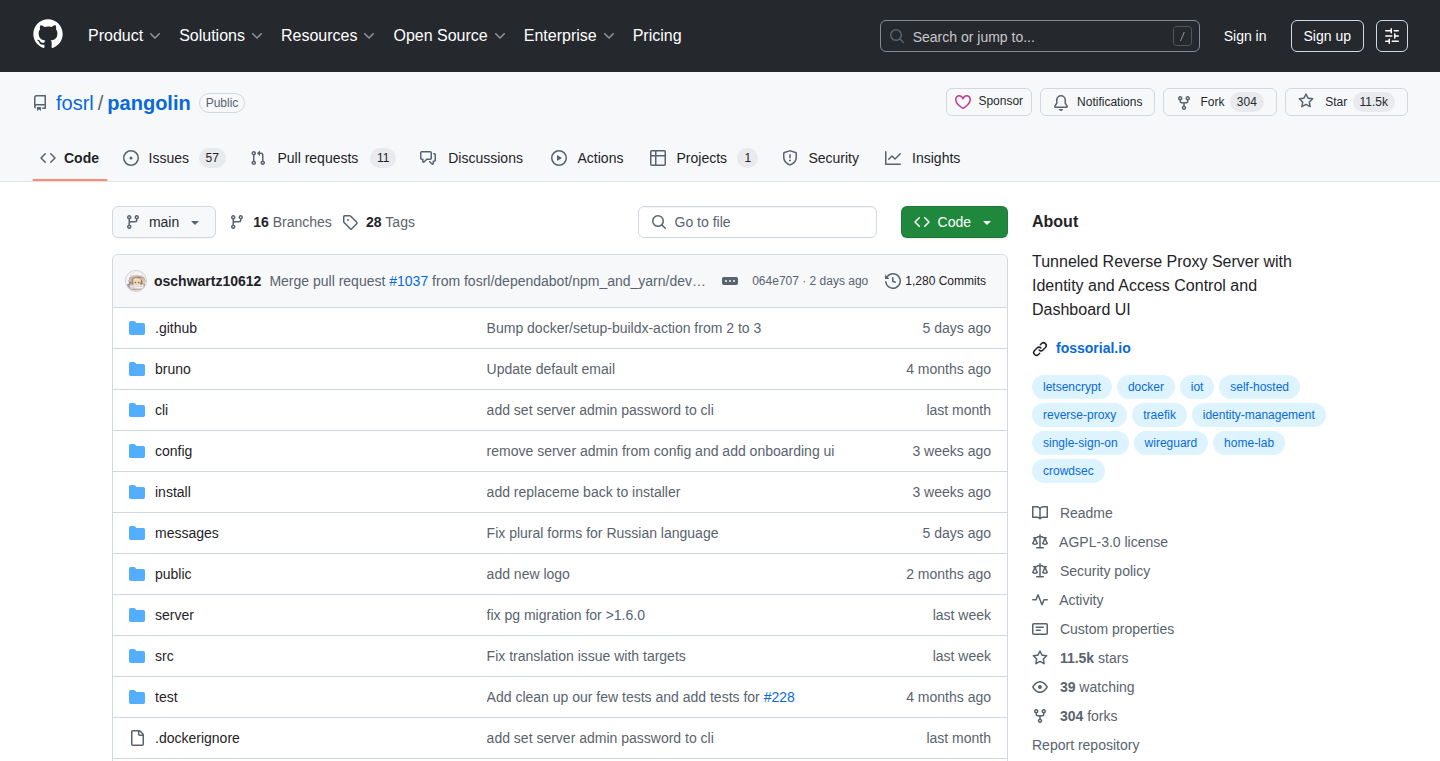
Author
miloschwartz
Description
Pangolin is a self-hosted tool that lets you securely access your private servers and applications from anywhere in the world, like a secure tunnel that hides your public IP address. It uses encrypted connections (WireGuard tunnels) and a user-friendly interface to manage access, authentication, and security. This eliminates the need for complex port forwarding, making it easy to expose services while keeping them protected. This is a great alternative to services like Cloudflare Tunnels, but with full control of your data and infrastructure.
Popularity
Points 270
Comments 55
What is this product?
Pangolin is a reverse proxy server that you run on your own hardware. Think of it like a secure gatekeeper for your internal applications. It uses WireGuard, a modern and efficient method for creating encrypted connections. It offers features such as user authentication (OAuth2/OIDC), role-based access control (RBAC), and even a web application firewall (WAF) to further enhance security. It provides a clean and simple web UI for managing all these features, meaning you don't need to be a networking expert to use it. So, this is helpful because you get complete control over how your applications are exposed to the internet, avoiding reliance on third-party services and protecting your data.
How to use it?
Developers can deploy Pangolin on a Virtual Private Server (VPS) or any server they control. After setting up the server, you can define which internal applications or services you want to expose. You then configure authentication methods, user permissions, and security rules through the web interface. Pangolin creates secure tunnels, and when someone tries to access your application, they go through Pangolin, which handles the authentication and forwards the traffic to your internal service. The integration is done by configuring DNS records and pointing to the Pangolin server. This provides a way to quickly and securely expose private services without the complexities of traditional network setups. This means you don't have to worry about open ports or complicated network setups and can focus on building your apps.
Product Core Function
· Encrypted Tunneling with WireGuard: Pangolin utilizes WireGuard to create secure, encrypted tunnels. This encrypts all the data traveling between your internal services and the outside world. It prevents eavesdropping and unauthorized access, protecting your sensitive information during transit. So, you get peace of mind knowing that your traffic is secure.
· Reverse Proxy Functionality: Pangolin acts as a reverse proxy, meaning it sits in front of your internal applications and services. It receives incoming requests and forwards them to the correct destination. This hides the internal structure of your network, protecting your applications from direct exposure to the internet. So, your internal services are hidden behind the proxy, adding an extra layer of security.
· Authentication and Access Control (OAuth2/OIDC, RBAC): Pangolin allows you to define who can access your services. It integrates with common authentication providers (like Google, GitHub, etc.) and lets you set up roles and permissions. This ensures only authorized users can access your applications, preventing unauthorized access. So, you can precisely control who can see and use your applications.
· Web Application Firewall (WAF) and Security Features: Pangolin includes features like a WAF (using CrowdSec) and geoblocking. The WAF helps to protect your services from common web attacks, and geoblocking restricts access based on geographic location. This is like having a security guard at your front door to stop bad guys from coming in. So, these features help to improve the overall security posture of your applications.
· User-Friendly Dashboard: Pangolin offers a simple web-based dashboard for managing all of its features. You can easily configure tunnels, manage access control, and monitor the performance of your services. This simplifies the setup and management, removing the need for complex command-line configuration. So, you don't have to be a network expert to use the software.
Product Usage Case
· Exposing Internal Web Applications: A developer wants to make a web application they host on a home server accessible to their team. They can use Pangolin to create a secure tunnel, eliminating the need for complex port forwarding on their home router. Users can access the application securely through a custom domain. So, the application can be accessed from anywhere without exposing the internal network.
· Remote Access to IoT Devices: An engineer needs to monitor and control IoT devices deployed in the field. Pangolin can establish secure tunnels to these devices, allowing the engineer to access them remotely through a web browser, even if the devices are behind a firewall or a CGNAT. So, the engineer can remotely monitor and manage devices without complex network configurations.
· Testing and Development: A software engineer wants to test a new application on their local machine, making it accessible for testing by a QA team. Pangolin can create a tunnel to their localhost, allowing the QA team to test the application from their own devices without requiring the application to be deployed to a public server. So, developers can quickly share local developments with colleagues.
· Load Balancing Across Multiple Clouds: A company is using multiple cloud providers. Pangolin can be deployed in each cloud and be used as a unified entry point, creating a single application load balancer. This simplifies management and improves reliability. So, it simplifies management for multi-cloud infrastructures.
2
BrowserOS: A Privacy-First AI-Powered Browser
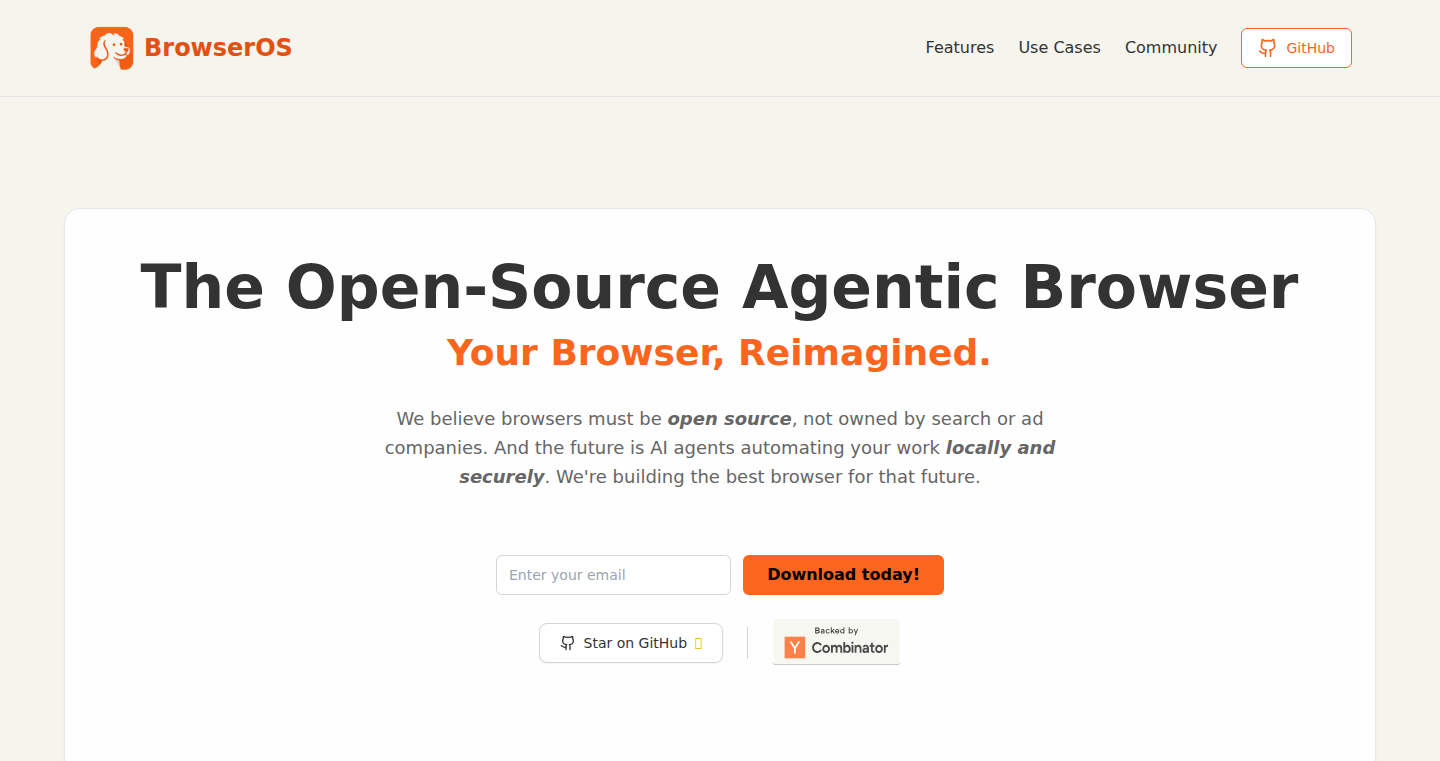
Author
felarof
Description
BrowserOS is an open-source, privacy-focused browser designed to be an alternative to services like Perplexity Comet. It allows users to run AI agents locally within their browser, giving them control over their data and the ability to use local Large Language Models (LLMs) like Ollama. The project's core innovation lies in its commitment to user privacy and transparency, achieved through local processing and an open-source architecture. It addresses the growing concern of data security in the age of AI-powered browsers, offering a more secure and customizable browsing experience.
Popularity
Points 230
Comments 86
What is this product?
BrowserOS is a web browser that integrates AI agents directly into your browsing experience, unlike other browsers that send your data to external servers. It’s built on the foundation of Chromium (the same technology that powers Google Chrome), but with modifications focused on user privacy. This means your browsing data stays on your computer. It supports local LLMs, allowing you to use AI without sending your information to a third party. So, this is like having a smart assistant that can browse the web for you and answer your questions, but it keeps your data safe and private.
How to use it?
Developers can use BrowserOS by downloading it from the provided GitHub repository. It's a drop-in replacement for other browsers. To integrate AI, developers can utilize the local LLM support (like Ollama) to build extensions or customize the browser's behavior. This is achieved through patching Chromium's C++ source code. For developers, this offers a unique platform for building privacy-focused browser extensions and experimenting with local AI integrations. So, if you're a developer, you can build new tools that understand and interact with the web in a more secure way.
Product Core Function
· Local AI Agent Execution: Allows AI agents to run directly within the browser, processing data locally instead of sending it to external servers. This is a big deal because it keeps your browsing data private. So, this means your AI-powered browsing stays on your computer, and your data is more secure.
· Open-Source and Privacy-Focused: The entire project is open-source, promoting transparency and giving users control over their data. This ensures that users can inspect the code and verify its privacy claims. So, you know exactly what the browser is doing with your data.
· Local LLM Support (Ollama): Integrates with local Large Language Models, eliminating the need to rely on external servers for AI functionality. This significantly enhances privacy and control. So, you can have AI features without compromising your personal information.
· BYOK (Bring Your Own Keys) Support: Allows users to use their own API keys, eliminating the need for expensive subscription plans. This gives users more flexibility and control over their AI usage costs. So, you can use AI services without being locked into expensive monthly fees.
· Chromium-Based with Patching: Utilizes Chromium, a widely used browser engine, with custom patches to implement AI and privacy features. This leverages the security and performance of Chromium while adding custom functionality. So, you get the security of Chrome with enhanced AI capabilities and privacy.
Product Usage Case
· Building Privacy-Focused Browser Extensions: Developers can create extensions that leverage local AI for tasks like content summarization or web page analysis, all while ensuring user data stays local. For instance, you could create a browser extension that summarizes articles without sending the text to an external server. This enhances user privacy and control over their data.
· Customizing Browser Behavior with AI: Integrate AI agents to automate tasks like form filling, data extraction, or even basic website navigation based on user commands. So, you can automate tedious tasks with the power of AI, completely privately.
· Developing Security-Conscious Web Applications: Utilize BrowserOS as a test environment for web applications that require high levels of security and privacy. This is especially useful when testing applications that handle sensitive data. So, you can be sure your data stays secure during development and testing.
· Creating Educational Tools for AI and Browsers: Developers can use BrowserOS as a platform to teach others about AI and browser technology in a safe and transparent environment. So, you can learn how AI works with browsers without compromising your data, and you can build tools for others to do the same.
3
FormAI: AI-Powered, Open-Source Forms
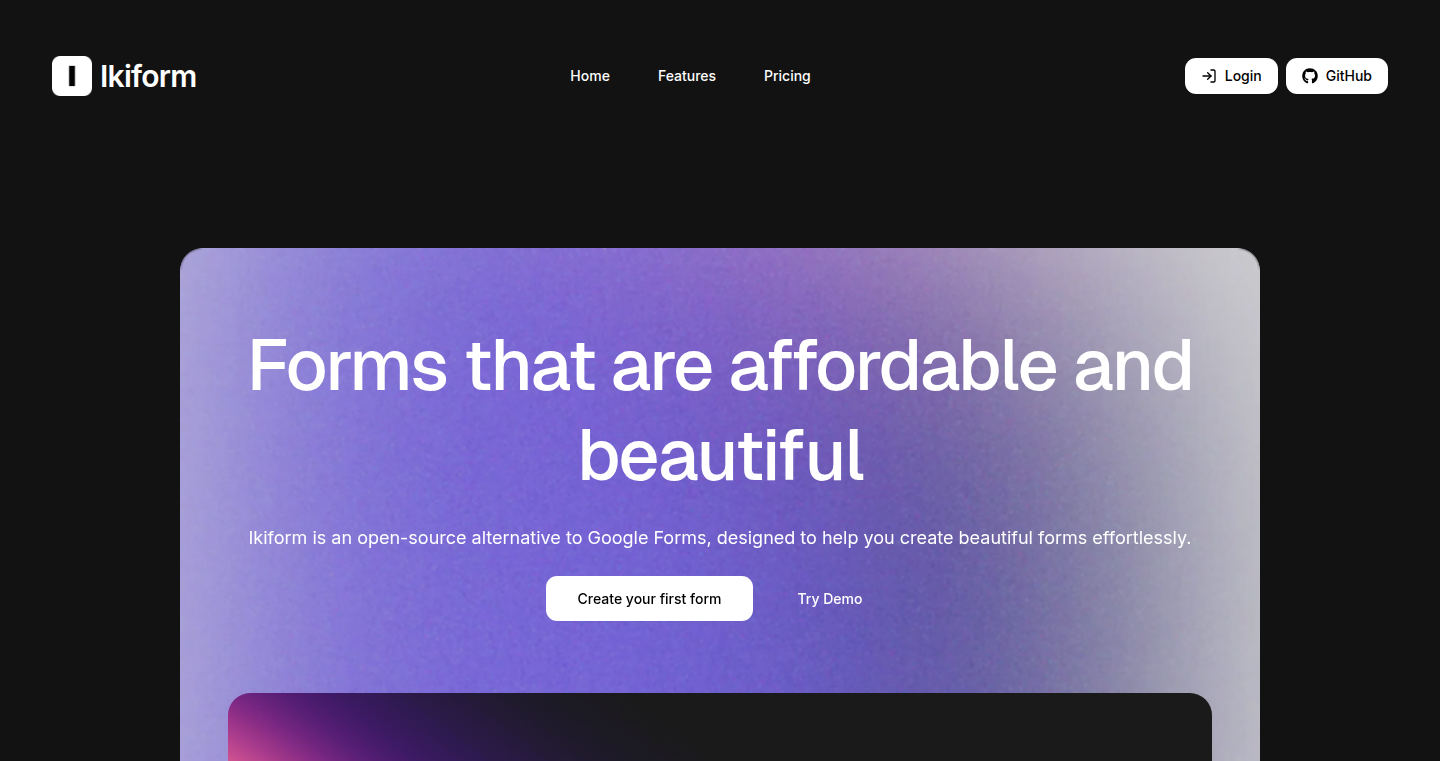
Author
preetsuthar17
Description
FormAI is an open-source form builder that uses AI to create forms quickly and analyze user data. It addresses the problem of expensive form solutions like Typeform and clunky alternatives like Google Forms. The core innovation lies in its AI capabilities, enabling instant form generation and providing insightful analytics by allowing users to 'talk' to their form data.
Popularity
Points 177
Comments 91
What is this product?
FormAI is a free and open-source tool that lets you build custom forms for your website. The core technology is centered around AI. You can instantly generate forms with a simple prompt. It also includes AI-powered analytics, letting you ask questions about your form data in plain language, offering deeper insights without needing complex data analysis skills. So, this is like having a smart assistant for your forms.
How to use it?
Developers can integrate FormAI into their websites by using its open-source code. This allows for complete control over the form's appearance and data. To get started, you can deploy FormAI on platforms like Vercel, which is what the creator used. Then, you can customize the form's design, integrate it with your existing services, and use the AI features to analyze form submissions. So, you can build and customize your own forms and have AI help you understand the data.
Product Core Function
· AI-Powered Form Generation: Users can describe the type of form they need (e.g., a contact form, a survey) and the AI automatically generates the form fields and structure. This saves time and effort in form creation. For example, if you need a form to collect customer feedback, the AI can create all the necessary fields for you. So, this saves time and makes form creation easier.
· AI-Driven Analytics: The tool allows users to ask questions about their form data using natural language, like 'What are the most common responses to question X?' The AI then processes the data and provides relevant insights. So, this lets you get insights from your data faster, without needing data analysis skills.
· Customizable Forms: Since the tool is open-source, users have complete control over the form's appearance and can customize the look and feel to match their website's branding. This ensures a professional appearance that aligns with your brand. So, you can tailor the forms to your brand's look and feel.
· Open-Source and Free: The project is open-source and freely available. This means developers can use the code, modify it, and contribute to its improvement. So, you don't have to pay for using the tool.
· Ease of Integration: It's designed to be easily deployed and integrated into a website using Vercel (the creator used it) or other platforms. So, it's easy to get your forms up and running quickly.
Product Usage Case
· Web Design Agency: A web design agency can use FormAI to create custom contact forms, project inquiry forms, and feedback forms directly on their website. The AI can generate these forms automatically. The AI analytics can help the agency understand client needs and improve service offerings. So, this helps attract more clients and improve your services.
· Freelancers: Freelancers can use FormAI to build project proposal forms, collect client information, and gather feedback. The AI features allow for rapid form creation and easy data analysis. So, this helps manage projects and collect necessary client information.
· Small Businesses: Small businesses can create surveys, feedback forms, and lead generation forms to gather information from their customers. The AI analytics allows business owners to understand customer preferences and improve their products or services. So, this helps improve the customer experience and business performance.
· Developers Building SaaS: Developers can integrate FormAI into their SaaS products as a form-building feature. This allows their users to create forms and analyze data within their own applications. So, this adds a powerful feature to your products without needing to build it from scratch.
4
Cactus: Local AI Models for Smartphones
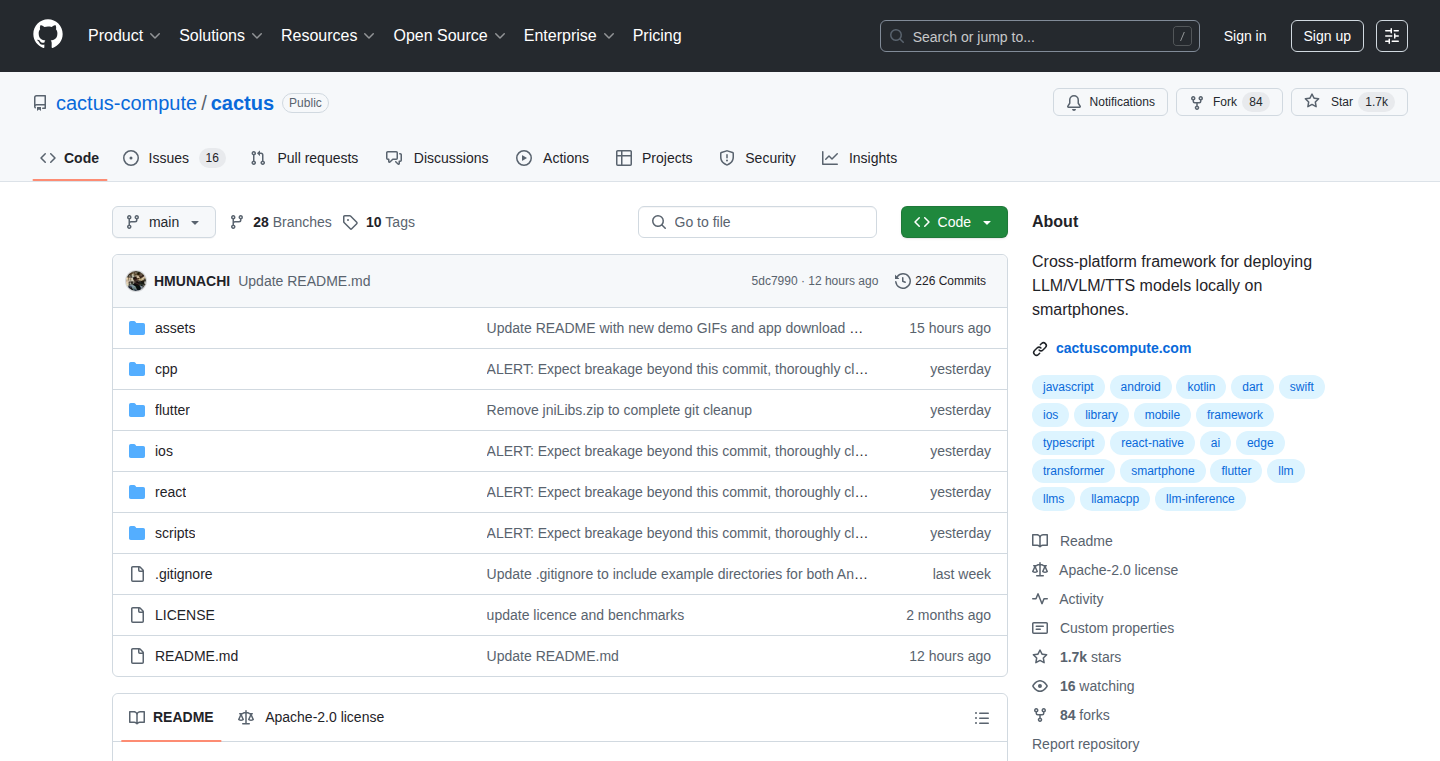
Author
HenryNdubuaku
Description
Cactus is a cross-platform framework that allows developers to deploy Large Language Models (LLMs), Visual Language Models (VLMs), embedding models, and Text-to-Speech (TTS) models directly onto smartphones. This enables the creation of AI-powered apps with real-time responses, enhanced privacy, and reduced reliance on cloud services. The innovation lies in its support for a wide range of open-source models (like those from Hugging Face), quantization techniques for efficient resource usage, and cross-platform compatibility with Flutter, React Native, and Kotlin Multiplatform. It also incorporates tools for advanced functionality and seamlessly integrates with cloud models when necessary.
Popularity
Points 158
Comments 64
What is this product?
Cactus brings the power of AI models directly to your smartphone. Instead of relying on the internet to communicate with an AI, Cactus lets your phone do the work itself. It supports various types of AI models, including those that understand language, images, and speech. The core innovation is that it is cross-platform, meaning it works on both Android and iOS, and supports a wide variety of models. It also optimizes these models to run efficiently on phones, even older ones. This is achieved through techniques like model quantization (reducing the model’s size without sacrificing too much accuracy). This means faster responses, improved privacy because data stays on your device, and the ability to use AI even without an internet connection. So, this allows developers to build AI apps that can understand your commands and respond immediately, without sending your data to the cloud, thus keeping your information secure.
How to use it?
Developers can integrate Cactus into their existing mobile apps built with Flutter, React Native, or Kotlin Multiplatform. By simply adding the Cactus framework and selecting their desired AI model from Hugging Face or other sources, developers can enable local AI capabilities. They can then use these models to add features like intelligent assistants, image analysis, text summarization, or real-time language translation directly within their apps. For example, an app could use Cactus to answer your questions about the contents of an image, help you write an email, or even generate personalized recommendations, all without needing an internet connection. So, if you're a mobile developer, you can easily integrate AI into your apps, making them more intelligent and responsive, creating a better user experience.
Product Core Function
· Cross-platform support: Cactus works on both iOS and Android, using Flutter, React Native, and Kotlin Multiplatform. This means developers can build AI-powered features once and deploy them on multiple mobile platforms. So, you can reach a wider audience.
· Model Compatibility: Cactus supports a wide variety of AI models from Hugging Face and other sources, including LLMs, VLMs, and TTS models. This gives developers flexibility in choosing the best model for their specific use case. So, you are not locked into using a specific type of AI.
· Quantization: It supports different quantization levels (from FP32 to 2-bit), which allows developers to optimize models for performance and efficiency on resource-constrained mobile devices. This makes it possible to run powerful AI models even on older phones. So, you can make AI apps that run quickly and use less battery power.
· Tool-Call Integration: Cactus incorporates tools to enhance the functionality of AI models, making them truly helpful (set reminders, gallery search, reply messages). This allows developers to create AI apps that are more practical and user-friendly. So, you can build apps with advanced AI features, like setting reminders or searching your photo library.
· Cloud Fallback: For complex tasks, or when a local model isn't sufficient, Cactus can seamlessly switch to cloud-based AI services. This provides a safety net, ensuring high availability and performance for demanding use cases. So, you have access to the best AI solution, whether it’s on your phone or in the cloud.
Product Usage Case
· Personalized RAG Pipelines: Imagine an app that summarizes your documents or emails. Cactus can be used to run a local AI model to process your data and answer your questions, providing personalized information without sending your private content to the cloud. So, your data stays private, and you get faster, more secure access to information.
· Real-time language translation: A travel app could use Cactus to translate conversations in real-time, even without an internet connection. This would enable travelers to communicate in foreign countries, improving their travel experience. So, you can travel the world and communicate easily.
· Offline AI assistants: Build a smart assistant app that can answer questions, set reminders, and control your phone, all without an internet connection. This ensures that your assistant is always available and protects your privacy. So, you get an always-available, secure AI assistant.
· Image recognition apps: Create an app that can identify objects in images or provide information about your surroundings. Cactus enables this without requiring a constant internet connection. So, you can build image-based apps that are fast and work anywhere.
5
RunViz: A Decade of Running Data Visualization

Author
friggeri
Description
RunViz is an interactive dashboard that visualizes a decade of running data, transforming GPX files into insightful charts. It tackles the challenge of analyzing a large dataset of running activities, providing users with a powerful tool to explore their running history, track progress, and gain deeper insights into their fitness journey. The project's innovative approach lies in its efficient data pipeline, utilizing a NextJS app with a PostgreSQL database, Redis caching for performance, and custom SVG-based visualizations for complete control. So this is a tool to understand your own data.
Popularity
Points 22
Comments 8
What is this product?
RunViz is built to visualize and analyze running data from GPX files. It employs a robust tech stack: a NextJS application serves as the front-end, a PostgreSQL database stores the running data, Redis caching optimizes data retrieval, and custom SVG-based visualizations offer tailored data representation. The system uses Strava's bulk export for initial data ingestion and webhook API for incremental updates, incorporating OpenWeatherMap and OpenCageDate for data enrichment. This project shows how to turn raw running data into insightful visualizations, allowing users to explore their running history, track progress, and gain deeper insights into their fitness journey. So it's a way to visualize a lot of running data in a meaningful way.
How to use it?
Developers can integrate this project to visualize any running data. They can use the Strava bulk export to pre-populate the database, and then employ the webhook API for real-time updates. The system uses OpenWeatherMap and OpenCageDate APIs to enrich running data by adding weather information and location details. Developers can adapt the code to visualize their own running data, or data from other fitness tracking sources, creating custom dashboards and analytics tools. So if you have running data, this is how you can make it visually appealing and informative.
Product Core Function
· Data Ingestion and Storage: The system ingests and stores running data from GPX files, utilizing a PostgreSQL database for reliable data management. This allows users to keep a record of all their running activity. The value is that it enables the collection and storage of large quantities of data, which can be used for long-term tracking and analysis.
· Data Caching with Redis: Data is cached in Redis to improve performance. This speeds up data retrieval and the loading of visualizations. So you will have a quicker user experience. The value is that Redis dramatically reduces database load and accelerates data access, enhancing the responsiveness of the application.
· Custom SVG-Based Visualizations: Custom visualizations are created using SVGs (Scalable Vector Graphics). The developer rolled their own visualizations for more control. The value is that it enables custom visualizations tailored to specific needs, offering greater flexibility and control over the data representation. So it is like having a control panel for your data.
· Strava API Integration: It uses the Strava bulk export to prepopulate the database, and webhook API for incremental updates. So the data is always up to date. The value is that it enables the automatic collection and updates of running data from Strava, ensuring the visualized data is always current.
· Data Enrichment using external APIs: Integrating OpenWeatherMap and OpenCageDate to enrich data with weather information and location details. So you will have a better understanding of how weather effects your run. The value is that by adding external data like weather and location, the analysis can offer a richer context. You will be able to correlate your run with the outside factors, and this is super useful for analysis.
Product Usage Case
· Personal Fitness Tracking: A runner can visualize their daily running history, tracking metrics like distance, pace, and elevation gain over time. The user could spot trends and understand how different variables affect their performance. So you can have your own personal running dashboard to understand your running.
· Performance Analysis: Analyzing running data to identify patterns, such as changes in speed, elevation gain, and frequency of runs. This helps runners understand what works best for them. So you can analyze and optimize your running performance.
· Data-Driven Goal Setting: Users can visualize their progress towards fitness goals. This tool helps runners track their progress by comparing data. So you can easily see how well you are doing and keep going.
· Third-Party Integration: Integrate with other platforms to offer customized insights into fitness activities. Using Strava's API, the project can enhance any fitness application. So you can put this tool into your existing apps and track your progress.
6
asyncmcp: Asynchronous MCP over AWS SNS/SQS
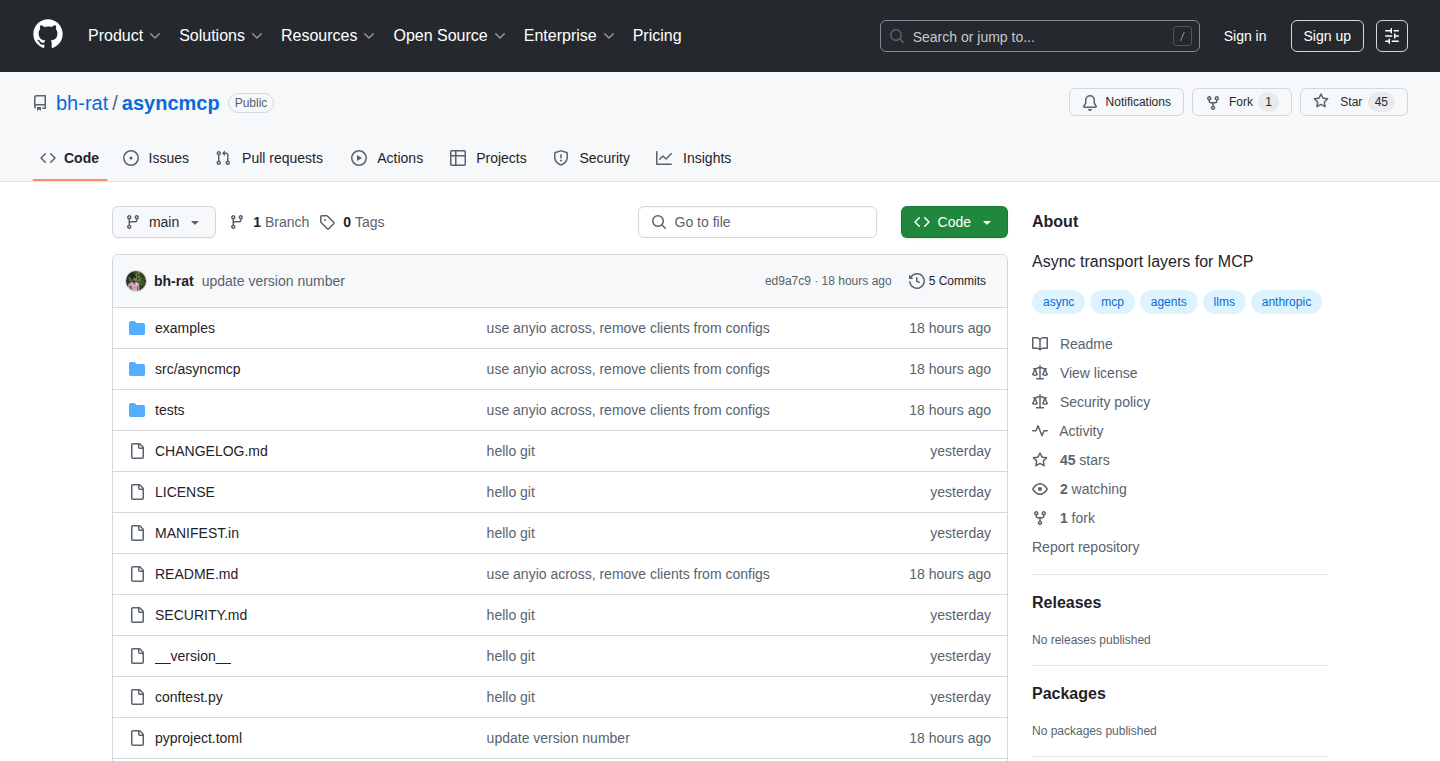
Author
bharatgel
Description
This project, asyncmcp, provides a way to run MCP (Minecraft Protocol) using asynchronous communication channels powered by AWS SNS and SQS. It addresses the problem of efficiently handling Minecraft server communications without blocking operations, especially useful for high-volume servers. The innovation lies in decoupling the communication flow and leveraging the scalable and reliable AWS infrastructure for message queuing and delivery.
Popularity
Points 27
Comments 2
What is this product?
asyncmcp is a system that allows Minecraft server communication to happen asynchronously using AWS services. Instead of directly connecting to players, the server sends and receives messages through AWS Simple Notification Service (SNS) and Simple Queue Service (SQS). This means the server can handle many more player connections without slowing down. The core innovation is using a message queue system to manage the player’s message exchanges. So this means your server can handle more players.
How to use it?
Developers integrate asyncmcp by configuring their Minecraft server to use the AWS SNS/SQS endpoints for player communication. This involves setting up the AWS services, configuring the asyncmcp library, and modifying the server's message handling logic to send and receive messages through the queue. For example, if your server is experiencing performance issues during high traffic, asyncmcp can be used. It’s integrated by replacing the synchronous communication layer with the asynchronous one. So you can build more scalable servers!
Product Core Function
· Asynchronous Message Handling: The core function is the ability to send and receive Minecraft protocol messages via AWS SNS/SQS. This means the server doesn't need to wait for each player's response, increasing its efficiency and responsiveness. So this helps your server deal with lag.
· Scalability and Reliability: Leveraging AWS infrastructure (SNS/SQS) provides built-in scalability, ensuring that the server can handle increasing player counts without performance degradation. The queue systems also ensures message reliability, so messages will always get to their destination. So, the servers have better reliability.
· Decoupling and Loose Coupling: The system decouples the server from direct player connections, which allows for independent scaling of different server components and facilitates easier maintenance and updates. This means you can upgrade server components without taking everything offline.
· Simplified Server Logic: This can simplify the main server logic as it handles fewer direct connections. The central focus is on handling the messages in the queue, leading to potentially cleaner code and easier debugging. This allows the developers to concentrate on the core game functionality.
Product Usage Case
· Large-Scale Minecraft Servers: Used in scenarios where a massive number of players are connected. The asynchronous approach allows the server to handle a higher player count without performance bottlenecks. This helps increase the player capacity.
· Game Server Clusters: Can be implemented within a game server cluster. The message queues enable communication between different server instances, allowing players to move seamlessly across different parts of the world, or across server partitions. This provides better player experience when players change areas.
· Plugin Development: Asyncmcp can be integrated into plugins. Plugin developers can then build features without blocking the main server thread, leading to improved responsiveness and a better experience. The plugins can handle the asynchronous communication.
· High-Volume Event Processing: Asyncmcp helps process many events at the same time, such as logging in and out actions. This provides better insight on server activities.
7
Endorphin AI: Natural Language Driven Browser E2E Testing
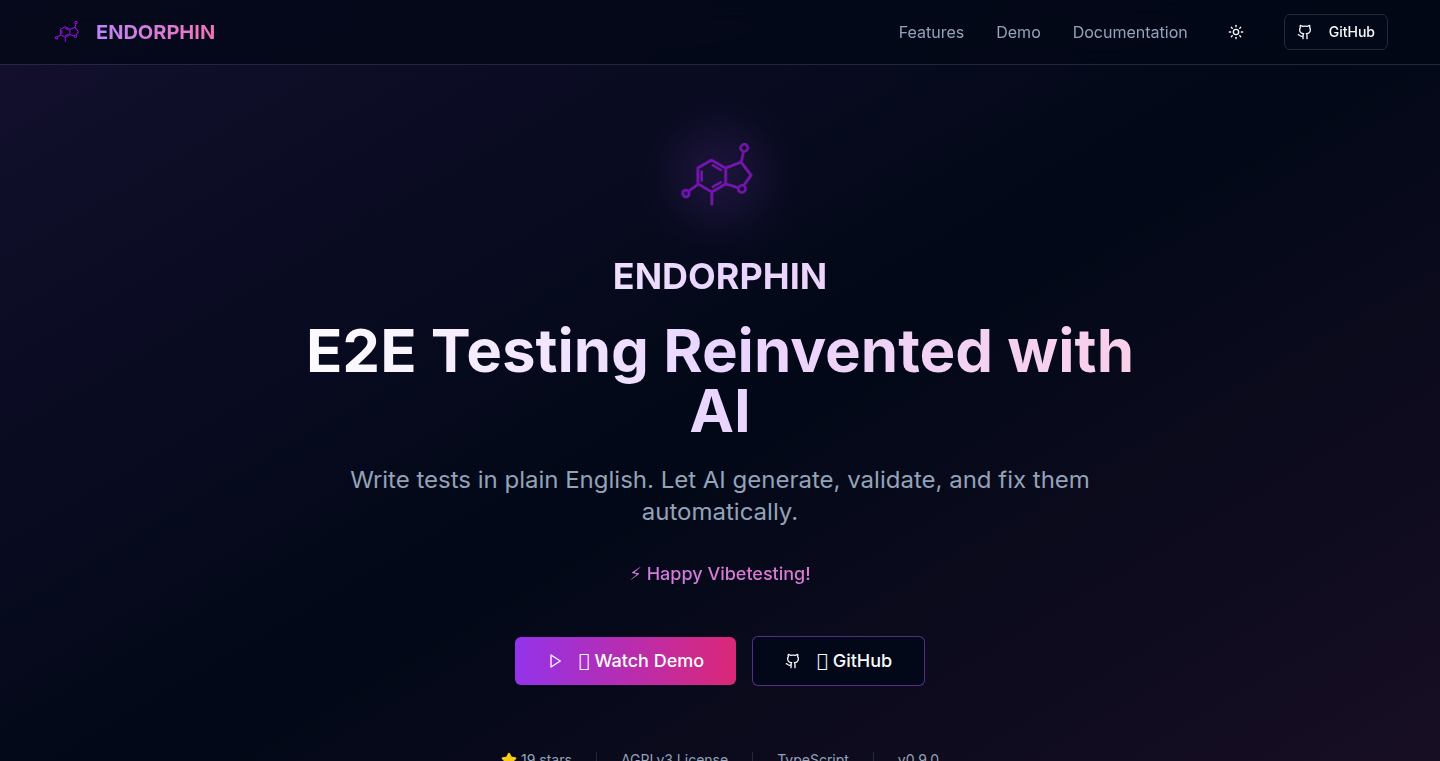
Author
papapin777
Description
Endorphin AI is a tool that lets you write end-to-end (E2E) tests for your web applications using plain English. Instead of writing complex code, you describe what you want to test in simple sentences. The system then uses an AI agent to understand your instructions and run the tests in a browser. This project's technical innovation lies in its ability to translate natural language into automated browser interactions, which simplifies testing and makes it accessible to non-technical users. It tackles the problem of complex and time-consuming E2E test creation, making it faster and easier to ensure your web applications work correctly. So this is useful for anyone who wants to speed up testing without needing a deep technical background.
Popularity
Points 11
Comments 17
What is this product?
Endorphin AI works by using a Natural Language Processing (NLP) model and a QA AI agent. When you provide a test instruction in English (e.g., 'Click the login button, then enter my username and password'), the system parses your instruction, identifies the relevant elements on the webpage, and then instructs the browser to perform these actions. This is a significant advancement because it moves away from writing code and allows users to express tests in an intuitive way. So this is useful because you don't need to learn a specific testing language or framework; you use English.
How to use it?
Developers can use Endorphin AI by providing English descriptions of their test cases. You would typically integrate this into your existing testing workflow. For example, you might describe a user journey (like logging in, navigating to a profile page, and changing a setting), and Endorphin AI will execute these actions in the browser. It often integrates with CI/CD pipelines (Continuous Integration/Continuous Deployment) to automate your testing. So this is useful because it allows non-technical team members to contribute to testing, improving the quality of your web apps and accelerating release cycles.
Product Core Function
· Natural Language Parsing: Converts English instructions into a structured format, like JSON, which can be understood by the AI agent. The value here is it eliminates the need for specialized test scripting languages, making testing easier to learn and use. Application: Allows non-technical users like testers to create tests.
· AI Agent for Test Execution: The core component responsible for interacting with the browser. It interprets the parsed instructions and then uses browser automation tools (like Selenium or Puppeteer) to drive the browser and execute actions. Value: Automates complex browser interactions. Application: Automate all the test cases without manually running tests.
· Web Element Identification: Automatically finds elements on the web page (buttons, input fields, links, etc.) based on your English descriptions, so that it can run the tests. Value: Reduces the need for developers to manually select and interact with page elements in code. Application: Reduces the manual effort and the testing time.
· Reporting and Results: Provides reports on test results and any errors. Value: Gives you a clear understanding of what went wrong during the tests, which is very useful for debugging. Application: Offers faster feedback during testing.
Product Usage Case
· Scenario: A small e-commerce website uses Endorphin AI to test its checkout process. Instead of writing code to simulate adding items to a cart, entering shipping details, and completing the purchase, the team simply writes English statements like 'Add a red t-shirt to the cart, go to checkout, and enter my address.' Endorphin AI then automates this entire process. This is useful because it saves time and reduces the chance of errors.
· Scenario: A software company wants to test its web application across different browsers and devices. They use Endorphin AI to write test cases that cover login, navigation, and data input actions. They integrate Endorphin AI with a Continuous Integration (CI) system to automatically run these tests after every code change. Value: Ensures that tests are consistently performed across all browsers and devices and automated, freeing up developers to focus on writing code.
· Scenario: A team includes both developers and QA testers. Developers write the underlying code of a web app. QA Testers use Endorphin AI to create and execute test cases without needing to write code. The team can improve test coverage and ensure the quality of the web app because they don't need to hire more developers. So this is useful because it allows you to diversify your team's skillsets and increase testing efficiency.
8
WonderPods: Personalized Podcast Generator for Kids
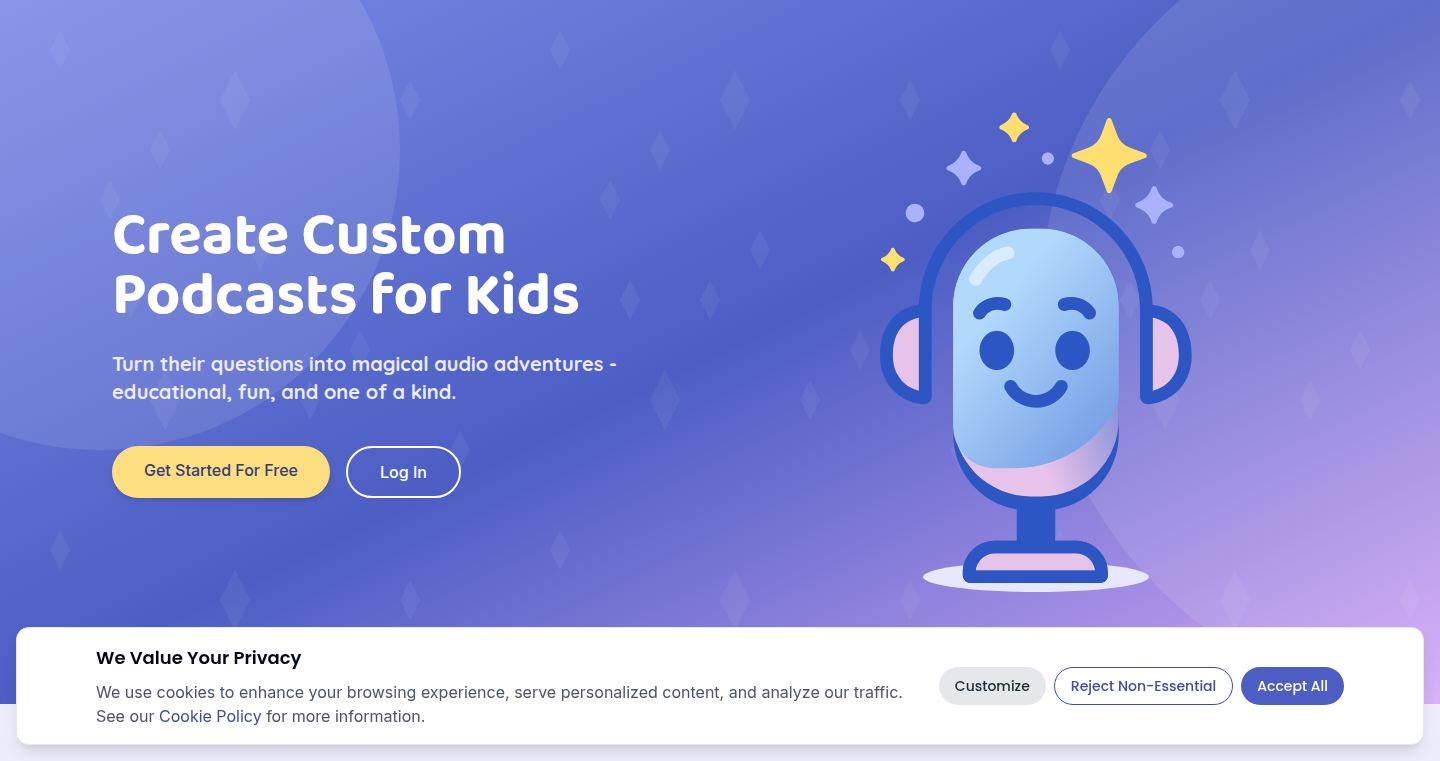
Author
lielvilla
Description
WonderPods is an app that generates custom podcast episodes for children based on their questions. It leverages text-to-speech technology and potentially other AI to create engaging, screen-free learning experiences. The innovation lies in personalizing educational content to answer specific queries, avoiding generic children's content and reducing screen time. So this is useful if you want to transform your child’s curiosity into engaging audio experiences.
Popularity
Points 14
Comments 10
What is this product?
WonderPods uses technology similar to what powers voice assistants (text-to-speech) to create personalized audio content. The user enters a question (e.g., "Why do stars twinkle?"), and the app generates a podcast episode answering that question. It likely uses a combination of natural language processing (NLP) to understand the question, content generation (potentially with AI assistance), and text-to-speech to narrate the story. So it’s like having a custom-made educational audio program for your kids.
How to use it?
Parents can simply enter their child's questions into the app. The app then generates a podcast episode that can be played anytime, such as at bedtime or in the car. Integration is straightforward: download the app, input questions, and listen. So this makes learning fun and accessible by turning questions into audio stories, perfect for busy parents.
Product Core Function
· Personalized Episode Generation: Creates custom podcast episodes based on specific questions. This uses NLP (Natural Language Processing) to understand the questions and then uses a text-to-speech engine to narrate an answer. So this means that your kids can have their own unique lessons based on what they are curious about.
· Text-to-Speech Technology: Converts text into spoken audio, providing a screen-free listening experience. This provides a simple, screen-free way for kids to explore different topics.
· Question-Driven Content: Focuses on answering children's questions, making learning more engaging and relevant. This makes it a very appealing tool for kids who are naturally inquisitive. So it provides a way for kids to learn exactly what they want to know at any given moment.
· Sharing Episodes: Enables users to share generated episodes with others, promoting easy distribution and social engagement. This lets you share fun learning experiences with others such as grandparents.
· User-friendly Interface: Focuses on ease of use for parents, simplifying the process of generating and sharing episodes. So parents won't have to deal with a complex interface to get the benefits of this product.
Product Usage Case
· Bedtime Stories: Parents can use WonderPods to create personalized bedtime stories answering questions like "Why is the moon sometimes visible during the day?" which provides a calming and educational experience before sleep. So this provides a learning and relaxing experience for the child before going to sleep.
· Car Rides Entertainment: During car trips, parents can input questions their children have and instantly receive an audio explanation to keep them engaged. So this turns car rides from a chore to an educational experience.
· Educational Supplement: Teachers could use WonderPods in classrooms to answer students' questions about a particular topic in a customized manner. This provides a more dynamic and personalized learning environment.
· Family Engagement: Families can use the app to engage children in learning. For instance, if a child is curious about dinosaurs, you can generate an episode about dinosaurs. So this enables family members to share an educational experience while engaging and learning about a topic together.
9
Ten VAD: Supercharging Voice AI with Efficient Voice Activity Detection
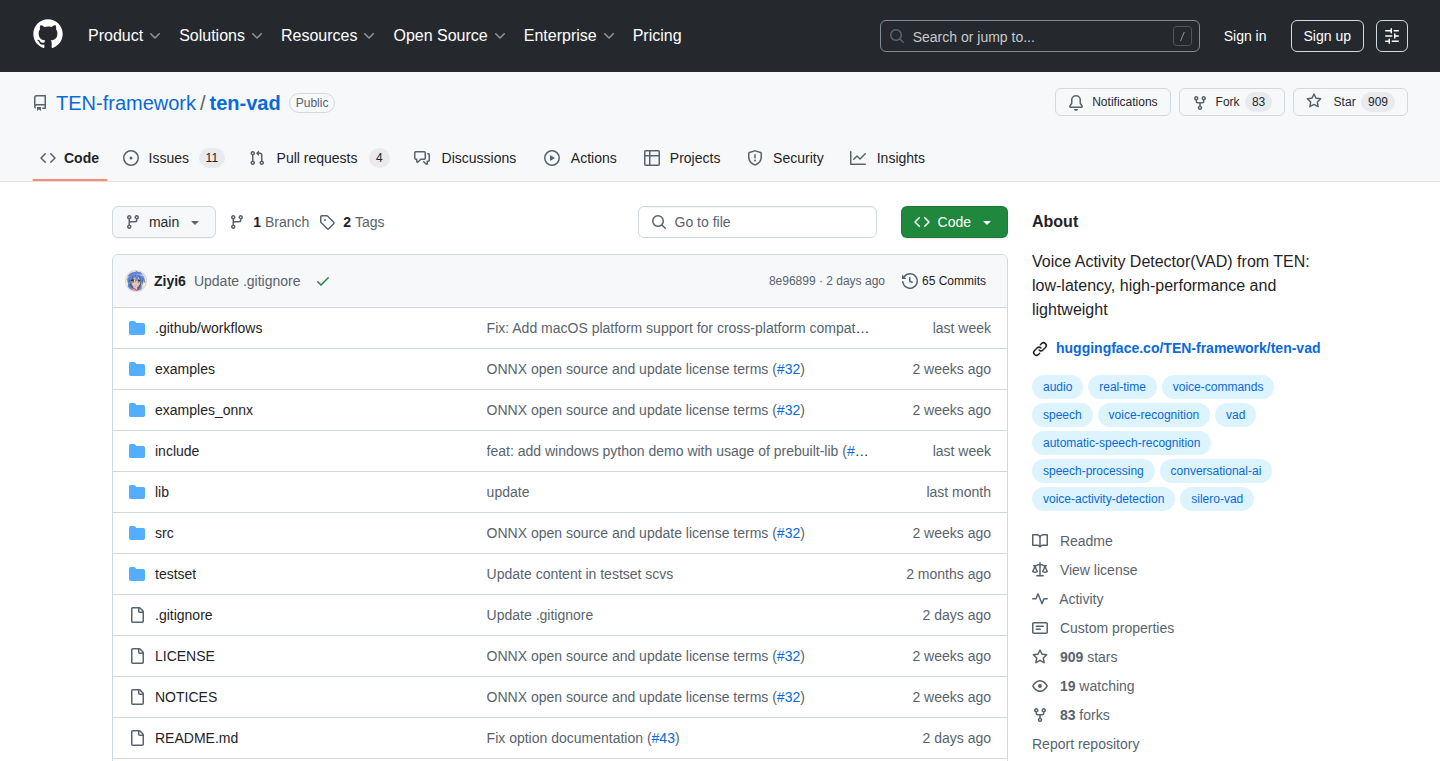
Author
Jingyi0321
Description
Ten VAD is an open-source solution for Voice Activity Detection (VAD). VAD is like the 'ears' of your voice-controlled applications, helping them understand when a person is speaking. This project is built to be significantly faster and smaller than existing solutions, using advanced techniques like ONNX to work on almost any device. It offers improved accuracy, meaning your voice assistants will understand you better and react more reliably. So, it is easier to integrate voice features into your applications.
Popularity
Points 8
Comments 5
What is this product?
Ten VAD is a VAD implementation focusing on efficiency and compatibility. It uses ONNX, a standard format, to allow it to run on various hardware platforms and architectures, including mobile phones and embedded systems. The project prioritizes speed and small size, making it ideal for resource-constrained environments. The core idea is to provide a reliable way to detect speech activity using fewer resources and allowing easy integration, so developers can focus on the core functionality of their voice-enabled applications, rather than the complexities of VAD implementation.
How to use it?
Developers can integrate Ten VAD into their projects by using it as a library. You provide audio input, and Ten VAD tells you when speech is detected. The ONNX format means it can work with popular machine learning frameworks and can run on CPUs, GPUs, or specialized AI accelerators. For example, in a smart home system, it could activate a voice assistant only when someone speaks, saving battery and processing power. For developers, this means quicker deployment, lower costs, and a better user experience because of the improved responsiveness.
Product Core Function
· ONNX Support: Ten VAD uses ONNX, a universal format for machine learning models. This means it can run on almost any hardware, from smartphones to servers. This is valuable because it makes the project highly portable and simplifies integration into various platforms.
· Superior Detection Accuracy: Ten VAD provides more accurate speech detection. This means the voice recognition system is less likely to miss commands or misunderstand speech, leading to more reliable and efficient interactions. This is useful for any application that needs to understand and respond to voice commands.
· Smaller & Faster: Compared to existing solutions, Ten VAD offers a 32% reduction in real-time factor (RTF) and an 86% size reduction. This translates to less processing power and faster performance. This is very valuable, especially for resource-limited devices like mobile phones or embedded systems.
· Open-Source: Because it is open-source, the code is freely available, allowing developers to view and modify the code. This encourages community contributions, which can enhance the quality and security of the project. This is useful because it fosters collaboration and accelerates innovation in the field.
Product Usage Case
· Smart Home Integration: Imagine a smart home system that only activates when someone is speaking. Ten VAD allows the voice assistant to be more responsive and less power-hungry, only listening when needed. This results in a better user experience and increased battery life.
· Voice-Controlled Applications: Developers can use Ten VAD to improve the accuracy of voice commands in apps, allowing for a more natural way to interact with the application, improving user satisfaction.
· Embedded Systems: In devices with limited processing power, like wearable gadgets or IoT devices, Ten VAD can be used to reliably detect speech activity, supporting a range of speech-enabled capabilities without impacting the device's performance.
· Call Center Applications: Used in call centers to analyze calls and automatically identify when a customer or agent is speaking. This helps in analyzing customer interactions and improving the quality of customer service.
10
HextaUI: Rebuilt UI Component Library with Tailwind CSS
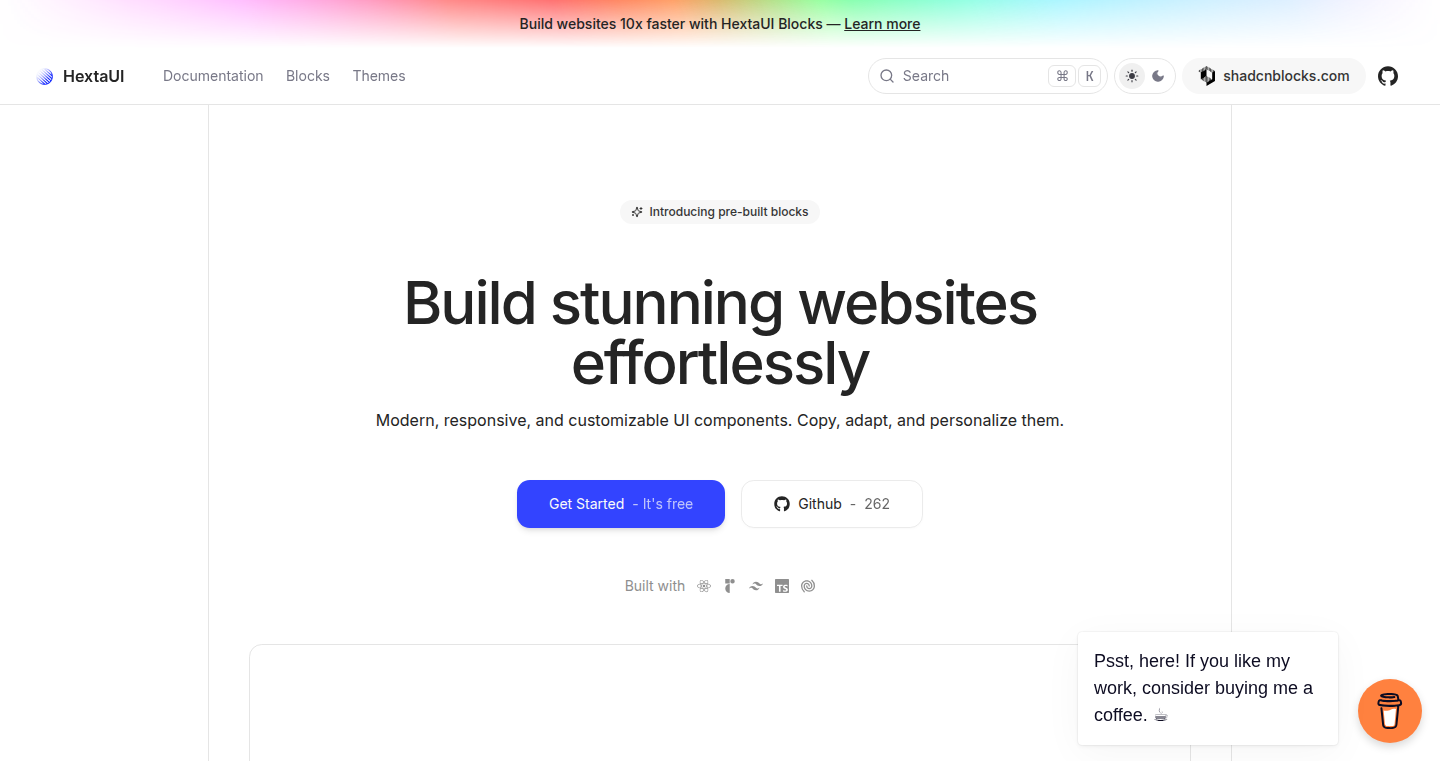
Author
preetsuthar17
Description
HextaUI is a UI component library built with Tailwind CSS, offering pre-built website blocks and UI components. The project was rebuilt to address the need for reusable and modular UI elements, improving design, accessibility, and animation capabilities. It aims to provide developers with a collection of ready-to-use building blocks, accelerating web development and reducing repetitive coding. So this allows you to quickly build beautiful and functional websites without starting from scratch.
Popularity
Points 7
Comments 3
What is this product?
HextaUI provides a set of UI components like buttons, forms, and other common web elements. These components are styled using Tailwind CSS, a utility-first CSS framework that allows for highly customizable designs. The project's core innovation lies in its pre-built blocks and focus on modularity and accessibility. Instead of writing all CSS from scratch, developers can utilize these pre-designed components and blocks. So you get to save time, and your websites look great.
How to use it?
Developers can integrate HextaUI into their projects by importing the components and customizing them with Tailwind CSS classes. They can use the pre-built blocks to create website sections or use individual components like buttons or forms in their applications. The library provides easy-to-use code snippets and customization options. This means that you can easily add stylish elements to your website, and tailor them to fit your design. So, you will have a faster development speed and consistent design.
Product Core Function
· Base UI Components: Offers fundamental UI elements like buttons, inputs, and navigation bars. These are the building blocks for creating a website's interface. So you can easily add essential elements to your website.
· Animated Components: Provides UI elements with built-in animations to create dynamic and engaging user experiences. This includes animated buttons, loading indicators, and other interactive elements. So you can add visual flair to your website and keep users engaged.
· Pre-built Website Blocks: Offers ready-made sections of a website, such as hero sections, pricing tables, and contact forms. These blocks can be combined to build complete web pages. This significantly reduces development time. So you can quickly assemble entire website sections.
· Tailwind CSS Integration: Uses Tailwind CSS for styling, providing developers with flexibility and customization options through utility classes. This makes it easy to modify the appearance of components. So you have complete control over the look and feel of your website.
· Accessibility Focus: Components are designed with accessibility in mind, ensuring they are usable by people with disabilities. This includes considerations for screen readers and keyboard navigation. So your website is more inclusive and accessible to everyone.
Product Usage Case
· Building a landing page: Developers can use pre-built hero sections, features sections, and call-to-action buttons to quickly create a landing page. The use of pre-designed blocks and components speeds up the process significantly. This solves the problem of time-consuming front-end development.
· Creating a dashboard interface: Developers can use HextaUI's components for forms, tables, and charts to build the interface for a web application dashboard. The components are customizable and can be styled to match the branding. So you can easily build a professional-looking user interface without having to write all the code from scratch.
· Designing a blog: Developers can use HextaUI for creating a blog, using components like cards, navigation bars, and article layouts. The components offer flexible styling that can adapt to different design needs. So you can create a consistent design for your blog without spending a lot of time on styling.
11
Trim Transformer: Physics-Optimized Transformer Package

Author
emanuelgordis
Description
This project introduces a specialized transformer model designed specifically for physics simulations. Unlike most existing transformer architectures optimized for language models, Trim Transformer is built from the ground up to efficiently handle physics-related datasets. The key innovation lies in its memory usage optimization and speed improvements, offering a 90% reduction in memory consumption and a 3.5x speedup on a standard Navier-Stokes dataset. This addresses the computational bottlenecks often faced when running complex physics simulations, enabling faster and more efficient modeling.
Popularity
Points 9
Comments 1
What is this product?
Trim Transformer is a new transformer architecture, a type of neural network that's become very popular in AI. The twist here is that it's been specifically tweaked for physics calculations. Most existing transformers are tuned for understanding human language. This one is different; it is designed to handle the math and data involved in simulating physical phenomena. It does this by reducing the amount of memory needed and speeding up calculations. So it's like a super-efficient engine for running simulations of things like fluid dynamics or weather patterns. This means faster and more realistic results for scientists and engineers.
How to use it?
Developers can integrate Trim Transformer into their physics simulation workflows. This package can be used as a drop-in replacement for existing transformer-based solutions or as a building block for creating entirely new physics models. You can apply it to datasets related to fluid dynamics (like predicting how water flows around an object), weather prediction (forecasting weather patterns), or any other physics-based simulation where efficiency is a priority. Think of it as upgrading the 'brain' of a physics simulation program; it will provide faster and more detailed results.
Product Core Function
· Optimized Transformer Architecture: The core of the project is the transformer architecture itself, redesigned for physics applications. This involves adjustments to the network structure, attention mechanisms, and other components to improve performance with physics data. This is valuable because it ensures that the models work best for their intended use case, achieving better results.
· Memory Usage Reduction: The Trim Transformer significantly reduces memory consumption compared to standard transformer architectures. This means the simulation needs less computer memory to run, allowing larger datasets to be processed and increasing the complexity of the models that can be built. This is important because it extends the capabilities of the simulations, allowing for more detailed and complete studies.
· Speed Enhancement: The package delivers faster processing speeds, which is crucial for interactive simulations and rapid prototyping. This means results are available sooner, shortening the time it takes to validate and refine the simulation, which helps drive faster innovation cycles.
· Open-Source Package: Releasing the package as open source makes it accessible to the developer community. This allows for community contributions, improvements, and adaptations to different physics problems. Open-source makes the model accessible for research and adaptation, empowering scientists and developers to work together.
· Navier-Stokes Dataset Compatibility: Specifically optimized for the Navier-Stokes dataset, this project directly addresses a common fluid dynamics simulation. The fact that it is already trained on this dataset means it is directly useful for the solution of fluid dynamics problem.
Product Usage Case
· Computational Fluid Dynamics (CFD) Simulations: Using Trim Transformer to model the movement of fluids, like air around a wing or water in a pipe. The efficiency of this package can reduce the runtime of simulation and allow for higher fidelity, which will increase the accuracy of the results. This would greatly improve the efficiency of aerospace engineering for airplane design and the design of more efficient pumps and valves.
· Weather Forecasting: Employing the package to predict weather patterns, including the study of turbulence and other chaotic phenomena. This can speed up simulations for daily forecasts and long-term climate studies. Scientists and engineers can benefit from more accurate, faster models.
· Material Science and Engineering: Simulation and prediction of the behavior of materials under different conditions. This allows engineers and researchers to quickly test different materials and create new products. With the faster results, they can accelerate the material design cycle, reducing time and costs.
· Educational Tool: Integration of Trim Transformer in academic software. This helps students better understand the underlying principles behind physics simulation and encourages more advanced modeling techniques. Students can gain valuable insights into complex physics simulations, which provides a hands-on, practical learning experience.
12
AuthRAG: Secure and Intelligent Chatbot Framework
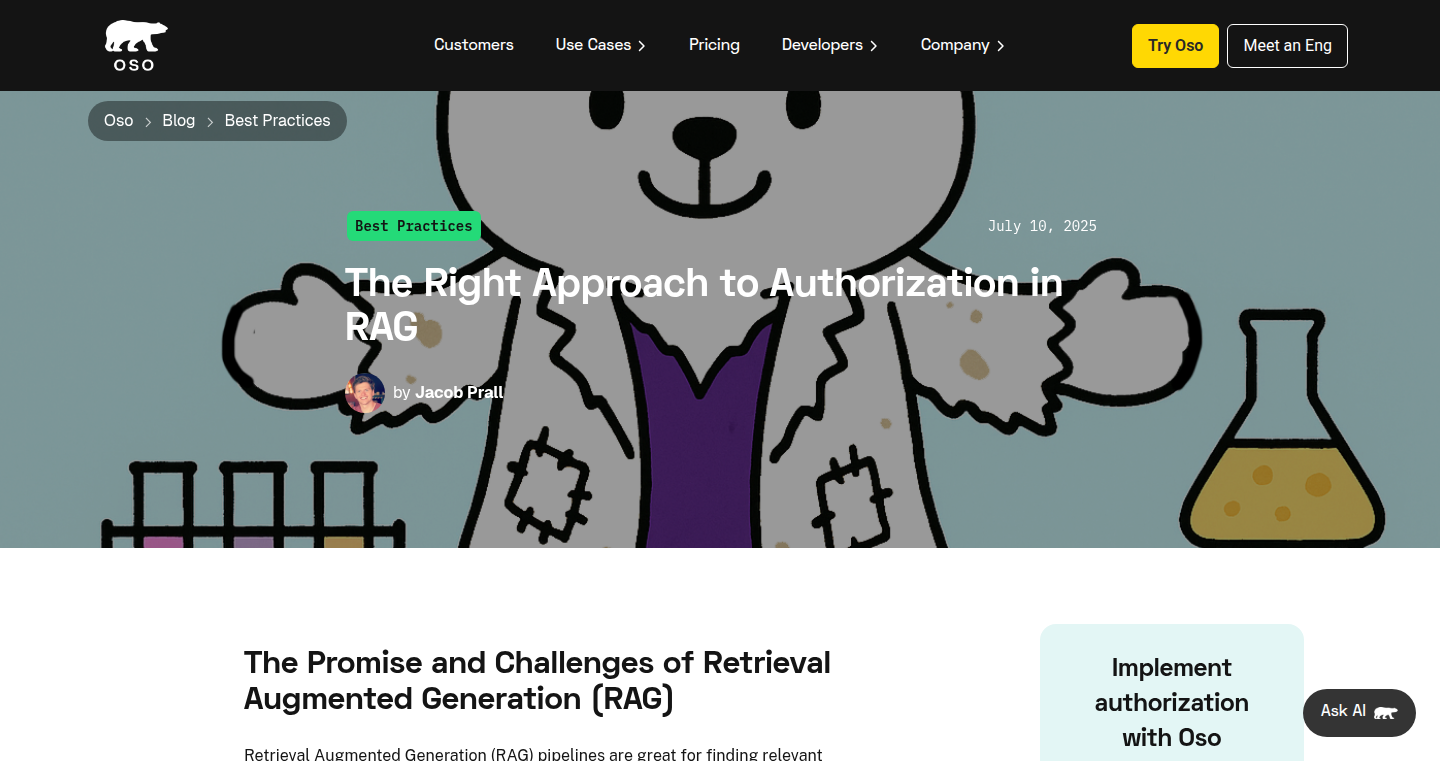
Author
jacobprall
Description
AuthRAG introduces a novel framework for building Retrieval-Augmented Generation (RAG) chatbots that are not only intelligent but also inherently secure. It tackles the critical problem of data leakage and unauthorized access in RAG systems by incorporating robust authorization mechanisms. The core innovation lies in its ability to selectively retrieve and expose information to users based on their predefined permissions, ensuring that the chatbot only accesses and presents data they are authorized to see. So this is useful because it prevents sensitive information from falling into the wrong hands, a common vulnerability in many chatbot applications.
Popularity
Points 8
Comments 0
What is this product?
AuthRAG is a framework for constructing RAG chatbots. RAG chatbots use a clever technique: they first retrieve relevant information from a knowledge base (like a set of documents) and then use that information to generate the chatbot's response. AuthRAG adds a crucial layer of security. It integrates an authorization layer that controls which information a user can access. When a user asks a question, AuthRAG checks their permissions before retrieving the relevant information. If the user isn't authorized to see that information, AuthRAG won't retrieve it. This is innovative because it directly addresses the security concerns associated with sensitive data in chatbots. The technical implementation involves integrating authorization systems with the retrieval process to ensure the chatbot respects user access controls. Think of it as a smart librarian who only gives you access to the books you are allowed to read.
How to use it?
Developers use AuthRAG by integrating it into their existing RAG chatbot pipelines. It provides the necessary components to manage user permissions, connect to knowledge bases, and control information retrieval. Developers define user roles and permissions. AuthRAG then filters the retrieved information based on those permissions. You can integrate AuthRAG by using its APIs to manage users, permissions and data access. For example, you could use it in a customer support chatbot to ensure that customer service representatives only see information relevant to the customer's account. Also you could integrate AuthRAG into your existing frameworks like Langchain or LlamaIndex.
Product Core Function
· Role-Based Access Control (RBAC): AuthRAG enables developers to define roles and assign specific permissions to those roles. This means you can easily control who can see what data in the chatbot. This is valuable because it allows you to manage access to sensitive information effectively. For example, you might use it to restrict access to financial data in a banking chatbot.
· Secure Data Retrieval: The framework ensures that only authorized data is retrieved from the knowledge base. This is achieved by filtering the data based on user permissions before it's passed to the LLM (Large Language Model). This is critical for preventing data breaches and protecting sensitive information. Imagine you are building a chatbot for a medical record system; you don't want just anyone to see patient information.
· Audit Trails: AuthRAG can track user access to data, providing an audit trail that can be used to monitor and troubleshoot access patterns. This feature provides valuable insights into how your chatbot is being used and who is accessing what information. This is particularly useful for compliance and security purposes, allowing you to detect and respond to unauthorized access attempts.
· Integration with LLMs and Vector Databases: AuthRAG is designed to be easily integrated with various LLMs and vector databases commonly used in RAG systems. This flexibility allows developers to choose the tools that best suit their needs. It allows developers to reuse existing tools and build a more secure RAG chatbot.
Product Usage Case
· Building a secure customer support chatbot: In a customer support scenario, AuthRAG can be used to ensure that support agents only have access to customer data relevant to their permissions, such as the support ticket data. This can be implemented by linking user roles with ticket visibility to make sure each support agent can only see relevant data for the customer they are helping. The agent can not see internal documentation they are not supposed to see. This prevents unauthorized access to sensitive customer information.
· Developing a financial advisory chatbot: AuthRAG can be used to build a financial advisory chatbot that respects user privacy by controlling data access based on user account type or subscription level. For example, users with a basic account might only have access to general financial information, while premium users can access personalized investment advice and market data. This implementation assures the data governance requirement and also respects each user level's visibility.
· Creating a secure internal knowledge base chatbot: AuthRAG can be used to build a chatbot to provide secure internal knowledge for employees. It can ensure that employees only see company documents and information relevant to their roles and access level. Developers can assign the role of "Finance Department" to the financial employee, so they can access financial data. It allows companies to ensure sensitive data is only available to users who need it.
· Building a medical chatbot: With AuthRAG you can ensure data security and privacy when building a medical chatbot. Only doctors can access patients' medical records. Unauthorized users will not access the medical records.
13
Crowdcruit: Decentralized Cybersecurity Talent Marketplace

Author
vagmour
Description
Crowdcruit is a hiring platform specifically designed for cybersecurity professionals and companies. It leverages a smart matching system that focuses on verifiable technical achievements (like CVEs, bug bounty participation, and certifications) rather than just keywords. This innovative approach aims to overcome the limitations of traditional hiring processes in the cybersecurity field, which often struggle to accurately assess real-world skills. The platform uses anti-cheat video interviews and emphasizes privacy, offering a more effective and transparent way for both companies and cybersecurity specialists to connect.
Popularity
Points 1
Comments 5
What is this product?
Crowdcruit is a platform that solves the problem of finding the right cybersecurity talent. It works by collecting and verifying real-world achievements of security professionals, like successfully finding bugs (bug bounties), contributing to security vulnerability databases (CVEs), and completing online cybersecurity training. It then matches candidates to job openings based on these demonstrated skills. The platform also includes features like video interviews with anti-cheat measures to further assess candidates. So it helps to see if someone actually knows their stuff, and also makes the whole process more fair. This innovative approach helps companies find the best security experts quickly and efficiently. This is different from traditional methods that rely on resumes and interviews, which often fail to reflect actual abilities.
How to use it?
For cybersecurity professionals, Crowdcruit offers a streamlined way to showcase their skills. Users create profiles that automatically incorporate their achievements from platforms like HackerOne, Bugcrowd, Hack the Box, and others. This removes the need for manually inputting past experiences, making the process fast and easy. For companies, the platform allows them to search for candidates based on their actual skills, not just keywords. They can also review candidate profiles that have been validated through achievements and interviews. This is a big win because it helps companies find the right talent faster and more accurately than traditional methods.
Product Core Function
· Smart Matching: The platform matches candidates to jobs based on their proven skills, not just what's written on their resume. So you get matched with jobs that you are actually qualified for, and you get to see the real skills of candidates.
· Bug Bounty & CVE Recognition: It integrates with bug bounty and CVE records, so candidates don’t have to manually input their past accomplishments. This makes it easy for recruiters to see who has experience in the real world.
· Anti-Cheat Video Interviews: The platform uses in-browser interviews to detect suspicious behavior. So, this feature makes sure that the person being interviewed is actually the one with the skills.
· Certifications Integration: The platform integrates with certification platforms like Accredible and Credly, making it easy for candidates to verify their qualifications. This lets recruiters know what candidates actually know.
· Privacy-first: The platform is designed with privacy in mind. No direct database access to companies, no mass scraping. It offers a GDPR-compliant design, which means the user's information is protected. It protects the privacy of your data.
Product Usage Case
· A company needs a penetration tester experienced in web application security. Using Crowdcruit, they can search for candidates who have reported vulnerabilities on HackerOne or Bugcrowd, which automatically filters for those with proven experience. So, they can quickly find someone who has real-world experience rather than just claims.
· A cybersecurity professional wants to find a job that values their bug bounty achievements. They create a Crowdcruit profile that automatically pulls in their bug bounty scores and CVE contributions. Recruiters can then easily see their experience and reach out. So, it is easier to be recognized for skills by presenting tangible achievements.
14
LinkGenie: AI-Powered LinkedIn Content Creator
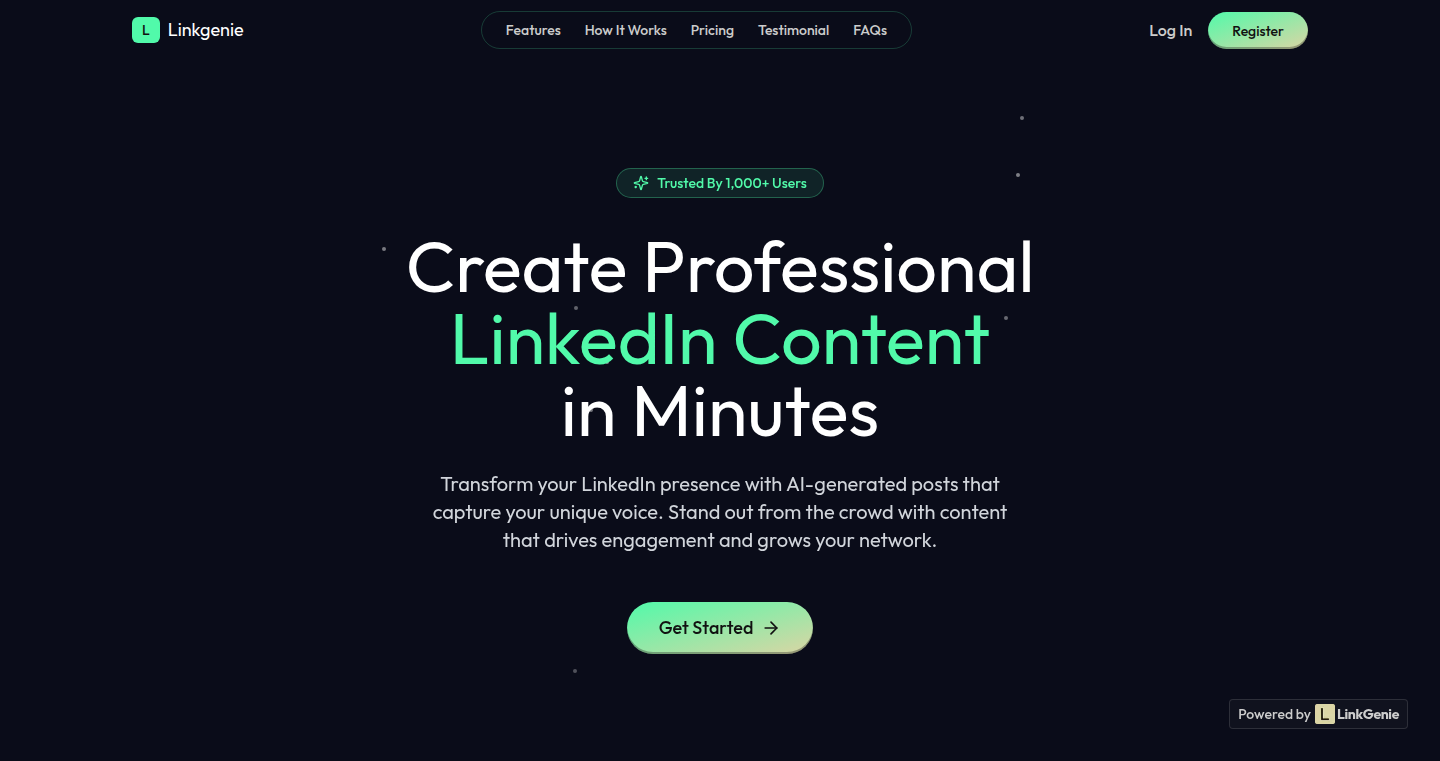
Author
fariraimasocha
Description
LinkGenie is a tool designed to simplify LinkedIn posting. It leverages the power of Claude, a large language model, to generate engaging post content and identify compelling hooks. This project tackles the common problem of writer's block and time-consuming content creation, offering a quick and efficient solution for professionals looking to boost their LinkedIn presence. The technical innovation lies in automating content generation using advanced AI, allowing users to focus on engagement and networking instead of the tedious process of writing posts. So, this lets you create LinkedIn content faster.
Popularity
Points 3
Comments 2
What is this product?
LinkGenie is an AI-powered content creation tool specifically tailored for LinkedIn. It utilizes a large language model (Claude) to generate creative content, including posts and attention-grabbing hooks (the initial sentence designed to capture attention). This is achieved through a combination of natural language processing (NLP) and machine learning (ML) techniques, enabling the tool to understand user prompts and create contextually relevant and engaging LinkedIn content. It's about making LinkedIn posting easier and quicker. So, this automates your content creation.
How to use it?
Developers can integrate LinkGenie into their workflow by providing the tool with a prompt related to the topic they want to post about. The tool then generates a draft post and a selection of hooks. Developers can then customize the generated content as needed and post it directly to LinkedIn or schedule it for later. Possible use cases include creating automated content strategies, rapidly prototyping content ideas, or simply saving time when managing a professional brand on LinkedIn. So, you can feed it a topic, and it gives you a post.
Product Core Function
· AI-Powered Content Generation: This feature allows the tool to create posts based on user-provided prompts. This saves time and effort by automating the content creation process. This is valuable because it eliminates the need to write everything from scratch. So, this feature saves you writing time.
· Hook Generation: The tool provides compelling hooks to grab the reader's attention. This increases the likelihood of engagement. This is valuable because it helps to improve the visibility and reach of posts. So, this feature makes your post stand out.
· User Customization: Users can edit and refine the generated content. This allows for personalization and alignment with individual branding. This is valuable because it allows developers to maintain control over their content while still leveraging the automation benefits. So, this allows you to make the content your own.
· Content Scheduling: Although not explicitly mentioned in the provided text, the tool's utility would be enhanced by scheduling capabilities. This function would streamline content management by automating the posting timeline. This is valuable because it allows developers to automate their content delivery and helps them to better plan their content calendar. So, this lets you schedule posts ahead of time.
Product Usage Case
· A marketing agency could use LinkGenie to generate a series of posts for a client, focusing on different aspects of their business or industry. This automates the creation process and allows the agency to deliver content consistently and efficiently. For instance, the agency can use the AI tool to generate a set of engaging posts describing the client’s new service offering. So, it saves time and ensures content consistency.
· A developer could employ LinkGenie to establish a professional presence on LinkedIn, building a personal brand and sharing insights about their projects. By using AI-generated content, the developer can post regularly without the need to spend hours drafting posts. For example, the developer could input project details, and the tool will generate relevant posts. So, it is a quick way to be more active.
· A small business owner can leverage LinkGenie to enhance their LinkedIn marketing efforts. By using the tool, the business owner can create engaging content about their products or services and post regularly. This can improve their brand visibility and attract potential customers. For example, a small business owner could give the tool information about a new product release. The tool will generate a related post for LinkedIn. So, it helps grow your business.
15
PIT: Terminal Image Renderer
Author
FerkiHN
Description
PIT is a lightweight utility written in C that allows you to view PNG and JPG images directly within your terminal window without the need for a graphical user interface (GUI). Unlike tools that use ASCII art, PIT renders actual images using ANSI color codes, providing a true image representation. This eliminates the need for heavy dependencies and complex setup, making it incredibly versatile across different operating systems and terminal environments, including Linux, Termux (Android), and even Windows. This project addresses the need for a quick and efficient way to visualize images in command-line environments, providing a minimalist solution for developers who frequently work in the terminal.
Popularity
Points 2
Comments 3
What is this product?
PIT is a command-line tool that directly displays images (PNG/JPG) within a terminal using ANSI color codes. It's built with pure C, making it very small and having no dependencies. Instead of converting images to text-based ASCII art, it accurately renders the image by mapping pixel colors to terminal colors. The innovation lies in its simplicity and efficiency, delivering an image viewing experience in environments typically devoid of visual elements. So what's this mean? You can quickly glance at pictures in your terminal, without the bloat of a full-fledged GUI. This is great for quickly previewing images or checking results in your development workflow.
How to use it?
To use PIT, you simply run the command 'pit <image_file.png>' in your terminal. The image will then be rendered directly within the terminal window. You can integrate PIT into scripts or workflows where image previews are beneficial, for example, displaying screenshots in a CI/CD pipeline to verify image outputs, or checking image contents during a data processing routine directly in a terminal. It's a simple and useful tool for anyone working on the command line, who wants quick previews of images. For example, you might automate the display of images on server logs.
Product Core Function
· Direct Image Rendering: PIT accurately displays images (PNG/JPG) in the terminal using ANSI color codes. This function is crucial for anyone needing quick visual previews within text-based environments.
· Minimal Dependencies: The project is written in pure C with no external dependencies. This feature ensures easy portability and deployment across different operating systems (Linux, Termux, and Windows).
· Cross-Platform Compatibility: PIT works on Linux, Termux (Android), and Windows. This universality broadens the tool's utility for developers working across varied platforms.
· Resolution Support: Capable of rendering images up to 600x600 pixels, even on older terminals. This function provides sufficient image detail for common usage scenarios, without requiring excessive resources.
· Command-line interface: PIT provides a simple command-line interface allowing the users to easily integrate this into their existing workflows and automation scripts.
Product Usage Case
· Development Debugging: During image processing or web development, developers can quickly view generated images directly in the terminal, verifying the output of their scripts. So you don't have to switch to a separate GUI program just to check an image.
· CI/CD Pipeline Visualization: PIT can display screenshots or other image outputs in continuous integration/continuous deployment (CI/CD) pipelines, facilitating visual verification of builds and deployments without needing a GUI. This means you can automate your testing and quickly see if the output is correct.
· Server Administration: System administrators can use PIT to view images directly on a server terminal (e.g., to check configuration screenshots or log summaries), making management more efficient.
· Embedded Systems Development: When working with embedded systems, a terminal-based image viewer simplifies the debugging of image-related functionalities without relying on a graphical interface. This can be very helpful for seeing if the images look correct.
16
groas: AI-Powered Google Ads Optimization Ecosystem
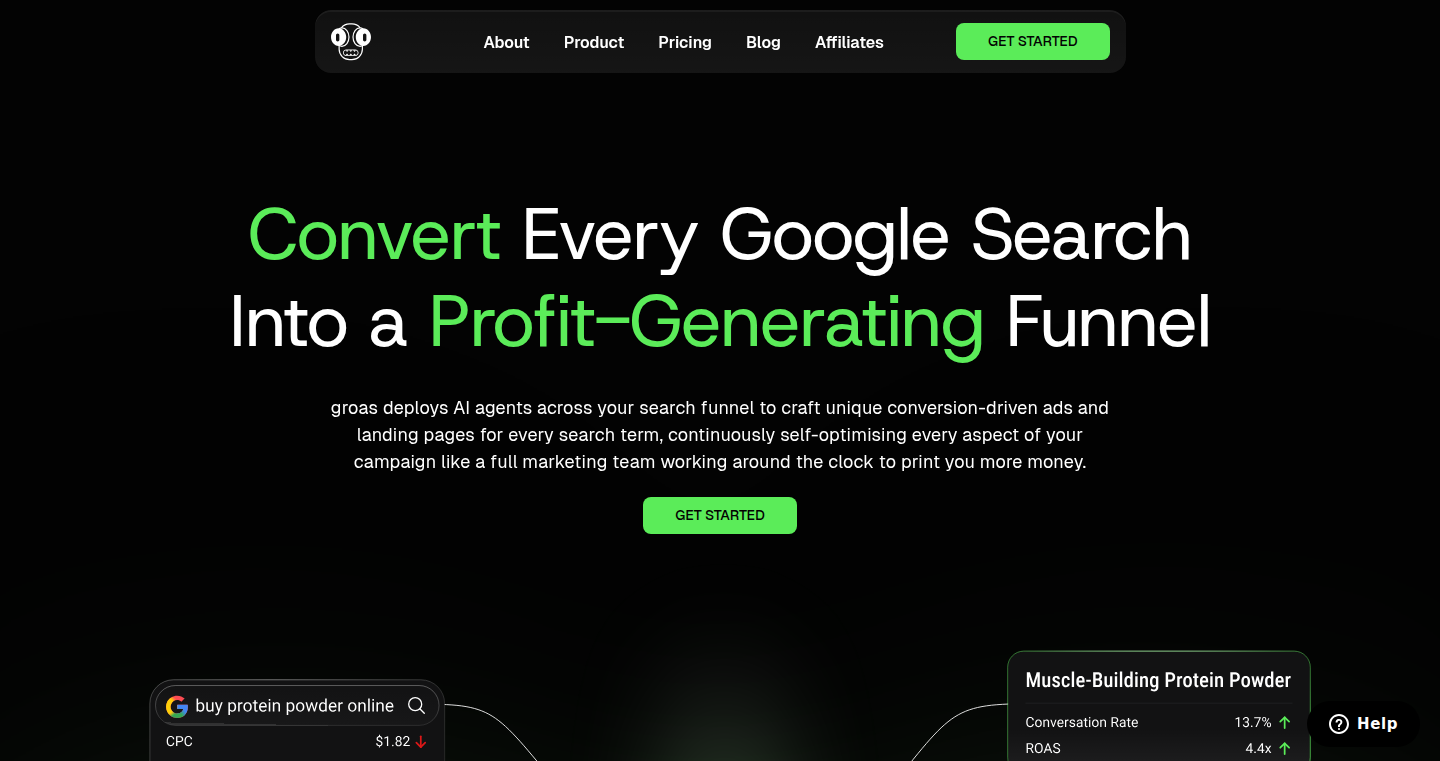
url
Author
ttttransformer
Description
groas is an AI-powered ecosystem designed to automate and optimize Google Ads campaigns. It goes beyond simple keyword research and offers features like custom dynamic landing page generation and 24/7 keyword research, aiming to improve campaign performance. The core innovation lies in its use of AI agents to handle various aspects of campaign management, potentially saving marketers time and resources. This addresses the problem of manual, time-consuming Google Ads optimization.
Popularity
Points 3
Comments 2
What is this product?
groas is essentially a suite of AI tools that work together to make your Google Ads campaigns more effective. Think of it as having a team of virtual marketing assistants. At its core, it leverages AI to automate tasks like finding the best keywords, building landing pages that match those keywords, and constantly monitoring your campaign to make adjustments for better performance. The innovative part is the integration of these AI agents into a single ecosystem, allowing them to work in concert. So this means more efficient ad campaigns.
How to use it?
Developers can use groas to either automate the management of their own Google Ads campaigns or integrate it into marketing platforms they are building. They can access the groas API to build applications or dashboards that leverage its AI-driven optimization capabilities. Imagine building a tool for small businesses that automatically manages their Google Ads, simplifying the complex process of running effective online advertising. So, for developers, this is a ready-made solution for their marketing efforts or their clients.
Product Core Function
· Custom Dynamic Landing Page Generation: This feature automatically creates landing pages tailored to specific keywords and ad campaigns. The AI analyzes the search intent and generates content that matches, improving the chances of conversions. This is useful because it reduces manual landing page creation and increases the relevance of each page to the user's search query, meaning higher conversion rates.
· 24/7 Keyword Research: This feature continuously identifies relevant keywords for your campaigns, keeping them up-to-date with current search trends. AI constantly analyzes search data to find the best keywords to target, so your campaigns will constantly be up-to-date with the market, meaning you'll be attracting the latest customers.
· AI-Driven Campaign Optimization: The ecosystem continuously monitors campaign performance and makes adjustments based on real-time data. This involves tasks like adjusting bids, changing ad copy, and pausing underperforming keywords. It keeps your ads in top shape without you needing to micromanage it all the time.
Product Usage Case
· Small Business Campaign Automation: A small business owner could use groas to completely automate their Google Ads management, freeing up time to focus on other aspects of their business. By leveraging groas, businesses can maintain a consistent online presence, and also can increase sales.
· Marketing Agency Integration: A marketing agency can integrate groas into its platform to offer clients more effective and automated Google Ads management services. This helps marketing agencies scale their advertising operations and give their clients an edge.
· E-commerce Website Optimization: An e-commerce website owner can use groas to optimize their product listing ads, dynamically generating landing pages for each product and keeping the keywords up-to-date. The goal is to target the most relevant customers to your products and increase sales.
17
Dime: Coordinate Noise Reduction for Enhanced Dense Retrieval
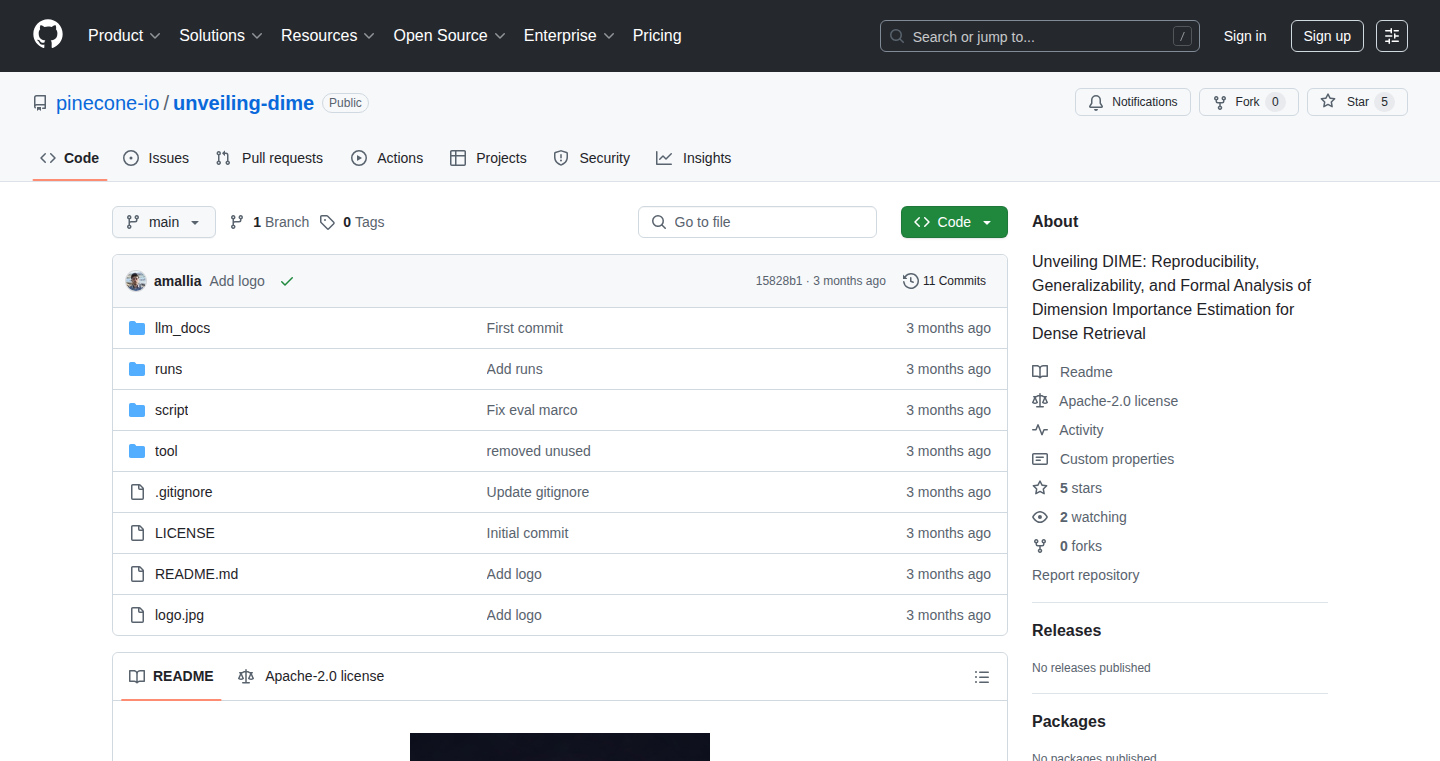
Author
amallia
Description
Dime is a tool that tackles the problem of noisy coordinate data, improving the quality of dense-retrieval systems. It works by subtly adjusting coordinate representations, essentially cleaning up the 'messy' location data that can negatively impact search and information retrieval. This leads to more accurate and relevant results, especially in scenarios where location data is crucial, such as identifying points of interest or finding related content based on spatial proximity. So this allows us to find what we want, where we want it, even when the location data isn't perfect.
Popularity
Points 4
Comments 1
What is this product?
Dime uses a technique to refine coordinate data, such as latitude and longitude, before feeding it into a dense-retrieval system. The core innovation is in how it 'denoises' these coordinates, making them less susceptible to minor inaccuracies. This is done by optimizing the representation of the coordinates. It's like cleaning up the blurry images before sending them to a computer for analysis. By improving the coordinate representation, Dime helps the system better understand the relationships between locations, improving overall search and matching results. So this helps make sure the right location data is used to find the information you need.
How to use it?
Developers can integrate Dime into their dense-retrieval pipelines, especially those dealing with location-based data. The user would typically apply Dime's coordinate transformation before processing the data with a dense-retrieval model (e.g., Sentence Transformers, Faiss, etc.). This could involve wrapping Dime's functionality with their pre-processing steps to fine-tune the coordinate data. This allows them to use it on their existing code to make it better and easier to use. So you can improve your existing systems without major overhauls.
Product Core Function
· Coordinate Denoising: Dime's primary function is to clean and refine noisy coordinate data. This helps systems by removing noise, making them less susceptible to errors in location data.
· Enhanced Retrieval Accuracy: By improving the representation of coordinates, Dime enhances the accuracy of dense-retrieval systems. The system can better identify relevant items based on proximity or spatial relationships.
· Simplified Integration: The tool can be integrated in existing retrieval pipelines without massive changes. This can improve performance and save time for developers.
· Improved Relevance: By focusing on the relevance of location data, Dime ensures users get more pertinent results when using location-based search queries or retrieval tasks.
Product Usage Case
· Real Estate Search: When searching for properties, Dime can improve the accuracy of location-based searches. The system can match the user to the appropriate properties by cleaning the noise in property location data, making the search results more relevant.
· Local Business Discovery: In systems that help people find nearby businesses, Dime can enhance the precision of matching user queries with local establishments. By refining location data, the system can show users the closest and most appropriate businesses.
· Geospatial Data Analysis: Dime is useful in geospatial data analysis applications, where identifying spatial relationships is essential. By refining location data, it makes it easier to see patterns. This can be helpful in tasks like analyzing traffic patterns or studying geographic trends.
· E-commerce with Local Inventory: E-commerce platforms with local inventory can use Dime to improve the matching of customer queries with products available nearby. By refining the inventory’s location data, the system can better match a customer to the item they're looking for.
18
Coin Flipper: A Probabilistic State Generator

Author
artiomyak
Description
Coin Flipper is a simple, yet elegant project that simulates a coin flip. But, it goes beyond just heads or tails. The core innovation lies in its probabilistic state generation. Instead of a hardcoded result, it uses randomness to determine the outcome, offering a flexible way to simulate events with uncertain results. It tackles the fundamental problem of generating random states in software, which is crucial for simulations, games, and any application needing unpredictability.
Popularity
Points 2
Comments 2
What is this product?
Coin Flipper is a basic implementation of a random state generator. Think of it as a tiny computer program that flips a coin. What's interesting is how it does it. It doesn't just pre-define the result; instead, it uses mathematical randomness to simulate the flip. This randomness is key – it's what makes the results unpredictable and therefore, useful for many applications. This project likely uses a pseudo-random number generator (PRNG) to simulate the coin flip, allowing for control over the randomness's seed and the ability to reproduce results if needed. This is its technical innovation.
How to use it?
Developers would likely use Coin Flipper as a library or a simple function call within their own programs. Imagine you're building a game; you could use it to determine the outcome of a dice roll, the success or failure of an action, or even the initial conditions of a level. Integrating it is probably as simple as including a few lines of code and calling a function like `flipCoin()`. This means you can quickly add an element of chance or uncertainty to your applications.
Product Core Function
· `flipCoin()`: This core function generates a random outcome, probably using a PRNG to simulate a coin flip. The technical value lies in the provision of a simple, reproducible (with proper seeding), and easily-integrated way to create random events. This allows developers to add an element of unpredictability and chance to their applications, making them more engaging and realistic. For example, imagine you are simulating network conditions, you could use it to simulate packet loss.
· Seeding the Randomness: Some versions allow you to 'seed' the random number generator. This is a technical feature that enables you to control the randomness. By setting a specific seed, you can make the coin flip generate the same sequence of results every time. This is incredibly useful for testing and debugging, ensuring that your simulations behave consistently. For instance, you could seed the flip to reproduce a bug to fix the problem.
Product Usage Case
· Game Development: Imagine you're creating a role-playing game. You could use Coin Flipper to simulate critical hits, character skill successes, or even the outcome of random encounters. This adds an element of chance and excitement to the gameplay, making it more engaging. You can also control the outcome by seeding the PRNG.
· Simulation Software: Scientists and engineers use simulations to model real-world phenomena. You could use Coin Flipper to simulate events with a degree of randomness, like the decay of a radioactive atom or the collision of particles. This allows for the creation of more realistic models. The ability to control the seed allows for creating reproducible research.
· Educational Tools: In educational settings, you could use Coin Flipper to teach probability and statistics. You could flip the 'coin' thousands of times and analyze the results to demonstrate the concepts of random variables and probability distributions. Moreover, you can demonstrate how randomness works and the importance of it, as well as how to control or seed the randomness.
19
Cartlink: Automated Content Monetization Engine

Author
maclark25
Description
Cartlink is a tool designed to help content creators, especially influencers, make money from their existing content effortlessly. It cleverly identifies products mentioned in videos, photos, and text, automatically links them to purchase pages, and generates revenue through affiliate marketing. The core innovation lies in its automated detection and linking process, eliminating the need for creators to manually insert links or negotiate brand deals. So this automates the monetization process.
Popularity
Points 2
Comments 2
What is this product?
Cartlink is a system that uses clever algorithms and potentially machine learning to analyze a content creator's existing posts (videos, images, text). It scans the content for mentions of products. When it finds a product, it automatically searches for an affiliate link to that product, and adds the link to the creator's content. When someone clicks and buys, the creator earns a commission. The innovation here is the automation; no more manual linking or relying on sponsored content. So this saves time and increases potential earnings.
How to use it?
Content creators can integrate Cartlink by providing access to their content sources (e.g., social media profiles, website). Cartlink then works in the background, analyzing content and inserting affiliate links. Creators can then monitor their earnings through Cartlink's dashboard. So this allows content creators to easily monetize their existing audience and content.
Product Core Function
· Automated Product Detection: This function uses natural language processing (NLP) and image recognition to identify products mentioned in content. Value: Saves creators significant time and effort by automatically identifying and cataloging products, allowing them to monetize content without manual tagging or editing. Application: Enables efficient monetization of existing content, as the system works in the background, identifying and linking to products mentioned in posts and videos.
· Affiliate Link Generation: This feature links detected products to affiliate programs. Value: Transforms product mentions into revenue-generating opportunities, removing the need to negotiate individual brand deals. Application: Simplifies and automates the process of connecting content to revenue streams, giving creators a passive income opportunity.
· Performance Tracking: Cartlink offers analytics and reporting to track the performance of linked products. Value: Provides creators with insight into which products generate the most revenue. Application: Helps optimize content strategies and identify high-performing product placements.
Product Usage Case
· A beauty influencer posts a video reviewing a new makeup product. Cartlink automatically detects the product, finds the affiliate link, and inserts it into the video's description. Viewers click the link and purchase the product, earning the influencer a commission. So this generates passive income.
· A food blogger writes a recipe post mentioning a specific brand of olive oil. Cartlink finds the affiliate link for the olive oil and inserts it into the blog post. Readers can easily purchase the oil. So this turns a simple recipe into a revenue opportunity.
· A travel blogger posts photos of their luggage. Cartlink detects the luggage brand and adds affiliate links. Readers who want to purchase the luggage can easily do so. So this allows the travel blogger to passively monetize their posts about products.
20
CardGen: Realistic Credit Card Details Generator
Author
rahulbstomar
Description
CardGen is a free, offline-capable tool that generates realistic-looking credit card details for developers and testers. The core innovation lies in its ability to create valid card numbers (meeting Luhn algorithm checks) for over 15 different payment networks, covering a wide range of regions. It's designed for testing purposes, allowing developers to simulate payment processes and UI elements without using real credit card information. This is crucial for security and preventing accidental charges during development. So, it helps you test payment forms safely.
Popularity
Points 3
Comments 1
What is this product?
CardGen is a web-based tool that uses algorithms to create credit card numbers, expiry dates, and security codes that appear legitimate. It supports various card types like Visa, Mastercard, and American Express. It incorporates the Luhn algorithm (a checksum formula) to ensure the generated card numbers are valid in a technical sense, meaning they would pass basic validation on a payment system. This ensures the generated details are suitable for testing. So, it provides a safe and easy way to test payment forms.
How to use it?
Developers can access CardGen through its web interface (it works offline too!). You don't need to sign up. You simply click the button to generate the card details, and then copy the generated information for testing. This generated data can then be used in the development environment to simulate the payment process, integrate payment gateways, and test UI/UX designs related to payment flows. So, you can quickly get test card data to try out your payment integrations.
Product Core Function
· Generating valid credit card numbers: The core function is generating numbers that comply with the Luhn algorithm and correspond to various card networks. This enables realistic testing because the generated numbers can often pass initial validation checks. So, you can simulate valid card numbers for testing purposes.
· Supporting multiple card networks: The tool supports a wide variety of credit card networks (Visa, Mastercard, Amex, etc.). This is essential for simulating different payment scenarios and testing compatibility with various payment processors. So, you can test different payment card types.
· Generating region-specific formats: The generator provides card formats that match regional standards. This helps developers create more realistic testing scenarios, especially when testing localized payment systems. So, you can test regional payment formats.
· Offline functionality: CardGen is designed to function offline as a PWA (Progressive Web App). This is a significant advantage as it allows you to generate card details even without an internet connection. So, you can test your code anywhere, even without an internet connection.
· Interactive UI with card flip animation: Provides a user-friendly interface with a card flip animation for better visual representation of the card details. So, it offers a visually appealing and user-friendly interface.
Product Usage Case
· Testing payment form UI: Developers can use the generated card details to populate payment forms on a website or application and ensure all the UI elements (input fields, error messages, etc.) are working correctly and displaying information as expected. So, you can ensure your payment forms look and function properly.
· Building demos and prototypes: CardGen helps create demos and prototypes demonstrating payment integration features. Developers can use the generated card information to simulate payment transactions and showcases features without risking real transactions. So, you can create demonstrations of payment integration without real card details.
· Teaching and learning payment flows: The tool is useful for teaching payment processing concepts. Students and newcomers to web development can use it to experiment and understand how payment gateways work by simulating transactions. So, you can use the tool for educational purposes.
· Validating frontend validation: Developers can use the generated data to validate the frontend validation logic, ensuring that the application correctly validates the card number, expiry date, and CVC. So, you can ensure your validation logic functions correctly.
21
BinRev: Visual Binary Reverser
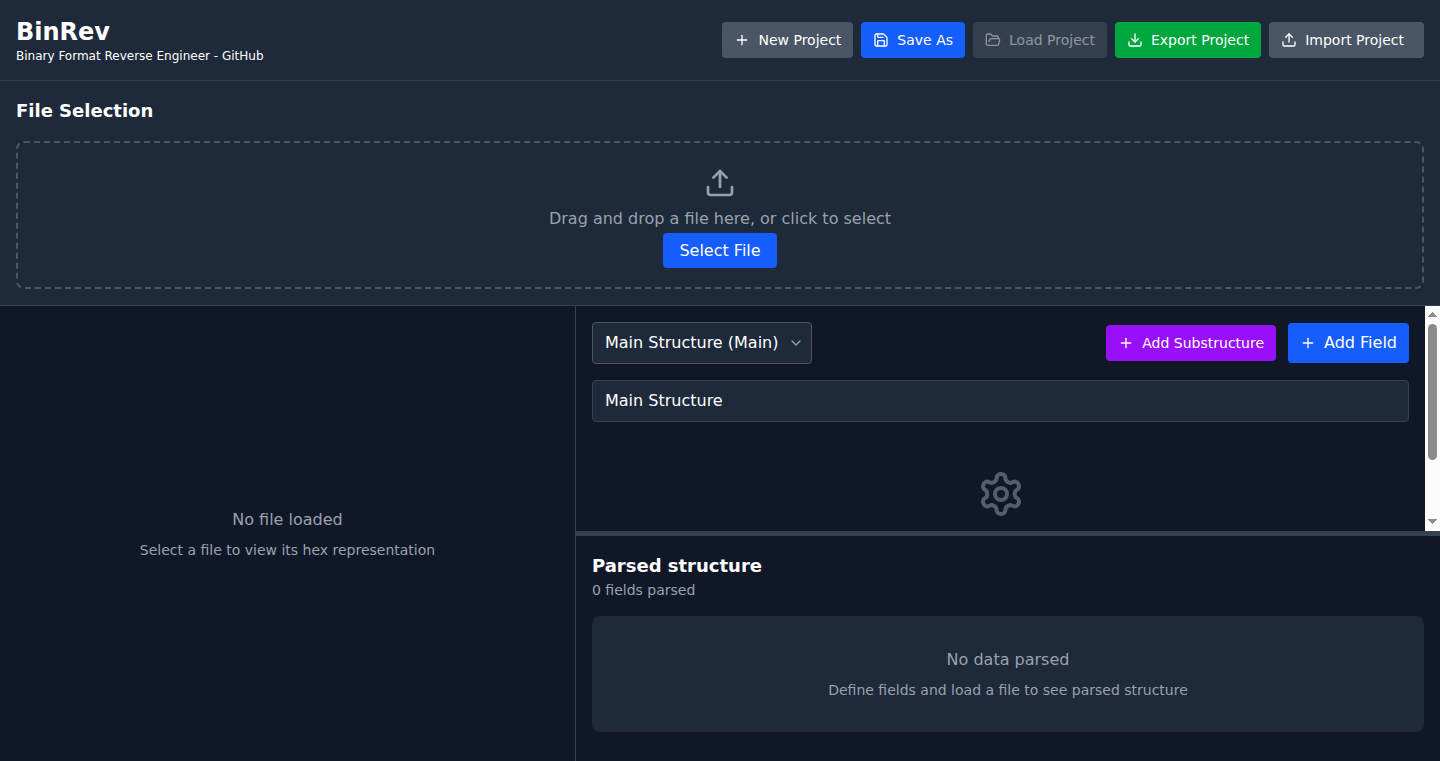
Author
wingtw
Description
BinRev is a web-based tool designed to help reverse engineer binary files, especially those with unknown formats. It provides a visual interface for analyzing binary structures step by step, allowing users to understand and export the format in a machine-readable format. The project leverages AI coding capabilities, evolving from an AI coding experiment to a polished tool. It runs locally in your browser, ensuring privacy and security by not sending any data to external servers. So, it allows you to dissect binary files, understanding their structure without requiring you to send potentially sensitive data over the internet.
Popularity
Points 3
Comments 0
What is this product?
BinRev works by allowing users to visually inspect binary files. Think of it as a microscope for digital files. You can load a binary file, and the tool helps you understand its structure by visualizing different parts and data. It can analyze complex formats, and as you figure out the file's structure, you can export your findings in a machine-readable format (like JSON or a custom format). The initial code utilized an AI coding agent, but it has since been improved with different tools and models. So, it provides an intuitive way to explore and understand binary data, which can be useful for security analysis, software debugging, or understanding how data is stored in various files.
How to use it?
Developers can use BinRev by simply loading a binary file into the web interface. They can then use the visual tools to explore the file's structure. For example, you can step through the file, identify different data sections, and see how data is organized. As you understand the structure, you can create rules or patterns that BinRev can use to automatically identify similar patterns in the future. These findings can then be exported for use in other tools or scripts. So, you can use BinRev to analyze firmware updates, reverse engineer proprietary file formats, or understand the inner workings of software.
Product Core Function
· Visual Binary Inspection: Allows users to explore binary files visually, making it easier to understand the file structure. This is useful for identifying patterns and data segments.
· Step-by-Step Analysis: Supports analyzing a binary file step by step, which helps developers to break down complex structures into manageable parts.
· Machine-Readable Export: Enables the export of identified structures in a machine-readable format, like JSON. This is valuable for integrating findings into other analysis tools or scripts.
· Local Browser Execution: The tool runs locally in the browser, guaranteeing data privacy and security by preventing the need to send data to any external servers. This makes it ideal for handling sensitive binary data.
· Open Source & Free to Use: Being open source and free, it encourages collaboration and allows anyone to use, modify, and share the tool without any restrictions.
Product Usage Case
· Firmware Analysis: A security researcher could use BinRev to analyze the firmware of a router. By understanding the firmware's structure, they could identify vulnerabilities or backdoors. For you, it means you can better understand and assess the security of devices.
· Reverse Engineering Proprietary Formats: A developer working with a custom file format could use BinRev to understand its structure and how data is organized. This is useful for creating tools that can read or write these formats. For you, it means you can work with obscure or undocumented file formats.
· Software Debugging: A software engineer could use BinRev to examine memory dumps or program binaries to diagnose software issues, by visualizing how the data is organized and identifying possible errors. For you, it helps to pinpoint the source of bugs.
· Security Auditing: Security professionals can use BinRev to inspect executable files or data files, helping to identify malicious code, or security vulnerabilities, and understand program behavior without executing it. For you, it improves your ability to identify potential security risks.
22
StopAddict: Gamified Habit Breaking
Author
skyzouw
Description
StopAddict is a minimalist application designed to help users overcome addictions by turning the process into a game. The core innovation lies in its gamification approach. By awarding experience points (XP) and building visible streaks for each day an addiction is resisted, the tool provides a clear sense of progress. This helps users track their small wins, motivating them to maintain consistency. It addresses the common struggle of quitting bad habits by leveraging the psychological principles of reward and visual feedback.
Popularity
Points 2
Comments 1
What is this product?
StopAddict is a web application that gamifies the process of breaking addictions. It uses a simple points and streak system. Every day you resist the urge, you earn XP and build a streak. The visual representation of your progress helps you stay motivated. It's built on the idea that seeing your progress, even in a simple form, makes it easier to stick to your goals. So, it's like turning your difficult task into a game, making it less daunting and more rewarding.
How to use it?
Developers can integrate the principles of StopAddict into their own applications or projects that focus on user behavior change. For example, a fitness app could use a similar system to track workout streaks and award points. Or a productivity tool could gamify task completion. This involves creating a database to store user progress, designing a user interface to display streaks and points, and implementing a system for rewarding achievements. This approach can be particularly useful for increasing user engagement and retention.
Product Core Function
· Streak Tracking: This feature visibly displays consecutive days of resisting an addiction, providing a visual reminder of progress. So what? This provides immediate feedback and motivation, helping users recognize their consistency and preventing them from giving up.
· XP (Experience Points) System: Users earn points for each day they resist their addiction. These points contribute to a sense of achievement. So what? This makes the process of quitting more engaging and rewarding, similar to the leveling up system in games. It helps users feel a sense of accomplishment.
· Minimalist Interface: The app has a clean, distraction-free design, focused on displaying progress. So what? This keeps the user focused on the core task of resisting the addiction, avoiding overwhelming them with unnecessary information.
· Progress Visualization: The app provides a visual representation of the user's progress. So what? By visualizing progress, users can clearly see how far they've come and are more likely to stay on track.
Product Usage Case
· Fitness App Development: A fitness app could adopt a similar system to reward users for completing workout streaks and earning points. This increases user engagement and motivates consistent exercise. So what? It can help users stay motivated and achieve their fitness goals.
· Productivity Tool Implementation: A productivity application could gamify task completion by awarding points and streaks for finishing projects on time. So what? This enhances user productivity and increases the likelihood of them completing their work.
· Habit-Tracking Software: Software designed to track habits could use this technique to help people build and maintain new behaviors. So what? It helps users visually see their progress and get motivated.
· Learning Platforms: Online learning platforms can apply these techniques by rewarding students with badges, points, and streaks for finishing courses and assignments. So what? This encourages students to stay engaged and complete their education.
23
PhotoDedupe: Local Photo Organizer with Duplicate Detection
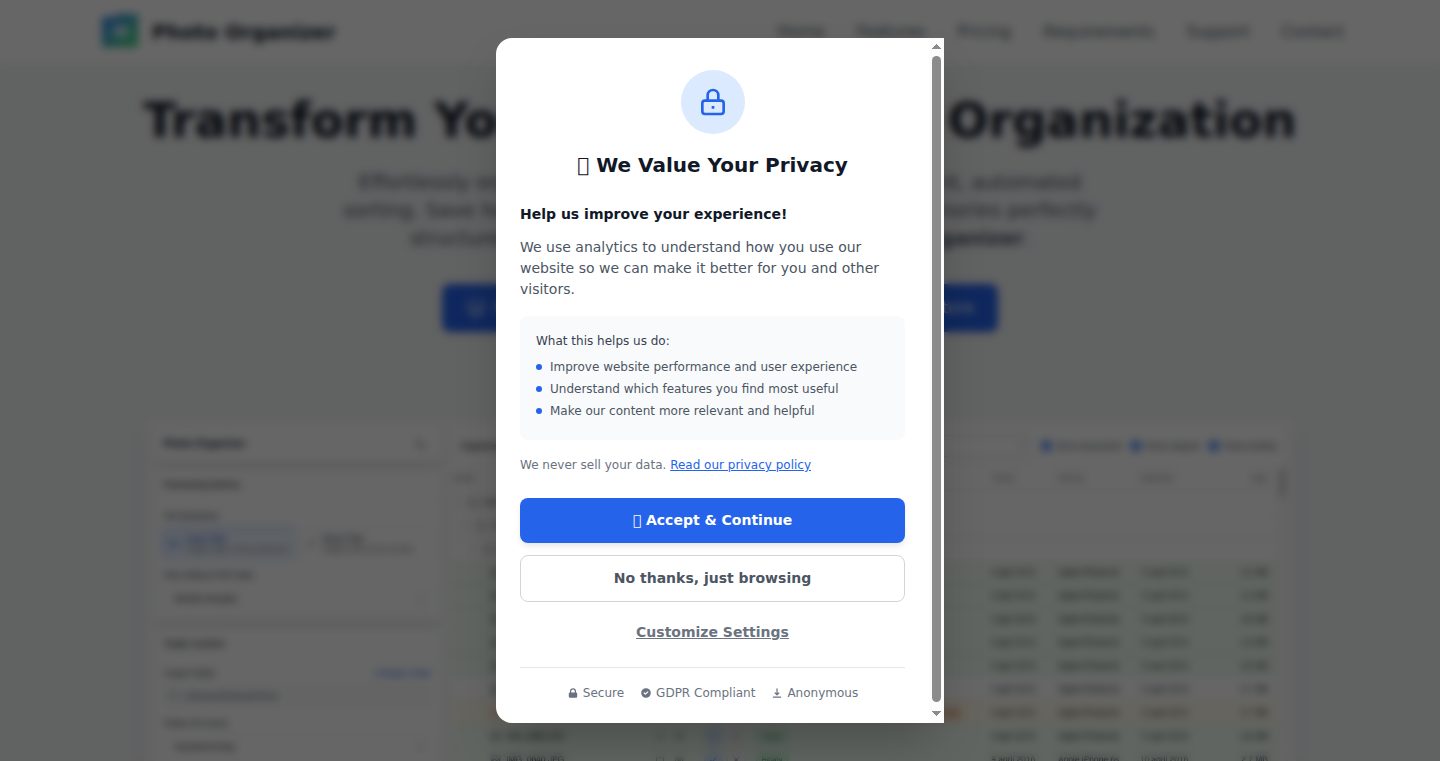
Author
mcvanhassel
Description
PhotoDedupe is a desktop application designed to help you organize your photos stored locally on your computer. The core innovation lies in its ability to automatically detect and remove duplicate photos, saving you storage space and making your photo library easier to manage. It addresses the common problem of having multiple copies of the same photo scattered across different folders or devices.
Popularity
Points 2
Comments 1
What is this product?
PhotoDedupe is a desktop application that analyzes your photo library, identifies and removes duplicate images. It works by comparing the content of photos, not just filenames. This is usually done using advanced techniques like comparing the visual fingerprints of the images. Imagine each photo is given a unique 'fingerprint', and the application compares these fingerprints to find matches. So, what you get is an application that can find nearly identical photos even if they have different names or are in different formats. The value lies in the efficient use of storage and the simplified organization of your photo collection.
How to use it?
Developers can use PhotoDedupe by downloading and installing the desktop application on their operating system. After importing the folders containing photos, the application scans the photos, identifies duplicates, and presents the user with options to review and remove them. Developers can integrate its functionality into their own applications by building a similar system to identify duplicates or using its core algorithms to optimize image storage in any photo management tool.
Product Core Function
· Duplicate Detection: The core function is to scan image files and compare them to detect duplicates, even if the filenames differ. This is done through image analysis techniques that consider the pixel data rather than just the metadata. So what? You get to free up storage space and keep only the best version of your photos. This is useful for anyone who accumulates many photos from different sources.
· Local File Scanning: The application focuses on local storage, providing privacy and faster processing compared to cloud-based solutions. So what? You have control over your photo data, ensuring privacy and faster operation.
· User-Friendly Interface: It provides an intuitive interface for users to review the duplicates and make decisions on which images to keep or delete. So what? This simplifies the photo management process, making it accessible to non-technical users.
· Preview and Selection: Users can preview the duplicate images side-by-side and select which ones to delete or keep. So what? This allows users to easily compare the images and choose the best versions to retain, preventing accidental deletion of important photos.
Product Usage Case
· Photo Management App Development: A developer is building a new photo management application, they can integrate the duplicate detection algorithm to automatically identify and suggest removal of duplicate photos, thereby enhancing the user experience. The advantage is clean and optimized photo libraries for the end-users.
· Personal Photo Backup and Archiving: Someone backing up their photos from multiple devices (phone, camera, hard drives) can use PhotoDedupe to remove duplicates after each backup, keeping the archive clean and saving storage space. The advantage is simplified backup management without redundant copies.
· Large Photo Library Cleaning: Anyone with a large, unorganized photo library can use PhotoDedupe to quickly identify and remove duplicates, making it easier to find the photos they need. The advantage is a more manageable photo collection with improved search results.
24
NotebookLM Web Importer - Turn Web Pages into Smart Notes
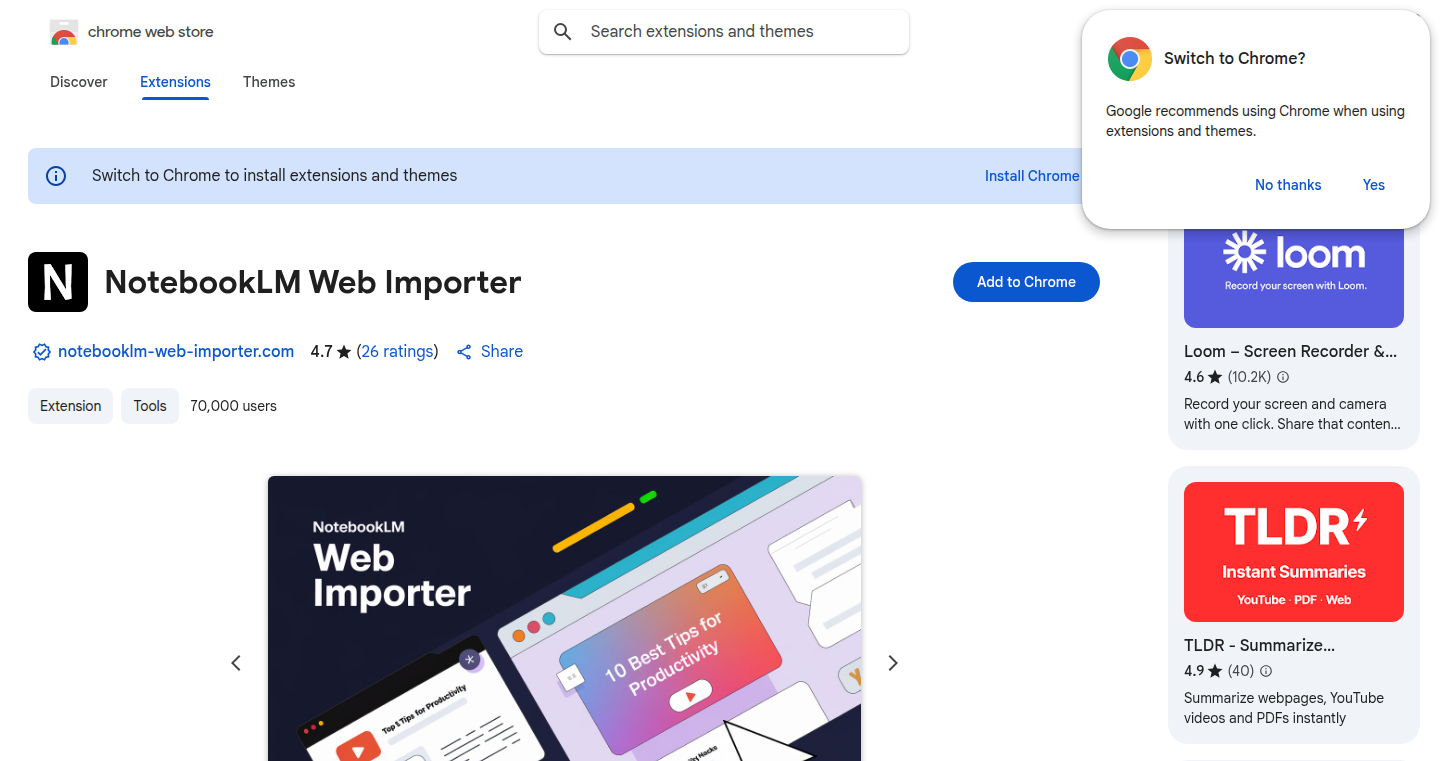
url
Author
wonderfuly
Description
This project allows users to quickly import web pages into NotebookLM, a tool for creating smart notes. The innovation lies in its ability to intelligently extract and organize information from the web, making it easier to build a knowledge base without manual copy-pasting. It tackles the problem of information overload by automating the process of gathering and structuring data from various online sources.
Popularity
Points 3
Comments 0
What is this product?
It's a browser extension that simplifies the process of saving and organizing information from websites directly into NotebookLM. The core technology likely involves web scraping techniques to extract content, potentially using natural language processing (NLP) to identify key information, headings, and relevant text, and then structuring that information in a format that NotebookLM can understand. This automates what used to be a time-consuming manual process. So this automates the process of collecting and structuring web content into a knowledge management tool. So this is useful because it saves you time and effort when gathering information from the internet for research, learning or content creation.
How to use it?
Install the browser extension, browse the web, and with a click, send relevant web pages to your NotebookLM. The imported content will be automatically formatted and organized, ready for you to review, annotate, and use. You'll then be able to use it to build a knowledge base within NotebookLM, query the data, and find insights. So you can use this whenever you need to collect information from websites – research reports, articles, blog posts, any web page with valuable information that you want to easily save and organize.
Product Core Function
· Web Page Content Extraction: Automatically extracts the text, images, and other relevant content from a web page. This eliminates the need for manual copy-pasting, saving users time and effort. Useful for anyone who needs to gather information from the web.
· Intelligent Information Organization: The extension likely analyzes the extracted content to identify headings, subheadings, and key paragraphs, organizing the information in a structured manner. This makes the imported information easier to read and navigate. Useful for researchers, students, and anyone who needs to work with large amounts of online information.
· NotebookLM Integration: The extension directly imports the extracted and organized content into NotebookLM. This allows users to utilize NotebookLM's features like note-taking, summarization, and Q&A. So you can use it to easily build your own knowledge base and access it quickly.
· Content Formatting: This helps to maintain the formatting to make the extracted information more presentable and easy to use. For example, maintaining the heading and bullet points from the website. Useful to ensure that the extracted data is in a good reading format.
Product Usage Case
· Research: A student can import articles from multiple sources for a research paper, automatically organizing the information and allowing for easy note-taking and summarization within NotebookLM. This saves time and allows to keep track of different sources.
· Content Creation: A blogger can use the extension to quickly gather information from different websites for inspiration and references, organize the content, and create drafts. This streamlines the research and writing process.
· Knowledge Management: A professional can use the extension to collect information from industry news and articles, organizing it for easy access and reference in their workflow. This creates a quick way to learn and retrieve specific data later on.
· Learning: A learner can quickly import information from educational websites or documents, organize it, and create their own notes using the NotebookLM. This facilitates a more effective and organized learning process.
25
Drumtabs.app: Text-Based Drum Tablature Editor with Audio and Sheet Music
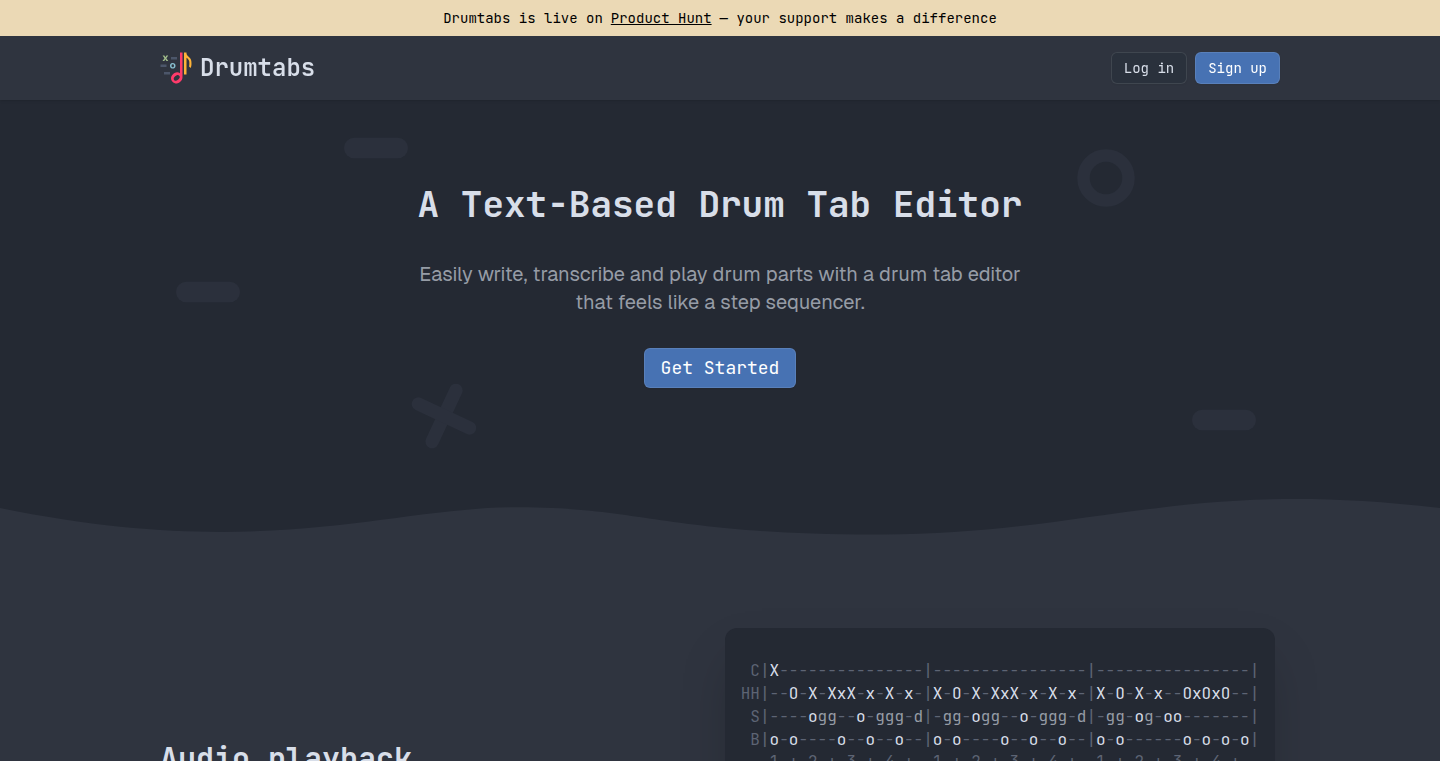
Author
VincentCordobes
Description
Drumtabs.app is a web-based editor that allows musicians to create and share drum tablature (drum tabs) using plain text. It moves beyond the limitations of traditional text-based drum tabs by implementing a step sequencer-like interface. This ensures the rhythm is accurate and makes editing much easier. The project incorporates audio playback for immediate feedback and renders the text-based tabs into standard sheet music notation. The innovation lies in transforming a traditionally cumbersome text-based format into a user-friendly and interactive tool, addressing the challenges of accuracy, editing, and sharing in drum music transcription.
Popularity
Points 3
Comments 0
What is this product?
This project is an online tool that allows you to write drum music using text. Instead of struggling with complicated music notation software or trying to make sense of messy text-based tabs, you can use a simple, structured format within the web editor. It provides an interface similar to a step sequencer – think of it like programming beats visually. It also plays the music back for you to check and converts the text into standard sheet music. So it's like having an easy-to-use text editor for drum music, with built-in sound and sheet music generation. So what? It simplifies the process of creating, editing, and sharing drum music, making it accessible and efficient.
How to use it?
Developers can use Drumtabs.app by simply visiting the website and starting to type drum patterns in the specified text format. The system automatically interprets the text, generates audio playback, and displays sheet music. Developers can integrate this into their own projects, like music education platforms, or create customized tools for specific musical tasks. Imagine building a web app for collaborative drum lessons or incorporating drum transcription into a larger music composition tool. So what? It opens up possibilities for creating educational resources, music composition tools, and collaborative music platforms.
Product Core Function
· Text-based drum tab editor: This is the core function that allows users to write drum tabs using plain text. The structured text format makes editing and understanding drum patterns easy. The value is a simplified approach to music transcription, reducing the learning curve associated with complex music notation software. So what? It provides a quick and efficient way to capture and share drum patterns.
· Step sequencer-like interface: The editor visually represents the drum patterns similar to a step sequencer. This representation helps with rhythm accuracy and simplifies the editing process. The value is the intuitive visual feedback that makes it easier to identify and correct rhythmic errors. So what? It significantly improves the accuracy and ease of creating drum patterns.
· Audio playback: The editor includes an audio playback feature to instantly hear what you've written. This enables musicians to quickly verify the accuracy and sound of their tabs. The value is the immediate feedback, allowing rapid iteration and refinement of the drum patterns. So what? It lets you hear your music instantly, saving time and improving the quality of your output.
· Sheet music rendering: Drumtabs.app automatically converts the text-based tabs into standard sheet music notation. This allows for easy sharing and collaboration with musicians who prefer traditional music notation. The value lies in bridging the gap between text-based tabs and conventional music notation, expanding the audience of your compositions. So what? It makes your drum music accessible to a wider audience and enables seamless collaboration.
Product Usage Case
· Music Education Platform: A developer could integrate Drumtabs.app into a music education website. Students could write drum patterns in the editor and immediately hear them, receiving visual and auditory feedback. The platform can then use the generated sheet music to teach notation. This addresses the need for interactive and engaging music education tools. So what? It creates a more interactive and accessible learning experience for students.
· Collaborative Music Composition Tool: A music production company could develop a tool allowing multiple users to collaborate on drum arrangements. Users could edit drum tabs in real-time, and the tool would provide instant audio playback and sheet music rendering. This solves the problems of version control and seamless collaboration in music production. So what? It provides an easy and efficient collaborative environment for musicians to work together.
· Personal Music Transcription Workflow: A musician could use Drumtabs.app as their primary tool for transcribing drum parts. They could write their tabs in the editor, instantly hear the playback, and have the sheet music generated. This streamlines the transcription process and eliminates the need for multiple software tools. So what? It simplifies the music transcription workflow by providing a unified tool that handles all aspects of the process.
26
OpenAudit: A Flexible Node.js Auditing Library
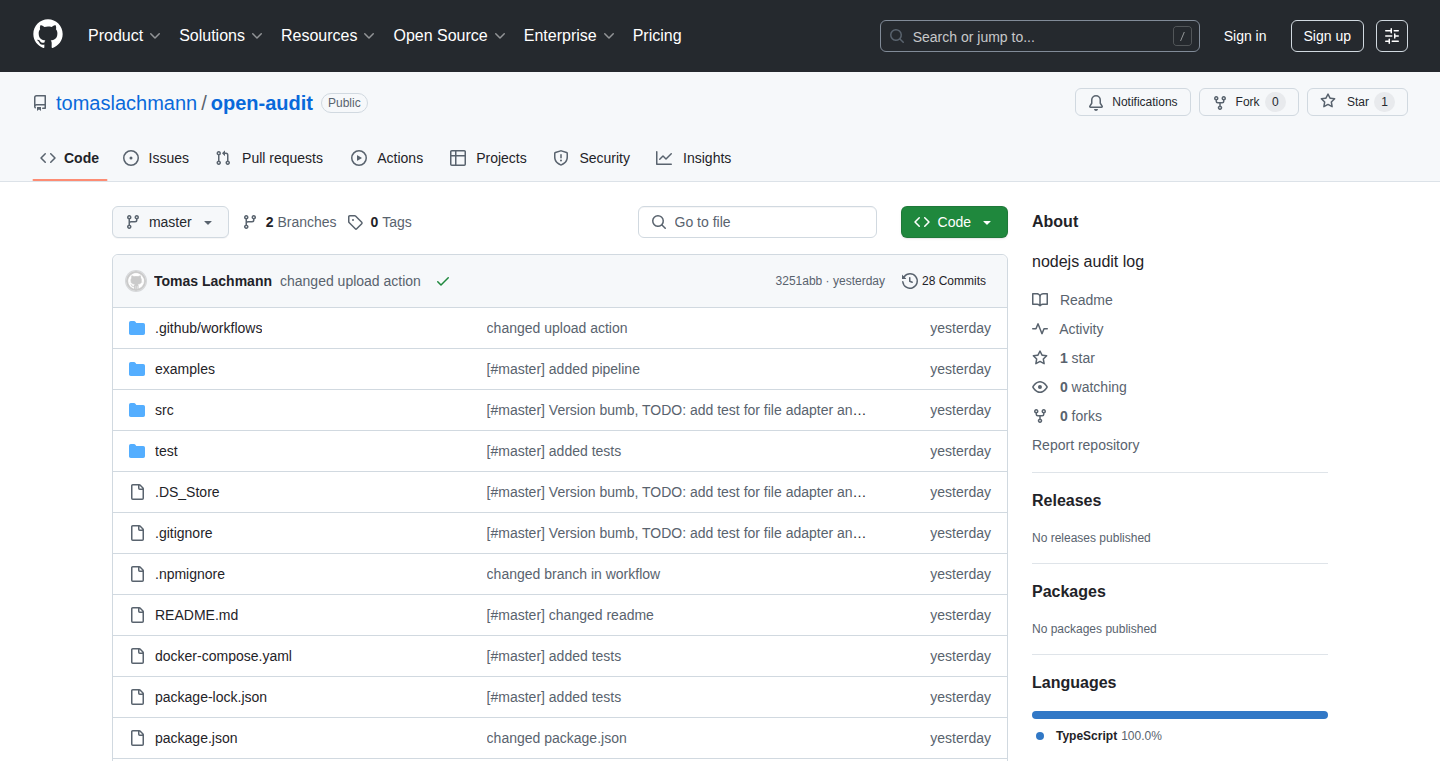
Author
arcari
Description
OpenAudit is a Node.js library designed to easily integrate auditing functionality into your applications. It allows developers to track actions within their systems, such as database changes, user interactions, and other significant events. The key innovation lies in its pluggable adapter system, which enables developers to seamlessly store audit logs in various databases (PostgreSQL, MySQL, MongoDB, SQLite, and even flat files) without modifying core application logic. This simplifies compliance and debugging by providing a clear record of system activity.
Popularity
Points 3
Comments 0
What is this product?
OpenAudit is a tool that helps you keep a detailed record of what happens in your application. It works by 'listening' to important events and storing them in a database or a file. The clever part is its pluggable system. This means you can choose where to save the audit logs - like a specific database or even a simple text file - without changing how your application works. So, if you need to prove you're following the rules (compliance) or figure out why something went wrong (debugging), OpenAudit gives you the information you need. So, this helps me understand the changes happening in my app and track any suspicious behavior.
How to use it?
Developers can easily integrate OpenAudit into their Node.js applications by installing the library and then using a simple function `logEvent(actor, action, entity, metadata)`. You specify who did something (actor), what they did (action), what it was done to (entity), and any extra details (metadata). OpenAudit then handles storing this information in the database you've chosen. You can use this to monitor what your users are doing, to track changes to important data, and to meet compliance requirements. So, you can easily monitor and understand user behavior.
Product Core Function
· Pluggable Adapter System: This is like having different 'plugs' for different databases. It allows you to easily switch where your audit logs are stored (PostgreSQL, MySQL, MongoDB, etc.) without changing the main part of your application. This means you can adapt your logging to different environments and needs. So, this saves me time and effort when I need to change how logs are stored.
· Built-in Database Support: OpenAudit comes ready to work with many popular databases right out of the box. This includes PostgreSQL, MySQL, MongoDB, SQLite, and even flat files. This means you can start using audit logging quickly without needing to build complex integrations. So, it provides ready-to-use solutions and saves me time.
· Easy-to-Use Function: The core function `logEvent(actor, action, entity, metadata)` is simple and straightforward. You just call this function whenever something important happens in your application, and it records the details. This simplicity makes it easy to integrate auditing into your existing code without a steep learning curve. So, I can easily add auditing without making my code complex.
· TypeScript Support: The library is fully typed with TypeScript. This means your code is more reliable and easier to maintain because the code editor will catch errors as you type. This also improves developer experience. So, it improves code quality and helps me avoid mistakes.
· Comprehensive Testing: The library includes comprehensive testing using Vitest. This ensures that OpenAudit works reliably and as expected. So, the library is more reliable.
· CLI and Example Project: OpenAudit provides a command-line interface (CLI) and example project to make it easy to get started. The CLI simplifies tasks related to the library, and the example project demonstrates how to integrate auditing into your application. So, it is easier to get started, even for newcomers.
Product Usage Case
· Data Change Tracking: In an e-commerce application, use OpenAudit to track changes to product prices, inventory levels, or customer details. This helps in identifying who made the change, when it was made, and the previous values, which is crucial for fraud detection or error investigation. So, I can easily track important data changes and their history.
· User Activity Monitoring: In a social media platform, OpenAudit can monitor user actions such as posts, comments, and profile updates. This helps detect suspicious behavior or unwanted activities like spamming or abuse. So, I can monitor user actions and detect harmful behaviors.
· Compliance Auditing: For financial or healthcare applications, OpenAudit helps meet compliance requirements by providing a clear audit trail of all data access and modifications. This demonstrates that you're following regulations such as GDPR or HIPAA. So, this helps me meet the compliance requirements.
· Debugging and Troubleshooting: When a critical error occurs, OpenAudit logs allow developers to trace back the sequence of events leading up to the error. By examining the audit trail, developers can identify the root cause of the problem and fix it. So, I can easily understand the sequence of events and fix them.
· Security Incident Response: If a security breach happens, OpenAudit logs can assist in identifying the extent of the damage. By analyzing the logs, developers can understand the attacker's actions and the data affected. So, this helps with the investigation and remediation of security breaches.
27
VT Chat: A Minimalist AI Chat Interface
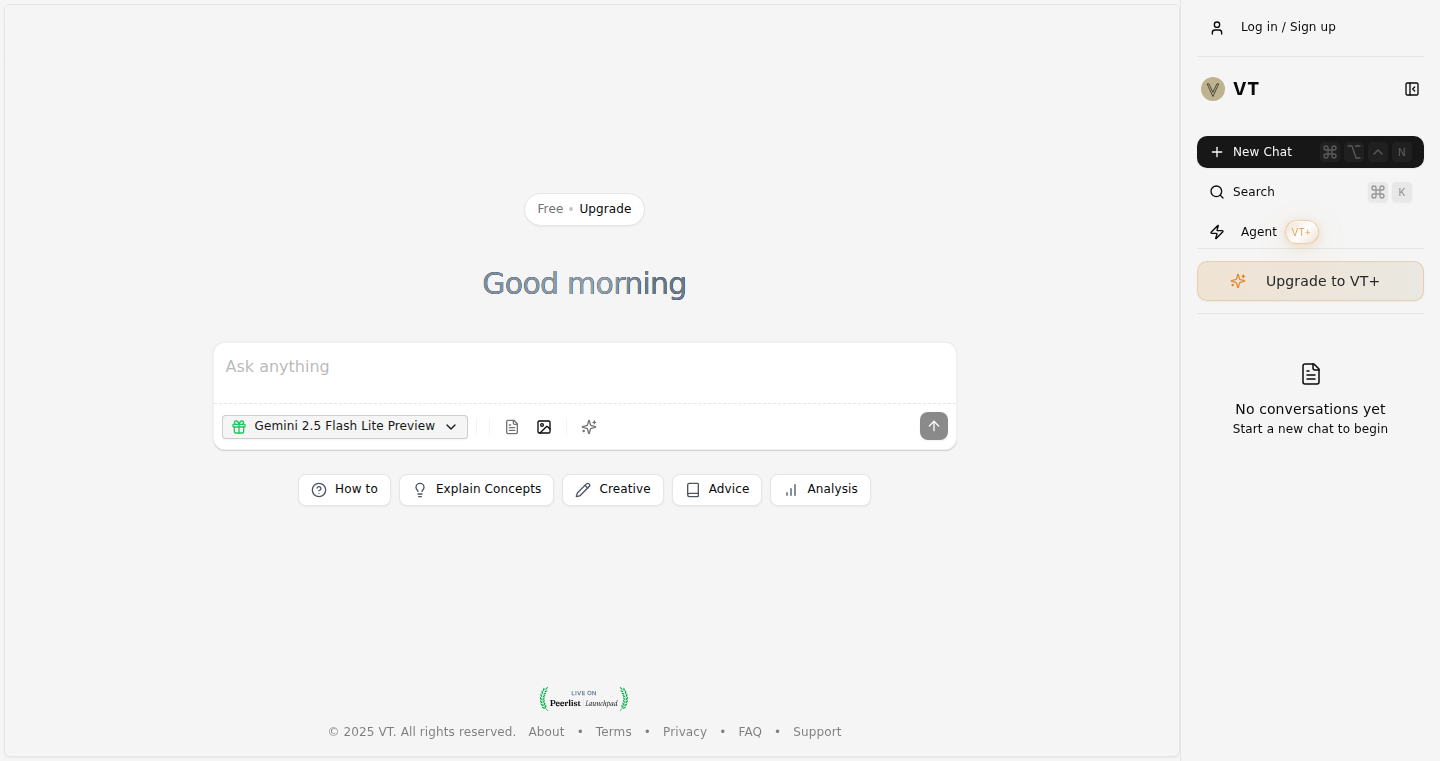
Author
vinhnx
Description
VT Chat is a Show HN project that offers a streamlined and minimalist interface for interacting with large language models (LLMs) like those powering AI chatbots. The core innovation lies in its focus on simplicity and speed. It strips away unnecessary features, emphasizing a clean and efficient user experience for quick text-based conversations. It's designed to be a no-frills way to experiment with and utilize the power of AI, without the distractions of a complex UI. So this allows you to quickly test and iterate with AI without the overhead of a feature-rich chatbot.
Popularity
Points 3
Comments 0
What is this product?
VT Chat is a barebones chat interface for interacting with AI models. Its core is built on the principle of minimalism: it provides a simple text input and output. The innovation here is the removal of distractions. Many AI chat interfaces include a plethora of features. VT Chat removes all but the core interaction: the prompt and the response. This allows for rapid experimentation and quick results. It's about getting to the heart of the AI interaction as quickly as possible, providing a better way to directly interface with the AI. So, this gives you a clean, focused environment for AI experimentation, letting you learn and test AI capabilities faster.
How to use it?
Developers can use VT Chat by simply providing a prompt or question to the AI model through the interface. This prompt is then processed by the underlying AI model, and the response is displayed in a clear, concise format. Integration is as simple as linking to the VT Chat interface and providing an API key for the desired AI model. Example use cases include rapid prototyping of chatbot interactions, quick testing of different AI models, or integrating AI responses into other applications where a minimalist UI is preferred. So, this allows developers to quickly prototype and integrate AI functionalities without getting bogged down in complex UI elements.
Product Core Function
· Minimalist Chat Interface: The core function is a simple text input field and a display area for AI responses. This minimalist design allows for quicker interactions and a less cluttered experience. So, you can directly experiment with AI prompts without the visual clutter of extra features.
· API Key Integration: VT Chat likely supports the use of API keys from different AI providers, allowing users to connect to various language models. This is important for flexibility and compatibility. So, you can choose the AI model that best suits your needs and quickly swap between different models.
· Real-time Response Display: The project likely provides a real-time display of the AI's response. This makes the conversation process faster and more efficient. So, you get immediate feedback and understand the AI model's responses right away.
· Session Management: Although minimal, the system probably remembers the conversation history during a session. So you don't have to keep retyping the context in each interaction, and you can easily follow up your chat.
Product Usage Case
· Rapid AI Prototyping: A developer is exploring different prompts for an AI chatbot that provides customer support. Using VT Chat, they can quickly input various prompts, evaluate the AI's responses, and iterate on their prompt design without a complex setup. So, you can quickly test various AI prompts and refine your chatbot prompts.
· AI Model Comparison: A researcher wants to compare the performance of different AI models on a specific task. VT Chat lets them easily switch between models by changing API keys and quickly evaluate the responses generated by each model. So, you can compare AI model effectiveness and quickly find the best fit for a task.
· Educational Tool: A student is learning about how to interact with AI models. VT Chat's simplicity allows them to experiment with prompts and see how the AI responds, creating a simple and direct learning environment. So, students and beginners can easily understand and learn how to use AI systems.
28
FFmpeg English: Your LLM-Powered Video Command Generator

Author
bjano
Description
This project simplifies video editing using FFmpeg by leveraging the power of a Large Language Model (LLM). Instead of struggling with complex FFmpeg command-line arguments, users can describe their desired video manipulations in plain English. The LLM then translates these descriptions into executable FFmpeg commands. The site allows users to upload files and directly run the generated commands within their browser, or copy them for use elsewhere. The innovation lies in making the powerful FFmpeg tool accessible to users of all technical levels by abstracting away the complexities of its command-line interface and using LLM to translate human language to machine language.
Popularity
Points 3
Comments 0
What is this product?
It's a web application that utilizes an LLM (currently DeepSeek) to generate FFmpeg commands. You describe your video editing goals in simple English, and the system generates the FFmpeg command for you. This allows you to manipulate videos without needing to learn the specific syntax of FFmpeg commands. The core innovation is in using an LLM as a translator, bridging the gap between human language and the FFmpeg command-line interface. So, instead of learning a new programming language for video editing, you just explain what you want to do. It removes the need to memorize obscure commands.
How to use it?
Developers and anyone needing video editing can use this. You would upload your video files, type in what you want to do (e.g., "reduce video size", "add subtitle", "combine two videos") then choose your desired LLM to generate the commands. The site then presents the generated FFmpeg command, ready to execute. The commands can be run directly in the browser or copied for use in a terminal, or in a Python script. So, you can focus on your creative vision, not the technical hurdles.
Product Core Function
· LLM-Powered Command Generation: The core functionality is to translate natural language descriptions into FFmpeg commands using a LLM. This allows users to express their video editing tasks in plain English, making it significantly easier to use FFmpeg. So, it removes the steep learning curve associated with complex command-line arguments.
· File Upload and Processing: The platform handles file uploads, allowing users to upload video files directly within the browser. This enables a complete in-browser experience for video editing. This also streamlines the process, avoiding the need to manage file paths and external tools.
· In-Browser Command Execution: The site allows users to execute the generated FFmpeg commands directly in their browser. This provides immediate feedback and simplifies the workflow. So, you can quickly test and refine commands without leaving the web application.
· Command Export: Users can copy the generated FFmpeg command for use in other applications and workflows, offering flexibility. This is useful for integrating the commands into scripts or other video processing pipelines. This lets you combine the ease of use with the flexibility of more advanced setups.
Product Usage Case
· Video Conversion for Mobile Devices: You want to convert a high-resolution video to a format compatible with your smartphone. You describe "convert this video to a smaller size for mobile devices" and the tool generates the correct command. So you don't have to research the best encoding options.
· Adding Subtitles: You want to add subtitles to a video. You describe "add this subtitle file to this video" and the tool generates the command to merge them. So you don't need to learn the intricacies of subtitle encoding.
· Creating Video Compilations: You want to combine multiple video clips into one. You describe "combine these two videos" and the tool generates the command to merge the files. This way you can quickly create complex videos without remembering the specific FFmpeg concatenation syntax.
· Video Compression for Web: You need to compress a large video file to reduce its size for online sharing without losing too much quality. You just write 'compress this video for web upload' and you get the command. So, you don't have to experiment with different compression settings.
29
Planly: A Minimalist Plan Organizer
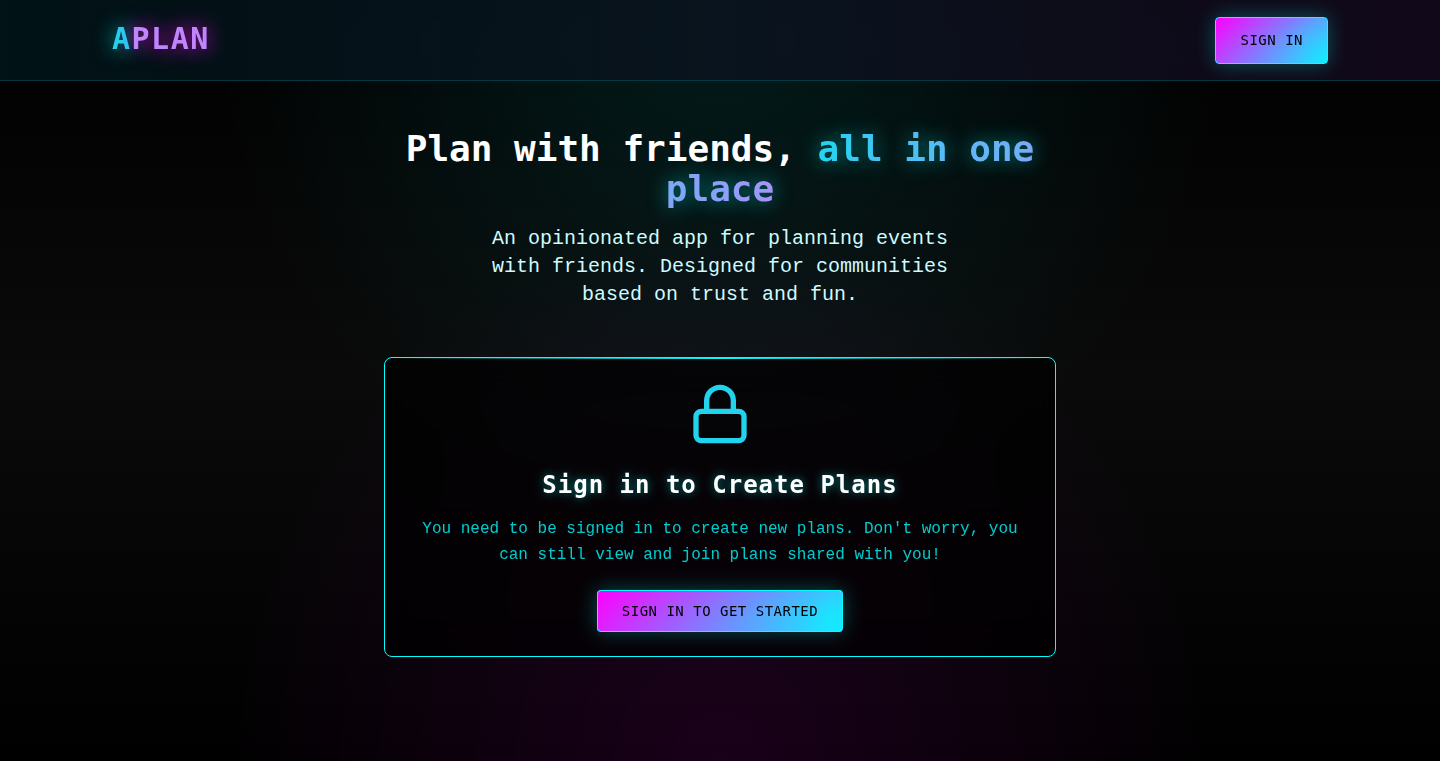
Author
nullpacket
Description
Planly is a straightforward tool designed to help friends collaboratively organize plans. Its technical innovation lies in its simplicity and opinionated approach. Instead of complex features, it focuses on the core needs of planning, leveraging a minimal set of features. It tackles the problem of fragmented communication by centralizing plan details and discussions in one place, making coordination much easier.
Popularity
Points 2
Comments 1
What is this product?
Planly is a web application built to simplify the process of making plans with friends. It uses a very clean interface, allowing users to create plans, add details like dates, times, and locations, and invite others to participate. The core innovation is its minimalism; it doesn't overload users with features they don't need, focusing solely on the essential task of planning. It's like a digital notepad specifically designed for group activities. So what does this mean? It's easy to use, even for those who aren't tech-savvy, and ensures everyone stays on the same page.
How to use it?
Developers can use Planly by integrating it into their social platforms or creating a dedicated planning section within their app. They can provide their users with a quick and intuitive way to arrange meetups, events, and gatherings. This can be done through API integration or by embedding Planly as an iFrame. For example, a developer could add Planly to a messaging app, allowing users to create and coordinate plans directly within their conversations. This is useful if you want to improve user engagement within your app or website by adding easy planning features. So what does this mean? It offers a quick and easy feature to add to your own platforms, making planning simple.
Product Core Function
· Plan Creation and Management: This is where users can create and manage the core details of a plan: date, time, location, and description. It keeps everything in one place, so everyone is on the same page. So what does this mean? No more endless back-and-forth messages or scattered information.
· Invitation and Collaboration: The tool allows users to invite friends and provides a space for participants to collaborate and discuss the plan. This makes it easy for everyone to be involved and informed, reducing the chances of misunderstandings. So what does this mean? Enhanced team work!
· Minimalist Interface and Ease of Use: The design prioritizes simplicity, which makes the tool accessible to everyone, regardless of their technical skill. So what does this mean? No frustrating user interfaces and an easy way to get things done.
Product Usage Case
· Integrating Planly into a chat application: A developer could integrate Planly's functionalities directly within a chat application, enabling users to create plans and share them with friends without switching between different apps. This improves user experience. So what does this mean? Streamlines the user experience.
· Using Planly for event organization: event organizers can use Planly to plan everything from small gatherings to larger events, ensuring that everyone stays informed about schedules, locations, and changes. So what does this mean? Simple event organization and keeping everyone informed.
· Incorporating Planly into social networking platform: A social networking platform could use Planly to add a 'Plan with Friends' feature, making it easier for users to coordinate activities and events directly on their platform. So what does this mean? Enhances the value of your own platform for users.
30
StripeFundRecovery: A Chronicle of Financial Stalemate
Author
Solsticebay
Description
This project isn't a technical product, but a raw, unfiltered account of a user's experience with Stripe, detailing the alleged holding of $800k in funds. It highlights the frustration with unresponsive customer support and the lack of resolution despite legal measures. This 'project' serves as a cautionary tale, exposing potential risks within the fintech landscape and the power dynamics between users and large financial institutions. It is a call to action for Stripe to address the issue and for users to be vigilant about the financial risks of using payment processors.
Popularity
Points 3
Comments 0
What is this product?
This is a detailed complaint and documentation of a user's experience with Stripe. It describes a situation where the user's funds, totaling $800,000, have been held by Stripe for over eight months without any apparent reason or resolution. The user recounts multiple attempts to contact Stripe through various channels, including legal letters, without receiving a satisfactory response. The 'project' itself is the sharing of this frustrating experience, a digital record of the alleged financial hold. Its value lies in exposing potential risks associated with payment processing platforms. It serves as a case study for user rights in the digital financial age.
How to use it?
This 'project' doesn't have a traditional technical usage. Instead, it serves as a resource for those who are considering using Stripe, or those already using Stripe, and have experienced similar issues. The primary 'use' is to learn from the user's experience, allowing others to assess the risks associated with using payment platforms and providing insight on legal actions. It also opens a discussion about the responsibilities of such platforms and the measures available to protect users. The content can be used as a source of information for similar legal processes, for example, the user's experience can highlight common pitfalls when dealing with Stripe.
Product Core Function
· Documentation of the alleged fund hold by Stripe: Details the amount of money held, and the timeframe of the issue, providing crucial details. This information provides concrete proof of the issues faced.
· Account of communication attempts: The user's description of their outreach to Stripe showcases the lack of response, highlighting their frustration. This helps to identify potential communication breakdown scenarios.
· Legal letter and email strategies: The user tried legal measures. This highlights the specific steps taken in seeking resolution. Understanding these steps assists in forming a comprehensive approach to the problems faced.
· Critique of Stripe's support: The description of Stripe's support practices. This can offer valuable understanding of user issues.
· User perspective on reputation management: The user questions Stripe's reputation. Providing a perspective of the service provider.
· Risk discussion of using payment processors: This offers a cautionary viewpoint.
· Warning against arbitration: The user's rejection of arbitration can serve as a caution.
Product Usage Case
· User complaints and experience sharing: This shows other users the risks of Stripe. It highlights potential problems.
· Financial dispute resolution documentation: It provides insight into issues that can arise with payment processors.
· Legal action preparations: The user's experience could be used to formulate steps in a situation.
· User rights advocacy: The sharing of the user's experience could aid in user rights advocacy and help the user find help. It is a useful case study.
31
zz.ac DNS: Free Domain Name Resolver

Author
unclet
Description
This project offers free DNS (Domain Name System) domain names ending with "zz.ac." It's essentially a service that allows you to create and manage a custom domain name, even without paying for one. The innovation lies in providing this resource for free, opening up possibilities for developers and enthusiasts to experiment with web projects, test applications, or create personal websites without the financial barrier of traditional domain registration. It tackles the problem of accessibility, allowing anyone with an idea to easily get online.
Popularity
Points 2
Comments 1
What is this product?
This project offers a free DNS service, specifically offering domain names under the 'zz.ac' zone. A DNS server is like a phonebook for the internet, translating human-readable domain names (like example.com) into IP addresses (like 192.0.2.1) that computers use to communicate. The innovation is providing this service free of charge, normally, you would need to pay to register and maintain a domain name. So, it removes the financial obstacle for starting a website or project.
How to use it?
Developers can use this by registering a subdomain under the 'zz.ac' domain. This would likely involve visiting a website or following instructions on a command line, and configuring the DNS records (like A records, CNAME records, etc.) for their subdomain. This would then allow them to point their subdomain to their web server or service. You could integrate this by changing the DNS settings of your existing website if you want to use it to test your web application or start a simple website. So, you can get a domain name up and running quickly and without cost.
Product Core Function
· Free Domain Name Resolution: The core function is resolving a custom domain name (e.g., yourproject.zz.ac) to the correct IP address of your server. This means people can type your domain name in their browser and reach your website. This enables anyone with an idea to quickly launch a web presence, which solves the financial barriers for getting started.
· DNS Record Management: Allowing users to configure DNS records, such as A records (mapping domain to IP address), CNAME records (creating aliases), and potentially others (like MX records for email). This gives users control over how their domain name is used. So you can customize your website to fit the needs of your project.
· Accessibility: Providing access to those who want to host a website or online project but don't have the funds to purchase a domain name. This opens up new avenues for experimentation and learning in web development. You can build and deploy your website without spending a dime on domain registration.
Product Usage Case
· Personal Blog: A developer creates a personal blog using a free domain, allowing them to share their thoughts and projects without the cost of domain registration. This provides a platform to easily showcase personal projects and share thoughts.
· Testing Environment: A developer creates a staging website for testing a web application before it goes live. Using the free domain name allows for a convenient place to test applications without costs. So, you can test your web application easily with no fees.
· Educational Projects: Students use the service to create websites for class projects or online portfolios, fostering an environment to learn web development and practice their skills. This enables students and learners to practice their web development skills without the costs of traditional domain registrations.
32
Pg-When: Natural Language Time for PostgreSQL

Author
jossephus01
Description
Pg-When is a PostgreSQL extension that allows you to create time values using natural language. Instead of struggling with complex date and time functions in SQL, you can simply write phrases like 'tomorrow at noon' or 'last Friday' and get the corresponding timestamp. This project solves the problem of cumbersome date/time manipulation in SQL, making it more intuitive and less error-prone. The core innovation lies in its natural language parsing capabilities, translating human-readable phrases into precise database-understandable time values. So, this makes working with time much easier and faster.
Popularity
Points 3
Comments 0
What is this product?
Pg-When is a PostgreSQL extension. It utilizes a natural language parser to interpret human-readable time expressions and converts them into PostgreSQL timestamp values. It's built on top of the PostgreSQL extension infrastructure, meaning it integrates directly into your database. This allows developers to use familiar language for time calculations, eliminating the need for complex SQL functions. The innovation lies in the intelligent interpretation of everyday language related to time. So, this means you don't need to learn complicated date math anymore.
How to use it?
Developers can install the extension in their PostgreSQL database and then use functions like `when()` directly within their SQL queries. For example, instead of `SELECT * FROM events WHERE event_time > now() + interval '1 day'`, you could use `SELECT * FROM events WHERE event_time > when('tomorrow')`. It’s integrated as a function within your SQL queries. So, this means you can query data using normal language.
Product Core Function
· Natural Language Parsing: This is the core functionality. It translates expressions like 'next week', '2 days ago', 'in 5 minutes' into precise timestamp values. This removes the need to remember complex SQL date functions, making queries more readable and less prone to errors. Application: Any time-based analysis in a database.
· Time Zone Handling: The extension likely handles time zone conversions. Application: Helps ensure accurate timestamp interpretation across different regions, vital for global applications.
· Contextual Understanding: It probably takes context into account (like the current date and time) when interpreting time expressions. Application: Ensures relative time expressions are correctly resolved in relation to the present time.
· Integration with PostgreSQL: Since it's a PostgreSQL extension, it integrates seamlessly with existing PostgreSQL databases, making it easy to deploy and use. Application: Easier to implement and use than external libraries for time manipulation.
Product Usage Case
· Reporting and Analytics: Imagine a business intelligence application where you want to analyze sales data for 'last month'. Instead of struggling with SQL date functions, you can just use `when('last month')` in your query. This simplifies the query and makes it more maintainable. So, this means less time spent writing complex SQL queries and more time focused on the actual analysis.
· Event Scheduling: A web application that allows users to schedule events. Users can specify 'next Tuesday at 3 pm'. Pg-When translates this input into a timestamp for the database, making the backend simpler. So, this means providing an easy and intuitive user experience for time-based scheduling.
· Monitoring and Alerting: A system that monitors application performance and alerts on specific time-based conditions ('if CPU usage exceeds 80% at midnight'). Pg-When facilitates expressing these time-based conditions in a clean and readable way. So, this helps simplify the rule definition in monitoring systems.
33
Arxiv Explained: AI Research Demystified
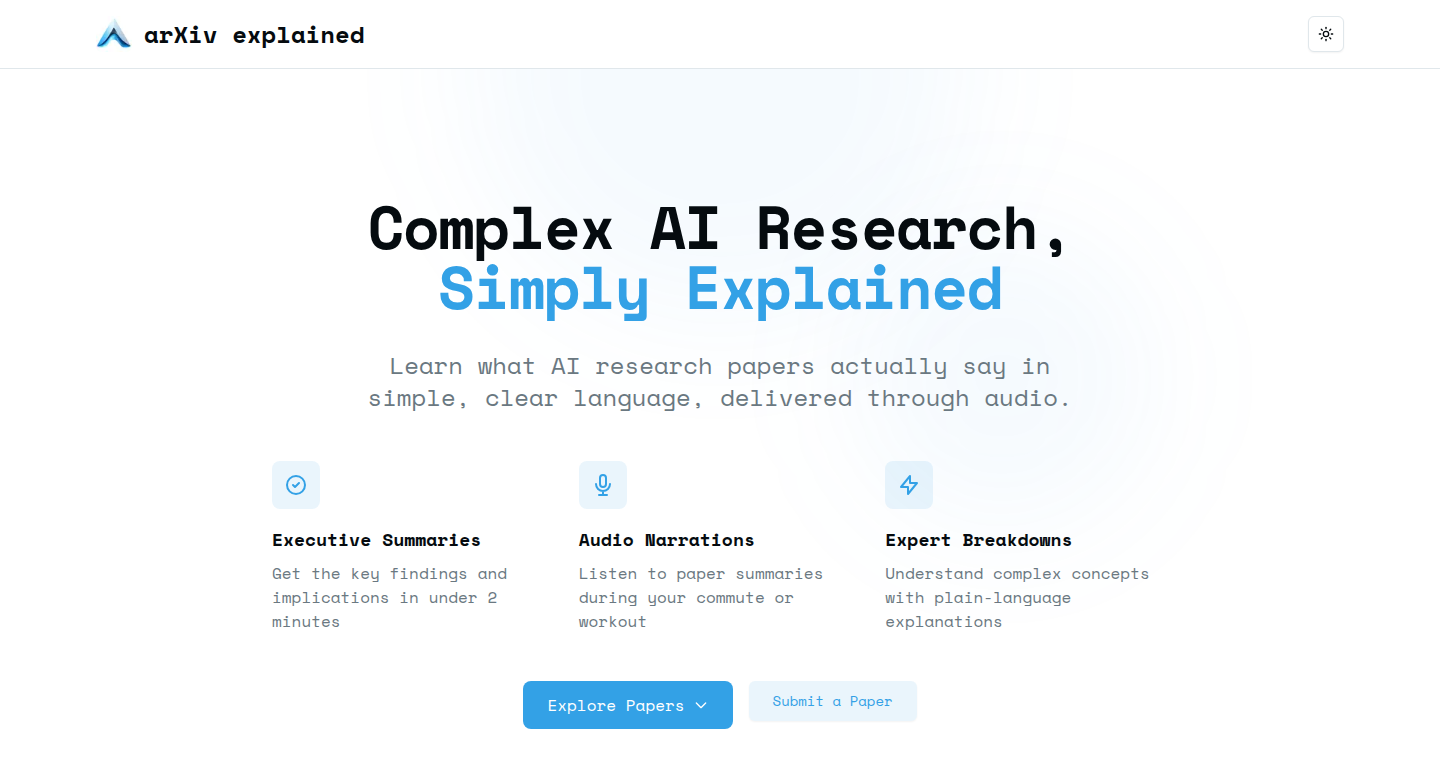
Author
grantsingleton
Description
Arxiv Explained is a free app that translates complex AI research papers from Arxiv.org into easily understandable audio explanations. It uses AI to analyze the papers and generate concise, jargon-free summaries. The core innovation lies in making cutting-edge AI research accessible to a broader audience by removing the technical barrier of dense academic writing. So, it's like having a personal AI research translator.
Popularity
Points 2
Comments 1
What is this product?
This project uses AI to digest and summarize complicated AI research papers. The core technology involves Natural Language Processing (NLP). It reads the paper, extracts key information, and uses text-to-speech to generate a clear audio explanation, avoiding technical jargon. This allows anyone, regardless of their academic background, to understand the latest AI advancements. So, it's essentially an AI-powered audio summary generator for complex research.
How to use it?
You can either browse the pre-loaded collection of popular and recent AI papers directly within the app, or paste any Arxiv.org link to get a custom explanation. The app is designed for ease of use; just listen to the audio explanations during your commute, while exercising, or during other activities. So, you can learn about AI research passively, anytime, anywhere.
Product Core Function
· Automated Paper Summarization: The system automatically processes AI research papers and extracts the main ideas. This saves users the time and effort of reading and interpreting complex scientific documents. So, it saves you time by giving you the key takeaways.
· Natural Language Audio Explanation: The core of the tool is converting dense research papers into clear audio explanations using text-to-speech technology. This is a crucial function because it makes complex information accessible for different types of learners. So, it helps you understand complicated concepts in an accessible way.
· Curated Paper Library: The app includes a pre-loaded collection of popular and recent AI research papers. Users can easily browse and discover the latest advancements. So, it provides a curated selection of interesting research, saving you from doing extensive searches.
· Custom Paper Input: Users can paste in any Arxiv.org link to get a custom explanation. This allows users to explore any paper of interest. So, it allows you to delve into very specific research areas, based on your interest.
Product Usage Case
· AI Enthusiasts: An AI enthusiast wants to stay updated with the latest AI trends. Instead of spending hours reading technical papers, they can listen to audio explanations on their commute and easily grasp the core ideas. So, it helps the enthusiast to stay informed.
· Students: A student studying AI wants to understand a specific research paper. They can paste the Arxiv link into the app and get a simplified explanation, enhancing their learning. So, it helps the student in understanding the subject quickly.
· Developers: A developer building an AI-powered application needs to understand the underlying research behind a particular algorithm. They can use the app to understand complex AI concepts without having to deeply dive into the original paper. So, it accelerates the developer's learning and development process.
· Researchers: A researcher in a specific AI field wants to quickly familiarize themselves with the latest advancements in related areas. The app provides a fast and efficient way to stay informed and discover new research areas. So, it can help the researchers stay current on their fields.
34
Noggn AI: Personalized Cognitive Content Stream

Author
optimlayer
Description
Noggn AI is a platform that aims to personalize content delivery for your brain, similar to how TikTok delivers short-form videos. It focuses on curating and delivering cognitive content – information, ideas, and learning materials – based on your individual preferences and learning style. The core innovation lies in its adaptive content filtering and recommendation engine, potentially helping users learn and process information more effectively by presenting them with content that best suits their cognitive profile. This tackles the problem of information overload and ineffective learning strategies by tailoring the learning experience.
Popularity
Points 3
Comments 0
What is this product?
Noggn AI is essentially a customized learning platform. It's like having a personal librarian that filters the vast amount of information available on the internet and delivers the most relevant and engaging content directly to you. It uses artificial intelligence to understand your interests, knowledge gaps, and how you learn best. The system then recommends various learning materials, from text and videos to interactive exercises, in a way that is optimized for your cognitive strengths and weaknesses. This innovative approach allows for a more efficient and enjoyable learning experience.
How to use it?
Developers could integrate Noggn AI's API (if available) into their own learning platforms or educational applications. This would allow them to provide users with a personalized learning experience. Imagine an app where users can input their current knowledge and interests, and then Noggn AI provides tailored content. The API could be used to curate blog posts, educational videos, and even create adaptive quizzes based on a user’s performance. The integration would offer a dynamic and adaptable learning environment.
Product Core Function
· Personalized Content Curation: The system analyzes a user's profile to identify their interests, learning style, and knowledge gaps. This is valuable because it helps filter out irrelevant information, saving the user time and improving focus, making learning more efficient and enjoyable.
· Adaptive Learning Path Recommendation: Based on a user's progress and understanding, the system suggests the next most relevant learning materials. This is valuable because it keeps the user engaged and ensures they're constantly challenged and improving, preventing stagnation and keeping them motivated.
· Content Format Optimization: The platform likely adjusts content formats based on individual preferences (e.g., text, video, interactive). This is valuable because it caters to different learning styles, maximizing comprehension and retention by presenting information in the most effective way for each user.
· Progress Tracking and Feedback: The system monitors the user's interaction with the content and provides feedback on their understanding. This is valuable because it allows users to see their progress, identify areas where they need more focus, and adjust their learning strategy accordingly.
Product Usage Case
· Educational App Integration: A developer could integrate Noggn AI into an existing language learning app. The app would use the API to suggest vocabulary exercises, grammar lessons, and listening comprehension activities based on the user's current skill level and learning goals. The user gets a tailored experience that boosts their language learning progress.
· Corporate Training Platform Enhancement: A company could integrate Noggn AI to personalize training modules for its employees. The system would tailor learning paths for different departments, job roles, and skill levels. Employees receive relevant training faster and more effectively, which improves productivity and reduces training costs.
· Personal Knowledge Management System: Users could use a similar system to create a personal dashboard for learning about a subject. If the user is studying astrophysics, for example, Noggn AI would recommend articles, tutorials, and research papers based on their interests within that area. The user gains a personalized learning system that aids focused learning.
35
Gitbasher: Your Git Command Swiss Army Knife
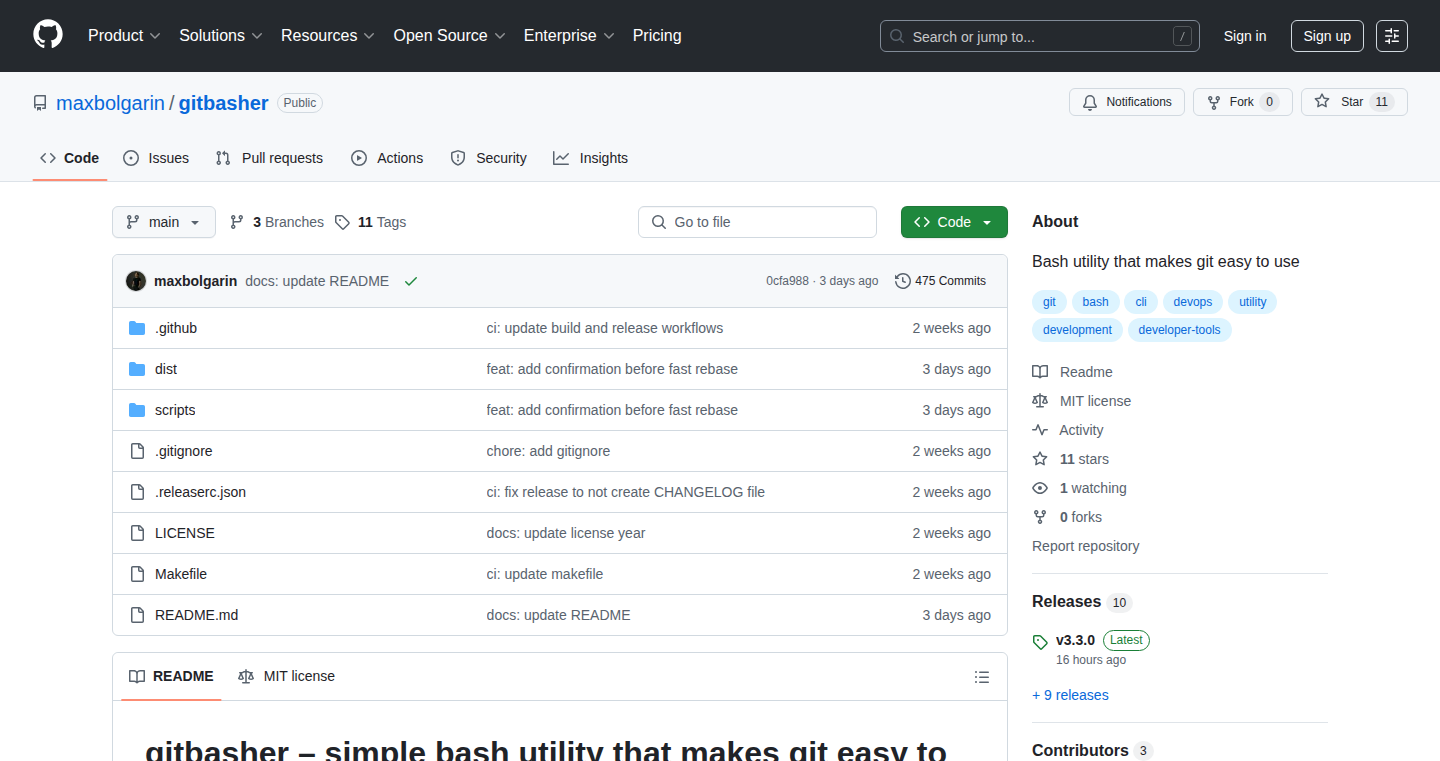
Author
maxbolgarin
Description
Gitbasher is a Bash utility designed to simplify Git usage. It aims to streamline common Git operations through easy-to-remember commands. It tackles the problem of complex Git commands, making version control more accessible and efficient for developers.
Popularity
Points 3
Comments 0
What is this product?
Gitbasher is a set of Bash scripts built on top of Git. It provides a simpler interface for common Git tasks, like committing changes, branching, merging, and pushing code. Instead of typing out long and complicated Git commands, you can use Gitbasher's shorthand commands. So, it makes interacting with Git less intimidating and more productive.
How to use it?
Developers can install Gitbasher and then start using its simplified commands within their Git repositories. For example, instead of typing 'git commit -m "your message"', you might use a simpler command provided by Gitbasher. This tool integrates seamlessly with your existing Git workflow, making it easier to collaborate and manage code. So, it helps you save time and reduces the chance of making errors with complex commands.
Product Core Function
· Simplified Commit: Provides a shorter command to commit your code changes, reducing the need to remember the full Git command and making the process faster. So, it simplifies the commit process.
· Branch Management: Offers easy-to-use commands for creating, switching, and deleting branches. This simplifies the branching workflow, allowing developers to manage features and experimental code more efficiently. So, it helps in smoother code branching and merging.
· Remote Operations: Streamlines commands for pushing and pulling changes from remote repositories, making collaboration easier. This is especially helpful when working in teams or contributing to open-source projects. So, it makes collaborating with other developers easier.
· Stashing: Includes simplified commands for stashing and unstashing changes, allowing you to temporarily save your work and switch contexts without losing progress. So, it lets you save and manage your work more easily.
Product Usage Case
· Beginner-Friendly Git: Developers new to Git can use Gitbasher to learn the basics without getting overwhelmed by complex command syntax. They can learn version control more easily. So, it makes Git accessible to beginners.
· Faster Daily Workflow: Experienced developers can use Gitbasher to speed up their daily Git operations, allowing them to focus more on coding and less on remembering commands. So, it accelerates daily coding tasks.
· Quick Collaboration: Teams can adopt Gitbasher to standardize Git usage, reducing confusion and making collaboration on projects more efficient. So, it simplifies team collaboration on code projects.
36
Sand Blast: A Physics-Based Puzzle Game
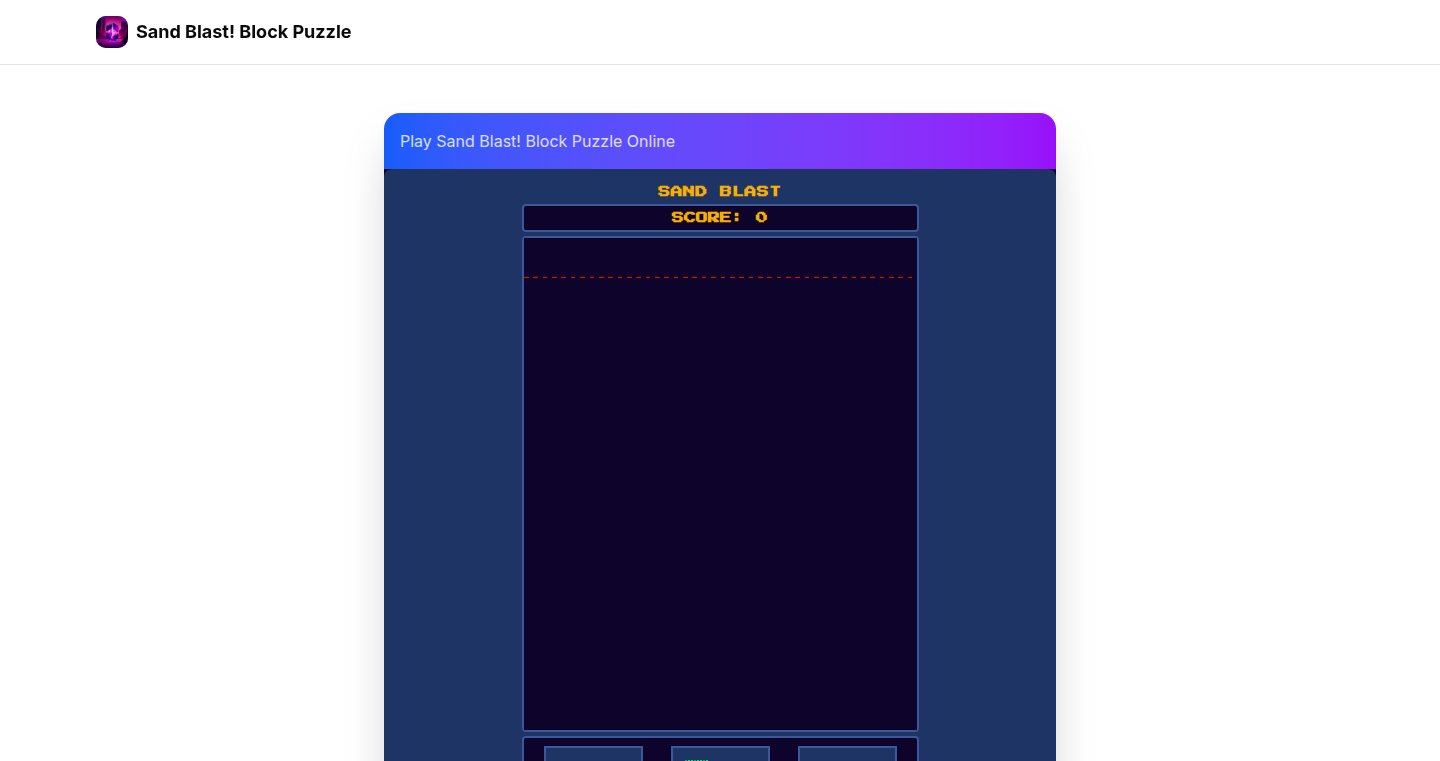
Author
loocao
Description
Sand Blast is a unique puzzle game that uses realistic sand physics to make the gameplay interesting. Instead of just moving blocks, players interact with virtual sand, creating a dynamic and visually appealing experience. The core innovation lies in the engine that simulates how sand behaves - how it flows, interacts with blocks, and responds to gravity. This presents a fresh take on the puzzle genre, requiring players to think strategically about how the sand will react to their actions, making the game both challenging and satisfying.
Popularity
Points 1
Comments 2
What is this product?
Sand Blast is a puzzle game built around physics, specifically the simulation of sand. The game uses a custom-built or open-source physics engine to accurately model how sand behaves. When you manipulate the blocks, the sand flows and settles realistically. The innovation lies in this sand physics simulation. The game provides a refreshing puzzle mechanic because it forces players to consider the laws of physics with every move. So this game is not just about matching colors or moving blocks, it is also about understanding physics, what if you want to learn how things would react in the real world with a safe environment? This is the best answer.
How to use it?
As a player, you simply go to the website and start playing. As a developer, you could study the source code (if available) to learn about implementing realistic physics. The game is a great example of using physics in a fun and accessible way. You can see how the creator deals with a variety of technical challenges, such as simulating granular materials. Developers might use this as a blueprint for their own games, creating realistic effects. So this game is like a ready-made tutorial for creative developers!
Product Core Function
· Sand Physics Simulation: The core of the game is the accurate simulation of sand behavior. This means the sand flows and interacts with the blocks, providing a visually dynamic and engaging experience. Application: Creating realistic physics effects in games or simulations; it teaches you how to create your own physics engine with the sand's behavior.
· Block Manipulation: Players can place and move blocks within the game environment. These blocks then interact with the sand. Application: This core mechanic makes the game's puzzle element. Players have to think strategically to clear levels.
· Level Design: The game will include various levels that have different challenges. Application: Understanding level design is important for puzzle games, it shows how to make more challenging levels.
Product Usage Case
· Game Development: Developers can use the sand physics engine and block manipulation mechanics as inspiration for building their own games, especially those focused on physics-based puzzles. It can be integrated with other frameworks, or used as a starting point to build your own physics playground. For example, you can design a virtual world where you can interact with objects or materials in a realistic way.
· Educational Tool: The game can be used as an educational tool to demonstrate the principles of physics, particularly granular materials. The game can also encourage students to learn game development or even physics. This interactive method would make learning much easier.
· Prototyping and Experimentation: Game developers and designers can use Sand Blast to experiment with different physics interactions and user interface designs. This allows for rapid prototyping to find a creative solution.
37
LlamaFarm: One-Click AI Deployment
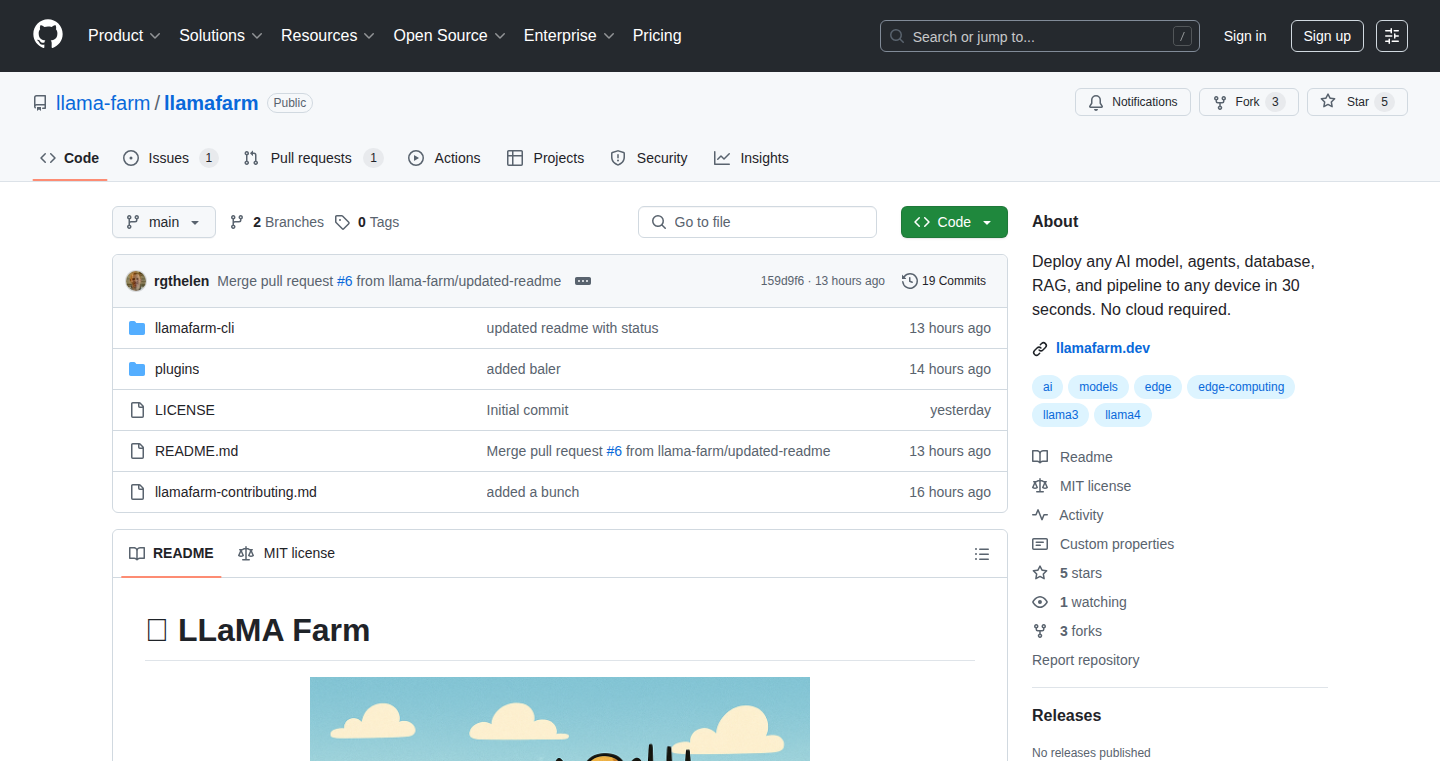
Author
rgthelen
Description
LlamaFarm is a tool designed to simplify the deployment of AI projects by packaging everything – models, databases, runtime environments, and a web UI – into a single, executable file. This solves the complex problem of setting up local AI environments, which often involves managing Python environments, installing drivers, and downloading models. This project embraces the idea of "owning" your AI tools and data, enabling deployment on edge devices, air-gapped systems, and for non-technical users without relying on cloud dependencies.
Popularity
Points 2
Comments 1
What is this product?
LlamaFarm is like Docker for AI projects. It takes all the necessary components for an AI application – like a language model, a vector database (used for storing and searching AI knowledge), the code that runs everything (the agent runtime), and a user interface – and puts them all into one easy-to-use file. This eliminates the hassle of setting up individual pieces and makes it simple to run AI models locally, even on devices like Raspberry Pis or in environments without internet access. The technical innovation lies in the use of platform-specific compilation for optimized performance, and a plugin architecture for extensibility. So, it basically gives you your own personal AI farm that you can plant, harvest, and manage.
How to use it?
Developers would use LlamaFarm by first defining their AI project's components and configurations. Then, LlamaFarm compiles everything into a single executable. This executable can then be easily run on various platforms without additional setup. Think of it like shipping a ready-to-use app. For example, if you're a developer working with AI models, you can use LlamaFarm to package your model, along with its necessary dependencies, into a single file. You can then share this file with someone who doesn't have a technical background, and they can run the AI application immediately. It supports deployment on edge devices and air-gapped systems as well. So, it is a convenient way for developers to distribute their AI applications, ensuring they run consistently across different environments.
Product Core Function
· Single Executable Deployment: This packages all AI project components into a single binary file. This simplifies distribution and execution by removing the need for complex setup and dependencies, streamlining the entire process from development to deployment.
· Platform-Specific Optimization: LlamaFarm uses platform-specific compilation, such as Metal support on Macs and CUDA on Linux. This ensures that the AI models run efficiently, leveraging the hardware capabilities of the target device and enhancing performance.
· Plugin Architecture: It provides a plugin system to support various platforms, databases, and communication methods. This extensibility allows developers to add new features or support for different hardware and software environments, making the tool highly adaptable to different AI projects.
· Web UI: Includes a web UI to allow easy interaction with the AI model, making it user-friendly, especially for non-technical users. This allows you to interact with the AI model through a web browser, making it simple to test and demonstrate the model's capabilities.
· Embedded Vector Database: Integrates an embedded ChromaDB for storing and searching AI knowledge. This ensures the AI model can access the necessary data for its operations, making the tool self-contained and usable in environments without network access.
Product Usage Case
· Edge Device Deployment: Imagine you're building an AI-powered surveillance system for a remote location, like a farm or research station. LlamaFarm packages the necessary AI models and dependencies into a single file, which can then be easily deployed on a Raspberry Pi or similar edge device. The system can operate independently, even without an internet connection, analyzing camera feeds and sending alerts.
· Air-Gapped System Deployment: A company wants to use an AI model for data analysis in a highly secure environment, isolated from the internet. Using LlamaFarm, the AI model, along with its database and runtime, is packaged into a single executable. This file is then copied onto the secure system, allowing the AI model to run without ever connecting to the internet, ensuring data security.
· Non-Technical User Application: A researcher develops an AI model to analyze medical images. Using LlamaFarm, they package the model and a user-friendly interface into a single file. They can then share this file with doctors who don't have technical skills. The doctors can directly run the AI application on their computers, allowing them to benefit from the research without needing to manage complex technical installations.
38
Toolbox: Client-Side Command-Line Toolkit for WebAssembly
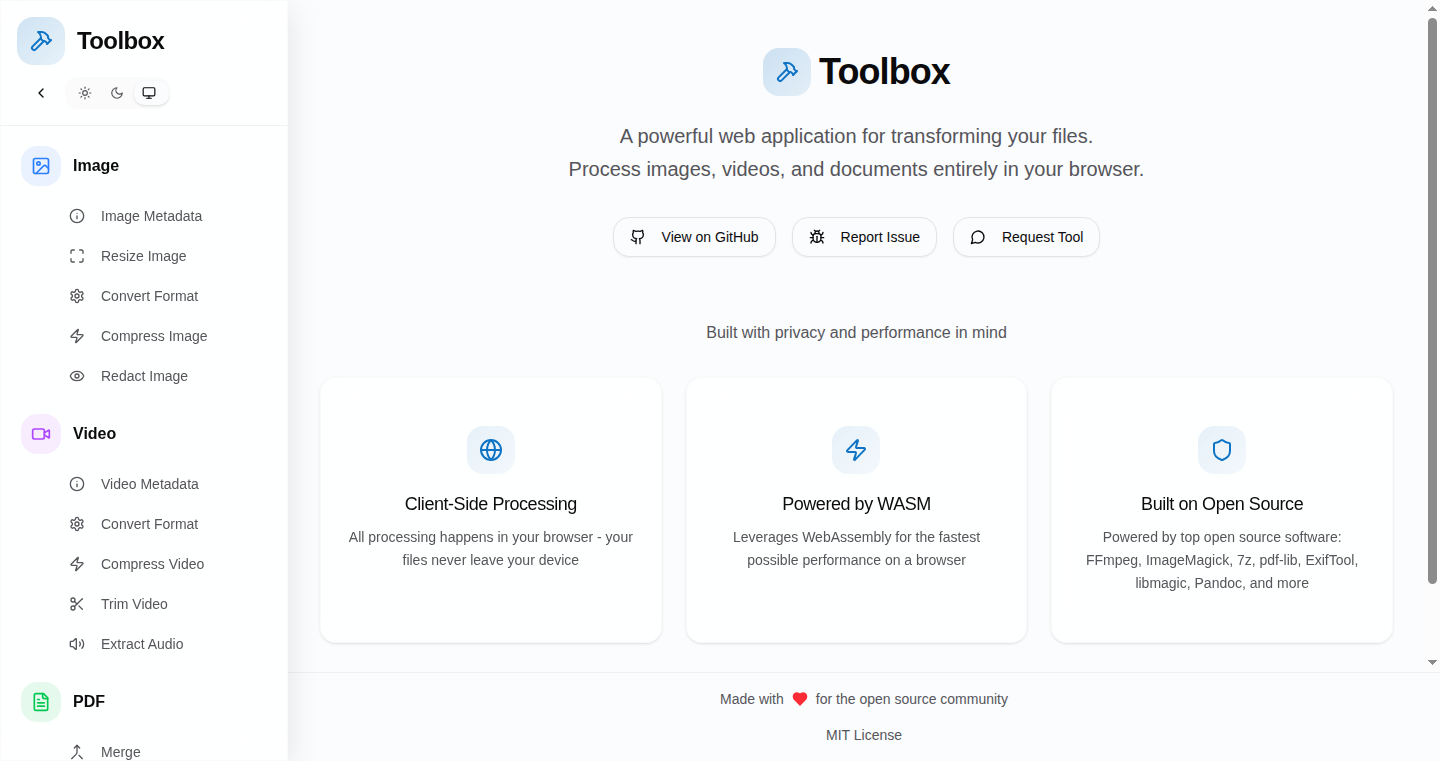
Author
Pharaoh2
Description
Toolbox is a web application that brings popular command-line tools like FFmpeg, ImageMagick, 7-Zip, and others directly into your web browser, leveraging the power of WebAssembly. This means you can perform complex media conversions, image manipulations, and archive operations entirely within your browser, without sending your data to external servers. This innovative approach addresses the security and privacy concerns of using online converters and simplifies the process of installing and running these tools, especially for non-technical users. So it offers a secure, convenient, and user-friendly way to handle various file-related tasks.
Popularity
Points 2
Comments 0
What is this product?
Toolbox works by compiling command-line tools (like FFmpeg for video processing, ImageMagick for image editing, etc.) into WebAssembly (Wasm) modules. Wasm is a low-level bytecode format that runs in web browsers with near-native performance. This allows the website to execute these tools directly in your browser. This eliminates the need for server-side processing and data transfer, ensuring your files stay private and secure. The project's innovation lies in its client-side execution model and its ability to provide a web-based interface for powerful command-line utilities. So it's like having those powerful tools at your fingertips, without needing to install them or worry about your data.
How to use it?
Developers can use Toolbox by simply visiting the website. They can upload their files, select the desired operation (e.g., converting a video using FFmpeg), configure the settings, and then run the command. The output file will be generated within the browser and can be downloaded. This approach is especially useful for developers who need to perform these tasks occasionally or who want to provide similar functionalities in their own web applications. You could create a simple front-end that calls these Wasm-compiled tools, or use Toolbox as a direct alternative to your desktop applications. So you can get powerful tools integrated directly into your workflow without having to install anything.
Product Core Function
· FFmpeg integration: Allows users to perform video and audio conversions, editing, and manipulation directly in the browser. This is useful for quickly transcoding videos for different platforms or optimizing video files. So you can convert and manipulate your video files without installing any extra software.
· ImageMagick integration: Enables image editing, resizing, format conversion, and other image-related tasks. This simplifies tasks like creating thumbnails, optimizing images for web use, and applying effects. So you can easily edit and manage your images in the browser.
· 7-Zip integration: Provides the ability to archive and extract files in various formats (ZIP, RAR, 7z, etc.). This functionality is essential for managing compressed files without needing to install a separate archiving tool. So you can handle compressed files directly in your browser.
· ExifTool integration: This allows users to view and modify metadata associated with image and video files, giving control over file information like date, camera settings, and copyright. This is useful for organizing files and protecting privacy. So you can manage the hidden data inside your photos and videos.
· Pandoc integration: Provides a way to convert documents between various formats like Markdown, HTML, and PDF. So you can easily convert between different document formats without installing any special software.
Product Usage Case
· A web developer needs to quickly convert a video from .mov to .mp4 format for a website, so they can use Toolbox's FFmpeg integration, eliminating the need to install the software locally or upload the video to a third-party service. So you can quickly and easily prepare videos for your website.
· A content creator needs to resize and optimize images for a blog post, they can use Toolbox's ImageMagick integration to achieve this efficiently, keeping the images' file sizes small without losing quality. So you can easily optimize your images for web use.
· A user wants to extract files from a .rar archive but doesn’t have the software installed, using Toolbox's 7-Zip integration, they can extract the files directly in the browser without any local installation. So you can easily manage compressed files, no matter what OS you use.
· A user wants to remove location data from a photo before sharing it online, they can use Toolbox's ExifTool to edit the metadata and remove sensitive information. So you can easily protect your privacy by removing metadata before sharing your photos.
· A user wants to convert a Markdown file into a PDF document, so they can use Toolbox's Pandoc integration, eliminating the need to install any local software. So you can easily convert between different document formats without installing any special software.
39
AI Card Genius: AI-Powered Flashcard Generation
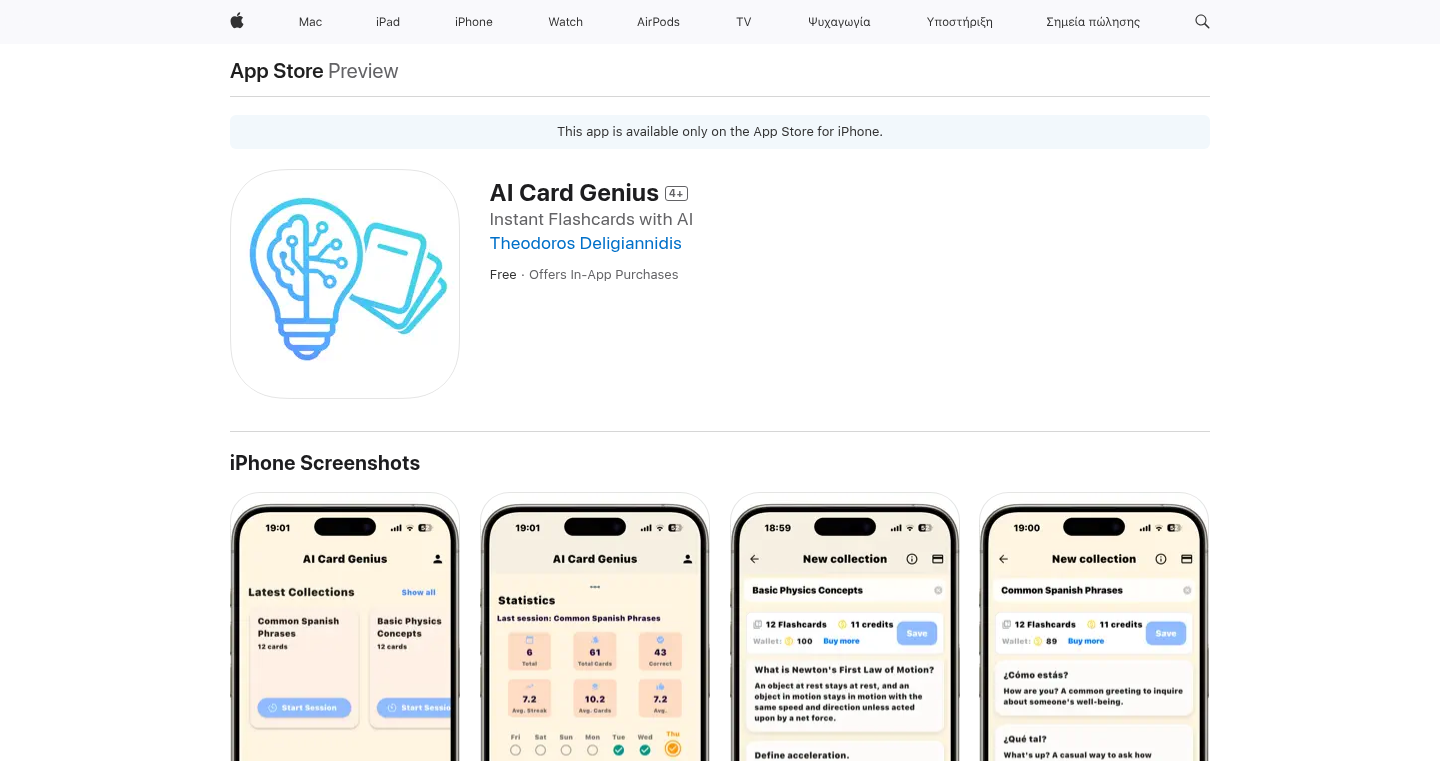
Author
AGINestedCorp
Description
AI Card Genius is a mobile application that leverages Artificial Intelligence to automatically generate flashcards. It aims to simplify the creation process, saving users time and effort compared to manual creation. This project showcases the practical application of AI in education, specifically in content generation, by enabling quick and efficient learning through personalized flashcards. So this is useful because it allows you to create flashcards automatically, saving you time and helping you learn more effectively.
Popularity
Points 2
Comments 0
What is this product?
This project uses AI to analyze text input (likely medical text, given the author's profession) and automatically generate flashcards. The core technology involves Natural Language Processing (NLP), where the AI understands the text, identifies key concepts, and formats them into question-and-answer pairs suitable for flashcards. The innovative aspect lies in automating a traditionally manual process, thereby accelerating the creation of learning materials. So this automates the creation of flashcards by using artificial intelligence, saving time and making learning more efficient.
How to use it?
Users would likely input text, perhaps from medical articles, textbooks, or notes. The app then processes this text with its AI engine and presents the user with generated flashcards. Users can then review, edit, and save these flashcards. Integration is straightforward, requiring the user to provide the source text. The key here is you can create flashcards faster and customize them.
Product Core Function
· Automated Flashcard Generation: The core function is the AI’s ability to analyze text and generate flashcards. The value is time-saving; it eliminates the need to manually write down questions and answers. Application: Ideal for medical students or professionals who need to learn or review large amounts of text quickly.
· Content Summarization: The AI likely identifies the most important information from the input text. Value: Improves learning efficiency by focusing on key concepts. Application: Beneficial for anyone who wants to quickly grasp the essential points of a complex topic, like students.
· Customization Options: The app probably offers features to edit the generated flashcards. Value: Enables users to tailor the content to their specific needs and preferences. Application: Allows learners to personalize their study materials, making them more relevant and easier to remember.
Product Usage Case
· Medical Education: A radiology resident uses the app to create flashcards from medical journals, accelerating their exam preparation and improving knowledge retention. So this helps medical students to generate flashcards from their reading materials.
· Software Developer Learning: A software developer feeds in documentation from a new programming language to quickly create flashcards for syntax and key concepts. So this could help software developers to quickly grasp new languages or frameworks through flashcards.
· Language Learning: A language learner uses the app to generate flashcards from translated articles or textbooks, enhancing vocabulary acquisition and grammar understanding. So language learners can generate flashcards to learn new words and structures more efficiently.
40
Fluent - The AI-Powered Text Transformer for macOS
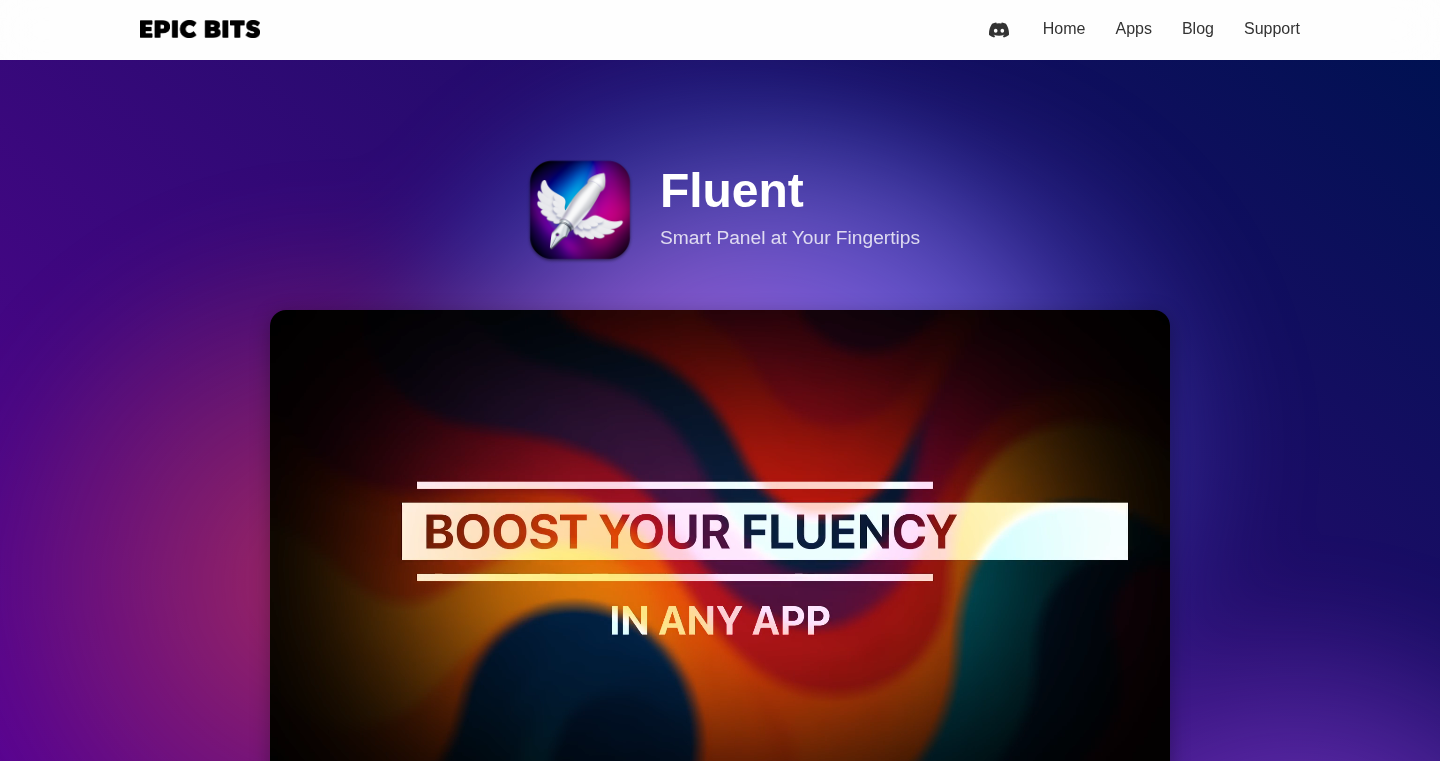
Author
importnil
Description
Fluent is a macOS application designed to enhance your text editing experience across various applications like Chrome, Slack, and Notion. It provides a fast and fluid 'smart panel' that allows users to instantly translate, improve, and replace formatted text using customizable shortcuts. It leverages the power of AI, supporting OpenAI-compatible providers, custom providers, and local models like MLX, Ollama, and LM Studio. The focus is on a seamless user experience with a focus on speed and customizability. So this is useful because it makes text editing faster and smarter, eliminating the need to switch between apps for basic text manipulation.
Popularity
Points 1
Comments 1
What is this product?
Fluent is essentially a text processing tool that integrates directly into your macOS workflow. It works by providing a spotlight-like panel that you can activate with a shortcut. This panel lets you perform actions on selected text such as translation, improvement (e.g., grammar correction, making it more concise), or replacement, all using the power of AI. The innovative part is its tight integration with various applications, enabling users to act on formatted content. It supports different AI providers, meaning you can choose between the most popular AI models, or even use your own local models, keeping your data private. So this means you can fix your writing and translate faster without leaving the app you are in.
How to use it?
Developers can use Fluent by simply selecting text in any supported application (e.g., Chrome, Slack, Notion) and triggering the Fluent panel using a custom shortcut. From there, they can choose an action, and Fluent will process the text according to the chosen AI model and settings. Developers can also integrate Fluent into their development workflows. Imagine writing code comments or documentation, then using Fluent to refine and improve them instantly. You can also define your own custom actions that are relevant to development, making Fluent a customizable and useful tool. This integrates with how you write code, making you more efficient.
Product Core Function
· Instant Text Transformation: Fluent allows users to instantly fix, improve, or replace formatted text within Chrome-based apps using a single shortcut. This provides a fast way to improve writing directly within your workflow, saving time and improving accuracy.
· Customizable Shortcuts: Users can create custom shortcuts to trigger various actions within Fluent. This enables quick access to features such as translation or grammar improvement, making it easier to integrate AI into their daily tasks.
· AI Provider Flexibility: Fluent supports various AI providers including OpenAI-compatible APIs, custom providers, and local models. This lets users select the AI model that best fits their needs. For example, you can use a local model to maintain data privacy.
· Local Model Support: Support for local models like MLX, Ollama, and LM Studio allows users to process text without needing to send their data to external servers. This enhances user privacy and can improve the speed of processing.
· Formatted Content Handling: The tool understands and preserves the formatting of text. So when you ask it to refine a text, the formatting remains.
· User-friendly Interface: Fluent has a spotlight-like, native Swift app, which is fast and fluid. It has an intuitive interface, which makes the tool accessible to both technical and non-technical users.
· BYOK (Bring Your Own Key) Support: Users can Bring Their Own Key, which means no subscriptions or recurring charges. This makes the product cost-effective for long-term use.
Product Usage Case
· Code Documentation Improvement: A developer is writing documentation for a new API and uses Fluent to refine the language and correct any grammatical errors in the documentation directly within their code editor. This leads to clearer and more professional documentation.
· Translation for International Teams: A developer working on a project with an international team uses Fluent to translate Slack messages instantly, enabling better communication across language barriers.
· Refactoring Code Comments: A developer uses Fluent to refine and clarify code comments, making them more understandable for other team members or for their future reference.
· Writing Emails: A developer uses Fluent to improve the tone and clarity of emails by refining the text using the AI. This helps make more persuasive and clear writing.
· Preparing Presentations: A developer quickly uses Fluent to polish and improve the wording of presentation slides, ensuring clear and professional content.
41
RP2350A Pinout Explorer - A Single-Page Datasheet Companion
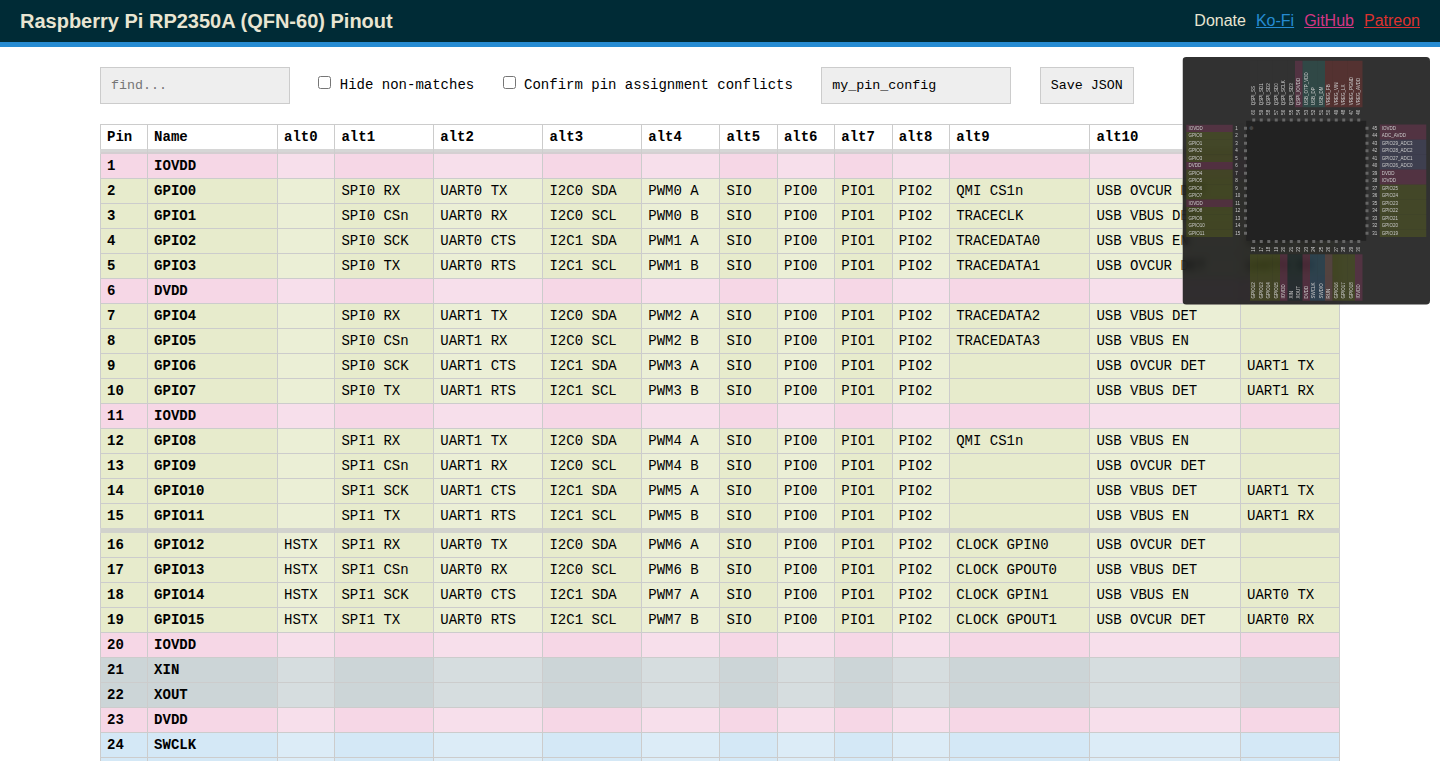
Author
gadgetoid
Description
This project provides an interactive, single-page web interface that simplifies the process of understanding and using the RP2350A microcontroller's pins. It combines pin functions, alternative functions, and notes into a single, searchable table, eliminating the need to constantly flip between multiple pages of the datasheet. The key innovation is the interactive minimap, which allows users to visually track selected pins, making it easier to design, debug, and understand the chip's pin configuration. So what? This saves engineers time and reduces the frustration of working with complex datasheets, enabling faster prototyping and more efficient hardware design.
Popularity
Points 2
Comments 0
What is this product?
It's a web-based tool that displays the pinout information for the RP2350A microcontroller in a user-friendly way. It includes a table showing each pin's function, alternative functions, and any relevant notes. The innovative part is the clickable pin function feature that highlights used pins on a minimap of the chip, which helps engineers visualize the pin layout and streamline their work. So what? This tool makes it much easier to understand how the pins work and where they're located, especially during the design and debugging stages.
How to use it?
Engineers can access the tool through a web browser. They can search for specific pins, view their functions, and click on the pins they are using in their design. The selected pins are then highlighted on the minimap, visually representing the pin configuration. You can integrate it into your design workflow alongside your circuit schematics and PCB layout tools. So what? This tool can be used as an interactive reference while designing and troubleshooting hardware projects using the RP2350A.
Product Core Function
· Interactive Pin Table: Presents all pin information in a single, searchable table. The value? This eliminates the need to jump between different sections of the datasheet, saving time and reducing errors. This is beneficial for quickly finding and understanding pin functions.
· Clickable Pin Highlighting: Allows users to mark pins used in their design. The value? This feature helps users track which pins are being used, which is incredibly useful for hardware design and debugging. This helps in visualizing and organizing pin configurations.
· Minimap Visualization: Displays a visual representation of the chip's pin layout, highlighting the selected pins. The value? This helps engineers understand the physical arrangement of the pins and makes it easier to plan circuit layouts, debug hardware issues, and quickly grasp the overall pin configuration. It facilitates understanding of the chip's physical layout.
· Planned JSON Export: Future functionality to export pin configurations in JSON format. The value? This allows integration with other tools like code generation or symbol generation, allowing for custom workflows and automation in the design process. This empowers engineers to automate tasks and customize their workflow.
Product Usage Case
· PCB Design: During the PCB layout phase, engineers can use the interactive pinout to quickly identify the location of specific pins, making routing easier and more efficient. It visually tracks pin assignments for faster PCB layout.
· Hardware Debugging: When troubleshooting a hardware issue, engineers can use the tool to quickly verify which pins are connected to which components, helping to identify wiring errors. It helps in rapidly diagnosing hardware failures based on pin configurations.
· Hardware Prototyping: When prototyping a new hardware design, engineers can use the tool to easily identify and configure the necessary pins for their project. It helps in setting up initial hardware configuration for faster prototyping.
· Code Generation Integration (future): Using the planned JSON export, engineers can use the pinout data to generate code or symbols automatically, speeding up their design process and reducing manual effort. This streamlines repetitive tasks and reduces the chance of errors.
42
Typegres: TypeScript-ified Postgres
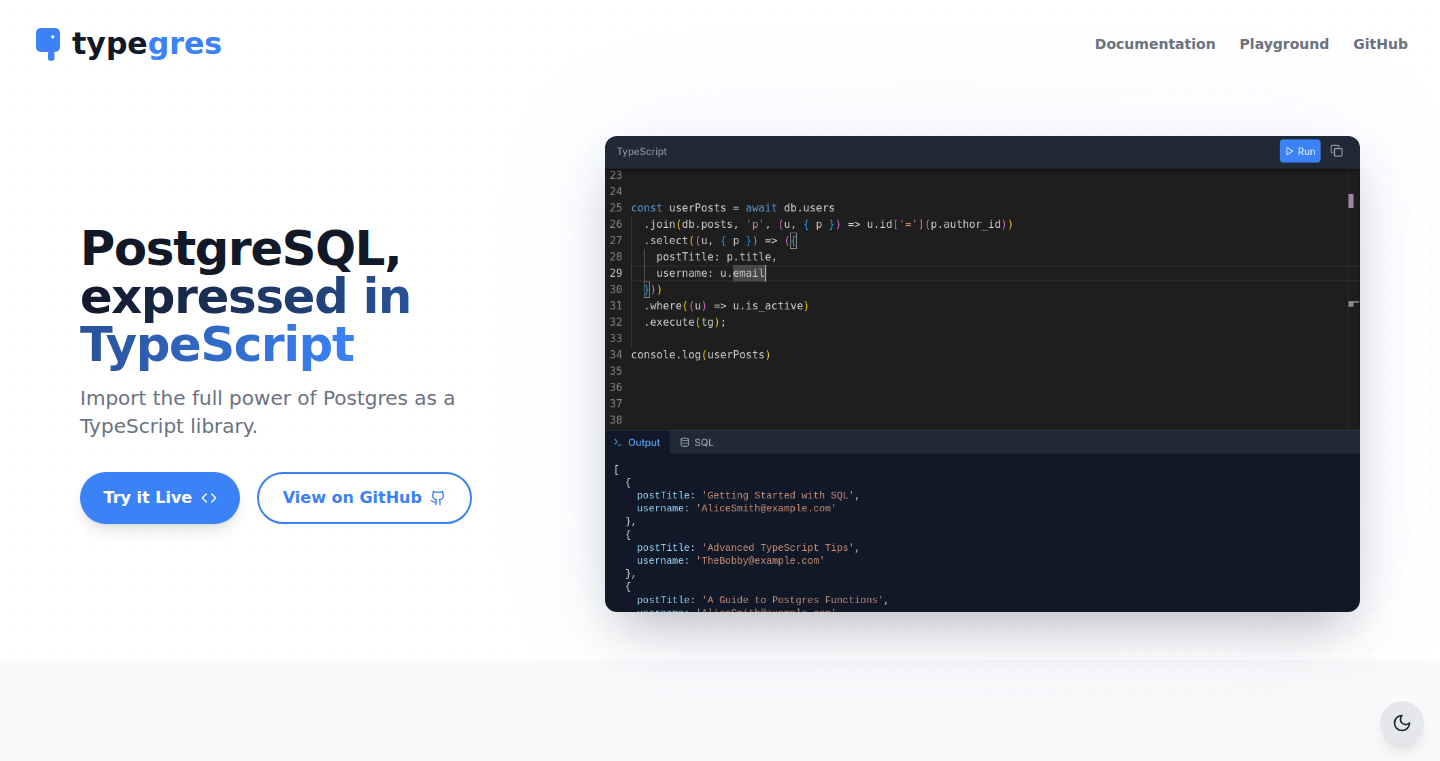
Author
ryanrasti
Description
Typegres takes the guesswork out of using Postgres in your TypeScript projects. It automatically generates type definitions for all your Postgres functions, making it easy to write type-safe queries and avoid common errors. The core innovation lies in its ability to analyze your database schema and translate it into TypeScript types, providing autocompletion and compile-time checks. This solves the problem of developers having to manually define types for database interactions, which is time-consuming and error-prone, while also improving the developer experience.
Popularity
Points 1
Comments 1
What is this product?
Typegres is a tool that turns your Postgres database into a type-safe world within your TypeScript code. It examines your database structure (tables, functions, etc.) and generates corresponding TypeScript types. This means when you write queries against your database, your code editor can provide autocompletion, and the TypeScript compiler can catch potential errors before you even run the code. The main innovation is the automated generation of these types, saving developers from writing them manually and ensuring they stay synchronized with the database schema. So this gives you a way to use your database without any guesswork.
How to use it?
To use Typegres, you'll typically install it in your TypeScript project, configure it to connect to your Postgres database, and then run the type generation process. This might involve running a command-line tool that reads your database schema and creates type definition files (.d.ts) for your project. Afterward, you can import these generated types in your TypeScript code and start writing type-safe queries. For example, if you have a function in your database, Typegres will generate the corresponding TypeScript type for it, enabling you to use it with autocompletion and type checking. So you can now write safe database operations with no configuration.
Product Core Function
· Type Generation: Typegres automatically generates TypeScript type definitions based on your Postgres database schema. This saves developers the tedious work of manually defining types and keeps them synchronized with the database. So this means that your code will always be aware of your database's structure without you writing any code.
· Type Safety: By leveraging the generated types, developers can write type-safe queries and function calls. This means the TypeScript compiler can catch errors related to data types, function signatures, and table structures during development, reducing the chance of runtime errors. So this will save you from those hard to find bugs.
· Autocompletion: With the generated types, your code editor can provide autocompletion suggestions for database interactions, significantly speeding up development and reducing the need to look up database schemas manually. So it allows your code editor to act like an expert on your database.
· Schema Synchronization: Typegres continuously monitors changes in the database schema and automatically updates the generated TypeScript types. This ensures the types always reflect the current database structure, eliminating the risk of out-of-date type definitions. So your type definition will always match with your database.
· Integration with TypeScript Projects: Typegres is designed to integrate seamlessly with existing TypeScript projects, allowing developers to easily incorporate type-safe database interactions into their workflows. So this adds to the existing code base without too much work.
Product Usage Case
· Web Application Development: In a web application that uses Postgres, developers can use Typegres to ensure the data used and returned by the database functions are type-safe. When you refactor your database schema, the type definitions will be updated automatically, reducing the risk of breaking your frontend application. So this allows developers to build web applications with confidence.
· API Development: When building an API that interacts with a Postgres database, Typegres can be used to ensure the types used for API requests and responses align with the database schema. This helps prevent type-related bugs and errors when interacting with the API, by making it easier to track down these errors. So this allows for easier API creation.
· Data Migration: For data migration scripts, Typegres can be used to ensure the data being transferred between tables and databases aligns with the schema. This will also make sure all the columns have the correct data type, helping to prevent migration failures and ensuring data consistency. So you can safely move your data from one place to another.
· Team Development: In team environments, Typegres ensures that everyone on the team is working with the same type definitions, which leads to consistent code and reduces the risk of misunderstandings due to type mismatches. This makes team collaboration much easier by reducing errors.
· Database Refactoring: When you make changes to your database schema (e.g., adding columns, changing data types), Typegres will automatically reflect those changes in your TypeScript types. This reduces the manual effort needed to update type definitions and keeps your code in sync. So you can change your database without worrying about the type definitions.
43
DockerHub Deprecator: Automated Repository Archiving
Author
vipulgupta2048_
Description
This project provides an automated solution for deprecating DockerHub repositories. It uses a Playwright script to interact with the DockerHub interface, allowing users to mass-archive repositories. The core innovation lies in automating a previously manual and cumbersome process, saving significant time and effort for developers managing large numbers of Docker images. This addresses the critical problem of properly communicating the deprecation of container images to users, preventing the use of outdated and potentially vulnerable images.
Popularity
Points 1
Comments 1
What is this product?
This project automates the archiving of DockerHub repositories. It works by using a script that controls a web browser (Playwright) to interact with the DockerHub website. This allows the script to log in, navigate to repositories, and archive them, effectively marking them as deprecated. The innovation is in automating a manual process, making it easy to deprecate multiple repositories at once. So this allows developers to ensure users don't use old, unsupported images.
How to use it?
Developers can use this project by running the Playwright script. They would typically configure the script with their DockerHub credentials and a list of repositories to archive. The script then automates the archiving process, saving the developer from having to manually archive each repository through the DockerHub user interface. You can integrate this with existing CI/CD pipelines to automate deprecation workflows. So you can easily manage the lifecycle of your Docker images.
Product Core Function
· Automated DockerHub UI Interaction: The script uses Playwright to interact with the DockerHub website, simulating user actions such as logging in, navigating to repositories, and archiving them. This provides a way to automatically perform tasks that would otherwise be done manually. So it removes manual steps and saves time.
· Mass Repository Archiving: The script can handle archiving multiple repositories at once. This is especially useful for developers who have many repositories to deprecate, allowing them to do it efficiently. So it's a huge time saver for managing multiple projects.
· Deprecation Communication: By archiving repositories, the project effectively communicates that the images are no longer being maintained, protecting users from using outdated or insecure images. So it significantly improves the security and maintenance of Docker images.
· Playwright-based Automation: The use of Playwright provides a robust and reliable way to automate the DockerHub UI. Playwright is a modern end-to-end testing and automation framework, providing better reliability and maintainability compared to older UI automation methods. So it ensures the automation process is more dependable and less prone to issues.
Product Usage Case
· Deprecating Legacy Projects: A software company uses this script to deprecate old Docker images associated with a legacy project. They can easily archive the old repositories, preventing users from pulling and using outdated images, thus reducing security risks and maintenance overhead.
· Container Image Lifecycle Management: A DevOps team uses the script to manage the lifecycle of their container images. When a new version of a software is released and a previous version becomes deprecated, they can use the script to archive the old image repository, which simplifies the lifecycle management process.
· Large-Scale Infrastructure Updates: A cloud provider uses the script to deprecate Docker images related to older versions of their services as they roll out updates to their infrastructure. The automated archiving process streamlines the transition and informs their users. So it provides a smooth transition during infrastructure upgrades.
44
Hapstack: SaaS Usage Insights Chrome Extension
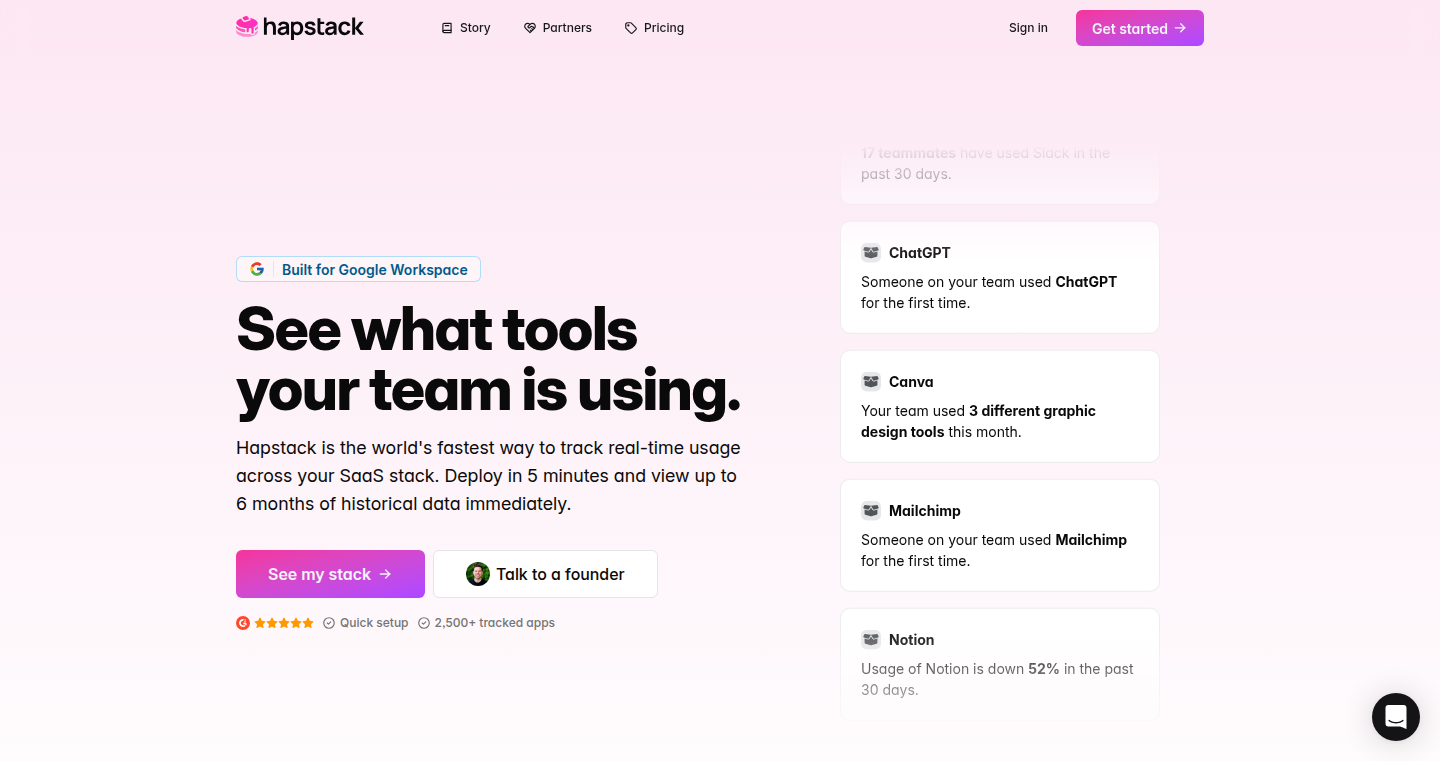
Author
rwgreen
Description
Hapstack is a lightweight Chrome extension that provides instant visibility into your organization's SaaS (Software as a Service) stack. It reveals which tools are being used, by whom, and how frequently, aiming to solve the problem of SaaS sprawl, shadow IT (unsanctioned software), and wasted spending within organizations. The core technical innovation lies in its ability to passively track SaaS usage without requiring intrusive setup or surveys, offering a streamlined and automated approach to gaining insights into software adoption and cost optimization.
Popularity
Points 2
Comments 0
What is this product?
Hapstack is essentially a smart spy for your web browser. It operates as a Chrome extension, silently monitoring your team's usage of various online tools and services (SaaS applications). It doesn't require you to fill out forms or configure complicated settings. Instead, it works in the background, collecting data on which tools are being used, how often, and by whom. This information is then presented in an easy-to-understand format, highlighting underutilized tools, the presence of unsanctioned software, and potential areas for cost savings. The technical innovation is its unobtrusive nature and ease of deployment – providing deep insights without complex setup. So this helps you understand your team's software usage and identify opportunities for cost reduction and improved efficiency.
How to use it?
Developers and IT administrators can easily install Hapstack as a Chrome extension. Once installed, it automatically begins tracking SaaS tool usage within the Google Workspace environment. This data is then accessible through a dashboard, allowing users to view usage patterns, identify underused tools, and uncover potential cost savings or security risks. The integration is seamless, requiring no modification to existing workflows. This means developers can quickly see how their team uses software and manage their software budget better.
Product Core Function
· Automated SaaS Usage Tracking: The extension passively monitors the use of various SaaS applications. This provides a complete and accurate picture of the tools being used within an organization. It's like having a constant, unobtrusive observer of software use. So this gives you a clear view of your organization's software landscape without manual effort.
· Usage Reporting and Analytics: It provides reports and analytics, displaying which applications are being used, by whom, and how often. This data helps in understanding software adoption patterns. So this allows developers to make data-driven decisions about software investments.
· Shadow IT Detection: The extension identifies unauthorized or unsanctioned software usage within the organization. This helps to mitigate security risks and potential compliance issues. So this can help prevent security risks and protect data by identifying rogue applications.
· Cost Optimization: By identifying underused tools and areas of software overlap, Hapstack assists in reducing wasted spend on SaaS subscriptions. This helps in optimizing software costs. So this allows you to identify cost-saving opportunities and reduce wasteful spending.
· Historical Usage Data: Hapstack provides access to historical app usage data, up to six months, enabling long-term trend analysis and decision-making based on usage patterns. So this allows you to analyze trends and make informed decisions based on historical data.
Product Usage Case
· Identifying Underutilized Software: A development team notices they are paying for a project management tool that only a few people are using. By using Hapstack's insights, they can identify the underutilization and consider downgrading the subscription or consolidating to a more widely used tool. So this example shows how to optimize software subscriptions.
· Detecting Unauthorized Software: An IT department uses Hapstack and finds that a significant number of employees are using an unsanctioned file-sharing service. They can then take appropriate action to secure company data. So this illustrates how to maintain data security and compliance.
· Improving Onboarding and Offboarding Processes: When onboarding new team members, a company can use Hapstack to easily understand which software tools they should have access to, matching current team usage. During offboarding, the IT department can use the tool to identify and revoke access to relevant SaaS apps. So this improves team management.
· Reducing Wasted SaaS Spend: A company uses multiple communication tools. Hapstack helps in identifying the least-used tool, thus eliminating subscriptions and saving the company money. So this saves the company money on underutilized subscriptions.
45
RunPy: Instant Python Playground
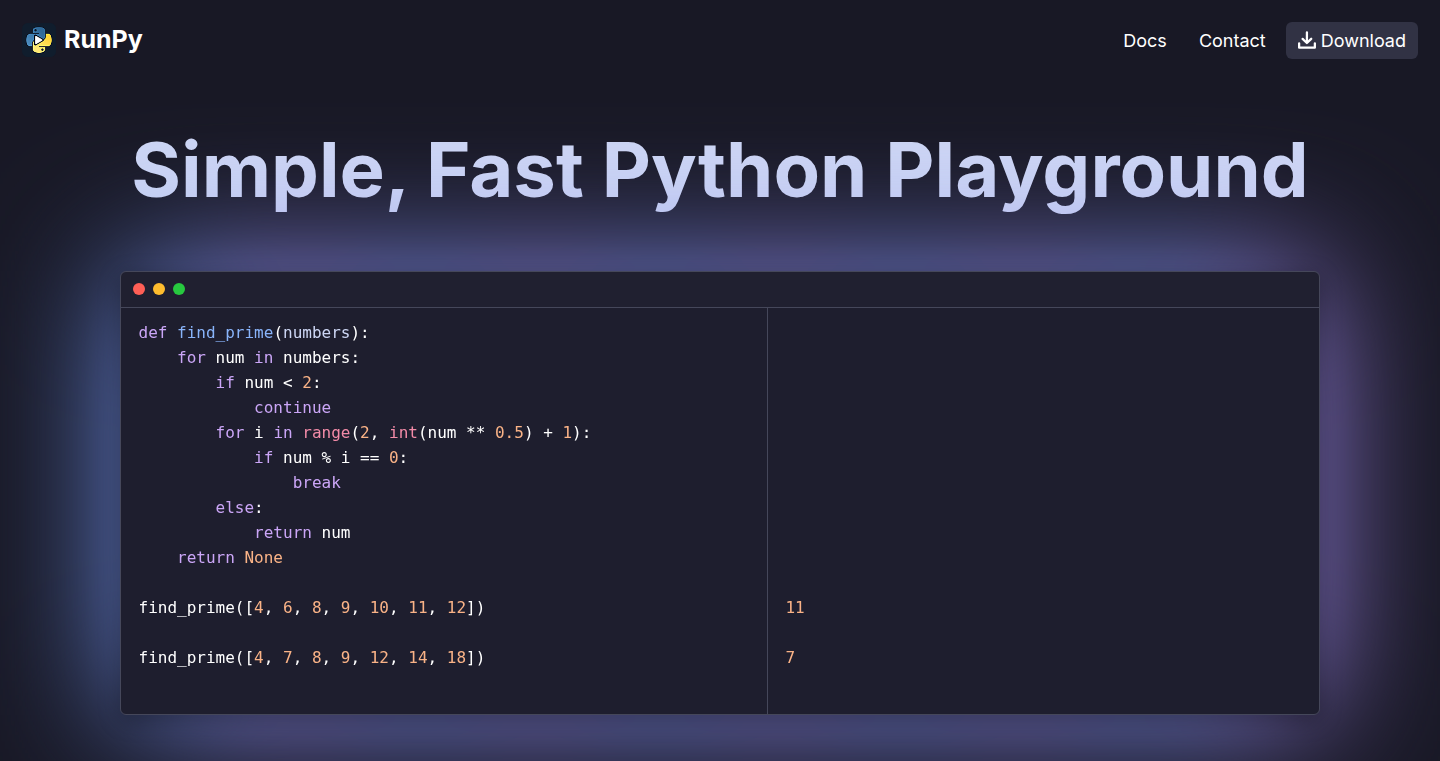
Author
lukehaas
Description
RunPy is a desktop application that lets you execute Python code instantly, without needing to create files or set up a Python environment on your computer. It offers a simplified way to experiment with Python, perfect for learning, teaching, or quick code tests. The core innovation is its ability to abstract away the complexities of setting up and running Python, enabling a more accessible and streamlined coding experience. So, what's in it for me? You get a hassle-free environment to play with Python, saving time and effort on initial setup.
Popularity
Points 2
Comments 0
What is this product?
RunPy is essentially a code editor combined with a Python interpreter, packaged into a user-friendly desktop application. When you type Python code in the editor, RunPy executes it immediately. The key innovation lies in its portability: it bundles everything needed to run Python, so you don't have to install anything on your machine. It's like having a Python playground available at any time. So, what's in it for me? It removes the barriers to entry for Python, letting you focus on writing and understanding code instead of wrestling with setup.
How to use it?
Developers can use RunPy to quickly prototype Python scripts, test out code snippets, or demonstrate Python concepts without requiring a full development environment. Simply open RunPy, write your Python code, and see the results instantly. You can integrate it into your learning process, use it for teaching, or leverage it to quickly test code snippets before incorporating them into a larger project. So, what's in it for me? It's an efficient tool for rapid experimentation and learning, making Python more approachable for everyone.
Product Core Function
· Instant Code Execution: RunPy executes Python code as you type, providing immediate feedback. This allows for faster debugging and experimentation. So, what's in it for me? It drastically speeds up the feedback loop when coding, allowing for quicker iteration.
· No Installation Required: Since RunPy bundles Python, you don't need a Python installation on your system. This simplifies the onboarding process for beginners and avoids potential conflicts with existing Python installations. So, what's in it for me? It simplifies the setup, allowing you to focus on code without environment configuration headaches.
· Cross-Platform Compatibility: RunPy is available for macOS, Windows, and Linux, ensuring accessibility across various operating systems. This makes the tool versatile for any developer. So, what's in it for me? You can use it on whichever computer you have available without any restrictions.
· Simplified Interface: With a clean and intuitive interface, RunPy minimizes distractions and maximizes focus on the code. The goal is to create a comfortable coding experience. So, what's in it for me? It makes coding more accessible and removes some of the intimidation factor.
· Code Snippet Testing: RunPy is great for testing code snippets without having to create separate files, which is very useful for quick tests and experimentation with Python. So, what's in it for me? Faster prototyping makes coding more efficient.
Product Usage Case
· Learning Python: A student can use RunPy to try out code examples from a Python tutorial without setting up a local environment. This reduces friction and allows for immediate hands-on experience. So, what's in it for me? This accelerates the learning process.
· Teaching Python: Educators can use RunPy in the classroom to demonstrate Python concepts and encourage hands-on learning. The immediate feedback enhances engagement. So, what's in it for me? It becomes easier to explain Python concepts through instant visual feedback.
· Quick Script Testing: Developers can quickly test small Python scripts or code snippets before integrating them into larger projects. This accelerates the development cycle by reducing the time spent on environment setup. So, what's in it for me? It lets you test quickly to reduce debugging time.
· Data Analysis Experimentation: Data scientists can experiment with data analysis code snippets by testing different libraries and visualizing the output without configuring a full environment. So, what's in it for me? Rapid data exploration using Python and its libraries.
· Rapid Prototyping: Developers can prototype small applications using RunPy, quickly testing the code before building out a full development environment. So, what's in it for me? Speed up prototyping phase.
46
Verbatimly: AI-Powered Transcription for Interviews and Beyond
Author
ebukao
Description
Verbatimly is a user-friendly AI transcription tool designed to convert audio and video files into clean, readable text. It leverages the power of AI, specifically a model like Whisper, to automatically transcribe spoken words. This project addresses the common pain point of manual transcription, saving users significant time and effort. The innovative aspects lie in its ease of use, features like speaker identification, AI-generated summaries, and compatibility with research tools, making it a valuable resource for students, researchers, and anyone dealing with spoken content. So this is useful because it automates a tedious process, freeing up your time to focus on analysis and insights instead of typing.
Popularity
Points 2
Comments 0
What is this product?
Verbatimly is an AI-driven transcription service. At its core, it uses advanced machine learning algorithms to convert speech from audio or video files into text. It’s built on top of models like Whisper, a popular and powerful speech recognition system. The project offers features such as speaker identification (pinpointing who said what), AI-generated summaries to highlight key points, and custom vocabulary support to improve accuracy. The project emphasizes data privacy, ensuring users' content is not used for training purposes. It's designed with researchers, students, and anyone who needs transcripts in mind. So this helps you by translating spoken words into a usable text format automatically.
How to use it?
Developers and users can use Verbatimly by uploading their audio or video files directly to the platform (www.verbatimly.com). It processes the files, generating accurate transcripts. Users can then review, edit, and organize the transcripts using features like colorful tags for categorization and filtering. It offers integrations for exporting transcripts to formats compatible with research tools like NVivo and RStudio. The easy-to-use interface and various export options allow for simple incorporation into existing workflows. So this lets you easily transform audio/video files into text, allowing you to work with your content more effectively.
Product Core Function
· AI-Powered Transcription: Accurately converts speech to text, saving users hours of manual work. This is useful because it automates the most time-consuming part of transcription.
· Speaker Identification: Identifies and labels different speakers in the audio, making transcripts easier to follow and analyze. This is useful because it helps you understand who said what during the conversation.
· AI Insight and Summary: Automatically generates summaries of the content, highlighting key points for quicker content comprehension. This is useful because it helps to quickly understand the main ideas and overall context of the transcribed content.
· Custom Vocabulary: Allows users to upload custom vocabulary to improve the accuracy of transcriptions. This is useful because it can improve the accuracy of transcriptions.
· Export to Research Tools: Offers export options compatible with various research tools (NVivo, Atlas.ti, etc.), facilitating seamless integration into existing research workflows. This is useful because it ensures easy integration into various research workflows.
· Free Plan: Offers a free plan for users to test the tool and benefit from transcription services, promoting accessibility. This is useful because it allows people to use the platform without any cost.
Product Usage Case
· Academic Research: A researcher is conducting interviews for a study. They upload the audio files to Verbatimly, and the system generates accurate transcripts, saving time and resources. They can then export the transcripts to their preferred research tool, like NVivo, for analysis. This demonstrates how Verbatimly saves researchers time and eases the process of analyzing interview data.
· Student Lectures: A student records lectures and uses Verbatimly to transcribe them, creating searchable notes that can be easily reviewed. This demonstrates the ease of organizing lecture notes.
· Podcast Production: A podcast creator uses Verbatimly to generate transcripts of their episodes. This allows them to create show notes for their audience and also improve their website SEO. This demonstrates how the app helps content creators by making their audio content more accessible and improving SEO.
· Journalist Interviews: A journalist uses Verbatimly to transcribe interviews for articles. The speaker identification helps them keep track of who is talking, and the summaries help them quickly identify the key takeaways. This showcases the application of the project in journalism and news gathering.
47
Brplot: Interactive Data Visualization in Your Terminal
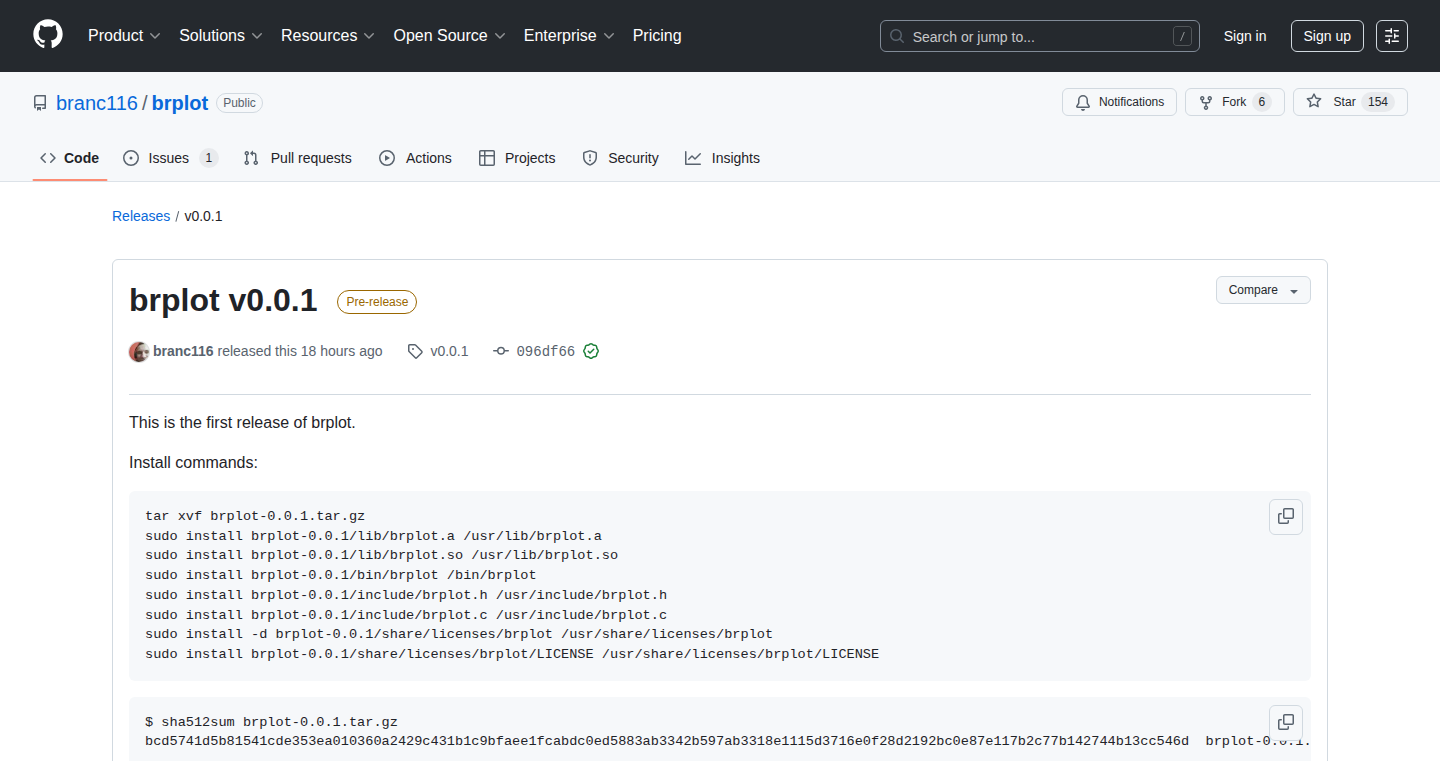
Author
branc116
Description
Brplot is a command-line tool that allows you to visualize data directly within your terminal. It's like having a mini-dashboard for your data, letting you quickly understand patterns and trends without leaving the command line. The core innovation is its ability to render charts using simple ASCII characters, making it incredibly lightweight and compatible with almost any terminal environment. It solves the problem of quickly inspecting and understanding data without needing a GUI or complex plotting libraries.
Popularity
Points 2
Comments 0
What is this product?
Brplot takes your data, like numbers from a log file or a CSV, and turns it into a visual representation, like a bar chart or a line graph, right inside your terminal window. Instead of using complex graphics, it uses basic characters like underscores, pipes, and plus signs to draw the chart. The beauty is in its simplicity: it's easy to install, works on almost every system, and helps you see the data quickly. This is a great example of a developer using their skills to build a very focused, pragmatic tool. So this is for everyone who wants a quick look at their data.
How to use it?
You can pipe data to Brplot directly from other command-line tools. For example, if you have a CSV file, you might use `cat mydata.csv | brplot --type bar --labels 'column1,column2'`. It's also suitable for real-time monitoring of data streams. Developers can easily integrate Brplot into their scripts or build it into their workflows to quickly visualize and debug data, especially on remote servers or in environments with limited graphical capabilities. So this is great if you want to understand your data fast, without extra work.
Product Core Function
· Terminal-Based Charting: Brplot renders charts (like bar charts and line graphs) using ASCII characters within the terminal. This allows users to visualize data without relying on complex graphical dependencies. Application: Quickly visualizing server logs, network traffic, or any data stream directly within the terminal. So this lets you see the data immediately without needing a graphical interface.
· Data Input Flexibility: Brplot accepts data from standard input, making it easy to pipe data from other command-line tools and scripts. Application: Integrating with existing data processing pipelines, scripting data analysis tasks, and real-time monitoring. So this helps you to visualize different types of data from various sources.
· Customizable Chart Types: Brplot supports various chart types (e.g., bar charts, line graphs), allowing users to choose the visualization that best fits their data. Application: Different chart types can highlight different patterns and trends in data. So this lets you focus on the specific data you want to investigate.
· Lightweight and Portable: Brplot is designed to be lightweight, with no dependencies. It's easy to deploy and run on almost any system. Application: Ideal for use on remote servers, embedded systems, and in environments where graphical dependencies are limited. So this helps you analyze data anywhere, even with limited resources.
Product Usage Case
· Monitoring Server Performance: A DevOps engineer could use Brplot to visualize server CPU usage or memory consumption in real-time, piped from `top` or `htop`. So this offers a quick glance at system health.
· Analyzing Log Data: A developer can use Brplot to visualize error rates from application logs, aiding in debugging. So this allows faster identification of patterns or anomalies in the log data.
· Quick Data Exploration: A data scientist can use Brplot to quickly visualize a CSV file's distribution of a particular column's data, helping to get an initial sense of the dataset. So this is an accessible way to get a quick view of your data.
48
Activiews: Personalized Workout Visualizations with Privacy Focus

Author
ahmetomer
Description
Activiews is a fitness app built for Apple users that prioritizes privacy and visual clarity. It focuses on providing a simple, account-free experience by directly reading workout data from Apple Health and Watch. The core innovation lies in its customizable workout maps and data visualization features, offering users a more engaging way to review their exercise data without compromising their personal information or being locked into a social platform. It solves the problem of privacy-invasive and feature-bloated fitness apps.
Popularity
Points 2
Comments 0
What is this product?
Activiews is a fitness app that visualizes your workouts using maps and other data visualizations, such as a calendar heatmap. It works by directly accessing data from your Apple Health and Watch without requiring an account or sending your data to the cloud. The innovative aspect is its focus on privacy and customizable visuals. You get to see your workout data in a way that’s tailored to you, without worrying about your data being shared or sold. The app's architecture, leveraging native Swift and SwiftUI, prioritizes performance and a lightweight experience. The flyover route animations are a cool way to review the workout.
How to use it?
Download Activiews from the App Store. The app automatically accesses your workout data from Apple Health and Watch. You can then explore your workouts using customizable maps, animations, and data visualizations. The app is designed to be straightforward, so you don't need to spend time creating accounts or navigating through unnecessary features. You can customize the map styles, color schemes, and other visual elements to your preferences. So, you can use it anytime you need to check your workout results, it is easy to use.
Product Core Function
· Customizable workout maps and shareable cards: This feature allows users to view their workout routes on maps, and customize the maps and share their workouts in a visually appealing format. This is valuable because it transforms raw workout data into easily digestible and shareable insights. Users can share their progress with friends or use it to keep track of their training. So, it's perfect for those who want to show off their workouts to their friends or for their social media accounts.
· Flyover route animations: This creates an animated 'flyover' of the workout route, which provides a dynamic and engaging way to review the workout. It's more immersive than just looking at a static map. This feature is valuable because it makes workout data more engaging and easier to understand. It is useful for helping users to revisit and visualize their workouts, identifying areas of interest or improvement. So, this is good for anyone that likes to have more fun when they're looking back at a workout.
· Calendar heatmap showing activity over time: This feature visually represents the user's activity over time, which helps them to identify patterns and trends in their workout schedule. This is valuable because it gives users a broader understanding of their workout habits and helps them plan their routines. This enables the user to spot periods of high and low activity, enabling them to adjust their training plans. So, perfect if you are looking for a way to organize your workouts.
· Offline-first, data stays on device, no login/account needed: Activiews stores all workout data on the user's device without requiring any login or account creation. This approach prioritizes user privacy and ensures that the data is never exposed to external servers. This is a significant benefit because it gives users complete control over their data and reduces the risk of data breaches or privacy violations. This makes it especially good for people who value their privacy.
· Dark/light themes, map styles, unit system, and accent color customizations: This allows users to personalize the app's appearance to their liking. Users can switch between light and dark themes, select different map styles, change the unit system (e.g., miles or kilometers), and customize accent colors. This is a great way to improve the user's experience because it tailors the app's user interface to meet the user’s needs and preferences. So, it is useful for anyone that likes to have their own unique and customized fitness experience.
· Reads data directly from Apple Watch: Activiews accesses the workout data directly from the Apple Watch without requiring third-party services or cloud synchronization. This is a huge advantage because it streamlines the data import process and provides a fast, and efficient way to track user's workout data. So, it's a great way to make the app user-friendly.
Product Usage Case
· A runner wants to analyze their marathon route: They can use Activiews to view their route on a detailed map, visualize their pace changes using the flyover animation, and share a visually appealing map with their friends. So, the runner can easily review their performance, and share their results.
· A cyclist wants to track their weekly ride volume: They use the calendar heatmap to easily visualize their activity throughout the week. They identify periods of high-volume riding and adjust their training schedule accordingly. So, it helps the cyclist to efficiently manage their weekly activity volume.
· A user concerned about privacy wants a fitness app without account requirements: Activiews is perfect. The app works offline, keeps data on the device, and doesn't require any cloud synchronization, assuring complete privacy and control over personal data. So, they can enjoy their workouts without the privacy risks.
49
Prompt2Sheet: AI-Powered Spreadsheet Generation API
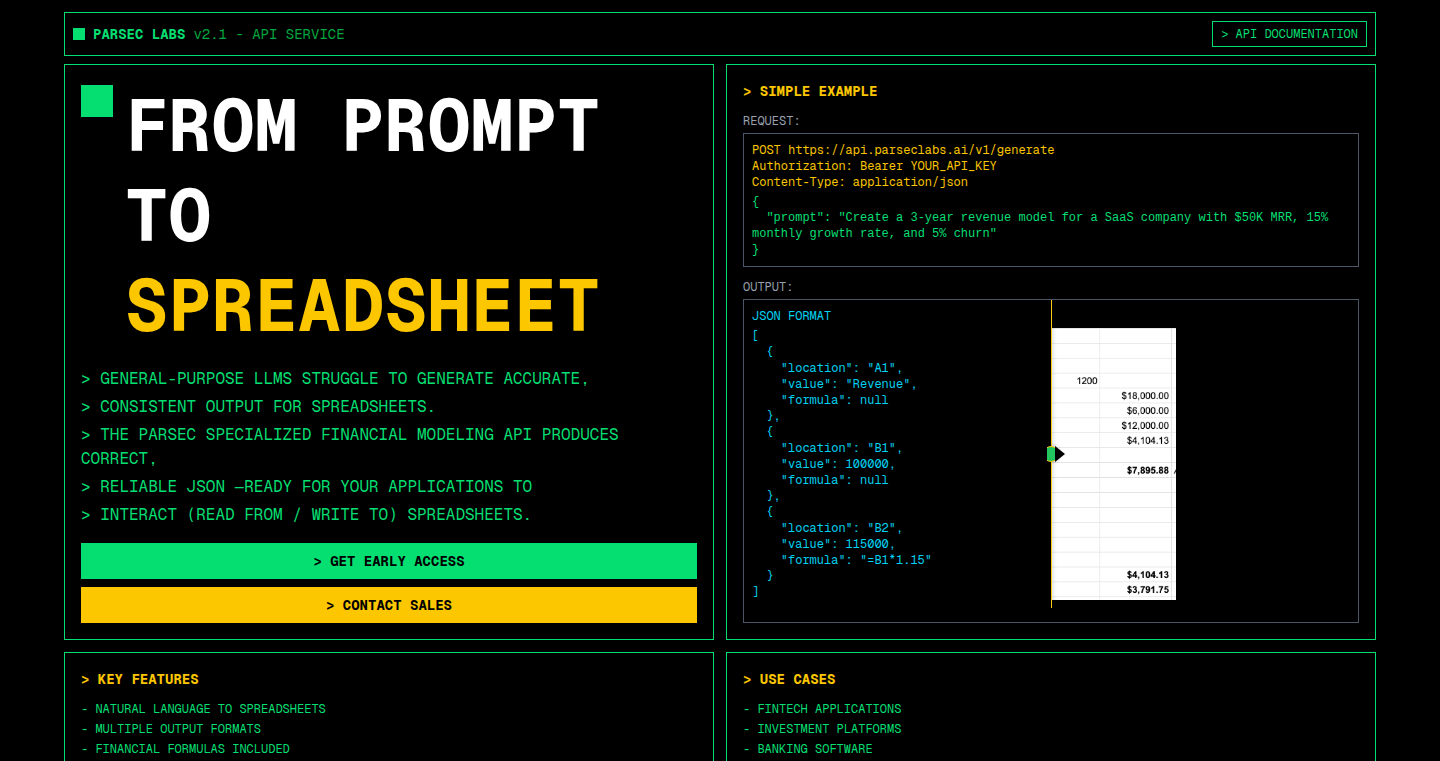
Author
mpcadosch
Description
Prompt2Sheet is an API that lets you generate and manipulate spreadsheets (like Excel or Google Sheets) using simple English instructions. The core innovation is its ability to translate natural language prompts into correct and reliable spreadsheet outputs, even when dealing with complex data. This tackles the common problem of Large Language Models (LLMs) struggling to generate accurate spreadsheet results. It removes the need for complex prompt engineering and allows developers to easily integrate spreadsheet functionality into their applications.
Popularity
Points 2
Comments 0
What is this product?
Prompt2Sheet is an API built to solve the problem of creating and interacting with spreadsheets using natural language. The core of this project is a finely-tuned LLM (Large Language Model). You give it instructions in plain English, and it generates the corresponding data in your spreadsheet. For instance, you can say "create a table with sales data by region" and Prompt2Sheet will automatically build that table. The innovation is its ability to understand your instructions and execute complex spreadsheet tasks efficiently and accurately. So this is a tool that makes it easy to use AI to work with spreadsheets, so you don't have to spend hours building formulas or formatting data.
How to use it?
Developers use Prompt2Sheet through an API. You would send a request, containing the instructions you want to perform on a spreadsheet (e.g., 'add a column for profit margin'), and Prompt2Sheet will return the modified spreadsheet data. This can be integrated into various applications – think of tools that generate reports, automate data analysis, or build user interfaces that interact with spreadsheets in a natural and easy way. So, it offers a simplified method for developers to handle complex spreadsheet-related tasks, which allows them to quickly add spreadsheet automation features to their apps.
Product Core Function
· Natural Language to Spreadsheet Generation: This enables users to create spreadsheets directly from English prompts, automatically generating tables, formulas, and data formatting. This simplifies the creation of complex spreadsheets and frees up time, especially for those unfamiliar with spreadsheet software.
· Automated Data Manipulation: The API can perform operations such as sorting, filtering, and aggregating data based on natural language instructions. This removes the need for manual data manipulation, saving time and improving data analysis efficiency.
· Formula Generation: Prompt2Sheet automatically generates complex formulas based on user instructions, simplifying calculations and enhancing the utility of the generated spreadsheets. This means you can handle your data effectively, and you don't have to know the complex formula syntax.
· Integration with Applications: Developers can integrate Prompt2Sheet with their applications to automatically generate and manage spreadsheets, streamlining workflows and improving user experiences. So you can quickly add features such as automated reporting or dashboards to your existing apps.
Product Usage Case
· Automated Reporting: A business intelligence application could use Prompt2Sheet to generate weekly sales reports directly from user requests like 'Show sales by product category and region'. This saves time and ensures accurate, up-to-date reporting.
· Data Analysis Dashboards: Developers can build dashboards that automatically update with the latest spreadsheet data, allowing users to explore information using simple prompts like 'Show me the top 10 customers by sales'. This enhances user experience by providing an interactive way to explore the information.
· Customer Relationship Management (CRM) Integration: A CRM system can use Prompt2Sheet to automatically generate sales forecasts and customer analysis reports based on natural language requests from salespeople. This streamlines workflows and enhances data-driven decision-making.
· Educational Tools: Create educational tools that automatically generate exercises, examples, and solutions related to spreadsheets directly from user requests. This enhances the learning process and allows users to get instant feedback.
50
Cursor Rules Generator
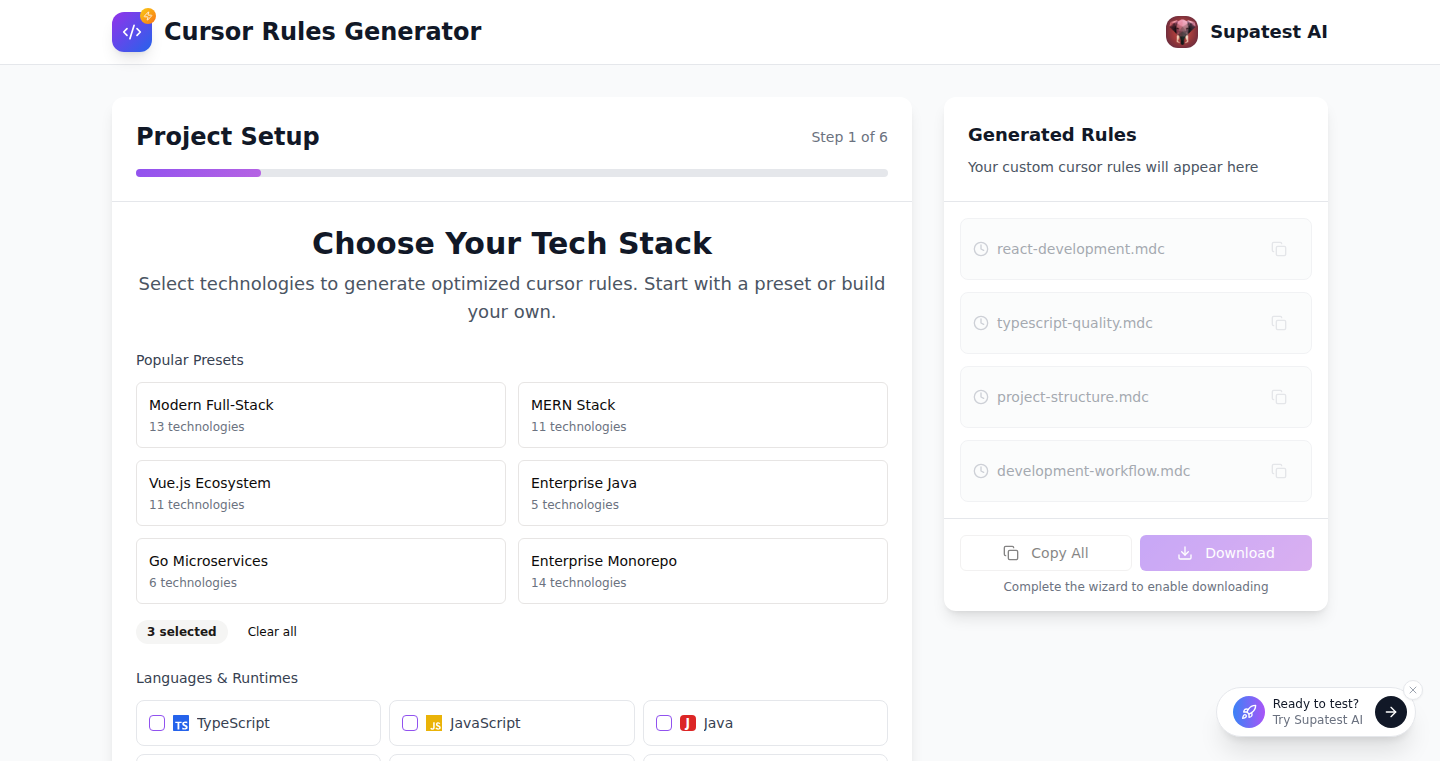
Author
prasadpilla
Description
This project automates the creation of rules for Cursor, an AI-powered coding assistant. It tackles the problem of manually setting up rules, which can be time-consuming, by generating them based on the user's technology stack and preferences. This is a significant innovation because it streamlines the process of customizing AI-assisted coding, leading to improved code quality and developer autonomy.
Popularity
Points 2
Comments 0
What is this product?
This is a tool that automatically generates rules for Cursor. Think of it as a smart assistant for your coding assistant. By inputting the technologies you use and your coding style, the tool spits out pre-configured rules that tailor Cursor to your specific needs. The core innovation lies in automating the rule-generation process, saving developers time and effort. So this automates the complex configuration, making the coding process smoother.
How to use it?
Developers can use this tool by inputting their project's technologies (e.g., Python, JavaScript, React) and specifying their coding preferences (e.g., code style, error handling). The tool then generates a set of rules which can be directly integrated into Cursor. This streamlines the integration, saving developers time. The tool also helps with integrating with their current development environment.
Product Core Function
· Technology-Based Rule Generation: This feature allows the tool to understand your project's technology stack and generate rules tailored to those specific technologies. So this reduces the manual effort of configuring Cursor for different languages and frameworks. It's like having a personalized AI assistant, so your code adapts quickly to new tools.
· Preference-Driven Rule Generation: This function creates rules according to the user's coding preferences, such as code style, error handling, and testing practices. So this allows developers to customize Cursor to match their team's coding standards. It boosts code consistency, so you can avoid conflicts.
· Automated Configuration: This is about the automated creation of rules, so developers don't have to write them manually. The rules are automatically created based on input, which reduces configuration time and enhances developer autonomy. You get a smart and customized coding experience.
· User-Friendly Interface: The tool provides an easy-to-use interface for entering information, ensuring that developers of all skill levels can benefit. So you can make your coding assistant work for you quickly and easily.
Product Usage Case
· Software Project with Multiple Technologies: A developer working on a project using Python, React, and PostgreSQL can use the tool to generate rules specific to each technology. For instance, it would configure Cursor to suggest Pythonic code conventions, React component structures, and best practices for database interactions. So your project's different parts get handled right.
· Team-Specific Coding Standards: A team can standardize their coding style by configuring the generator with their specific preferences, such as indentation, naming conventions, and commenting styles. This way, all members of the team will have their AI coding assistant following the same style. So, team members get the same style and consistency.
· Rapid Project Onboarding: A new developer joining a project can quickly configure Cursor to match the existing code base by using the generated rules. This reduces the learning curve and ensures consistency from day one. So new team members get set up quickly.
51
OwnYourPixel.fun: Digital Real Estate on a Global Canvas

Author
mandarwagh
Description
OwnYourPixel.fun is a web project that lets users buy pixels on a shared online canvas, similar to the Million Dollar Homepage, but with a key twist: these pixels can be resold. It transforms digital space into tradable assets, like mini-domains, within an open billboard economy. The project is built using HTML, Tailwind CSS, Firebase, Stripe for payments, and Vercel for hosting. The core innovation is the creation of a digital marketplace where users can buy, customize, and trade pixel space. So, this allows you to invest in and potentially profit from digital real estate.
Popularity
Points 2
Comments 0
What is this product?
This project creates a digital canvas where users can purchase individual pixels for a dollar each. Users can upload images or links to their pixels, making them customizable advertisements or digital art. The core concept is the resale aspect: users can later sell their pixels to others, transforming them into digital assets. The backend is handled by Firebase, Stripe for payments, and Vercel for hosting. It reimagines the early internet viral concept of a single digital billboard, expanding to a marketplace. So, this gives you the ability to own and monetize digital space, like a mini-domain or advertisement.
How to use it?
Developers and users can interact with the platform by first buying pixels. They then upload their image or URL, customizing each pixel to represent their brand, art, or message. A key benefit is the ability to then resell those pixels on the upcoming marketplace. The frontend uses HTML and Tailwind CSS, suggesting easy integration, and the payments are integrated with Stripe. So, if you are a developer or someone looking to advertise or create art online, this project offers a direct and intuitive method.
Product Core Function
· Pixel Purchase: Users can buy individual pixels on the global canvas, representing an entry point into the platform and the digital asset marketplace. This opens opportunities for advertisers, artists, and individuals to stake their claim in digital real estate. For you: A straightforward method for purchasing and owning digital space.
· Image/Link Customization: Each pixel can be customized with an image and a link, turning it into a mini-advertisement or a piece of digital art. This feature provides a creative opportunity to showcase brands or personal expressions, or to drive traffic to a specific web destination. For you: This adds value for advertising and personal expression.
· Pixel Resale Marketplace (Upcoming): The ability to resell pixels creates a secondary market, allowing users to treat their pixel ownership as a digital investment. This feature is central to the project, opening a new dimension to the digital billboard economy. For you: This gives you the chance to earn money from your pixels.
· Shareable Pixel URLs: Each pixel has a unique URL, allowing users to directly share specific sections of the canvas with auto-zoom and highlighting, this makes promoting specific pixel locations extremely easy. For you: This enhances social media promotion, making it easier for others to view and engage with your pixels.
· Permanent Pixel Ownership: The guarantee that once a pixel is bought, it's permanently owned by the user, providing a sense of security and value. For you: You have full control and ownership over your pixels.
Product Usage Case
· An advertising agency uses the platform to create a series of branded pixels on the canvas. They then use the shareable pixel URLs to direct potential customers to a product landing page. For them: an engaging and trackable advertising approach.
· An artist buys a set of pixels to create a digital artwork, using each pixel as a brushstroke, and then resells the art on the marketplace. For them: This lets them create, showcase, and potentially monetize their art in a unique digital space.
· A developer integrates the platform into their online community. They use the marketplace as a creative tool for members, so they can buy, trade, and display their digital artwork on the global canvas. For them: A new and innovative revenue stream from their community.
52
Outbrand: AI-Powered Automated Content Generator

Author
jsathianathen
Description
Outbrand is a tool designed to automatically generate social media content for your products. It allows busy founders to set up their brand details and goals once, and then receive a 30-day content schedule, complete with graphics. The innovation lies in its automation of content creation, using AI to save time and effort for marketing teams.
Popularity
Points 1
Comments 1
What is this product?
Outbrand is a content creation assistant that uses AI to streamline your social media presence. It analyzes your brand and goals to generate a month's worth of content, including text and visuals. The core technology lies in its ability to understand your brand identity and auto-generate posts, saving you the time and effort of manually creating content. So this will make your brand more active on social media without you having to spend hours on it.
How to use it?
You, the developer, can use Outbrand by inputting your brand's information and marketing objectives. The platform then generates a content calendar that can be integrated with various social media platforms. This allows you to schedule and automate your content posting. So it simplifies the content creation process, giving you more time to focus on your core product.
Product Core Function
· Automated Content Generation: The tool automatically creates social media posts based on the brand details and objectives you provide. This saves time and effort in content creation. So this can boost your content creation efficiency.
· 30-Day Content Calendar: Outbrand provides a pre-planned content schedule for a month. This helps users maintain a consistent posting schedule. So, your audience sees new content regularly, which helps your brand to grow.
· Graphic Integration: The tool generates content that includes visuals. It makes the content more engaging. So this will attract more audience to your brand.
· Social Media Integration: The ability to integrate with social media platforms allows for scheduled content posting. It can save time and effort in managing your content. So you can save the time from copy and paste to upload it manually.
Product Usage Case
· A startup founder with limited marketing resources can use Outbrand to consistently post content on social media platforms, thereby increasing brand visibility and engagement. This solves the problem of lacking the time and resources to manually create content. So your business can have an active presence.
· A small e-commerce business can use Outbrand to create content that promotes products, increasing sales and customer engagement. This tool solves the problem of not having the time to create content manually. So your sales will get a boost.
· A developer building a SaaS product can use Outbrand to create content that educates users about the product's features and benefits. This tool solves the problem of creating and publishing the marketing posts. So your users have more content to understand your products.
53
Scribble Draw: From Sketch to Image with Style Transfer
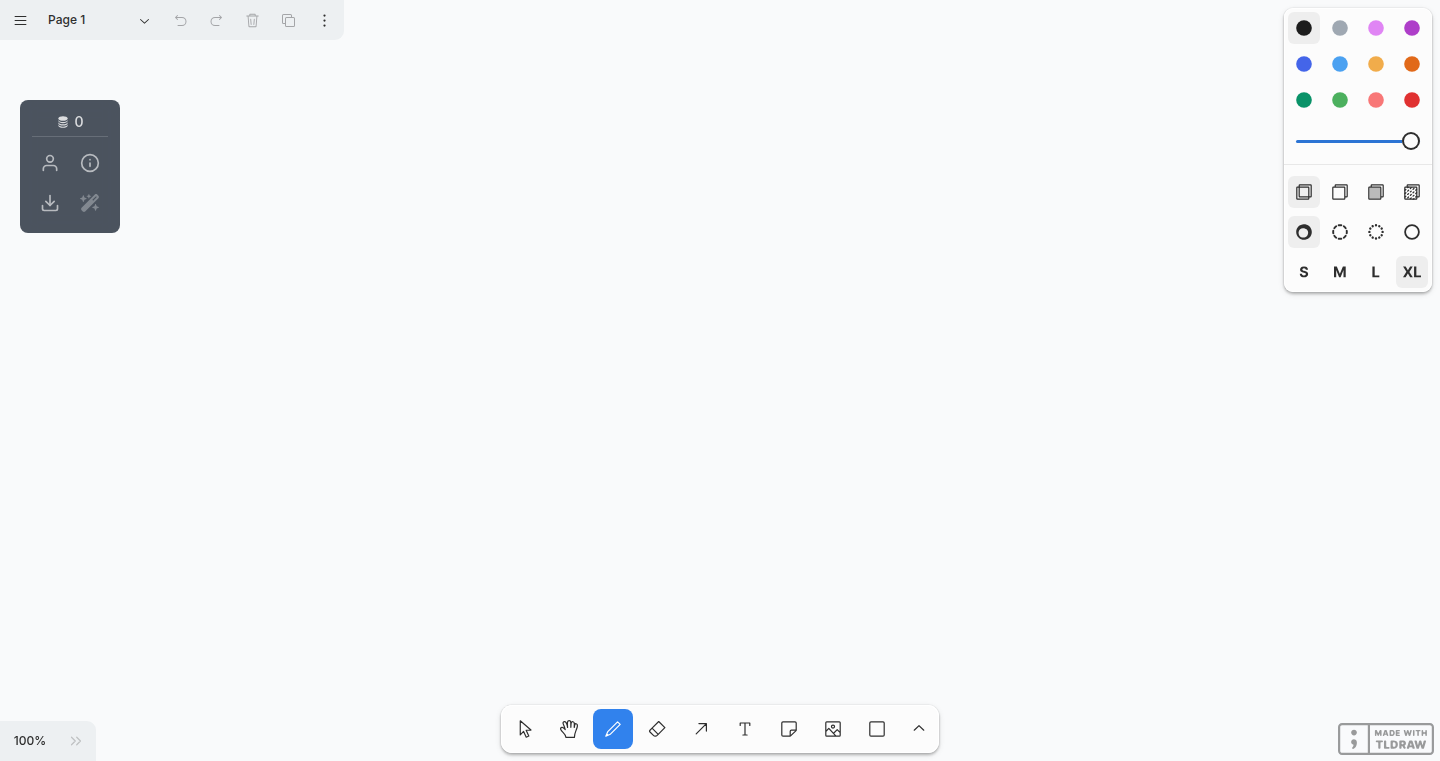
Author
jchiu1234
Description
Scribble Draw is a project that allows you to generate images from simple sketches, leveraging the power of image generation models. The innovation lies in its ability to translate a user's rough drawing into a polished image, while also incorporating style transfer. This means you can not only create an image from a doodle but also apply the style of a famous painting or any other image to your generated output. It tackles the technical challenge of bridging the gap between abstract sketches and complex visual content.
Popularity
Points 2
Comments 0
What is this product?
Scribble Draw utilizes deep learning models, specifically focusing on image generation and style transfer techniques. Imagine you draw a quick sketch; the system analyzes this sketch and, using pre-trained models, generates a detailed image that corresponds to your sketch. Additionally, it allows you to choose a style, like 'Van Gogh' or 'Monet', and applies it to the generated image. The core innovation is its ease of use: it simplifies complex image generation tasks into a simple drawing process and style selection. So this is useful because it allows anyone to create sophisticated images from simple inputs, even without artistic skill or technical expertise.
How to use it?
Developers can potentially integrate Scribble Draw into their applications or websites through API access or by incorporating the underlying models into their own code. This could be useful for creating tools for digital artists, photo editors, or even educational applications. For instance, a developer could build an app where users sketch a character and instantly see it stylized in different art forms. It can be integrated by using the API, or by using the codebase and the pre-trained models. So this is useful because it provides a flexible and customizable approach to image generation.
Product Core Function
· Sketch-to-Image Generation: Transforms basic user sketches into detailed images, understanding the general shape and features provided. This is useful for rapidly prototyping visual ideas or creating quick visual content.
· Style Transfer: Applies artistic styles (e.g., from famous paintings or photographs) to the generated image, giving the user control over the visual aesthetic. This is useful for creating unique visual content that blends artistic styles.
· Image Refinement: The system likely has mechanisms to refine the generated image, ensuring quality and matching the user's intent based on their input. This is useful for producing professional looking images from simple sketches.
· Model Customization: Depending on the implementation, users may be able to train or fine-tune the underlying models to generate images of specific objects, styles, or characteristics. This is useful for creating images tailored to specific needs or branding requirements.
Product Usage Case
· Graphic Design: A designer can quickly create multiple visual concepts for a client by sketching rough ideas and applying different styles to see various design iterations. This resolves the problem of slow idea generation and the need to start from scratch.
· Digital Art: Artists can use Scribble Draw to explore different styles and compositions, accelerating their creative process and reducing the time spent on technical execution. This resolves the difficulty of achieving complex visual effects.
· Education: Teachers can use this to teach students about art styles or to illustrate complex concepts visually, by generating images based on student drawings. This resolves the problem of making complex concepts more understandable.
· Content Creation: Social media content creators can generate visually appealing images for their posts quickly, saving time and effort on image editing. This resolves the need to find existing images or hire designers.
54
Bedrock: A Universal 8-bit Program Runtime
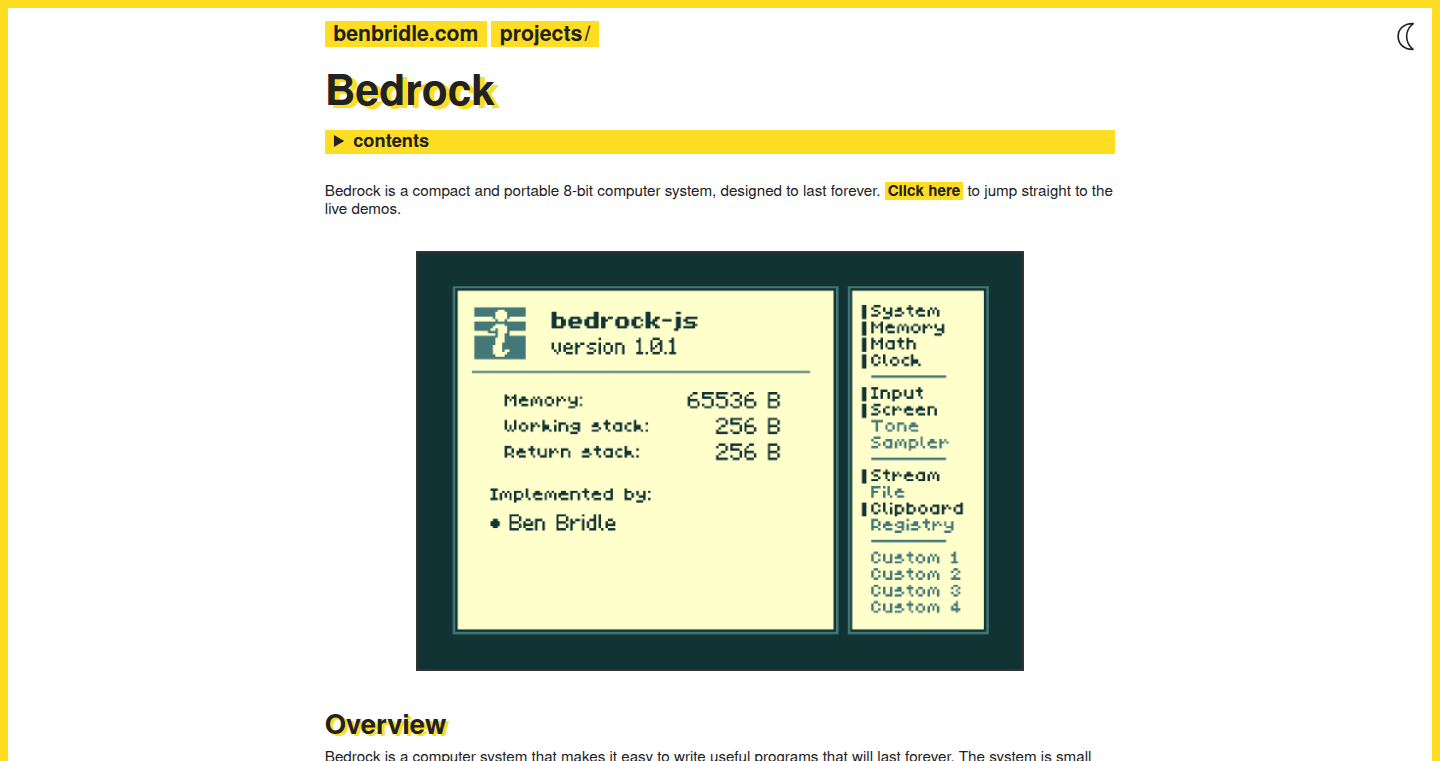
Author
benbridle
Description
Bedrock is a lightweight program runtime designed for simplicity and portability. Think of it as a tiny engine that can run your programs on almost any device, from your computer to a handheld console. The key innovation is its small size and the way it works: programs are compiled into a very compact format called bytecode, which is easy to run and can be implemented quickly. This allows developers to create programs that can be easily deployed across different platforms, making software development and maintenance much easier.
Popularity
Points 2
Comments 0
What is this product?
Bedrock is an 8-bit computing system, similar in concept to retro systems like the Commodore 64, but designed for modern ease of use. The core idea is to create a minimal runtime environment. Instead of relying on complex operating systems, Bedrock uses a tiny runtime that understands a specific set of instructions (bytecode). Programs are written in a higher-level language and then converted (compiled) into this bytecode. This bytecode is then executed by the Bedrock runtime. The advantage? It's incredibly small and can run on almost anything. So this helps developers build programs that can run anywhere with minimal effort.
How to use it?
Developers can use Bedrock by writing programs, compiling them to Bedrock's bytecode, and then running this bytecode on a target device. It includes tools for compiling, running, and debugging Bedrock programs. This is useful for creating embedded software, retro gaming projects, educational tools, or simply learning about computer architecture. It also facilitates cross-platform development. So this allows developers to write code once and run it everywhere, cutting down on development time and headaches.
Product Core Function
· Bytecode Execution: Bedrock’s core functionality is the execution of bytecode. This means it interprets and runs the compiled instructions. This is valuable because it enables programs to be platform-agnostic. You write the program once, and the runtime takes care of the specifics for each device. So this lets you create games or utilities that can run on anything.
· Cross-Platform Compilation: Programs are compiled into a common bytecode format. This is useful because it simplifies the process of porting programs to various platforms. No matter the underlying hardware, as long as a Bedrock runtime is available, the code will run. So this means you can develop software once, and deploy it on many different devices (computers, consoles, embedded systems), saving time and resources.
· Minimalist Design: The runtime is incredibly small and efficient, designed for low-resource environments. This is extremely valuable for embedded systems, retro gaming projects, or any scenario where resources are limited. So this helps create software that is lightweight and doesn't require powerful hardware to run, allowing for use in older or simpler devices.
· Modular I/O: Bedrock's I/O system (input/output, e.g., keyboard, screen, network access) is modular. This means that new devices and functionalities can be added as needed. This modular approach promotes flexibility and extensibility. Developers can integrate Bedrock with various hardware and software components, tailoring it to their project’s specific requirements. So this allows developers to customize their programs to work with a wide range of devices and environments.
Product Usage Case
· Retro Game Development: Using Bedrock to create 8-bit style games that can run on a variety of platforms, from modern computers to retro consoles or even embedded systems. This solves the problem of platform-specific coding by providing a common bytecode. So this lets developers focus on gameplay and design instead of getting bogged down in hardware specifics.
· Embedded Systems Programming: Implementing Bedrock on microcontrollers or other embedded devices to run simple applications or control hardware components. This helps solve the issue of limited resources and simplifies the deployment process. So this makes it possible to build applications for small devices and IoT projects with ease.
· Educational Tools: Creating interactive tutorials or simulations of computer architecture, as the system is simple and well-defined, making it ideal for learning. So this allows students and enthusiasts to explore the inner workings of computing systems without needing advanced knowledge.
· Cross-Platform Software Development: Developing utility applications that can run seamlessly across different operating systems (Windows, macOS, Linux) and hardware architectures. This simplifies the deployment process and reduces development time. So this enables developers to build apps that reach a wider audience without the burden of platform-specific development.
55
Bullpost: A Decentralized Conviction Engine for Startup Promotion

Author
spenserhuang
Description
Bullpost is a platform designed to incentivize and reward users for promoting underrated startups and founders through bullish tweets. It leverages a point system and competition to foster a community of early adopters and builders. The core innovation lies in creating a direct link between social media engagement and tangible rewards, encouraging organic promotion and community-driven growth. This addresses the challenge of discovering promising startups amidst the noise and providing value to early supporters.
Popularity
Points 2
Comments 0
What is this product?
Bullpost is essentially a gamified platform built around X (formerly Twitter). Users earn points by posting and amplifying tweets that express positive sentiment about specific startups and founders. The platform then tallies these points, awarding weekly prizes and a final grand prize, directly translating social media activity into financial incentives. The underlying technology uses web scraping and sentiment analysis to track tweets and determine their bullishness. This innovation creates a more efficient way to discover startups and encourages organic promotional activity. So this provides a way to get rewarded for supporting early-stage companies.
How to use it?
Developers and users can participate by posting bullish tweets about selected startups and founders. The platform likely provides a dashboard or tracking system to monitor points and engagement. Integration would involve using the Bullpost platform, following their guidelines on tweet format and content. This platform is great for those who have a passion for finding promising companies, this is your opportunity to earn rewards by actively promoting these startups.
Product Core Function
· Tweet Tracking and Analysis: The core of Bullpost involves tracking and analyzing tweets to identify and measure bullish sentiment. This utilizes Natural Language Processing (NLP) and sentiment analysis techniques to determine if a tweet is positive, neutral, or negative about a startup or founder. This is incredibly useful for understanding how users are engaging with your brand or your competitors, helping you to make informed decisions on your messaging.
· Point System and Gamification: A point-based system is used to reward users for their engagement. Points are awarded based on various factors, such as the number of likes, retweets, and replies a tweet receives. This incentivizes users to create high-quality, engaging content. So this is great for developers who want to encourage engagement, and it gamifies the user experience by making it more fun and rewarding.
· Leaderboard and Prize Distribution: A leaderboard ranks users based on their accumulated points, with prizes awarded weekly and for the final competition. This structure adds a competitive element and provides a clear value proposition for participation. This gives developers the motivation to continuously engage on the platform and increase their chances of winning.
· Startup and Founder Selection: Bullpost focuses on promoting specific startups and founders, likely through a curated list or application process. This ensures targeted exposure and community focus. This helps developers to have focused marketing, where they can show their companies.
· Amplification and Engagement Metrics: Bullpost measures amplification through retweets and engagement through likes and replies. This provides metrics for evaluating the impact of each tweet. So developers can get a clearer picture of how well their content performs and how much engagement they are getting.
Product Usage Case
· Community Building for Startups: A startup uses Bullpost to reward its early supporters for posting positive tweets about the company. This encourages community engagement and provides valuable social proof. So this provides an opportunity for the company to gain brand awareness and build a strong community.
· Promoting Underrated Founders: A user leverages Bullpost to discover and promote promising but lesser-known founders. By earning points and potentially winning prizes, the user helps boost the founders' visibility and supports their growth. This platform could be a great way to help promote upcoming founders.
· Marketing Campaign Analysis: A marketing team utilizes Bullpost to gauge the effectiveness of their promotional tweets. The platform's analytics provide insights into user engagement, helping them refine their messaging and strategies. So developers can assess campaign success by tracking what users are saying.
· Early Adopter Acquisition: A startup uses Bullpost to attract early adopters by incentivizing them to share positive content and interact with the company's posts. So this can boost the company's presence on social media, and encourage the community to spread the word.
56
GovDocs: AI-Powered South African Government Document Search
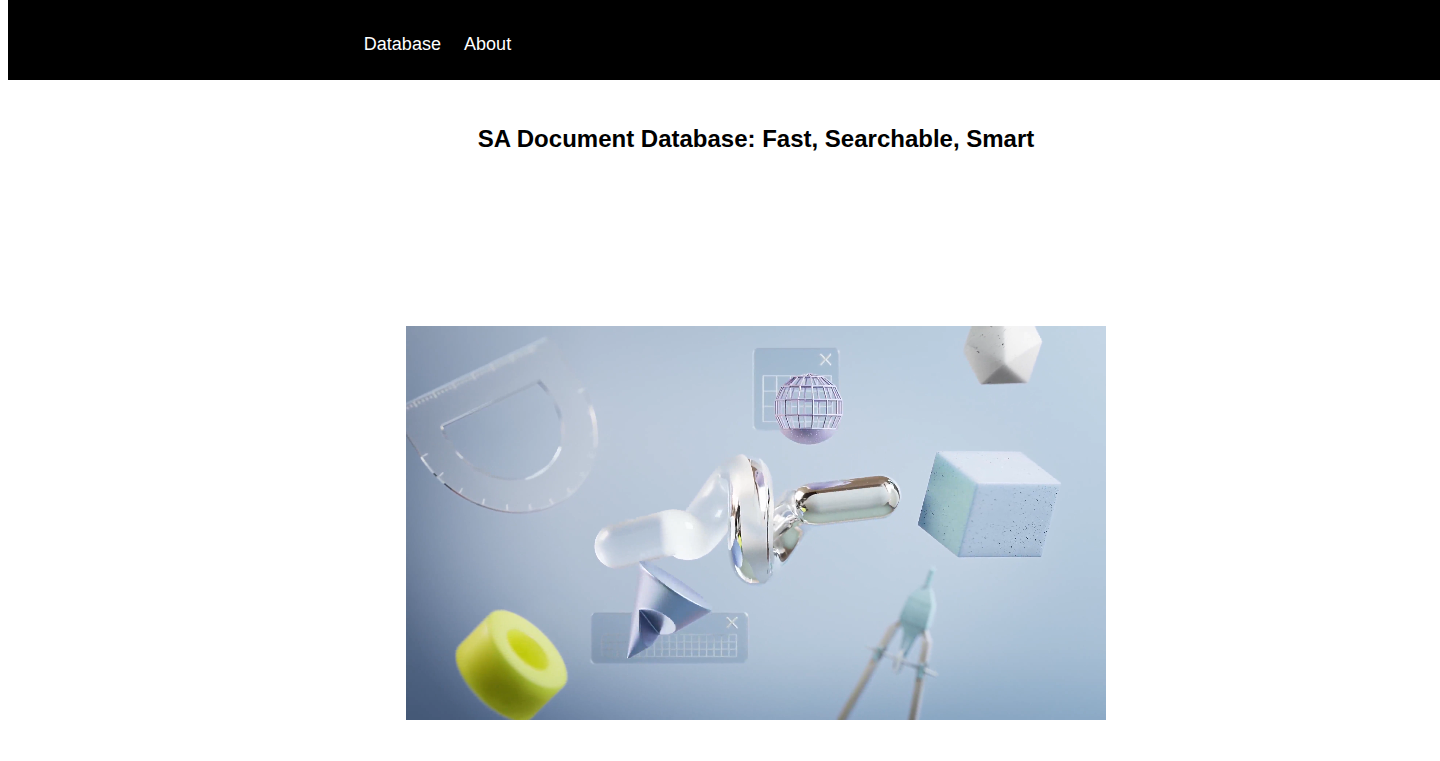
Author
Ntuthuko_hlela
Description
GovDocs is a search engine that uses Artificial Intelligence (AI) to make South African government documents easily searchable. It addresses the common problem of finding information buried within complex documents. The key innovation lies in employing AI to understand the content of these documents, enabling users to find what they need quickly and efficiently. This bypasses the limitations of traditional keyword-based search and provides more relevant search results. So this is a smarter search for government information.
Popularity
Points 2
Comments 0
What is this product?
GovDocs uses AI, specifically Natural Language Processing (NLP), to index and understand South African government documents. Unlike basic search engines that rely on exact keyword matches, GovDocs analyzes the meaning and context of the text. This allows users to search for concepts and ideas, even if the exact keywords aren't present in the document. For instance, you could search for 'policies about education funding' and GovDocs will identify documents related to that topic, even if the exact phrase isn't used. It essentially builds a semantic index of the documents. So, it's a more intelligent way to search government information, understanding not just words, but their meaning. This is particularly innovative because it makes information much more accessible.
How to use it?
Developers can use GovDocs by integrating it into their own applications or building tools on top of it. They could access the search functionality through an API, which allows them to query the indexed documents programmatically. For example, a developer could create a citizen-facing app that provides easy access to relevant government information, making it easier for citizens to understand laws and policies. Another use case could be building an internal tool for government employees to quickly find information needed for their work. The integration will be easier if the GovDocs provides a well-documented API. So, developers can build better tools for accessing and understanding government information, leading to more informed citizens and more efficient government operations.
Product Core Function
· Semantic Search: This is the core feature. It understands the meaning of your search query, going beyond simple keyword matching. This means you can find documents even if they don't use the exact words you typed, increasing the chances of getting relevant results. For developers, this allows building a more powerful and user-friendly search experience.
· Document Indexing: GovDocs indexes government documents, making them searchable. This involves converting the text into a format that the AI can understand and process, allowing for faster and more accurate search results. This is valuable because it transforms a large amount of unstructured data into a usable format. Developers can take advantage of this if the project opens up an API to search.
· Natural Language Processing (NLP): AI's ability to understand human language is the backbone. NLP is used to analyze the documents and the search queries, understanding the context and relationships between words. This is crucial for semantic search. This is a critical tech and can be used in many other projects.
Product Usage Case
· Citizen Information Portal: Developers could build a website or application that provides easy access to government documents on specific topics like environmental regulations or healthcare policies. Users can use the app to search, instead of a simple keyword search, the tool can understand the context of the queries, and find the relevant information. This empowers citizens to understand the policies.
· Government Employee Tool: Government agencies can use the platform to create internal search tools for their employees. Staff can search the documents and find important information without reading every document. This improves efficiency and ensures employees can quickly access the data they need to do their jobs, reducing research time.
· Legal Tech Application: Lawyers and legal professionals can use GovDocs as a tool to find relevant legislation and policies when researching cases. They can get more comprehensive search results, which might be missed by keyword search. This enhances legal research efficiency and accuracy.
57
InsightAI: Autonomous Data Analyst for Growth and Data Teams
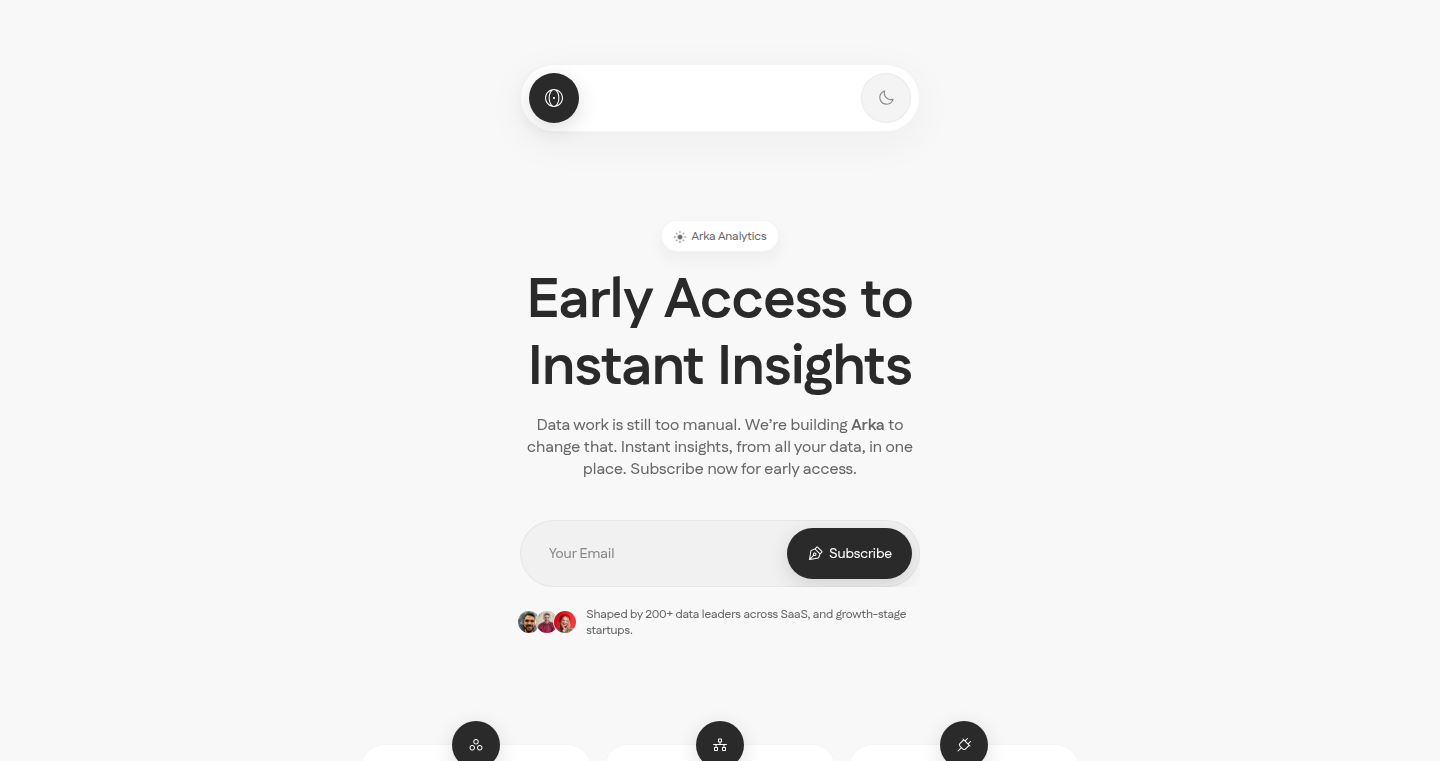
url
Author
LunarFrost88
Description
InsightAI is an AI-powered tool designed to automatically analyze data and provide insights, aiming to streamline the work of growth and data teams. It leverages the power of AI to automate data exploration, identify key trends, and generate actionable recommendations, eliminating the need for manual data wrangling and analysis. The core innovation lies in its ability to understand and interpret complex datasets, providing users with a clear and concise summary of their data's performance and potential growth opportunities. The project tackles the problem of time-consuming manual data analysis and aims to democratize data insights for non-technical users. So this tool saves your time and helps you better understand your data.
Popularity
Points 2
Comments 0
What is this product?
InsightAI works by integrating with various data sources and using advanced AI algorithms, including Natural Language Processing (NLP) and machine learning models. It automatically ingests, cleans, and analyzes data, then generates natural language summaries and visualizations of key findings. This means you no longer need to manually sift through spreadsheets or build complex dashboards. Instead, you get quick, easy-to-understand reports and actionable insights. The core innovation is the automation of the entire data analysis pipeline, from data ingestion to insight generation, which allows users to get valuable information much faster. So, it automates the tedious work of data analysis.
How to use it?
Developers can use InsightAI by connecting it to their data sources (like databases, spreadsheets, or cloud platforms). After connecting, the AI will begin analyzing the data and generating insights automatically. Developers can integrate it into their existing workflows, such as building custom dashboards or automating reporting processes. You can access insights through a web interface or API, allowing you to integrate these insights into other applications or services. It's helpful for data-driven decision-making, allowing developers to quickly understand their data. So, it integrates easily with your existing tools and provides data analysis on demand.
Product Core Function
· Automated Data Ingestion and Cleaning: This function automatically pulls data from different sources and prepares it for analysis. This saves significant time that would have been spent manually collecting and cleaning the data. This is especially useful for teams with numerous data sources or those who want to focus on insights rather than data preparation. So, this function simplifies your data collection process.
· AI-Driven Data Exploration: The system automatically identifies important trends, patterns, and anomalies within the data. This means users don't have to spend hours manually searching for key insights. This is especially valuable for teams that need to discover hidden patterns in large datasets or understand complex relationships within their data. So, this function helps you find the 'hidden gems' in your data.
· Natural Language Insights Generation: InsightAI translates complex data findings into plain English summaries, making it easy for anyone to understand the data without needing to be a data scientist. This empowers non-technical team members to use data more effectively. This is critical for teams that need to share insights across departments or when explaining data to stakeholders. So, this function makes data understandable for everyone.
· Actionable Recommendation Generation: The AI offers specific recommendations based on the data insights, guiding users on what actions to take to improve performance. This is particularly useful for growth teams looking to optimize their strategies or data teams wanting to drive impactful change. So, this function provides direct guidance for action.
· Data Visualization and Reporting: The system automatically creates charts, graphs, and reports to visualize the data, providing a clear and intuitive understanding of key metrics and trends. This functionality makes complex data easier to interpret and communicate. This feature is crucial for those needing to create presentations or sharing data analysis with others. So, it helps you visualize your data and explain it effectively.
Product Usage Case
· Marketing Campaign Analysis: A marketing team integrates InsightAI to analyze the performance of its advertising campaigns. The AI automatically identifies the most successful campaigns, the best-performing ad creatives, and the target audiences with the highest conversion rates. Based on these insights, the team quickly reallocates budget to high-performing campaigns, improving ROI and optimizing advertising spend. So, it helps you get the most out of your marketing budget.
· E-commerce Sales Optimization: An e-commerce business uses InsightAI to analyze its sales data. The AI identifies top-selling products, seasonal sales trends, and customer purchase patterns. The business can then optimize its product offerings, adjust pricing, and tailor marketing campaigns to specific customer segments, leading to an increase in sales and customer engagement. So, it helps you sell more products.
· Customer Behavior Analysis: A SaaS company leverages InsightAI to analyze user behavior data. The AI identifies key usage patterns, common points of friction, and areas where users abandon the product. With these insights, the company can improve its product design, streamline user onboarding, and enhance customer satisfaction, leading to better customer retention and higher revenue. So, it helps you retain more customers.
· Financial Data Analysis: A financial analyst integrates InsightAI to analyze financial reports and identify market trends. The AI automatically extracts key financial metrics and provides insights into investment performance, market opportunities, and potential risks. With these insights, the analyst can make informed investment decisions, improve portfolio management, and stay ahead of market changes. So, it helps you make better financial decisions.
58
0.finance: An Open-Source Crypto-Powered Bank Account
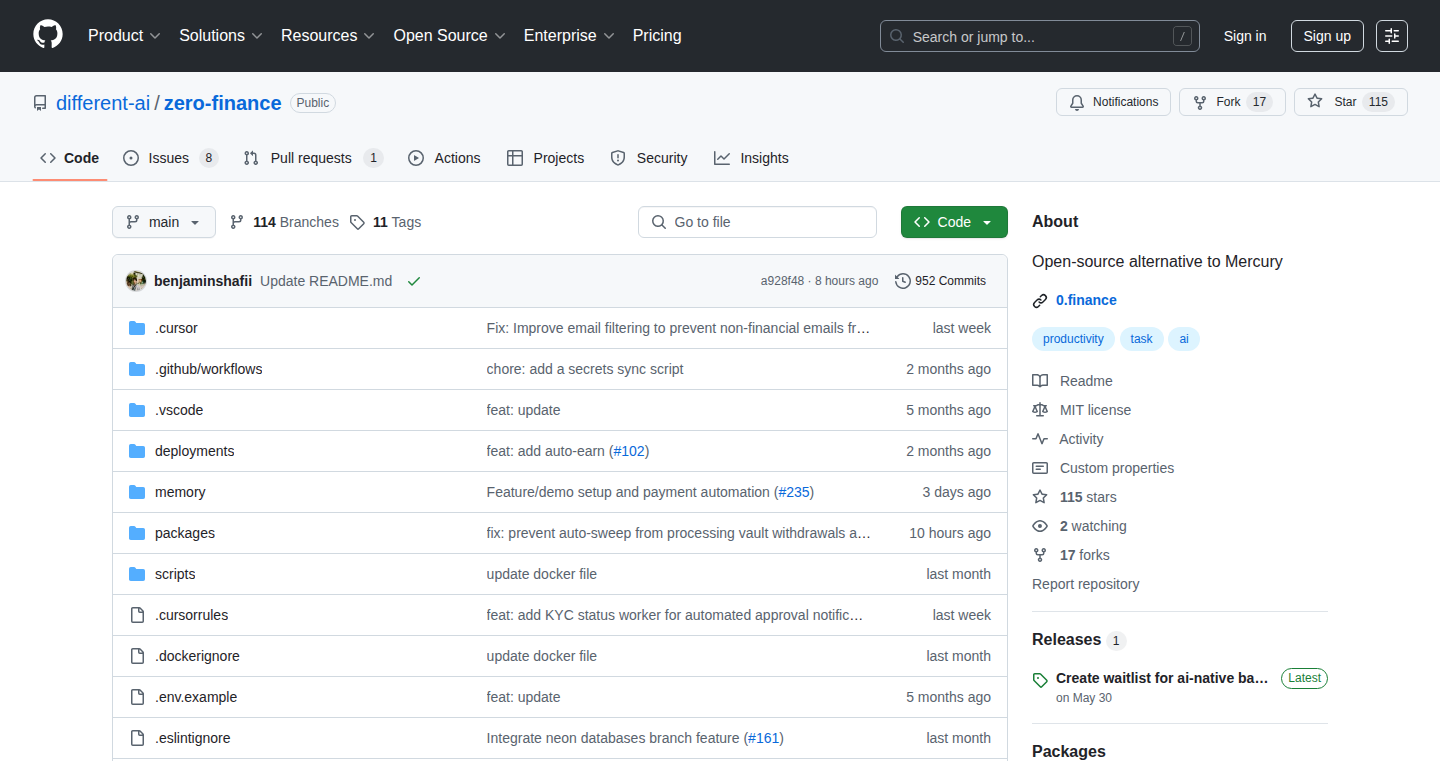
Author
ben_talent
Description
0.finance offers an open-source alternative to traditional bank accounts, built on top of crypto wallets. It provides a user interface (UI) that simplifies interacting with cryptocurrency, offering features like virtual accounts with ACH details for a bank-like experience. The project leverages advances in crypto UX to eliminate the need for direct private key management. Furthermore, it includes an automation layer, with features like a Gmail connector to categorize receipts and email parsing for auto-populating wire transfers. This allows users to manage their financial stack with automation and self-host the solution. So, this helps you manage your finances in a more secure, automated, and transparent way, leveraging the benefits of cryptocurrency.
Popularity
Points 2
Comments 0
What is this product?
0.finance is essentially a user-friendly interface that sits on top of a cryptocurrency wallet. It connects to services that let you use virtual accounts, just like a real bank, including ACH details. The core innovation is making crypto accessible and usable for everyday financial tasks, without needing users to deal directly with complex cryptographic keys. It also simplifies financial management by automating tasks like categorizing receipts and pre-filling payment information. So, the innovation lies in making complex crypto technologies accessible and easier to use.
How to use it?
Developers can use 0.finance by integrating its open-source code into their own applications or building custom financial tools on top of it. The project supports integration with 'on/off-ramp' providers. This allows developers to build solutions that accept and process cryptocurrency payments, manage virtual bank accounts, and create automated financial workflows. So, if you're building fintech apps or tools for managing finances, you can use this to simplify your development process.
Product Core Function
· Virtual Accounts with ACH Details: This allows users to receive payments and manage funds similar to a traditional bank account, using cryptocurrency as the underlying technology. The value here is enabling seamless integration between crypto and the existing financial system.
· Simplified Crypto UX: By abstracting away the complexities of managing private keys, the project makes using crypto more accessible to non-technical users. This is valuable because it reduces the barrier to entry for people wanting to use cryptocurrencies.
· Automation Layer: Features like the Gmail connector and email parsing streamline financial tasks, such as categorizing receipts and populating wire transfers, improving efficiency. This saves time and effort in managing finances and reduces manual data entry.
· Self-Hosting Capability: The project's open-source nature allows users to self-host the platform. This gives users greater control over their financial data and reduces reliance on third-party services. So, this provides you with more control over your financial data and security.
Product Usage Case
· Building a Crypto Payment System: Developers can use 0.finance as a foundation to build their own payment processing platforms, offering businesses the ability to accept cryptocurrency payments seamlessly. This simplifies the integration of crypto into business operations.
· Creating a Decentralized Banking Application: Developers can create their own versions of bank-like applications based on the project’s open-source code, offering users greater control over their finances and data.
· Developing Financial Automation Tools: Using the Gmail connector and email parsing functionalities, developers can build specialized tools to automate financial management for individuals or businesses, making tasks more efficient and reducing manual work.
· Integrating into Existing Fintech Solutions: Existing fintech companies can use 0.finance's features to add cryptocurrency support and enhanced financial automation to their products. This can expand the range of services they offer and attract more users.
59
Intermittent Fasting Calculator
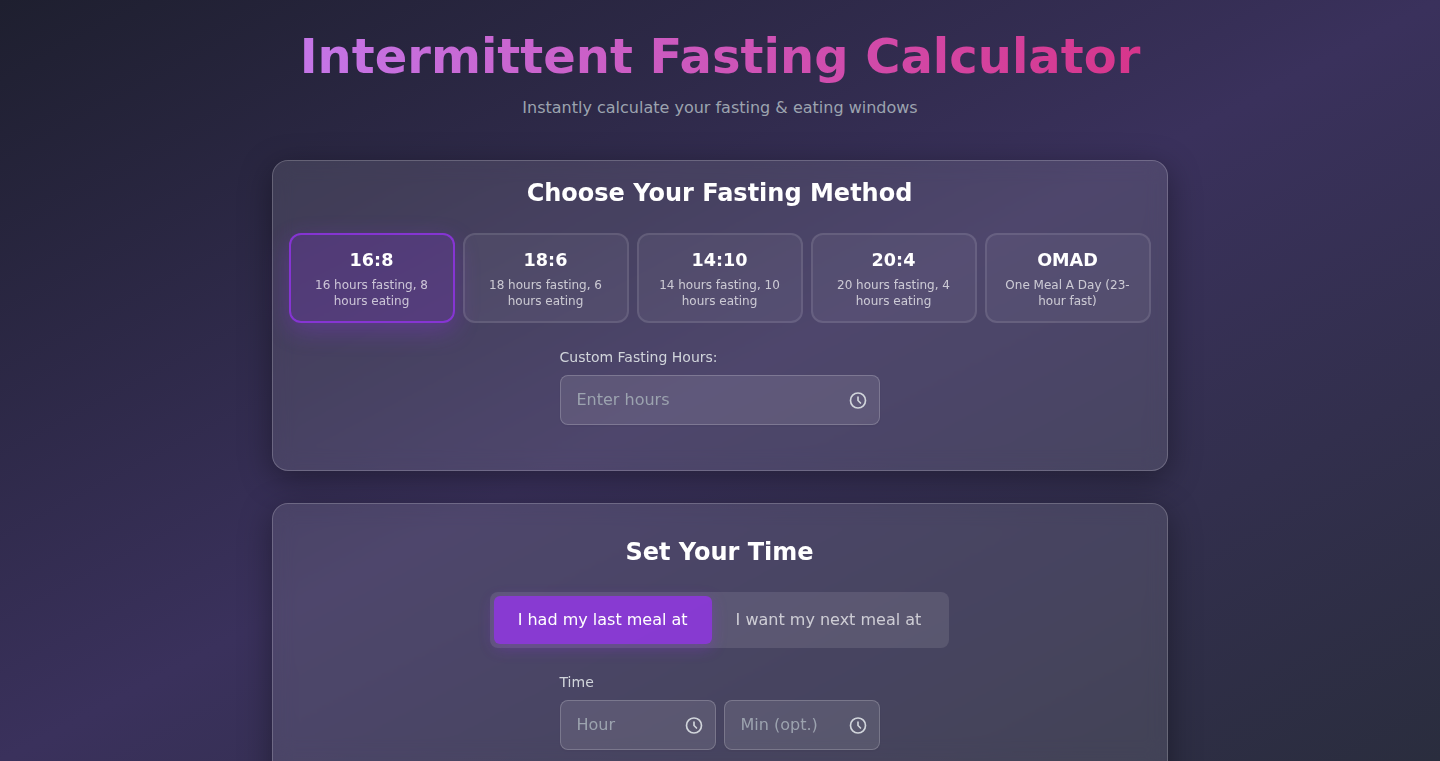
Author
MatthewTKD
Description
A web-based tool designed to help users plan their intermittent fasting schedules without the need for complex apps or mental calculations. It allows users to choose from common fasting methods or create custom schedules, input their meal times, and instantly generate a color-coded 24-hour timeline. This tool simplifies the process of planning and tracking fasting, providing a user-friendly interface for managing meal and fasting windows. The core innovation is the ease of use and the instant visualization of fasting schedules.
Popularity
Points 2
Comments 0
What is this product?
This is a web app, like a website you can use on your phone or computer, that helps you plan when to eat and when to fast. It's based on the idea of intermittent fasting, where you cycle between periods of eating and not eating. The app takes the guesswork out of planning your fasting schedule. You can pick from popular fasting methods (like 16 hours of fasting, 8 hours of eating), or customize your own. You tell it when you last ate, or when you want your next meal, and it creates a clear, color-coded timeline showing when you should be eating and fasting. This makes it super easy to see your schedule at a glance. So this is useful because it takes the brain work out of planning your fasting schedule.
How to use it?
Developers wouldn't necessarily integrate this directly into their apps, but it serves as a useful utility for personal use. The tool can be used on any device with a web browser. Users can enter their chosen fasting method (or a custom schedule), input their last or next meal time, and the tool instantly generates a visual timeline. The results can be exported in text, image, or PDF formats for easy tracking and sharing. You just go to the website, enter your info, and see your fasting plan. So this is useful for people who want to plan their fasting schedule quickly and easily.
Product Core Function
· Customizable Fasting Schedules: The ability to choose from pre-defined fasting methods (e.g., 16:8, 14:10) or set custom fasting windows. This is valuable because it allows users to tailor their fasting plans to their individual needs and preferences. So this is useful for those who want flexibility in their fasting routines.
· Instant Timeline Visualization: Generates a color-coded 24-hour timeline based on the user's input. This feature provides a clear, visual representation of the fasting schedule, making it easy to understand and track. So this is useful because it provides instant clarity on when to eat and when to fast.
· Export Options: Enables users to export the results as text, image, or PDF. This is valuable for users to save, share, or track their schedules. So this is useful for tracking your fasting progress and sharing your schedule with others.
· Mobile and Desktop Compatibility: The tool works on both mobile and desktop devices. This ensures accessibility for users on any device. So this is useful because you can access your plan on any device.
Product Usage Case
· Personal Use: A user looking to start or maintain an intermittent fasting routine can use the tool to plan their meal times and fasting periods each day. For example, a user following a 16:8 schedule can easily input their last meal time and the calculator will generate a timeline showing their fasting and eating windows. So this is useful for personal health management.
· Health Tracking: A user can save the generated timeline as an image or PDF and use it in their health tracking journal or app. So this is useful for monitoring adherence to the fasting schedule.
· Sharing with a Coach or Support Group: Users can share their fasting schedule with a health coach or a support group by exporting and sending the timeline image or PDF. So this is useful for those who need to share their plan with someone.
60
ggRMCP: gRPC to MCP Gateway
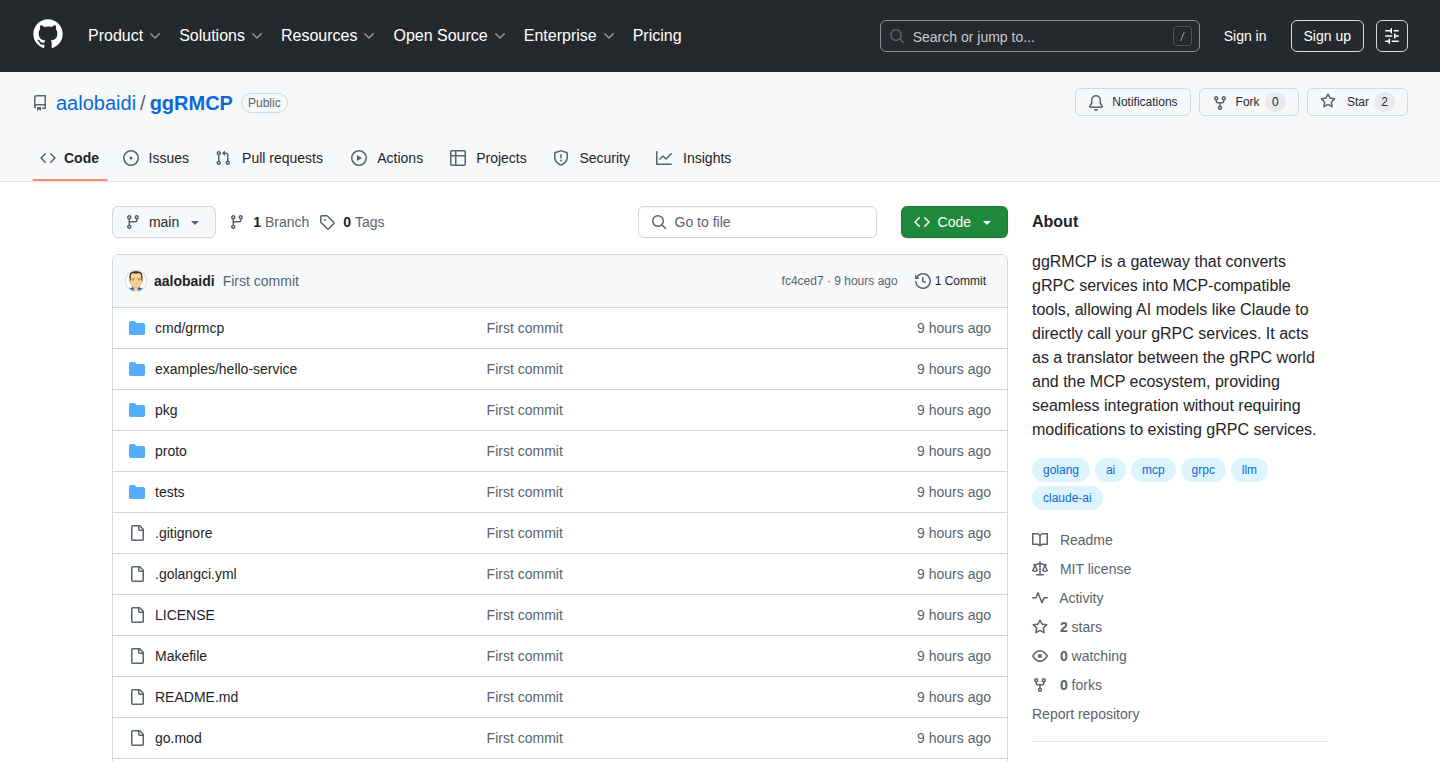
Author
ahmedobaidi
Description
ggRMCP is a gateway, written in Go, that allows AI models to directly interact with your existing gRPC services without requiring any code changes. The innovation lies in bridging the gap between gRPC (a popular framework for building APIs) and the Model Context Protocol (MCP), which AI models like Claude and OpenAI use to discover and utilize external tools. This means you can expose your gRPC services to AI, enabling them to leverage your existing infrastructure without needing to rewrite or adapt your code.
Popularity
Points 2
Comments 0
What is this product?
ggRMCP acts as a translator. Think of it as a universal adapter. It takes requests designed for gRPC services and converts them into a format that AI models understand (MCP), and vice-versa. This allows AI models to effectively 'call' your gRPC services. The key innovation is this translation, removing the need for manual integration efforts. So this allows you to easily connect your existing gRPC services to AI models.
How to use it?
Developers can deploy ggRMCP in front of their existing gRPC services. Configure the gateway to point to the services, and then provide the gateway's address to the AI model. The AI model can then use the gateway to call those services. For example, if you have a gRPC service for handling customer orders, you can expose it to an AI model via ggRMCP, allowing the AI to create, update, or retrieve order information. So this enables the integration of existing infrastructure with AI capabilities.
Product Core Function
· gRPC to MCP Translation: The core function is translating between gRPC and MCP. Value: This enables AI models to understand and interact with gRPC services. Application: Allows AI chatbots to query databases through gRPC APIs.
· Service Discovery: ggRMCP enables AI models to discover available gRPC services. Value: AI models can dynamically identify and interact with services, eliminating hardcoding service endpoints. Application: Lets AI models identify and interact with new features or APIs as they become available without requiring model retraining.
· Authentication and Authorization Handling: ggRMCP likely handles authentication and authorization, ensuring secure access to the underlying gRPC services. Value: Protects against unauthorized access and ensures only authorized users can access gRPC services through the AI model. Application: This is crucial for securely exposing APIs.
· Request and Response Transformation: The gateway transforms gRPC requests and responses into a format compatible with the AI model's expectations. Value: This facilitates seamless communication and integration between the AI and the gRPC services. Application: Allows the AI to understand and process the data returned by the gRPC APIs.
Product Usage Case
· Customer Support Chatbot Integration: Integrate an AI chatbot with a gRPC-based customer order management system. The chatbot, through ggRMCP, can answer customer questions about orders, update orders, or provide order status updates without any changes to the existing gRPC backend. This solves the problem of needing to manually build integration code.
· Data Analysis and Reporting: Connect an AI-powered analytics tool to a gRPC-based data processing service. The AI can use the gRPC services to perform complex data queries and generate reports. This allows for rapid access to complex data without manual API integration.
· E-commerce Automation: An AI model can directly interact with gRPC APIs to manage product listings, handle inventory updates, or process customer transactions. The benefit here is that existing business processes are exposed to AI for automation.
61
Shortly: Privacy-Focused URL Shortener
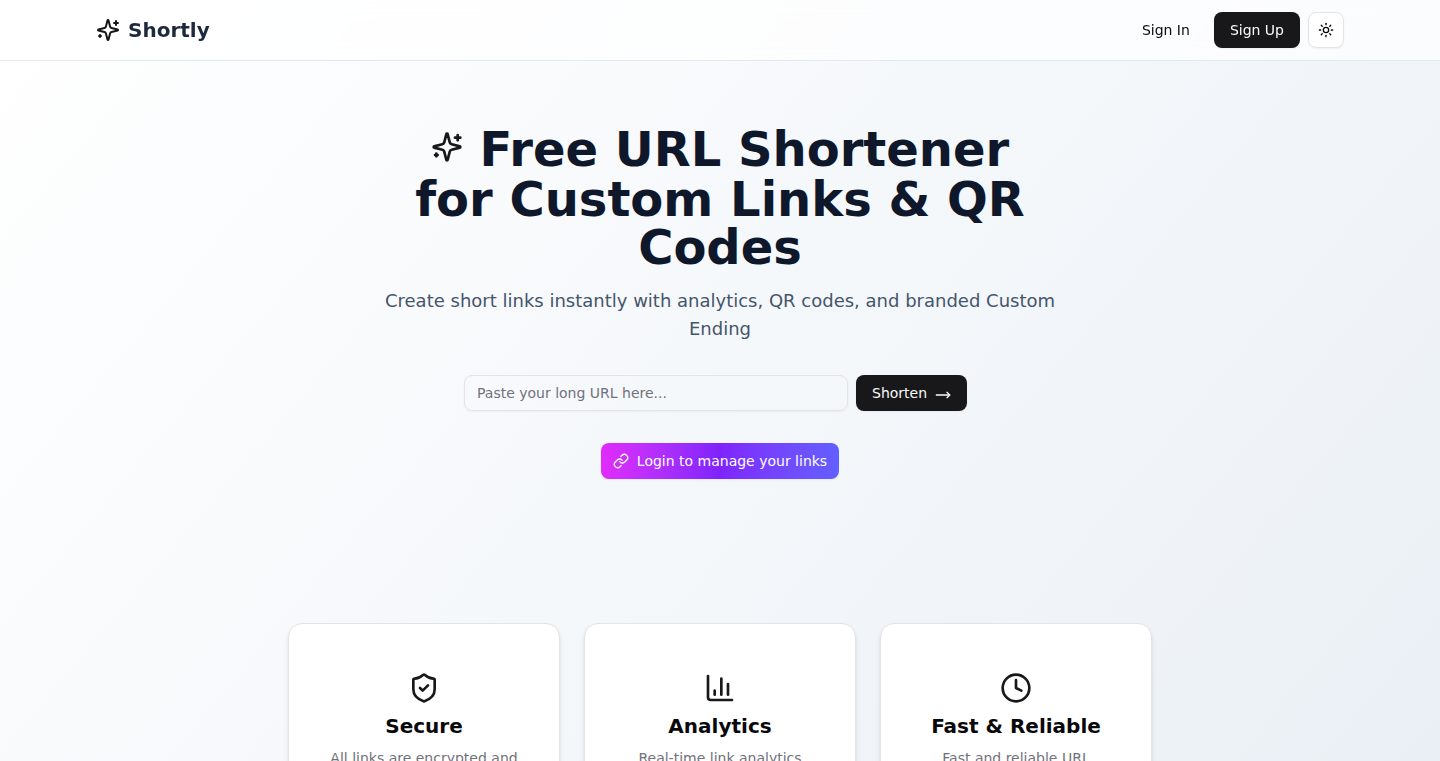
Author
parthomal
Description
Shortly is a modern URL shortener that prioritizes user privacy and clean design. Unlike many existing shorteners that track your every move, Shortly doesn't. It offers custom short links and an analytics dashboard, giving you insights into how your links are performing without compromising your privacy. The project is built using Next.js for the frontend and Go for the backend. So, this helps me because I can shorten and share links without worrying about being tracked, and it gives me valuable information about clicks and other data without sacrificing my privacy.
Popularity
Points 1
Comments 0
What is this product?
Shortly is built on the principle of creating short, memorable URLs for longer ones. It uses a backend written in Go, a language known for its efficiency, to handle the shortening and redirection process. The frontend, crafted with Next.js, provides a smooth and responsive user experience, allowing users to quickly create and manage short links. The focus on privacy is a key differentiator; it avoids collecting user data commonly found in other URL shorteners. This means it doesn't track your clicks or browsing behavior. So, this means I can use shorter links for my content without worrying about my data being collected.
How to use it?
Developers can use Shortly in several ways. They can integrate the API into their own applications to shorten URLs programmatically. This is useful for applications that need to share links on social media, in emails, or in any other context where URL length is a constraint. They can also use the analytics dashboard to track link performance, understanding where their audience is coming from and what devices they're using. The integration process involves using the provided API endpoints to send the long URL and receive the shortened version. So, this means I can quickly integrate it into my existing tools to create shorter links on the fly.
Product Core Function
· URL Shortening: It takes a long URL and creates a much shorter, easier-to-share version. This is invaluable when dealing with lengthy web addresses.
· Custom Short Links: It allows users to create personalized short links, making them more memorable and brand-friendly.
· Analytics Dashboard: Provides insights into click counts, browser information, and other data. This is useful for understanding how users are interacting with the content.
· Privacy Focus: The tool doesn't track users, safeguarding their privacy. This is a huge win for those who value privacy above all else.
Product Usage Case
· Social Media Marketing: A social media manager can use Shortly to create short links for promotional campaigns, track click-through rates, and understand which platforms generate the most engagement. This allows the marketer to focus their efforts.
· Email Marketing: In email newsletters, shortening URLs allows for a cleaner design and helps avoid overly long links that might be cut off. The analytics also help to track which links were clicked most.
· Content Sharing: A blogger can use Shortly to share content across multiple platforms, track the performance of each link, and see where the audience is coming from. This allows the blogger to improve the content strategy.
62
SandBlast: A Physics-Driven Block Puzzle Game
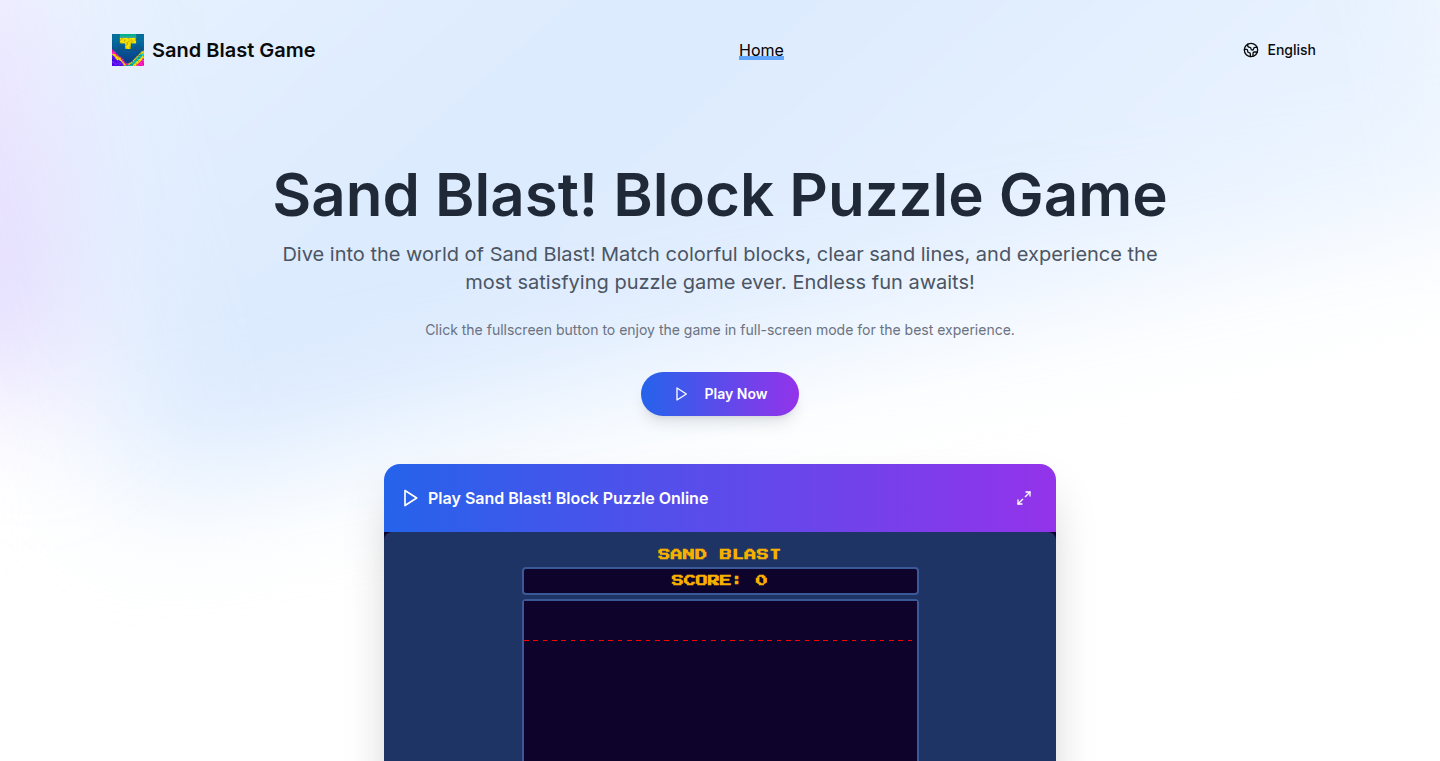
Author
Kevin_Guo
Description
SandBlast is a visually appealing puzzle game built on a physics engine. Players manipulate colorful blocks in a sandbox environment, aiming to match and 'blast' them away. The core innovation lies in its use of a physics engine to simulate block interactions, creating satisfying chain reactions and dynamic gameplay. This addresses the challenge of creating engaging puzzle mechanics with realistic physical behavior, offering a unique and rewarding experience.
Popularity
Points 1
Comments 0
What is this product?
SandBlast is a puzzle game where you drop, match, and explode colorful blocks in a sand-like environment. It uses a physics engine to simulate how blocks interact, making everything feel realistic. The innovation is using physics to drive the puzzle solving: Matching blocks causes them to 'blast' away, creating chain reactions and offering unique puzzle challenges. This is different from many puzzle games that just use simple matching logic. So this is helpful because it provides a dynamic and visually appealing experience, moving beyond static game mechanics.
How to use it?
As a player, you would simply interact with the game's UI to drop blocks, match colors, and trigger 'blasts'. For developers, this concept could be applied by using a physics engine in your game, such as Unity, to develop the core mechanics of the game, creating other physics-based puzzle games with unique gameplay. Developers can use the project as an example of integrating a physics engine and developing engaging game mechanics. So this is useful because it offers a new approach to puzzle game development that emphasizes dynamics and realism.
Product Core Function
· Physics-based Block Interaction: The core feature is the simulation of blocks using a physics engine. This allows for realistic collisions, gravity effects, and chain reactions when blocks are matched. So this is useful because it enhances the gameplay with realistic block behaviors and satisfying explosion effects.
· Match-and-Blast Mechanics: Matching blocks triggers an explosion or blast effect, clearing the matched blocks and potentially creating chain reactions with adjacent blocks. This feature is central to the game's core gameplay. So this is useful because it provides a unique and rewarding gameplay mechanic that rewards skillful matching and strategic planning.
· Sandbox Environment: The game provides a sand-like environment where blocks can freely interact. This allows players to experiment with different strategies and see the results of their actions in a dynamic way. So this is useful because it increases player engagement and allows users to explore different gameplay strategies.
· Visual Appeal: The game uses colorful blocks and satisfying visual effects to engage players. So this is useful because it makes the game more engaging and visually pleasing.
Product Usage Case
· Puzzle Game Development: A developer could use the 'SandBlast' as inspiration to design their own physics-based puzzle game. They could learn how to build the blocks, simulate their physics, and create rules for matching and clearing. This is helpful if you want to create a unique puzzle game with satisfying interactions.
· Game Prototyping: Using a physics engine, game designers can quickly prototype and test different block behaviors and interaction effects to see what creates the most engaging and fun experiences. This is useful because it accelerates the game development process.
· Educational Projects: Game developers can use this framework in educational scenarios to demonstrate physics principles or create learning games related to the matching and explosion process in the game. This is useful because it provides a fun and interactive way to learn about physics.
63
What Games Play? A Nostalgic Retro Game Portal
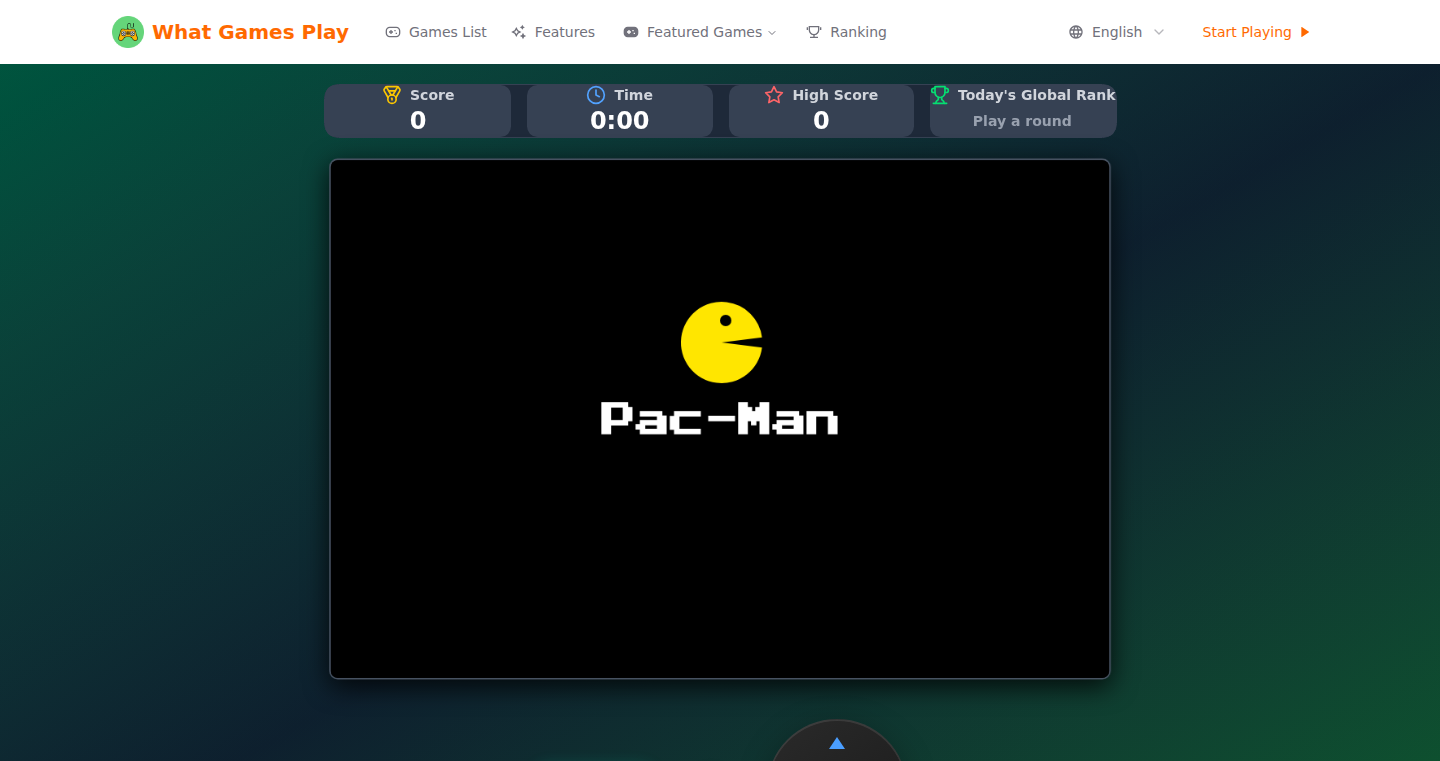
Author
harperhuang
Description
This project is a simple web-based portal offering classic games like Pac-Man and Battle City. The core technical innovation lies in its efficient implementation, likely using HTML5 and JavaScript for cross-platform compatibility. It provides a convenient and accessible way to enjoy classic games on any device with a web browser. This addresses the technical problem of making retro gaming accessible without requiring complex installations or hardware. So this lets me play my favorite old games anywhere.
Popularity
Points 1
Comments 0
What is this product?
This is a web application that brings classic arcade games to your browser. It probably uses technologies like HTML5, CSS, and JavaScript to create the game interfaces and handle user input. The innovation is the combination of these web technologies to emulate classic gaming experiences, making them readily available on almost any device. So, it's like a digital arcade that you can access anywhere.
How to use it?
Developers can utilize the source code (if available) to understand game development principles, especially the implementation of classic game logic. They can study how inputs are handled, how graphics are rendered, and how game loops are managed within a web browser environment. It's a great example for learning front-end development and game design. So, if you're learning to code, this can teach you how games are built.
Product Core Function
· Game Rendering: The core function is to render the game graphics within the browser, likely using HTML5's canvas element. This function allows users to see and interact with the game environment. This is important because it provides the visual output.
· Input Handling: This handles user inputs, such as keyboard presses or touch events. This function is essential to provide the control that a user can directly interact with the game. For instance, players can control the characters or make moves.
· Game Logic: The project includes the game logic, encompassing character movements, collision detection, scoring, and other game rules. This function defines the game's behavior and the user's interaction with the game. This creates a fun and enjoyable game experience.
· Cross-Platform Compatibility: This allows the games to be playable on any device with a web browser. This function is beneficial for expanding user access to the game.
· User Interface: A simple user interface probably handles menu navigation, game selection, and potentially score keeping. This function is valuable because it provides the necessary tools to interact with the game and have a good user experience.
Product Usage Case
· Educational Example: Developers can study this project to learn about game development principles and see how classic game mechanics can be replicated in a web environment. So, it is a great source of learning materials for those new to game development.
· Retro Game Adaptation: The project can be adapted as a template to create more web-based versions of other retro games, utilizing the same fundamental techniques. So, you can learn by example, and then expand the idea to include more games.
· Mobile Game Development: This project gives a good example of how to write mobile games using just the web browser, because the game is optimized to play in web browsers in smartphones and other mobile devices. This would be great for mobile game developers.
64
LaunchVault: The Indie Hacker's Launchpad

Author
Scofieldfee
Description
LaunchVault is a platform designed to help independent developers and small startups showcase their projects and get early feedback. It focuses on providing a simple, clean launch page without the noise of algorithms or follower counts. This innovative approach allows projects to gain visibility based on what they actually build, rather than how many followers they have. It solves the common problem of amazing tools going unnoticed due to the limitations of other launch platforms and the rapid turnover of social media.
Popularity
Points 1
Comments 0
What is this product?
LaunchVault is essentially a digital storefront for indie projects. It allows developers to create a dedicated launch page, collect sign-ups with an optional waitlist, and get discovered based on the actual projects being built. Instead of relying on complicated algorithms that decide who sees your project, LaunchVault focuses on curated discovery, meaning people can actively explore what’s new and interesting in the indie development space. So this means more eyeballs on your project, and less time wasted fighting the algorithm.
How to use it?
Developers can create a launch page for their project on LaunchVault, providing details about their product, a call-to-action (like signing up for a waitlist), and relevant information. It works as a standalone page, or can be easily integrated into an existing website. The simple setup makes it easy to quickly present your project to the world. For instance, imagine you just built a new tool to automate your social media posts. You can create a launch page on LaunchVault to describe its features, show screenshots, and let potential users sign up to get early access. This way, you get focused feedback from people who are genuinely interested. So this means it's super simple to use, no coding knowledge required, and you can start getting feedback on your project immediately.
Product Core Function
· Clean Public Launch Page: Provides a dedicated space to showcase your project's features, benefits, and goals, making it easy for potential users to understand what you offer. So this means you can tell your story and make a good first impression.
· Optional Waitlist or Call-to-Action: Enables developers to build anticipation and gather interested users before the official launch, capturing early adopters and building a user base. So this means you can build your user base, and gather pre-launch support.
· Curated Discovery: Focuses on showcasing projects based on their value, ensuring genuine interest and feedback from users. So this means your project can be discovered by the right people, without the noise of the algorithm.
· No Algorithm, No Follower Count, No Noise: Avoids the distractions of social media, offering a focused platform for project sharing and discovery. So this means you don't have to worry about popularity contests or getting lost in the crowd.
Product Usage Case
· A developer builds a new open-source library for game development and uses LaunchVault to introduce it, including documentation, examples, and a link to their GitHub repository. They can collect sign-ups for early access and gather feedback from the game development community. This showcases the library's capabilities and lets developers use and test it before the official release. So this means a developer can get feedback to help with improvements and make the library better.
· An indie developer creates a new productivity tool and launches it on LaunchVault. They include a clear description of the tool's features, screenshots, and a call-to-action to sign up for a free trial. This helps attract potential users and get feedback on the tool’s user experience. The launch page acts as a dedicated hub where people can learn about the tool and try it out. So this means you can get your tool in front of users and they will have something to test and experiment with.
65
Kioshun – Blazing-Fast Go Cache with Sharding
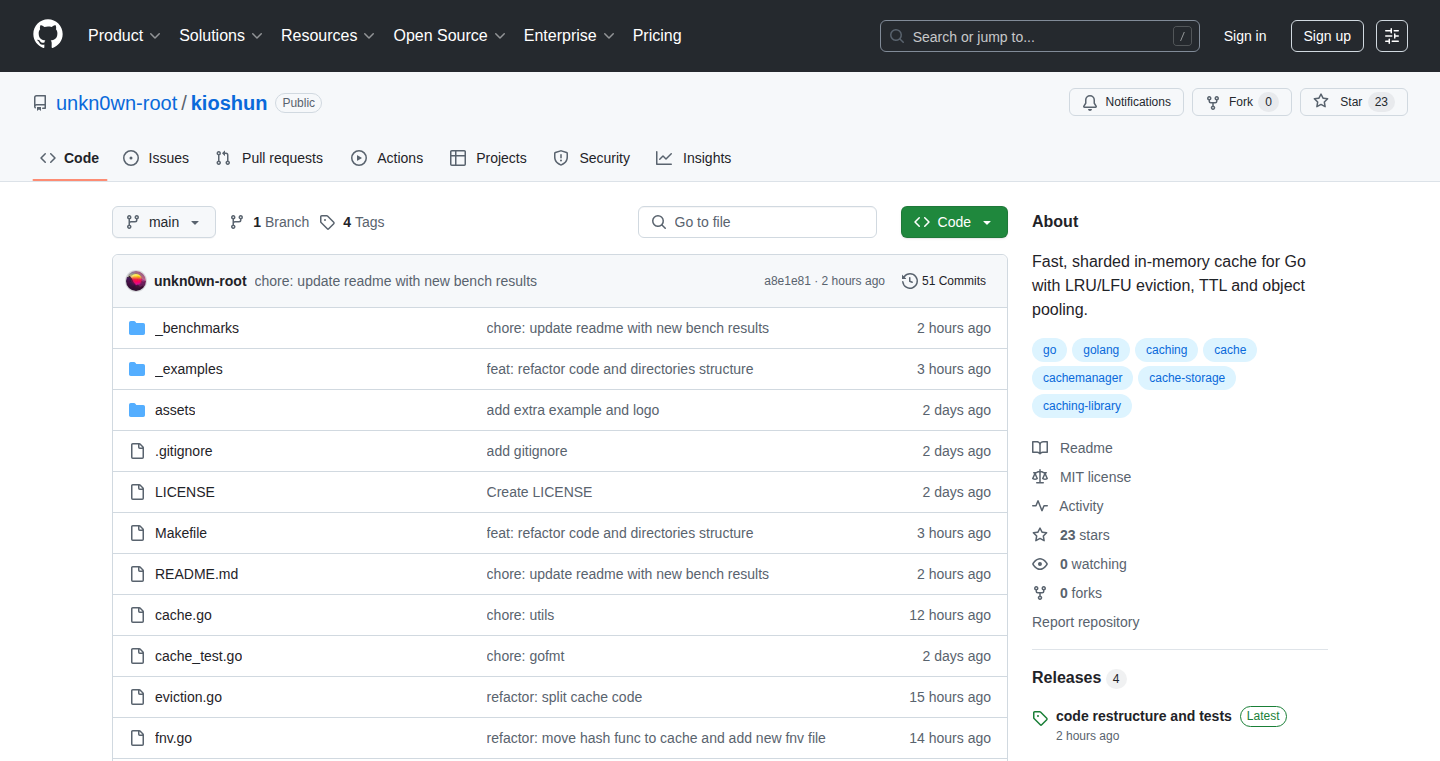
Author
unkn0wn_root
Description
Kioshun is a high-performance, in-memory caching system specifically designed for the Go programming language. It tackles the common problem of slow data retrieval by storing frequently accessed data in RAM, allowing for extremely fast read access. The innovation lies in its sharding architecture, which divides the cache into smaller, independent segments (shards). This dramatically improves performance by reducing contention when multiple goroutines (Go's concurrent execution units) access the cache simultaneously. So, it's essentially a super-fast data lookup system, preventing your application from getting bogged down fetching data repeatedly. This is useful because it will significantly speed up your Go applications, especially those handling a lot of data retrieval.
Popularity
Points 1
Comments 0
What is this product?
Kioshun is built on the principle of in-memory caching. It stores data (like frequently used results from database queries or API calls) directly in the server's RAM. The 'sharding' part is its secret sauce: it splits the cache into multiple independent parts (shards). When you want to get something from the cache, Kioshun quickly figures out which shard to look in, minimizing the chance that multiple parts of your code (goroutines) are competing for the same piece of memory, which leads to performance bottlenecks. So, it’s like having multiple, super-organized storage units to find your data incredibly fast. The project is written in Go, leveraging its concurrency features.
How to use it?
Developers integrate Kioshun into their Go applications by importing the Kioshun library and creating a cache instance. They then store data (key-value pairs) in the cache using functions like `Set` and retrieve data using `Get`. Kioshun automatically handles the sharding and data management in the background, ensuring the application benefits from its high performance. A common use case is caching database query results to reduce database load and speed up response times. You would add it to your Go project via the `go get` command, import it into your code, and then use the provided API to store and retrieve data. The design makes integration very simple; it's designed to be a drop-in solution.
Product Core Function
· Fast Data Retrieval: Kioshun uses an in-memory cache, which means it stores data in RAM for extremely rapid access. This speeds up your application's response times significantly. So, if your application frequently accesses the same data, Kioshun can retrieve it almost instantaneously, which is beneficial if the data is slow to fetch from an external service such as a database or an API.
· Sharding for Scalability: The sharding architecture allows Kioshun to handle many concurrent requests without performance degradation. When multiple parts of your code (goroutines) are trying to use the cache at the same time, they typically won't be competing for resources. This enhances the application's performance and robustness, especially under heavy load. This feature helps if you expect a large number of requests from users.
· Key-Value Storage: The cache operates on a simple key-value storage model. You store data with a specific key and can later retrieve it using that key. This straightforward approach makes it simple to use the cache and it will work in pretty much all situations where you want to avoid repetitive data access.
· Concurrency-Safe Operations: Kioshun is designed to handle concurrent access from multiple goroutines safely. It uses internal locking mechanisms to manage access to the cache data, preventing data corruption and ensuring consistent results. This is critical for Go applications, which make heavy use of concurrency. So, if your application relies on many concurrent processes, you can still safely use the cache.
Product Usage Case
· Caching Database Query Results: An application frequently queries a database for user profiles. Instead of querying the database every time, Kioshun caches the profiles, allowing the application to quickly retrieve the profile data from the in-memory cache. This reduces database load and accelerates profile loading times. So, it benefits applications with frequent database access, preventing them from slowing down.
· Caching API Responses: An application interacts with an external API. Kioshun caches the API responses, allowing the application to serve the data without making repeated calls to the API. This minimizes API call costs and improves response times. It is useful for applications that work with external APIs, decreasing latency and cost of API usage.
· Session Management: An application uses Kioshun to store user session data, allowing fast access to session information without having to go back to a database on every request. This improves user experience by reducing login times and speeding up navigation within the application. Therefore, if your application requires handling user sessions, it will give a performance boost.
· Content Delivery Network (CDN) Edge Caching: This is a more advanced use case where Kioshun could be employed on edge servers to cache dynamic content closer to the end-users. This will reduce latency and improve the performance of websites and applications. This is useful if you want to optimize the content delivery performance for a global audience.
66
Wolflux: Real-time AI-powered Stock Insights Platform
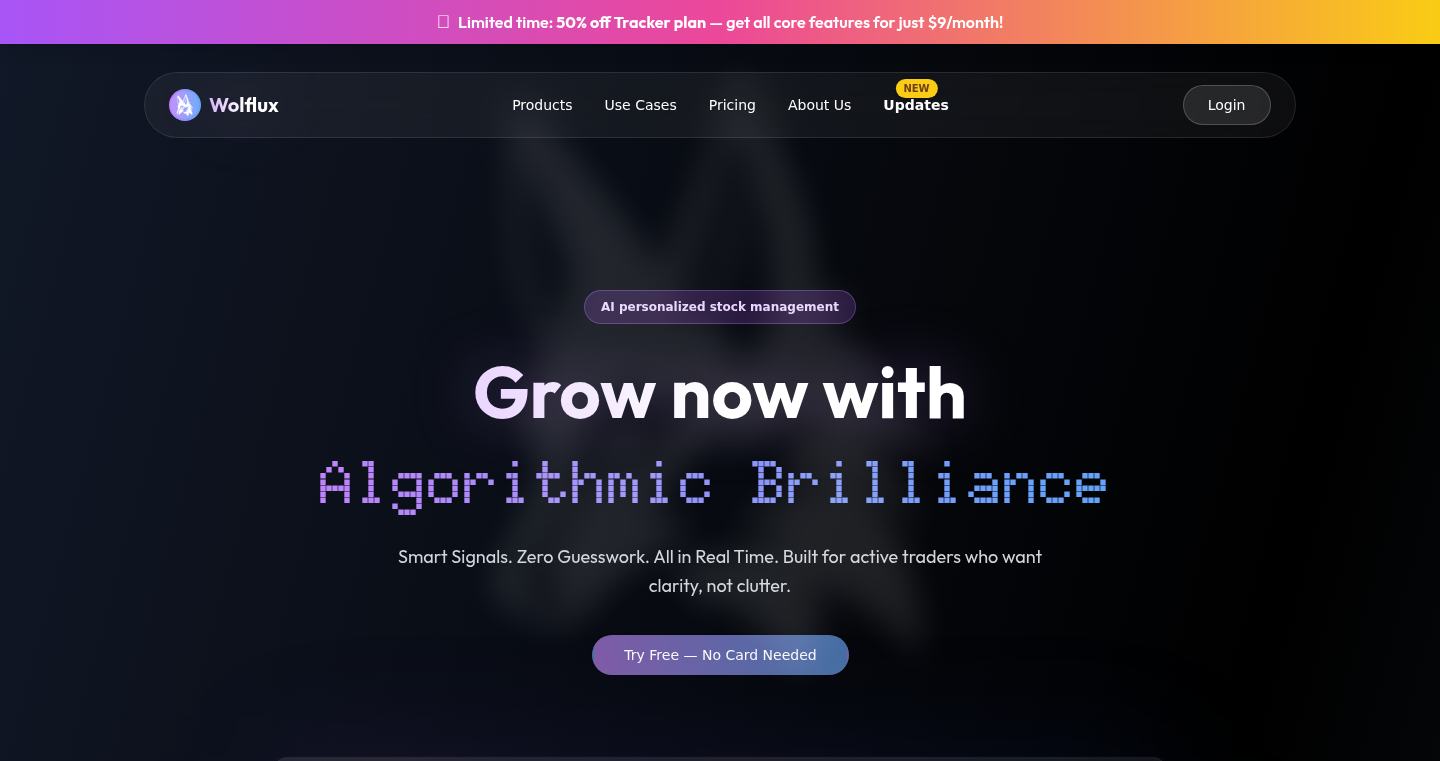
Author
nesh-html
Description
Wolflux is a platform that uses Artificial Intelligence (AI) to provide real-time insights for stock trading. It combines various AI models like Long Short-Term Memory networks (LSTMs), K-Nearest Neighbors (KNN), Support Vector Machines (SVM), and logistic regression with traditional technical analysis. This hybrid approach analyzes stock data 24/7 and gives users clear Buy/Sell/Hold signals with confidence scores, technical indicators, sentiment analysis, and risk modeling. It aims to help traders make informed decisions without being overwhelmed by complex data. So, it helps you make smarter investment choices by leveraging the power of AI.
Popularity
Points 1
Comments 0
What is this product?
Wolflux is like having an AI assistant for your stock trading. Instead of just looking at charts, it analyzes a lot of data in real-time using a mix of AI models and classic trading analysis. The AI models are good at understanding patterns in the data to predict future stock prices. This system gives you easy-to-understand recommendations (Buy, Sell, Hold) so you can make faster, more informed decisions. So, it's a smart tool that gives you a clear picture of what's happening with a stock.
How to use it?
Developers can use Wolflux in several ways. You could integrate the platform's signals into your own trading bots or create custom dashboards that visualize the insights. This is possible using its API (Application Programming Interface). It provides a real-time data feed, which developers can use to build their own financial tools or enhance existing ones. So, you can create apps or integrations that improve how people make investment choices.
Product Core Function
· Real-time Buy/Sell/Hold signals: These signals, based on the AI's analysis, tell you whether to buy, sell, or hold a stock. The value is clear recommendations to help you make trading decisions immediately. For example, a signal might suggest buying a stock if the AI predicts its price will increase.
· Confidence scores: These scores show how sure the AI is about its recommendations. They help you understand the reliability of the signals. This is useful because it helps you manage risk and know how much weight to give each piece of advice.
· Technical indicators: The platform provides standard technical indicators like RSI and MACD that traders use to analyze stocks. This provides traders with familiar tools to support their decisions. So, you can quickly see data that experienced traders rely on.
· Sentiment analysis: It analyses news and social media to get an idea of what people are thinking about a stock. This helps you understand what might be impacting a stock's price. This provides you with an understanding of broader market forces.
· Monte Carlo risk modeling: This uses simulations to predict potential outcomes and evaluate risks. This helps you better understand and manage the possible risks. For example, you can assess the risk of different investment scenarios.
· Watchlist feature: The Watchlist feature allows users to track stocks of interest and receive insights for the specified stocks, making it easier for users to monitor and respond to market changes. This makes it easier to track the stocks you are interested in.
Product Usage Case
· Developing a trading bot: A developer can use the Wolflux API to feed real-time signals into a trading bot, automating the buy/sell process based on AI recommendations. This reduces the time required for manual analysis. The bot can then automatically execute trades based on the platform's signals.
· Building a stock analysis dashboard: A developer could create a custom dashboard displaying Wolflux's real-time signals, confidence scores, and other indicators, providing users with a comprehensive view of stock insights. This allows users to quickly visualize key information.
· Integrating into existing financial applications: Developers can integrate Wolflux's features into existing trading platforms, enriching the tools available to their users. This creates a more complete trading experience.
· Creating an investment advisory tool: Developers can leverage the AI predictions to create a tool that recommends personalized investment strategies to users. This provides data-driven recommendations to users.
67
Supadex: Supabase Mobile Dashboard

Author
guiolmar
Description
Supadex is a mobile dashboard built specifically for Supabase projects. It allows developers to monitor and interact with their Supabase databases and other services directly from their mobile devices. The innovation lies in providing a streamlined mobile interface for Supabase, eliminating the need to constantly access a desktop for essential tasks. This solves the problem of needing on-the-go access and control over Supabase projects.
Popularity
Points 1
Comments 0
What is this product?
Supadex is a mobile application that connects to your Supabase backend. It uses Supabase's API to let you view and manage data, check performance metrics, and trigger functions. It's like having a mini-control panel for your database, but on your phone. The innovation is in its mobile-first design, making Supabase management easier when you're away from your computer. So this is useful for keeping an eye on things, even when you're not at your desk.
How to use it?
Developers can use Supadex by entering their Supabase project API keys and URL into the app. It then connects to their Supabase instance, allowing them to browse tables, view data, and execute custom functions. Supadex integrates with Supabase's API, meaning no significant changes are required to your existing Supabase setup. So this means that you can quickly start monitoring your app’s backend data from your phone, wherever you are.
Product Core Function
· Data Browsing: View the contents of your database tables directly on your mobile device. This is valuable because it allows you to quickly check data integrity and confirm updates from anywhere.
· Real-time Data Updates: Get live updates of your database's data as changes happen. This function is extremely useful for tracking user activity or reacting to real-time events.
· Custom Function Execution: Trigger Supabase functions directly from the app. This provides a simple way to run server-side code like data processing or notifications.
· Performance Monitoring: Track key metrics about your Supabase project, like database load and API usage. This gives you insights into your app's performance and helps you catch issues early.
· Mobile-Optimized Interface: Provides a user-friendly, touch-friendly interface designed specifically for mobile devices, making interaction easier than using a desktop-based dashboard on a small screen. This means an improved user experience while checking on your project.
Product Usage Case
· E-commerce App Monitoring: A developer uses Supadex to monitor sales data and inventory levels in real-time. They can quickly respond to low stock alerts or unexpected sales spikes. This helps keep everything running smoothly, even while traveling.
· IoT Device Data Inspection: A developer checks data coming from IoT devices via their Supabase backend, directly from their phone, ensuring sensors and devices are functioning correctly. So the developer can make sure everything works correctly without needing to be at the office.
· Social Media App Management: A developer can use Supadex to track user activity, post statistics, and check user engagement metrics. This helps them stay up-to-date with project happenings at all times.
· Game Development Backend Monitoring: A game developer checks player stats, virtual currency, and game server status remotely. This allows for quick responses to issues or server load concerns, even when away from their computer.
68
120 AI Chat - Unified AI Model Interface
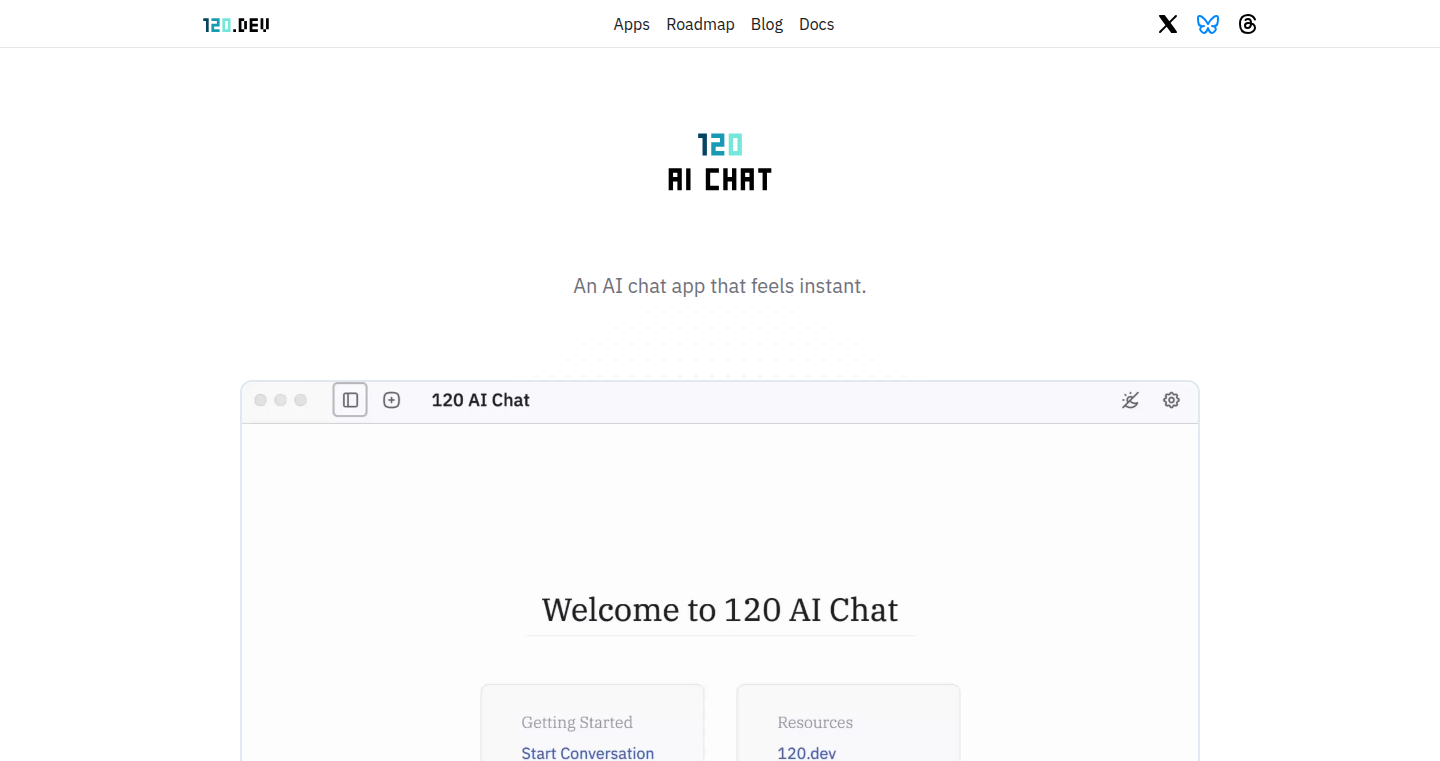
Author
120-dev
Description
120 AI Chat is a native cross-platform application designed to interact with multiple AI models like OpenAI and Anthropic, as well as local models using Ollama. It simplifies the experience of using various AI services by providing a clean, fast interface with features like multi-threaded chat, customizable settings, and message editing tools. The project's innovation lies in its ability to integrate different AI models into a single, easy-to-use application, offering developers and users a unified access point to various AI capabilities.
Popularity
Points 1
Comments 0
What is this product?
120 AI Chat is essentially a user-friendly interface for interacting with different AI models. Think of it as a universal translator for AI. It allows you to use AI from OpenAI and Anthropic (using your own API keys) and also run AI models locally on your computer using a tool called Ollama. This means you can experiment with different AI models, customize how they behave (with settings like context limit and temperature), and manage your conversations easily. The innovation here is combining all these different AI services into one single application, making it easier to access and manage them.
How to use it?
Developers can use 120 AI Chat by downloading the application and entering their API keys for OpenAI and Anthropic. They can also download and run local models through Ollama (which the application also supports). This allows developers to experiment with different AI models without the complexity of using command-line tools or different APIs. The interface includes a chat-style format, enabling users to branch off conversations, edit their messages, and manage their AI interactions. For example, it can be easily integrated into a developer’s workflow for code generation, debugging, or brainstorming purposes, thus streamlining their AI usage.
Product Core Function
· Multi-model support: The application supports both cloud-based AI services (OpenAI, Anthropic) and local AI models (via Ollama). This is valuable because it provides users with flexibility, allowing them to choose the best AI model for their needs, considering factors such as cost, privacy, and performance. So this is useful for developers who want to use the AI model that best suits their needs, whether that's GPT models for generating code or open-source models for privacy.
· Multi-threaded chat: This allows users to branch off conversations without losing context. This is valuable because it lets users explore different ideas and scenarios in parallel. Developers can use this feature to test different approaches to a coding problem or explore several creative concepts at once.
· Customizable chat settings: Users can control various parameters such as context limit, temperature, and penalties. This is valuable because it offers fine-grained control over the AI's output. Developers can tweak these settings to optimize the AI's responses for specific tasks, such as getting more creative outputs or more accurate code suggestions.
· Message tools: Includes features to edit, delete, and copy messages. This is valuable because it improves the usability of the chat interface, allowing users to refine their prompts and manage their conversations. Developers can correct their prompts or save outputs easily, making their interactions with the AI more efficient.
· Cross-platform Compatibility: Native support for macOS, with Windows and Linux versions coming soon. This is valuable because it provides flexibility and enables developers to use the tool on their preferred operating system, making it accessible for a wider range of users.
Product Usage Case
· Code Generation and Debugging: A developer can use 120 AI Chat to ask an AI model to generate code snippets or debug existing code. By easily switching between different models, the developer can compare their outputs and find the best solution for their needs. So you can get help with your code from different AI sources without any setup.
· Brainstorming and Idea Generation: A user can use 120 AI Chat with multi-threaded chats to explore different ideas simultaneously. For example, a marketing professional could use different AI models to generate different marketing campaign ideas. So you can generate creative ideas quickly and easily.
· Content Creation: A content creator can use 120 AI Chat to generate different versions of content (e.g., articles, social media posts) by using different AI models or by tweaking the settings. So you can create many different types of content quickly.
· Learning and Experimentation: Developers can use this to explore and understand various AI models by experimenting with different settings and models. They can also use it to learn how different models respond to prompts. So you can easily explore and learn how to use different AI models effectively.
69
Userpitch: Voice-First Candidate Showcase

Author
wdharmon
Description
Userpitch is a platform designed to revolutionize the job application process by allowing candidates to showcase themselves through short, voice-based elevator pitches. It addresses the frustration of resumes getting lost in the shuffle on platforms like LinkedIn. The core innovation lies in using voice to highlight a candidate's personality and potential, moving beyond traditional, often impersonal, resume formats. This approach aims to foster a more human and transparent hiring process. So this can help you stand out from the crowd and make a stronger first impression.
Popularity
Points 1
Comments 0
What is this product?
Userpitch is a platform that lets job seekers create and share short audio recordings (elevator pitches) about themselves. Instead of just a resume, candidates can express their personality and skills through their voice. It’s built to solve the problem of generic job applications getting lost in the system and to give candidates a chance to shine. The technology allows users to record, upload, and share audio profiles, offering a fresh perspective for both job seekers and recruiters. So this allows for a more personal and engaging way to present your candidacy.
How to use it?
For job seekers, Userpitch offers a way to record and upload a short audio clip (like a voice-based resume). For recruiters, it provides a space to find candidates who are willing to present themselves through voice, thus cutting through the noise and getting a better understanding of who candidates are. The platform can be integrated into job applications, company career pages, or even used as a supplement to a traditional resume. So this gives you a chance to be heard in a crowded job market.
Product Core Function
· Voice-Based Profiles: Users record short audio pitches to introduce themselves and their experiences. This brings a human element to the application, allowing candidates to show off their personality and communication skills. So this helps you make a more memorable first impression and showcase your communication skills.
· Candidate Discovery: Recruiters can easily search and listen to candidate pitches. It simplifies the initial screening process by allowing for quicker and more personal evaluations. So this helps recruiters find the right people more efficiently.
· Platform for Collaboration: The platform encourages interaction between candidates and recruiters. It provides a place for feedback and direct communication, promoting transparency. So this fosters a more direct and open communication channel.
· Elimination of Corporate Jargon: The platform encourages users to be authentic and human. It helps to avoid generic buzzwords often found in resumes. So this helps you to showcase your authentic self.
Product Usage Case
· Job applications: A candidate can record a Userpitch and provide a link within their resume or cover letter, giving potential employers a quick and personal overview. For example, a software developer could share a Userpitch about their project experience and how they solve problems. So you can add a layer of personality to your application and make yourself stand out.
· Networking: Share your Userpitch on LinkedIn or other social media platforms. It can act as an engaging 'about me' introduction for networking or personal branding. This is great for those looking to build connections in the tech industry. So this allows you to make a great first impression in the digital space.
· Internal Communication: Recruiters and HR professionals can use Userpitch to present and communicate with the team. So this can be used to share updates and ideas in a clear and engaging way.
· Company career pages: Companies can embed Userpitch profiles to show their company culture and highlight employee experiences. So this can help attract the right candidates and show the company culture.
70
STEMExplain: Unified UI for Multi-Mode STEM Explanations
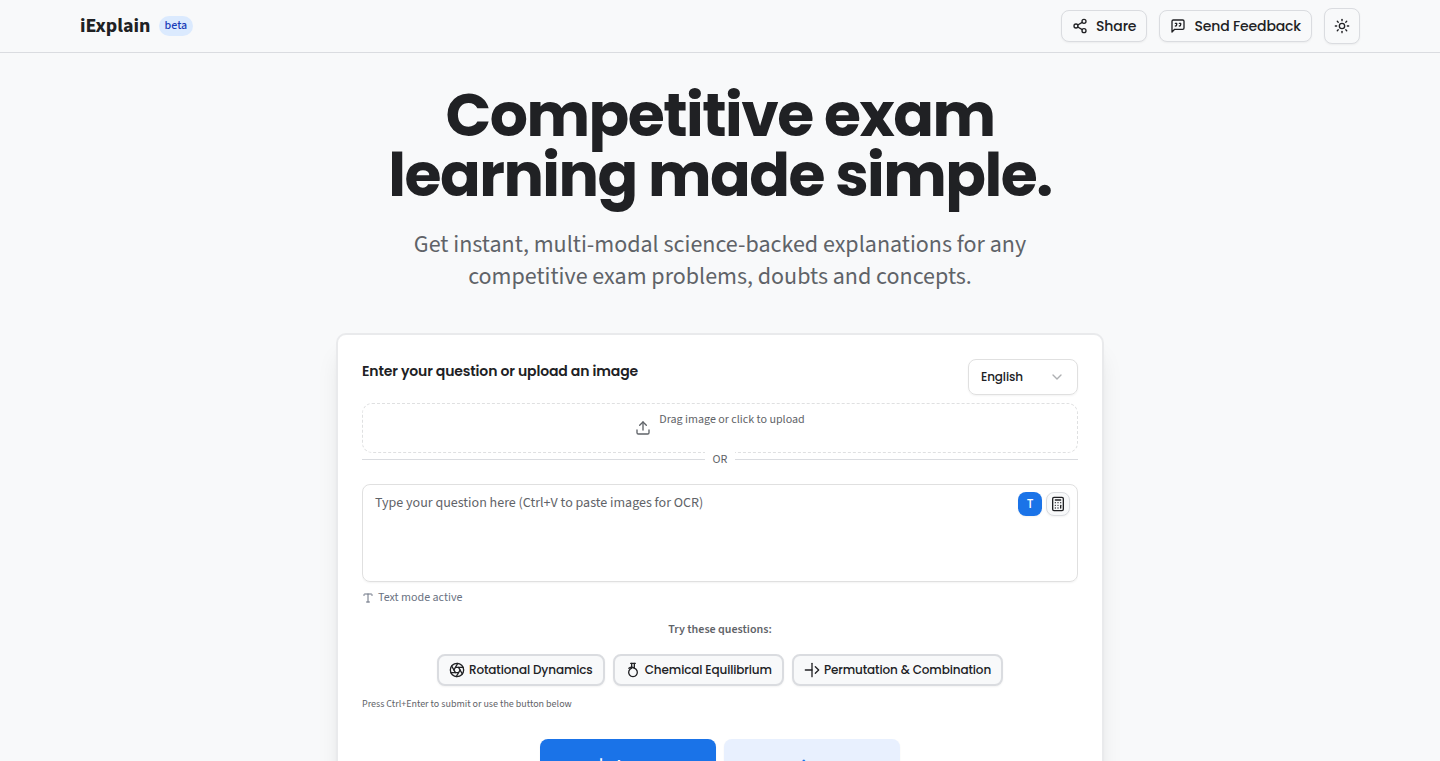
Author
roninthesky
Description
STEMExplain is a web application that presents explanations for Science, Technology, Engineering, and Mathematics (STEM) topics in a unified user interface. It offers multiple modes of explanation, including 'Explain Like I'm Five' (ELI5), diagrams, examples, and real-world applications. The key innovation lies in its dynamic and interactive nature, allowing users to expand explanations on-demand by right-clicking on any section. This approach fosters deeper understanding and exploration of complex concepts. So this lets you understand hard concepts by explaining it in different ways.
Popularity
Points 1
Comments 0
What is this product?
STEMExplain is a learning tool that brings various explanation styles for STEM topics into a single view. It uses a custom-built UI to organize ELI5 explanations, visual aids (diagrams), concrete examples, and real-world applications. When you right-click on any explanation, you can expand to find even more detailed information, allowing you to delve deeper into a topic. This approach leverages the power of different learning styles and focuses on making complex topics accessible. So this helps you learn STEM topics in a way that suits your learning style, and lets you explore different levels of detail.
How to use it?
Developers can integrate STEMExplain into their own educational projects or platforms. Imagine a developer building a physics course - they could embed STEMExplain to provide detailed explanations, examples, and visual aids directly within the course content. The API would allow custom integration of explanations for specific topics. STEMExplain also provides developers with an interactive component that they can include in their projects. So if you are building educational apps or tools, you can use this to provide comprehensive explanations and interactive explorations.
Product Core Function
· Multi-Mode Explanations: It provides explanations in multiple formats (ELI5, diagrams, examples, real-world usages), catering to different learning styles. This is useful because it increases understanding of concepts for users who grasp things differently.
· Interactive Deep Dive: Right-click functionality allows users to expand explanations, allowing for deeper exploration of any topic. It helps you to keep expanding the concept by offering different layers of detail. The advantage is that users can control the depth of their learning.
· Unified UI: The project presents everything within a single user interface, making it easy to navigate and understand the different explanation modes. This simplifies the process of learning and reduces the cognitive load of switching between sources. So this ensures that the user is not overwhelmed with multiple windows to learn a concept.
Product Usage Case
· Educational platform integration: Developers can embed STEMExplain into their platforms to provide interactive explanations for their students. For example, a coding bootcamp can use it to provide a high-level overview and explain how the concepts work in simple terms.
· E-learning course enrichment: Content creators can use STEMExplain to augment their course material, adding visual aids, examples, and real-world scenarios that deepen student comprehension. For example, a course on machine learning can be complemented by STEMExplain's explanations of the underlying math.
· Personalized learning apps: Individuals can use it to build tools for specific STEM topics that provide a tailored learning experience. For example, creating a tool that focuses on the physics of orbital mechanics.
71
SimRepo: Vectorized Repository Discovery for GitHub
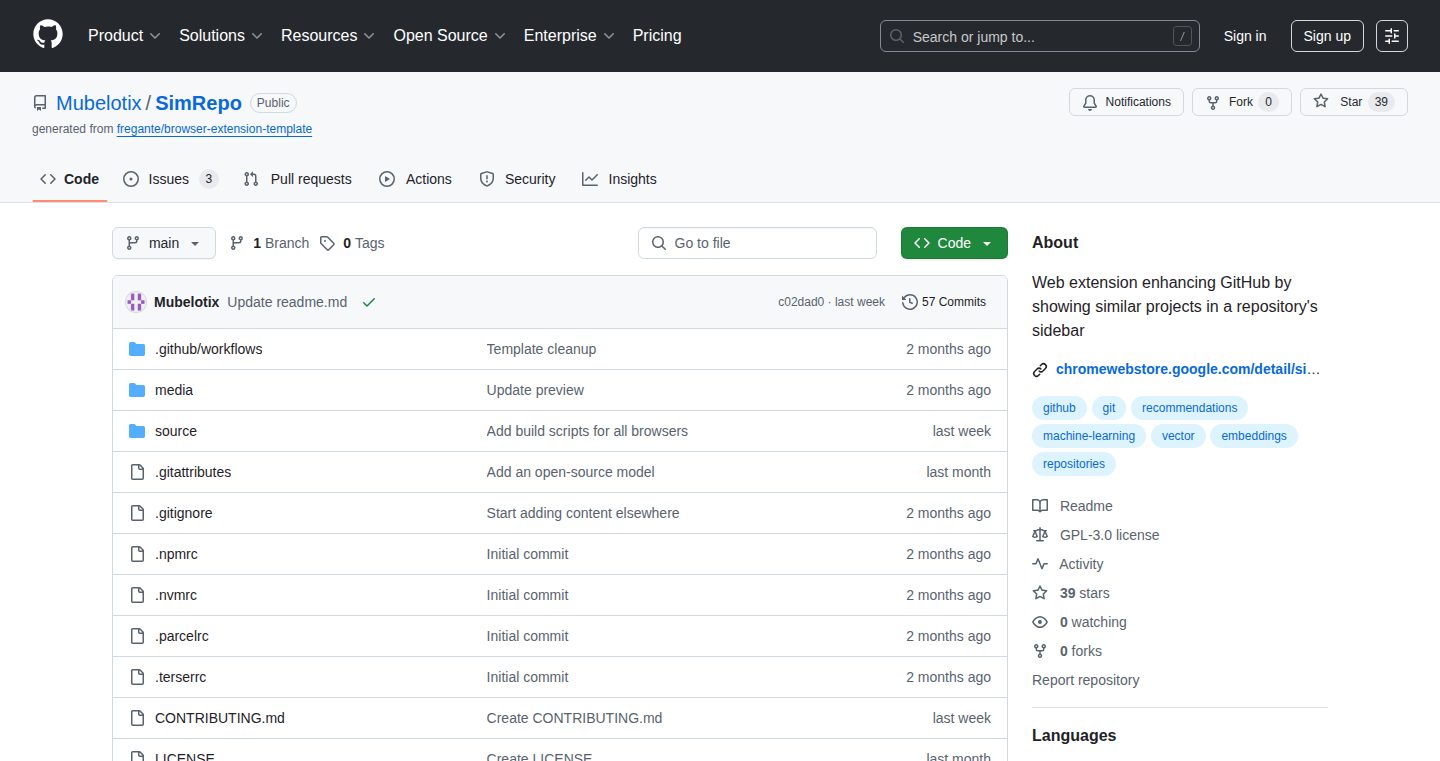
Author
Mubelotix
Description
SimRepo is a browser extension that enhances GitHub repo pages by adding a sidebar panel showing similar repositories. It uses a machine learning model, specifically a vectorized model trained on GitHub star data, to understand relationships between projects. This innovative approach helps developers discover related projects quickly and efficiently while browsing GitHub. It solves the common problem of finding relevant projects beyond basic search functionalities, leveraging the collective knowledge embedded in the 'stars' users give to projects. So this allows me to find cool new projects faster and easier.
Popularity
Points 1
Comments 0
What is this product?
SimRepo is a browser extension that understands which GitHub repositories are similar to each other. It does this by analyzing the “stars” given to projects on GitHub. The extension uses this data to create a mathematical representation of each project, allowing it to find projects that are similar. The underlying technology is a 'vectorized model', which essentially turns each repository into a point in a high-dimensional space. Repositories closer to each other in this space are considered similar. So, it helps you discover similar projects based on what people have liked before.
How to use it?
After installing SimRepo in your browser (Chrome or Firefox), it integrates directly into GitHub. When you visit a repository page with over 150 stars, a sidebar will appear showing a list of similar repositories. This means you can find related projects without leaving the page you are on. Developers can directly use it to discover other projects to get inspiration or to learn from the source code. So I can discover new technologies or libraries without leaving the GitHub page.
Product Core Function
· Similar Repository Recommendations: The core function is to recommend similar repositories based on a vectorized model trained on GitHub star data. This helps users find relevant projects they might not discover through standard search methods. So I can easily find projects that are similar to what I am already looking at.
· Real-time Integration: The extension integrates directly into GitHub pages, providing instant recommendations as users browse repositories. This eliminates the need for separate searches or switching between tabs. So I can get suggestions while I am browsing my favorite repos.
· Open Source and Privacy-Focused: SimRepo is fully open-source and doesn't track user data, ensuring privacy and transparency. This builds trust and allows the community to contribute to the project. So I can contribute to the project and my data is protected.
· Contextual Discovery: The recommendations are context-aware, meaning they change based on the specific repository being viewed. This ensures the suggestions are highly relevant. So I get tailored suggestions based on the current project I am exploring.
Product Usage Case
· Discovering Related Libraries: A developer is looking at a specific JavaScript library on GitHub. With SimRepo, they can instantly see similar libraries used for similar purposes. This helps them explore alternatives or discover new tools to solve their problem. So I can find new tools when I am working on a project.
· Finding Projects for Learning: A beginner is trying to learn a framework. SimRepo can show them related projects that use the same technology or solve similar problems, allowing them to learn from real-world examples. So I can get help from projects that are using the same framework.
· Exploring Codebases for Inspiration: A developer needs to build a feature but is unsure how to approach it. SimRepo can recommend repositories that have implemented similar functionalities, allowing them to get inspiration and understand different implementation strategies. So I can find examples of how others are solving problems.
· Improving Project Visibility: For developers, SimRepo helps increase the visibility of their projects by exposing them to users who are interested in similar repositories. So my project is more likely to get discovered by relevant users.
72
ROTTA-rs: A Deep Learning Toolkit in Rust
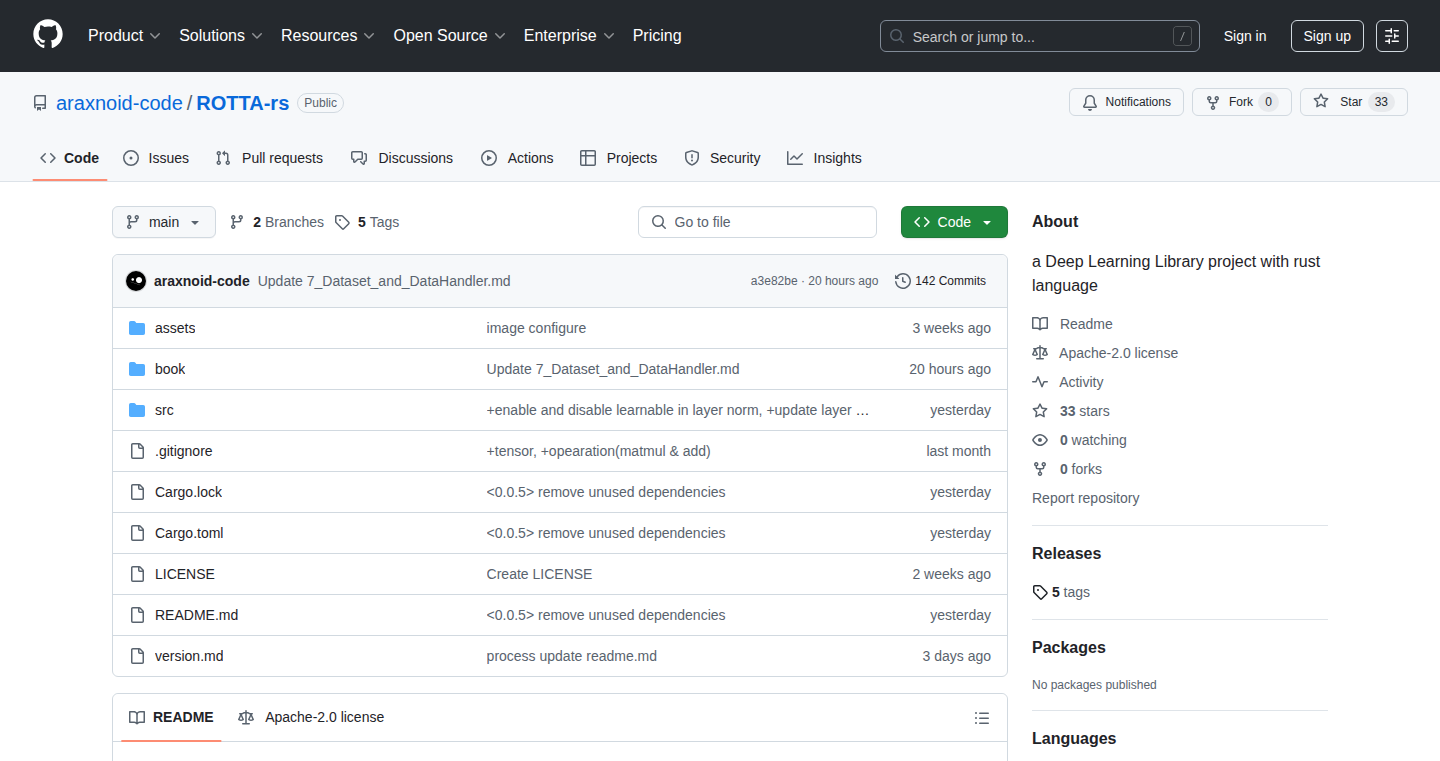
Author
araxnoid
Description
ROTTA-rs is a deep learning library written in Rust, a programming language known for its speed and safety. This project offers a user-friendly way to build AI models. Version 0.0.5 introduces several key improvements, including optimization algorithms like RMSProp and Adam, and techniques such as Batch Norm and Layer Norm, which significantly improve model performance and stability. It also simplifies data handling through Dataset and DataHandler, making it easier to manage and process large datasets for training AI models. So, this helps you create and train AI models faster and more efficiently.
Popularity
Points 1
Comments 0
What is this product?
ROTTA-rs is essentially a toolkit that helps developers create and experiment with artificial intelligence models. It uses Rust, offering a good balance between performance and safety. The library implements core features needed for AI model development, like optimization algorithms to help models learn from data (RMSProp, Adam), and techniques to make training more stable (Batch Norm, Layer Norm). It also provides tools to easily manage and prepare data, such as splitting data into batches. So, it simplifies the complicated parts of AI development.
How to use it?
Developers can use ROTTA-rs by integrating it into their Rust projects. You'll write code to define your AI model's structure, load your data, and then use the library's functions to train the model. It simplifies the complex math behind AI. For example, you'll be able to load a dataset, define the model layers, and then use the library’s built-in features like RMSProp to train the model. So, you can focus on the model's architecture and problem-solving instead of the low-level implementation details.
Product Core Function
· RMSProp and Adam optimizers: These are algorithms that help the AI model learn from the data. They adjust the model's parameters during training to minimize errors. The value is that it allows developers to quickly improve the performance of the AI model without needing to implement optimization algorithms from scratch, leading to faster iteration and experimentation.
· Batch Norm and Layer Norm: These techniques help stabilize and speed up the training process by normalizing the data fed into each layer of the AI model. The value is that these features improve the training stability and speed up convergence, making the model more reliable and efficient.
· Tensor creation and slicing: This provides functionalities to create and manipulate multi-dimensional arrays (tensors), which are essential for representing and processing data in AI models. The value is that this simplifies data handling, allowing developers to focus on the model's architecture instead of the complex implementation details.
· Dataset and DataHandler: These features simplify the process of loading, shuffling, and batching datasets for AI model training. The value is that it streamlines the data preparation process, making it easier for developers to handle large datasets and prepare them for training their AI models.
Product Usage Case
· Image Recognition: You could use ROTTA-rs to create an AI model that identifies objects in images. You would load a dataset of images, define a convolutional neural network using ROTTA-rs’s tools, and train it. This solves the problem of needing to build everything from the ground up and allows rapid prototyping.
· Natural Language Processing: Develop a model for sentiment analysis. You could use ROTTA-rs to build a model that analyzes text and determines the sentiment (positive, negative, or neutral). You would prepare the text data, feed it into the model, and train it using the library's optimization tools. This eases the complexities of NLP model construction.
· Time Series Analysis: Build a model to predict future stock prices. By creating a Recurrent Neural Network (RNN) using ROTTA-rs, you can process time-series data. You can train the model with the historical stock prices using the library's optimization techniques, offering a streamlined workflow for time-series prediction tasks.
73
Perennial Task (prn) - A Local-First Command-Line Task Manager
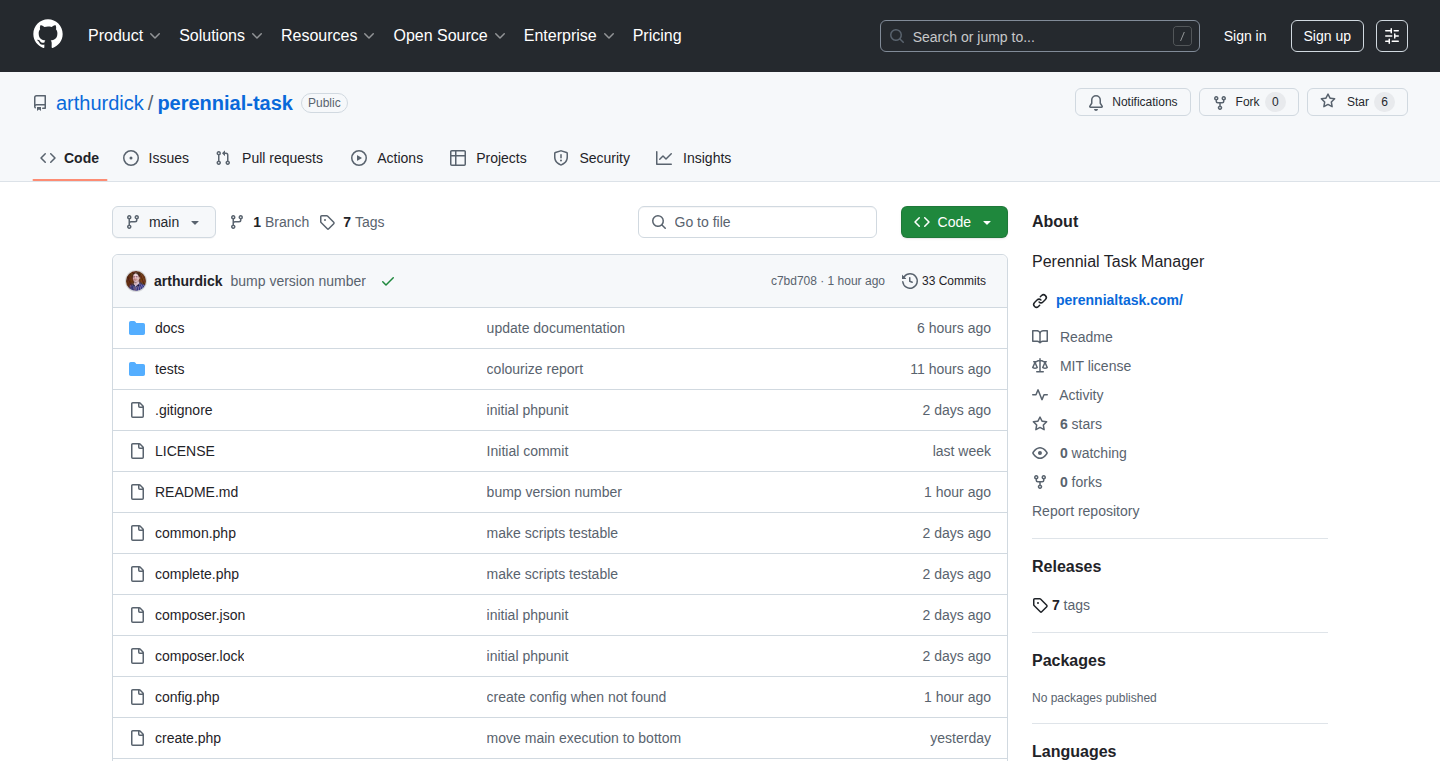
Author
arthurdd
Description
Perennial Task is a command-line task manager that stores your tasks as simple XML files on your own computer. The core innovation lies in its local-first design, meaning your data is fully under your control and doesn't rely on any external servers. This approach solves the problem of data privacy and control, allowing users to manage their tasks without worrying about cloud outages or vendor lock-in. It's built in PHP, making it accessible for a wide range of developers.
Popularity
Points 1
Comments 0
What is this product?
Perennial Task is a task management tool that works directly from your terminal (command line). Instead of storing your tasks on a website or in a cloud service, it saves them as individual XML files on your computer. The key idea is 'local-first' - everything is stored locally. This is different from many task managers that rely on internet services. It gives you complete control over your task data and protects your privacy. So this is useful because it allows you to manage your tasks privately and offline.
How to use it?
Developers use Perennial Task by typing commands into their terminal. They can create tasks, mark them as complete, see what needs to be done, and so on. You can integrate it into your workflow by using it alongside other command-line tools. For example, you might use it to keep track of coding tasks or project deadlines. So this is useful because it gives you a simple way to manage tasks right from your coding environment.
Product Core Function
· Task Creation: Allows you to create new tasks with descriptions and due dates. The tasks are saved as XML files on your computer. This is valuable because it provides a straightforward way to add new items to your to-do list.
· Task Listing: Displays all your tasks, including their status (e.g., pending, completed). This functionality gives you a clear overview of what needs attention.
· Task Completion: Marks tasks as complete, allowing you to track progress and archive finished items. The value is that it helps you see what you've accomplished and keeps your to-do list clean.
· Local Storage: The task data is stored locally in XML files. This design choice enhances user privacy and data control, with no reliance on remote servers. This is useful because it gives you full control of the tasks, removing the risk of data breaches or service outages.
· Command-Line Interface (CLI): The tool is operated entirely through the command line, allowing for quick and efficient task management. The value here is the ability to quickly manage tasks without needing to use any graphical user interface.
Product Usage Case
· A software developer uses Perennial Task to track coding tasks and deadlines for multiple projects. The local storage ensures the developer's task data remains private and accessible even without an internet connection. This solves the issue of keeping sensitive project tasks secure and accessible.
· A freelancer relies on Perennial Task to manage client projects, including scheduling meetings and tracking payments. The local-first approach guarantees the freelancer retains complete control over all project information. This is useful because it ensures the freelancer can manage projects securely.
· A technical writer uses Perennial Task to organize research notes and writing deadlines. Because all data is saved locally, the writer can manage the tasks offline. This removes the issue of information getting lost during internet downtime.
· A system administrator uses Perennial Task to keep track of server maintenance tasks and patching schedules. The local storage of the data makes it ideal to avoid reliance on external services. This is valuable because it offers the security of offline storage.
74
Coherence: Agentic Chat SDK
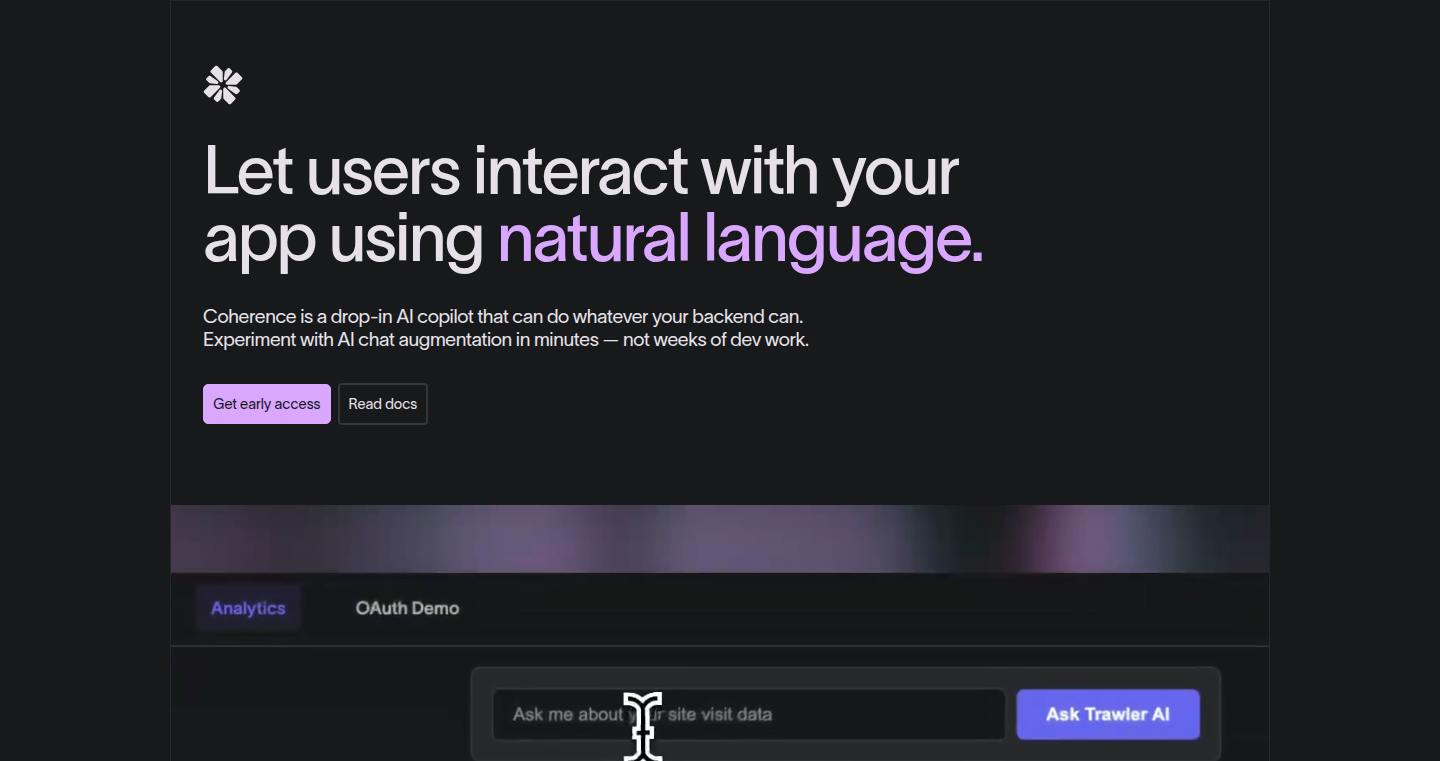
Author
zoomzoom
Description
Coherence is a speedy SDK that allows you to easily add a chat interface to your application, leveraging your existing authentication system and backend data. It's designed to create 'agentic' chat experiences – chatbots that can actively interact with your data and connect to external services. The key innovation lies in simplifying the integration of 3rd party data through Managed Communication Platform (MCP) servers, handling hosting and OAuth headaches, thus making it easier for developers to build powerful, data-aware chat applications.
Popularity
Points 1
Comments 0
What is this product?
Coherence provides a simple way to build advanced chatbots that can understand your data and interact with other online services. Technically, it integrates with your existing user authentication, allows access to your backend information, and provides a method for connecting to other services through hosted MCP servers. These servers manage the complicated process of hosting and dealing with security (OAuth). This means developers don't have to worry about the low-level details and can focus on building the core features of the chatbot. So this simplifies chatbot development significantly.
How to use it?
Developers can integrate Coherence into their applications by using the provided SDK. This allows them to add a chat interface, connect to their backend data, and integrate with third-party services. You integrate it like any other SDK by importing the library into your project, setting up authentication, and connecting to the Coherence servers. For example, you could create a customer support bot that can access customer order information. So, developers can build powerful, intelligent chat interfaces without needing extensive knowledge of backend infrastructure or security protocols.
Product Core Function
· Agentic Chat Interface: Allows developers to build chatbots that actively access and use their data. This opens possibilities to build interactive, data-driven applications such as advanced customer support. It has value because it automates tasks, improves user experience, and provides personalized information.
· Backend Data Integration: Coherence connects to your existing authentication system and backend databases, allowing the chatbot to access and respond to information. This creates more intelligent, context-aware chatbots with enhanced access. This means you don’t have to duplicate or sync your data, saving developers time and effort.
· 3rd Party Data Integration via MCP: The platform handles the integration of third-party services. This means Coherence manages the hosting, security (OAuth) and other complexities. This drastically simplifies the integration process and provides developers with a simple path to leverage external APIs.
· Managed Hosting & OAuth: Coherence manages the behind-the-scenes hosting of necessary servers and takes care of OAuth authentication, the process of securely allowing one application to access data from another. This dramatically simplifies integration with third-party services, so developers no longer need to spend huge effort in maintaining infrastructure.
Product Usage Case
· Customer Support Bot: A company can use Coherence to create a chatbot that can answer customer questions based on their order history and other support information. This enables immediate, personalized support and reduces the load on human customer service representatives. This solves the problem of slow response times and inefficient customer support.
· Internal Knowledge Base: An organization can use Coherence to create a chatbot that answers employee questions based on the company's internal documentation and databases. Employees will instantly get information, reducing the time needed to look for answers. It addresses the problem of employees spending too much time searching for information.
· E-commerce Product Recommendation: An e-commerce website can use Coherence to create a chatbot that recommends products based on a user's browsing history and preferences. It makes shopping more convenient and increases sales by surfacing the right products. This improves the shopping experience and increases sales.
· Healthcare Information Assistant: A healthcare provider could build a chatbot that answers patients' questions about their medical records and upcoming appointments. It assists by improving patient satisfaction and reducing the workload on medical staff. This provides instant answers to common questions and improves patient engagement.
75
GhostCV - Resume Optimization with Hidden Text
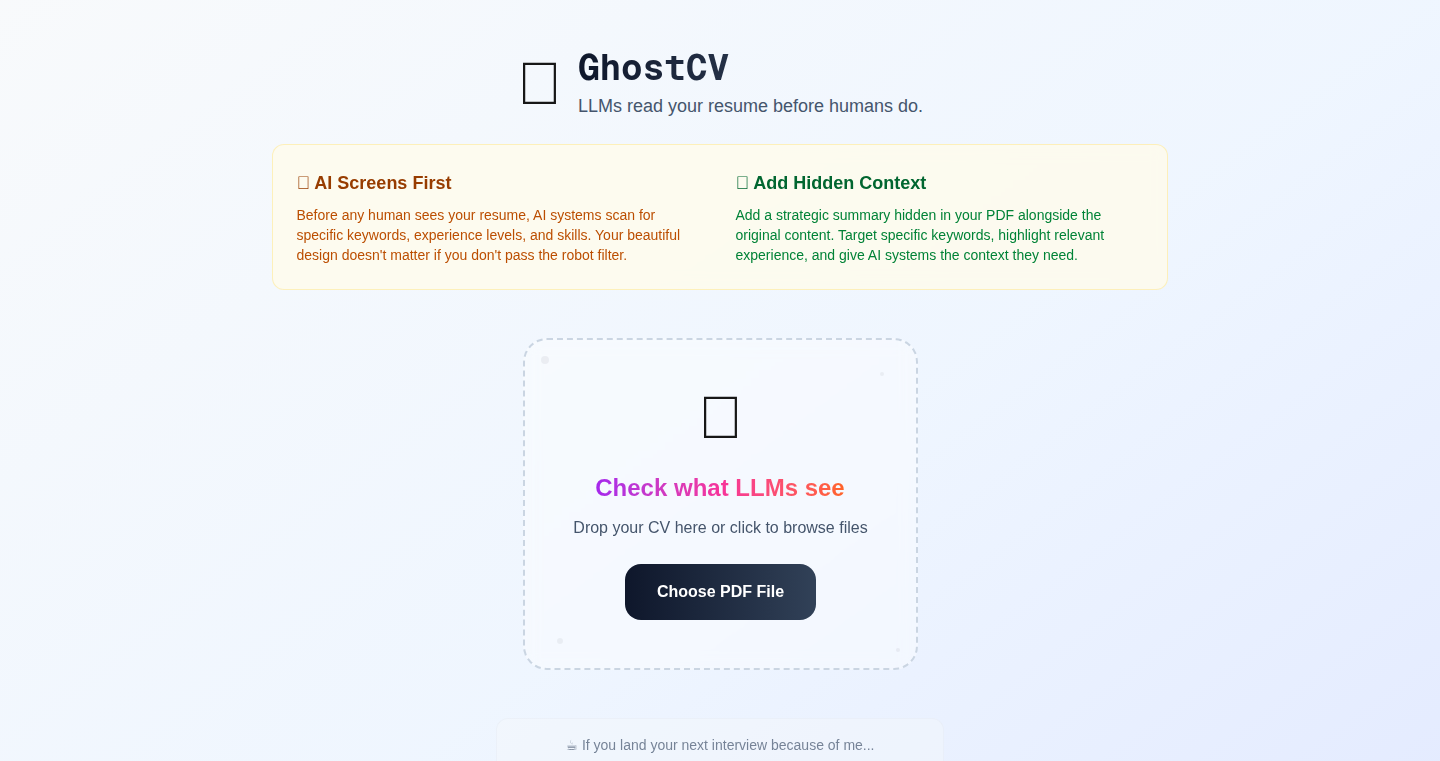
Author
kirchoni
Description
GhostCV is a clever tool that tackles a common problem: resume designs that look great to humans but confuse AI resume parsers. It cleverly embeds invisible text within your visually appealing resume design, ensuring that the AI can accurately extract your information while the human eye sees the original, well-designed resume. This is accomplished by letting users manually define the text the AI should see and then injecting it invisibly into the PDF. The core innovation is this fusion of visual design and AI-readability, solving the problem of applications being filtered out by poorly designed resume parsing systems.
Popularity
Points 1
Comments 0
What is this product?
GhostCV is a solution that overcomes the limitations of resume parsing systems. Many recruiters use AI to scan resumes, but visually designed resumes often get lost in translation because these AI systems are often only looking for raw text. GhostCV lets you manually define the text you want the AI to see, and then embeds that text invisibly into your visually designed resume as transparent text within the PDF. This ensures that both the AI and the human view a well-formatted and professional resume. So this lets you 'trick' the AI while presenting a beautiful resume. So this gives you the best of both worlds.
How to use it?
Developers can use GhostCV by uploading their designed resume (e.g., a PDF created in Figma or Canva). The application then allows the developer to overlay text precisely over their design, which is the text the AI will 'read'. This text is then made transparent, and the modified PDF is downloaded. Developers can then use this modified PDF when applying for jobs. So developers can make sure their resumes are seen and understood by the AI that is sorting applications.
Product Core Function
· Embedding Invisible Text: The core function is injecting hidden text into a PDF document. This text is strategically placed over the design elements, but is made transparent, so it's invisible to the human eye. This allows you to provide structured, AI-friendly text without changing your design. This is useful for ensuring that the resume parsing system correctly extracts the information that's important. So this makes sure all your skills get noticed.
· Manual Text Definition: The application lets the user specify what text the AI should see, enabling full control over the information that will be read by resume parsing programs. This solves the problem of incorrect information extraction. So this ensures the AI understands your resume exactly as you want it.
· PDF Manipulation: The tool manipulates the PDF directly, adding the transparent text and preserving the original visual design. This avoids the loss of formatting and layout that often occurs when converting the resume to plain text. So you can keep your resume looking as professional as possible.
· No Tracking and No Login: The service guarantees user privacy by offering the functionality without requiring login or user tracking. This is a value-add for users concerned about data privacy. So you don't need to worry about the service saving your data.
Product Usage Case
· Job Applications: A developer creates a visually appealing resume in a design tool like Figma. They then use GhostCV to embed clean, AI-readable text of their skills, experience, and contact information within the PDF, making it easily parsed by Applicant Tracking Systems (ATS). So they get their resume past the automated filter.
· Resume Optimization: A developer wants to ensure their resume is optimized for AI screening. They use GhostCV to define and embed the relevant keywords and phrases that recruiters and AI programs are looking for, increasing the chances of their resume being selected. So it makes it easier for employers to find them.
· Avoiding ATS Errors: A developer has had previous experiences with their resume's content being misinterpreted by ATS systems. They leverage GhostCV to directly control the text the parser sees. So it reduces the chances of errors in resume parsing.
76
Downalytics: Minimal Download Analytics for Open Source Binaries
Author
rumno0
Description
Downalytics is a lightweight tool designed to help open-source maintainers track binary downloads from GitHub releases. It allows you to route downloads through a custom domain or a generated subdomain, logging metadata like version, architecture, operating system, and country (if available). The core innovation lies in providing simple download analytics without requiring users to manage their own infrastructure. It acts as a minimal redirector with added analytics, offering valuable insights into how users are adopting and using your binaries. So, this helps you understand your user base and how they interact with your software.
Popularity
Points 1
Comments 0
What is this product?
Downalytics works by acting as a proxy for your binary downloads. When a user downloads a file, the request goes through Downalytics. The service then logs the relevant information (version, OS, etc.) and redirects the user to the actual file on GitHub. This is achieved using a CNAME record or a generated subdomain. The core innovation is the simplicity and ease of use, offering a quick way to gain download insights without complex setups. So, this enables you to gather crucial data about your users and their software usage, enabling better decisions.
How to use it?
Developers can use Downalytics by connecting their GitHub repositories using GitHub OAuth. Once connected, they can use either a generated subdomain or configure a CNAME record to route their binary downloads through Downalytics. The dashboard provides basic analytics on download counts, version usage, and platform distribution. The tool is well-suited for projects that release binaries through CLI tools or similar applications. So, this allows developers to gain data insights without needing to build an analytics infrastructure.
Product Core Function
· GitHub OAuth Integration: This allows for seamless connection to your GitHub repositories, enabling access to your release assets. This simplifies the setup process.
· CNAME and Subdomain-Based Download Tracking: Provides flexible options for redirecting downloads, using either a custom domain through a CNAME record or a generated subdomain from Downalytics. This enables accurate download tracking.
· Basic Dashboard with Download Metrics: The dashboard displays download counts segmented by version, platform, operating system, and country, offering valuable insights into user distribution. This empowers developers to visualize key adoption metrics.
· Free and Paid Tiers: A free tier is available for open-source projects and a paid tier for those who want custom domains and features for additional projects. This enables flexibility and scalable analytics depending on needs.
Product Usage Case
· A CLI tool developer wants to understand which versions of their tool are the most popular and on which platforms users are running it. By using Downalytics, they can track downloads and get actionable data to prioritize development efforts. So, this helps them improve their software.
· An open-source project maintainer wants to gather usage statistics without building their own analytics infrastructure. Downalytics is a quick and easy solution that provides the essential metrics like version, architecture, and country information. So, this enables them to get valuable insights without extra resources.
· A developer is distributing a cross-platform binary and wants to monitor the usage across different operating systems (Windows, macOS, Linux). Downalytics’ dashboard offers platform-specific breakdowns, which helps identify the OS popularity. So, this enables the optimization of cross-platform support.
77
Git Achievements: AI-Powered GitHub Achievement Extractor
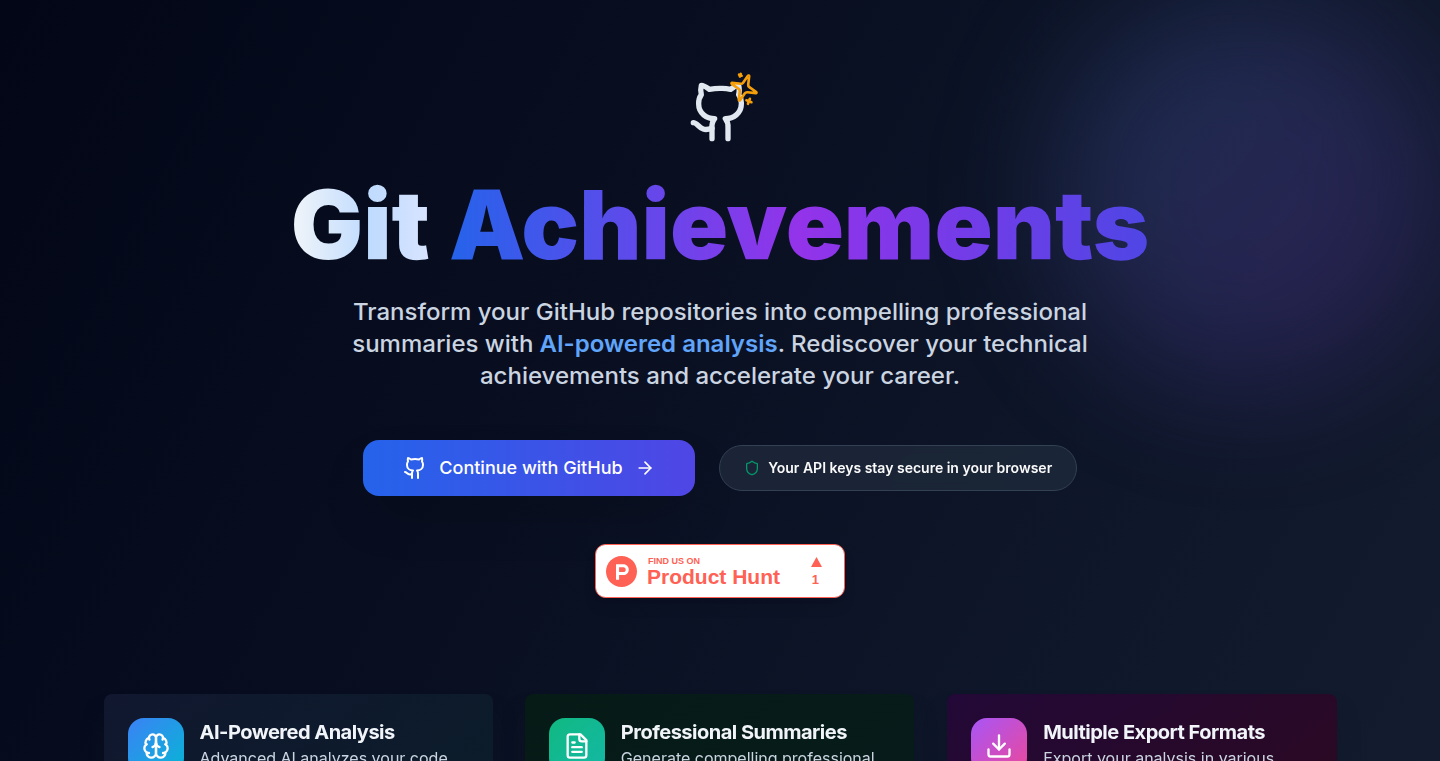
Author
davidngugi
Description
Git Achievements is an AI-powered tool that analyzes your GitHub repositories to automatically extract your technical achievements, complexity levels, and tech stack used in your projects. It transforms generic descriptions like "Built a web app" into detailed explanations such as "Implemented real-time data processing with WebSocket connections and integrated Google Analytics with custom event tracking." It also generates professional summaries and talking points suitable for resumes and interviews. The tool prioritizes privacy by keeping your API keys and data analysis within your browser, ensuring zero data storage on the developer's end. This tool directly addresses the common developer problem of underselling their technical contributions by providing a structured and AI-assisted method to showcase project details.
Popularity
Points 1
Comments 0
What is this product?
Git Achievements uses AI to understand your GitHub repositories. It reads your code and commit history, and then identifies the key technologies you've used, the complex problems you've solved, and the innovative features you've implemented. The AI uses your own API keys (e.g., OpenAI) and performs all the analysis directly in your web browser, so your code and project details stay completely private. This analysis results in detailed descriptions of your work that you can use to better represent your skills and experience. So this helps you describe your projects in a more compelling and accurate way, making it easier to showcase your technical accomplishments.
How to use it?
To use Git Achievements, you simply connect it to your GitHub account and provide your API keys for AI analysis. The tool then scans your repositories, identifies the technologies, and summarizes your achievements. You can then export these summaries to formats like PDF, Markdown, or JSON for easy sharing. For example, developers can use it to create detailed resumes, prepare for technical interviews by having specific talking points about their projects, or simply get a better understanding of their own codebase and contributions. So you can quickly create professional summaries of your projects and prepare for technical interviews.
Product Core Function
· Repository Analysis: Analyzes your GitHub repository to understand the project's technical aspects and identify key achievements. This is valuable because it automatically finds the complex parts of your projects and details the tech you used.
· Technical Achievement Extraction: Extracts specific technical achievements and details from your code. For example, it might identify that you implemented real-time data processing with WebSockets. This matters because it provides a more detailed and specific description of your work, instead of generic statements like "built a web app."
· Tech Stack Identification: Automatically identifies the technologies used in your projects, such as React, Node.js, PostgreSQL, etc. This helps you quickly create a clear overview of your project's technical foundation. This is important because it gives a comprehensive list of the technologies you worked with, making it easier to create a technical resume.
· Summary Generation: Generates professional summaries and talking points from the extracted data, optimized for resumes and interviews. The value here is that you can create a better resume and prepare for interviews without manually describing your technical achievements.
· Export Capabilities: Allows you to export the generated summaries to PDF, Markdown, or JSON formats. This ensures that the extracted information can be easily shared and used in different contexts like resumes and portfolio websites. So you can easily use your project descriptions in different formats.
Product Usage Case
· Resume Creation: A developer used Git Achievements to analyze a complex React project. Instead of just saying 'Built a web app,' the tool generated a summary detailing the use of WebSockets for real-time updates, integration with Google Analytics, and the implementation of responsive UI using Framer Motion. The detailed summary improved their resume, making their technical skills much clearer. So you get a more professional resume by automatically describing your projects.
· Interview Preparation: A developer used Git Achievements to prepare for a technical interview. They analyzed a project using Next.js and identified several achievements, including implementing a deployment pipeline and using specific libraries. The tool provided detailed talking points, allowing the developer to confidently discuss their project's technical intricacies. So you can confidently talk about your projects in interviews by having good talking points.
· Project Documentation: A developer used Git Achievements to create detailed technical documentation for their projects. The tool’s analysis helped them quickly generate a comprehensive overview of their project's architecture, technologies used, and key achievements. This documentation made it easier for other developers to understand and contribute to the project. So you automatically generate documentation for your projects, saving time and effort.
78
Optiverse: Modular Code Evolution with LLMs
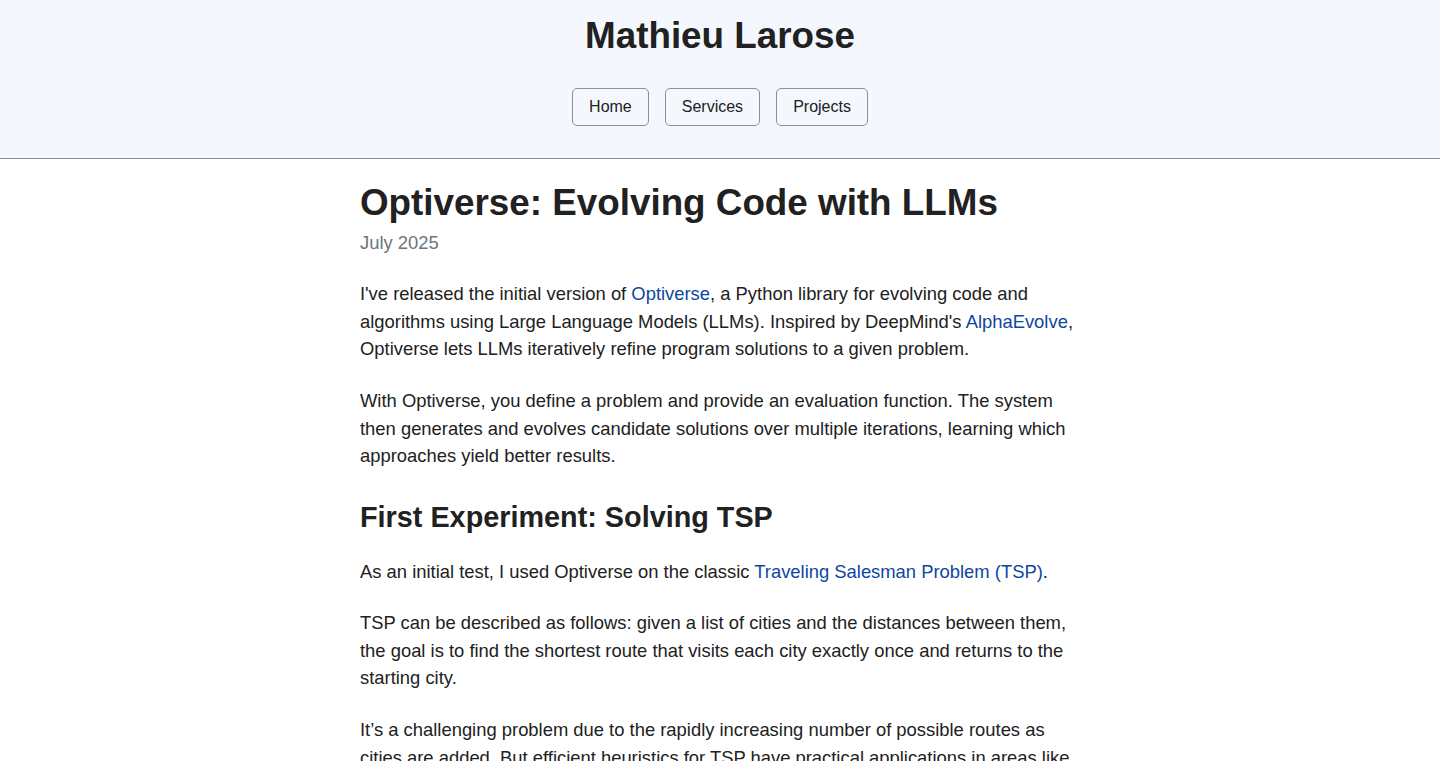
Author
larose
Description
Optiverse is a project that allows you to evolve code using Large Language Models (LLMs), inspired by DeepMind's AlphaEvolve. The core innovation lies in its modular design, making it easier to experiment with different evolution strategies and prompt engineering techniques. This allows developers to flexibly adapt and optimize their code generation processes, exploring various approaches for exploration and exploitation in the evolution process, aiming for enhanced code quality and performance.
Popularity
Points 1
Comments 0
What is this product?
Optiverse leverages the power of LLMs to automatically evolve code. It works by breaking down the evolution process into modular components. You can mix and match different modules like mutation strategies, fitness functions (how to judge good code), and prompting techniques (how to guide the LLM). This modularity allows developers to easily swap out components and experiment with different approaches. For example, developers could try various methods to improve the code generated by the LLM and refine the code over time, like balancing exploration and exploitation in the generation process to find the optimal solution.
How to use it?
Developers use Optiverse by integrating it into their projects where they want to generate or optimize code. They define the initial code, the rules for evolving it (mutation, fitness evaluation), and the LLM to use. The system then iteratively improves the code based on the defined rules. The modularity allows developers to customize the evolution process. For example, they can define how the code is changed, how good the code is measured, and what instructions are given to the LLM to change the code. You can then use this to automatically adapt and improve code over time, streamlining development and potentially improving code quality. You'd integrate it using a programming language like Python, importing the Optiverse libraries, and defining your evolution parameters.
Product Core Function
· Modular Architecture: Optiverse features a modular design, allowing developers to easily swap and experiment with different components. This means developers can try out various techniques without having to rewrite the entire system. This is valuable because it greatly reduces the time and effort required to explore different approaches to code evolution.
· Customizable Mutation Strategies: Developers can define how the code is mutated or changed by specifying different strategies, such as adding new features, fixing bugs, or refactoring existing code. This offers flexibility in how the code evolves, making it adaptable to various development scenarios. This is useful because it lets developers tailor the evolution process to their specific needs and desired outcomes.
· Fitness Function Flexibility: Users can customize the fitness function, which is the method used to evaluate the quality of the generated code. This allows for measuring different aspects of the code's performance, correctness, or efficiency. This is important because it enables developers to optimize the code for their specific use cases, whether it's speed, accuracy, or other key factors.
· Prompt Engineering Capabilities: Optiverse supports custom prompt engineering, enabling developers to craft prompts that guide the LLM during the code generation and evolution process. This lets developers refine the behavior of the LLM to enhance the quality of the code. This is helpful because it gives developers fine-grained control over the code generation process, allowing for more effective and targeted results.
Product Usage Case
· Automated Code Generation: A software engineer wants to automatically generate the base code for a new mobile app feature. They use Optiverse, defining a set of initial code and evolution rules. The system then uses the LLM and evolution techniques to optimize the feature's code, leading to a faster development time. This solves the problem of writing initial code, helping save time and reduce the risk of errors.
· Code Refactoring and Optimization: A team wants to improve the performance and readability of their existing code base. They use Optiverse to automatically refactor their code, letting the system evaluate different versions of the code and keep the best ones. This addresses the problem of having inefficient or complex code, and the automated refactoring can improve maintainability and make the code easier to work with.
· Bug Fixing: A developer wants to automatically fix bugs in their program. They provide the buggy code to Optiverse. The system then utilizes the LLM to generate and test modified code. This solves the problem of manual debugging and offers an automated way to resolve common code errors. This reduces the manual debugging workload and speeds up the overall development process.
79
CompetitorVision: An AI-Powered Competitor Discovery Tool

Author
mutlusakar
Description
CompetitorVision is a tool that leverages Artificial Intelligence to help early-stage startups identify their real competitors. It addresses the common problem of founders struggling to understand the competitive landscape. The innovation lies in using AI to analyze market data and uncover competitors that founders might miss through traditional methods. It’s like having an AI-powered research assistant that constantly scans the web for you, focusing on your niche.
Popularity
Points 1
Comments 0
What is this product?
CompetitorVision works by using AI to analyze information about your startup, such as its description, target audience, and product. It then searches the internet, including websites, social media, and industry publications, to find other companies that offer similar products or services. The AI employs techniques like natural language processing (NLP) to understand the meaning of text and machine learning (ML) to identify patterns and connections. This helps uncover both direct and indirect competitors that might not be obvious at first glance. So, it's like having a smart search engine for your competition.
How to use it?
Developers can use CompetitorVision by providing a brief description of their startup and its offerings. The tool then generates a list of potential competitors, along with information about their products and services. This information can be used to inform market research, identify potential partners, and refine a startup's own value proposition. You can integrate it into your market research workflow, using the competitor data to guide your product development and marketing strategies. So, you can plug in your startup’s details and immediately get a competitive analysis.
Product Core Function
· Competitor Identification: The core function is to identify competitors based on a startup's profile. This is valuable because it saves founders time and effort in researching the competitive landscape. It allows them to quickly understand who they're up against. This helps you know who you are competing with.
· Competitive Analysis: The tool could provide insights into competitor strategies, product offerings, and target audiences. This informs your own strategy and can help identify opportunities and threats. So, you can know the strength and weakness of your competitors.
· Automated Market Research: It automates the initial stages of market research by gathering data on competitors and their activities. This saves time and resources and lets you focus on other important things. So, it's like having a research assistant that is working for you.
· Keyword Analysis: By analyzing keywords used by competitors, the tool can help startups refine their SEO and marketing efforts. Knowing your competitors keywords give you the insights for your keywords.
Product Usage Case
· A new SaaS startup uses CompetitorVision to quickly identify the key players in its market, enabling it to tailor its product and marketing strategy to differentiate itself. It helps them to compete with other SaaS companies.
· An e-commerce business utilizes CompetitorVision to find competitors selling similar products and understand their pricing strategies. This assists the business in setting competitive prices. Now you can check the price of the competition and set your price.
· A developer uses CompetitorVision to find potential partners for an upcoming project, leveraging the tool's competitor analysis to identify complementary businesses. This will help you to get the right partner for the project.
80
Caret: AI-Powered Meeting Notetaker
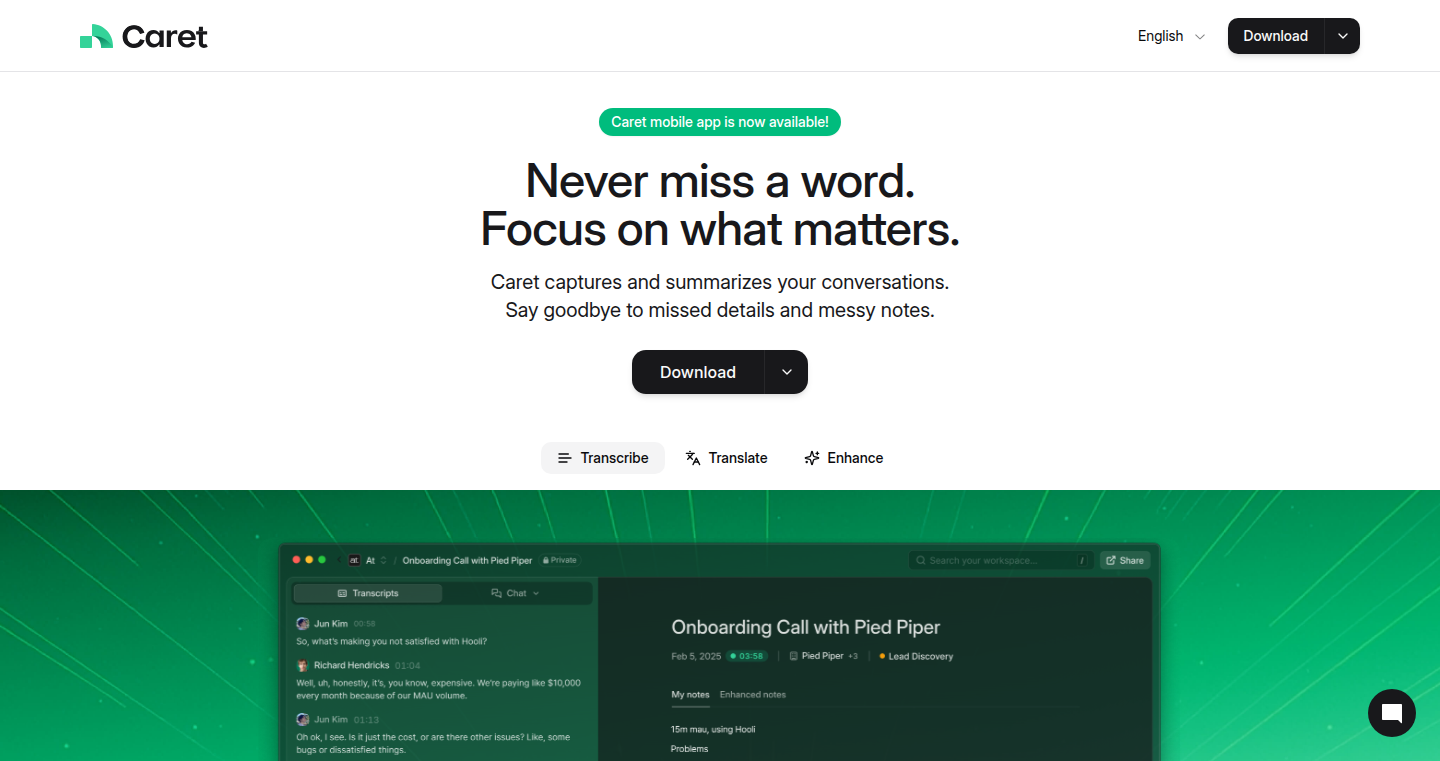
Author
hiddenest
Description
Caret is an AI-powered meeting notetaker designed to accurately transcribe and summarize conversations. Unlike other note-taking tools, Caret focuses on correctly capturing names, numbers, and context, ensuring a more reliable record of meetings. It also offers real-time transcription and translation, an intuitive editing experience, and platform compatibility across Mac, Windows, and iOS. The project demonstrates a practical application of AI for improving productivity and communication, addressing common shortcomings in existing note-taking solutions.
Popularity
Points 1
Comments 0
What is this product?
Caret leverages advanced AI models to transcribe audio from meetings with exceptional accuracy. Its core innovation lies in its ability to correctly identify and transcribe names, numbers, and understand conversational context. This is achieved through a combination of improved speech-to-text algorithms, speaker identification, and contextual analysis. Furthermore, it offers real-time transcription and translation features, allowing users to follow along in real-time and overcome language barriers. So what's the point? For you, it means more accurate and reliable meeting notes, easier information retrieval, and enhanced accessibility.
How to use it?
Developers can integrate Caret in their workflow by simply using it to record their meetings. Caret can capture audio from any platform or meeting tool. After the meeting, Caret provides a transcript and summary that developers can easily review, search, and share. For instance, a developer could use Caret to record project meetings, track decisions, and identify action items. This will save time and ensure that everyone is on the same page. Developers can also leverage Caret’s real-time transcription to follow along in meetings, making it easier to understand technical discussions and capture key information.
Product Core Function
· Accurate Transcription: Caret uses AI to transcribe speech with high precision, correctly capturing names, numbers, and technical terms that other tools often miss. Value: Ensures a reliable record of meeting discussions, eliminating the need for manual corrections. Application: Useful for capturing discussions in technical meetings, project planning sessions, and client presentations. So, I can get accurate notes, allowing me to focus on the discussion.
· Contextual Understanding: Caret analyzes the context of the conversation to understand the roles of speakers and the topics being discussed. Value: Improves the accuracy of summaries and highlights the most important information. Application: Helps identify key decisions, action items, and the different viewpoints discussed during the meeting. So, I can understand what's being discussed more easily.
· Real-time Transcription and Translation: Caret provides real-time transcription and translation of meeting audio. Value: Enables users to follow along in real-time, improving understanding and accessibility for those with hearing difficulties or who are non-native speakers. Application: Facilitates better communication in multilingual teams or for individuals with hearing impairments. So, I can follow every meeting without any issues.
· Intuitive Summary Editing: Caret provides an easy-to-use editing interface, allowing users to quickly modify and format meeting summaries. Value: Enables quick editing and customization of notes, ensuring they meet specific needs. Application: Useful for generating summaries, extracting key takeaways, and creating action item lists. So, I can easily turn long meeting notes into usable summaries.
· Cross-Platform Compatibility: Caret works on Mac, Windows, and iOS platforms. Value: Provides flexibility and accessibility, allowing users to access their notes from any device. Application: Enables seamless integration into the existing workflow, making it easy to use Caret regardless of the device. So, I can always access my notes wherever I go.
Product Usage Case
· Project Planning: A development team uses Caret to record a sprint planning meeting. Caret accurately captures the team's discussions, assigned tasks, and estimated timelines. The team uses the real-time transcription to follow along during the meeting and uses the final notes to create a summary of tasks and deadlines. So, I can easily manage my projects.
· Technical Debugging: Developers record a technical discussion to debug a software issue. Caret transcribes the discussion, which helps to identify the problematic lines of code and trace the root of the issue. The developers use Caret's accurate transcription to pinpoint the exact moment when the problem was discussed, reducing the time spent in debugging. So, I can save time on debugging.
· Remote Collaboration: A distributed team uses Caret to record a video conference. The real-time transcription allows all team members, including those with different language skills, to follow the discussion and extract the essential information. So, I can communicate and understand better with my teammates.
· Accessibility for Deaf or Hard of Hearing Developers: A developer with hearing difficulties uses Caret during meetings. The real-time transcription allows the developer to easily follow the conversation. The meeting notes created after are a reliable and accessible record. So, I can participate fully in every meeting.
81
Idea Swiper: A Novel Idea Generation Engine
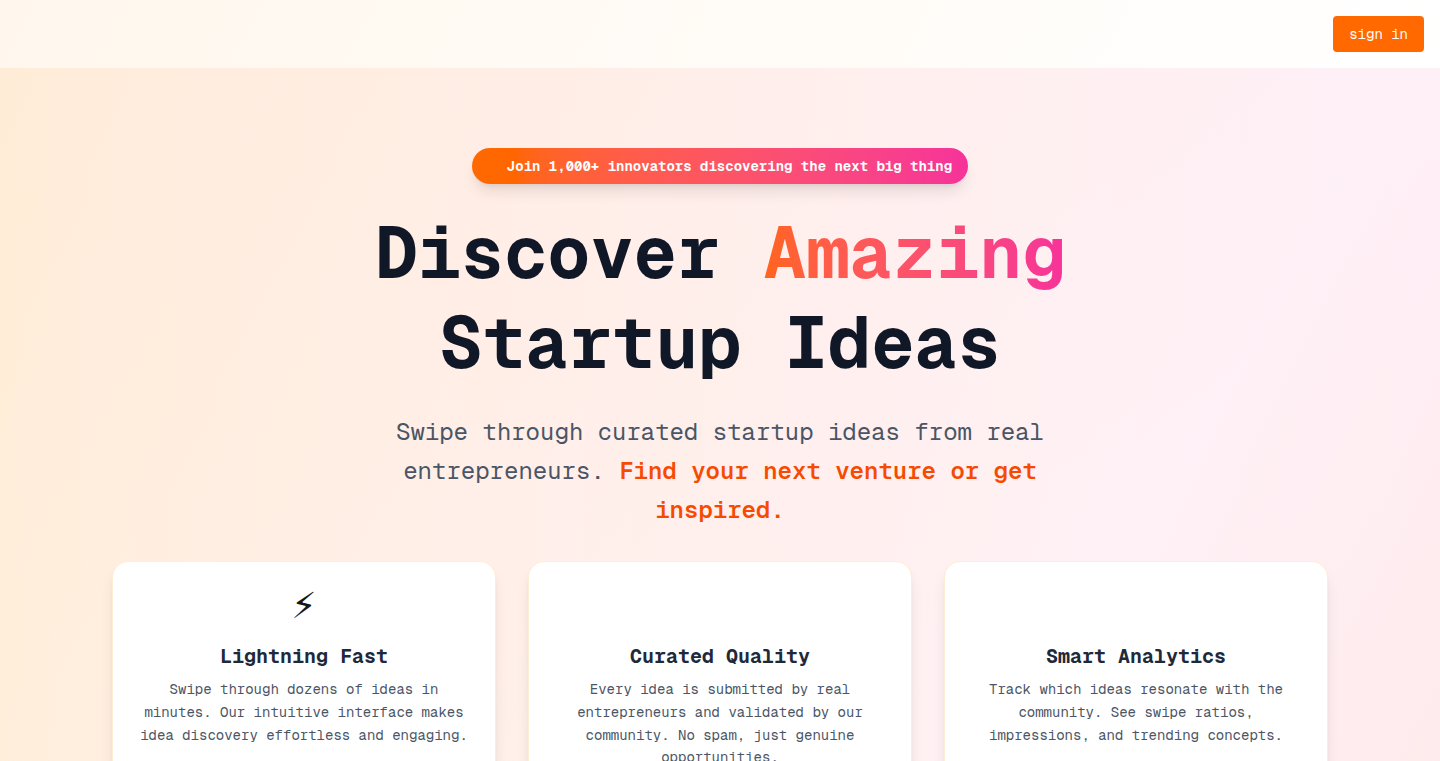
Author
sahil423
Description
This project, 'Idea Swiper', is a tool designed to help users generate new ideas by combining existing concepts. The core innovation lies in its ability to rapidly iterate through different combinations of ideas, providing users with a stream of novel possibilities. It solves the problem of creative blocks and provides a fresh perspective on problem-solving. So this allows you to break through your creative block and find new solutions.
Popularity
Points 1
Comments 0
What is this product?
Idea Swiper works by allowing users to input a set of initial ideas or keywords. The system then uses an algorithm to combine these elements in various ways, presenting users with a 'swiper' interface. Users can rapidly cycle through generated idea combinations, 'swiping' through options to discover potentially valuable and interesting combinations. It's a bit like a dating app for ideas. So it's a quick way to explore combinations and generate fresh thoughts.
How to use it?
Developers can use Idea Swiper in several ways. They can use it directly to generate ideas for projects or features. Integration can be achieved by inputting data (keywords, concepts) through an API or a simple text file. For example, you could use it to brainstorm project names, or to generate user interface design suggestions. So you could use this to solve your problems with a single line of code.
Product Core Function
· Idea Generation: The core function is to generate new ideas by combining input elements. This is valuable for brainstorming, problem-solving, and innovation in various fields. Example: Finding innovative ways to generate more code for your project.
· Rapid Iteration: The 'swiper' interface allows for quickly cycling through generated ideas, facilitating rapid exploration of possibilities. This is useful for quickly evaluating many different ideas. Example: This accelerates the process of exploring ideas.
· Concept Combination: The underlying algorithm combines different ideas in various ways. This is helpful for discovering novel approaches and sparking creativity. Example: It can help you come up with unexpected and interesting project ideas.
Product Usage Case
· Software Development: A developer is stuck on a feature design. They can use Idea Swiper to input initial keywords like 'user interface', 'real-time', and 'data visualization' to generate potential feature ideas. The tool can help them generate new features by combining those different keywords. So this can help generate creative ideas.
· Product Design: A product designer is brainstorming product names. They can use Idea Swiper by inputting a few keywords describing the product's functionality. The system generates various name suggestions. This allows a faster brainstorming. So this is the best way to find the right product name.
· Content Creation: A writer needs to generate topics for blog posts. They can use Idea Swiper, entering initial keywords related to the topic. The tool generates potential blog post ideas. So it allows for a rapid generation of ideas.
82
Debate-Driven Learning: LLM Argument Explorer
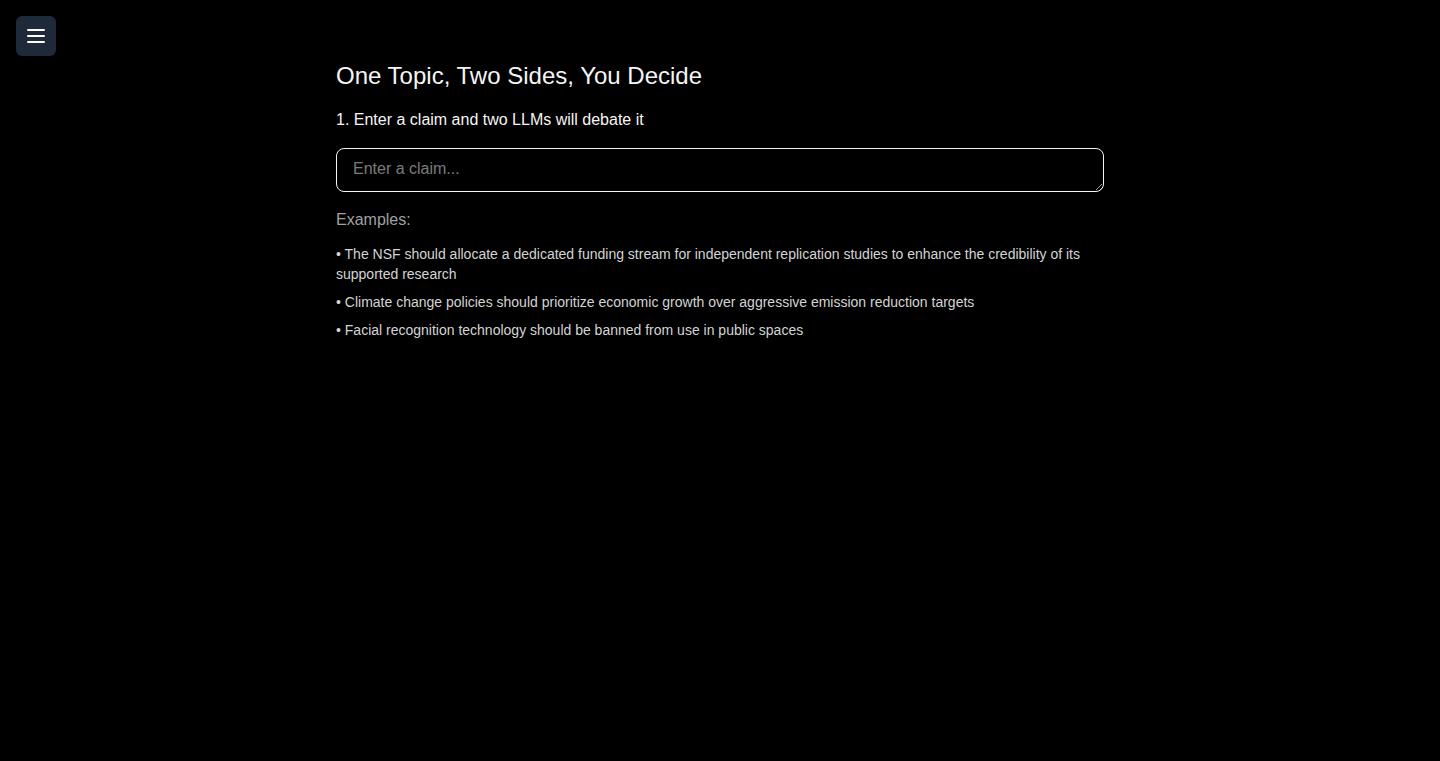
Author
sillypuddy
Description
This project addresses the common problem of biased information and limited perspectives in media. It uses Large Language Models (LLMs) to argue opposing sides of a debate, presenting a more balanced view of a topic. The core innovation lies in its use of different LLMs (GPT-4, Gemini 2.5 Flash, Grok-3) randomly assigned to each side, forcing them to generate arguments from opposite viewpoints. This approach allows users to explore complex topics from multiple angles, avoiding the pitfalls of echo chambers and promoting deeper understanding. So, this helps me understand complex topics more comprehensively.
Popularity
Points 1
Comments 0
What is this product?
It's a tool that leverages the power of multiple AI models to debate any topic. The tool assigns different AI models to argue for and against a specific point. The underlying technology involves prompt engineering – carefully crafting the instructions given to each LLM to ensure they effectively present their assigned arguments. The innovation lies in using diverse models and forcing contrasting perspectives, thus creating a balanced and in-depth exploration of the chosen subject. So, this helps me understand the topic by listening to multiple perspectives.
How to use it?
Users can input a topic or question, and the system generates arguments from different viewpoints using various LLMs. Developers could integrate this into their own learning platforms, research tools, or content generation systems. For example, a news aggregator could use it to provide opposing viewpoints on articles, or an educational website could use it to create debate simulations. So, this gives me the ability to generate arguments and analyze topics from multiple points of view, which is a great tool to improve research efficiency.
Product Core Function
· Multi-LLM Argument Generation: Utilizes multiple LLMs (GPT-4, Gemini 2.5 Flash, Grok-3) to generate arguments from opposing viewpoints. This is valuable for creating a diverse range of perspectives, which is an excellent technique to reduce bias.
· Automated Debate Framework: Creates a structured environment for LLMs to engage in debates. It is useful for automating the exploration of complex topics and providing a structured and organized way to understanding.
· Perspective Exploration: Designed to explore opposing arguments. It is helpful in promoting critical thinking and in-depth analysis of a particular problem.
· User-Defined Topic Input: Allows users to enter any topic for debate. This provides flexibility and broad applicability across various subjects and topics.
· Randomized Model Assignment: Randomly assigns different LLMs to different sides of the debate. This is useful to ensure a balanced output, and allows for a more unbiased analysis.
Product Usage Case
· Education: Teachers could use it to generate debates for classroom discussions, helping students understand complex issues from multiple perspectives. So, it allows me to have a balanced view when learning.
· Research: Researchers could use it to explore the pros and cons of a research topic, helping them develop more well-rounded arguments and avoid confirmation bias. So, it helps me find information that can support my research.
· Content Creation: Content creators could use it to generate diverse viewpoints for their articles or videos, increasing engagement and providing balanced information to their audience. So, it gives me a good view and arguments to use when I need to create content.
83
TimesTableGen: A Dynamic Times Table Generator
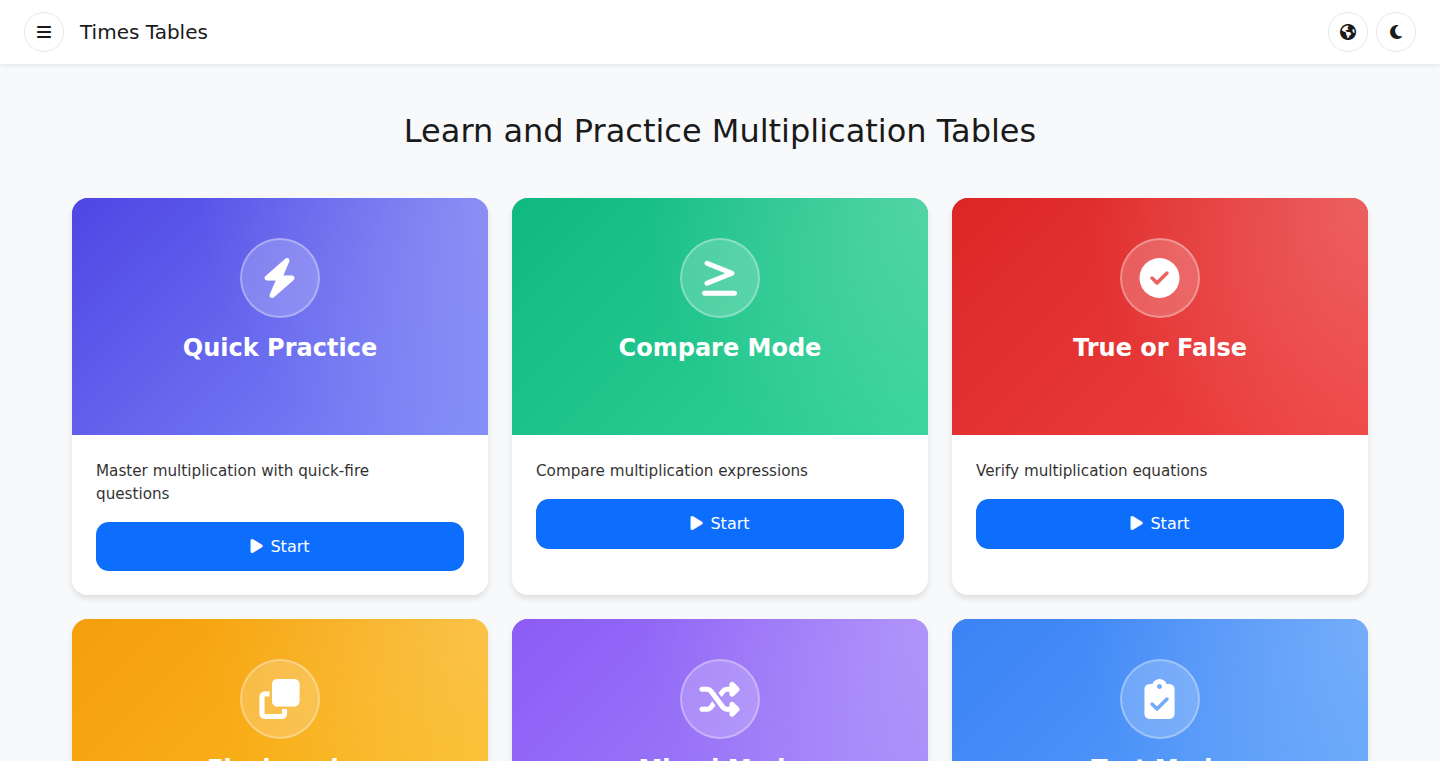
Author
artiomyak
Description
TimesTableGen is a web-based tool that allows users to generate and print custom times tables. It's a straightforward application, but the innovation lies in its simplicity and immediate utility. It addresses the need for easily accessible and customizable learning materials, moving away from static, pre-printed tables. The core technology likely involves client-side scripting (like JavaScript) to dynamically generate the tables based on user inputs, coupled with a printing function. This simplifies the process of creating learning materials for children.
Popularity
Points 1
Comments 0
What is this product?
This project is a web application that creates times tables, which are multiplication tables. The technology behind it probably uses JavaScript to create these tables dynamically on your computer's web browser, then allows you to print them. The innovative part is that it's very easy to use and lets you create exactly the tables you need, rather than being limited to pre-made ones. So, it’s essentially a custom table creator.
How to use it?
Developers can use this project to quickly generate and print custom times tables for educational purposes. You simply input the range you want to cover (e.g., tables from 1 to 10) and the tool generates the table. You can then print it. This could be integrated into more complex educational platforms or used as a base to build more advanced math learning tools. This can also be useful for educational content generation for children.
Product Core Function
· Times Table Generation: The core function dynamically creates multiplication tables based on user input. The value is that it allows for a completely customizable learning experience; you can focus on the specific tables needed for practice or learning. This is also applicable for building more complex math tool.
· Printing Functionality: This feature enables the user to print the generated times tables directly. The value is that it provides instant access to physical, printable learning materials, making it easy to use tables offline. Also it promotes a more practical approach to learning and can be used in multiple scenarios.
Product Usage Case
· Home Education: Parents can use this to quickly generate times tables tailored to their children's learning needs, focusing on specific times tables or ranges for practice.
· Classroom Integration: Teachers can use the tool to generate worksheets and supplementary materials for their students, addressing individual learning needs and making learning more engaging.
· Personalized Learning: Individuals can use the tool to create custom times tables for self-study and improvement, focusing on specific multiplication facts and reinforcing their understanding of multiplication.
84
JiraTalk: Slack's Natural Language Jira Navigator
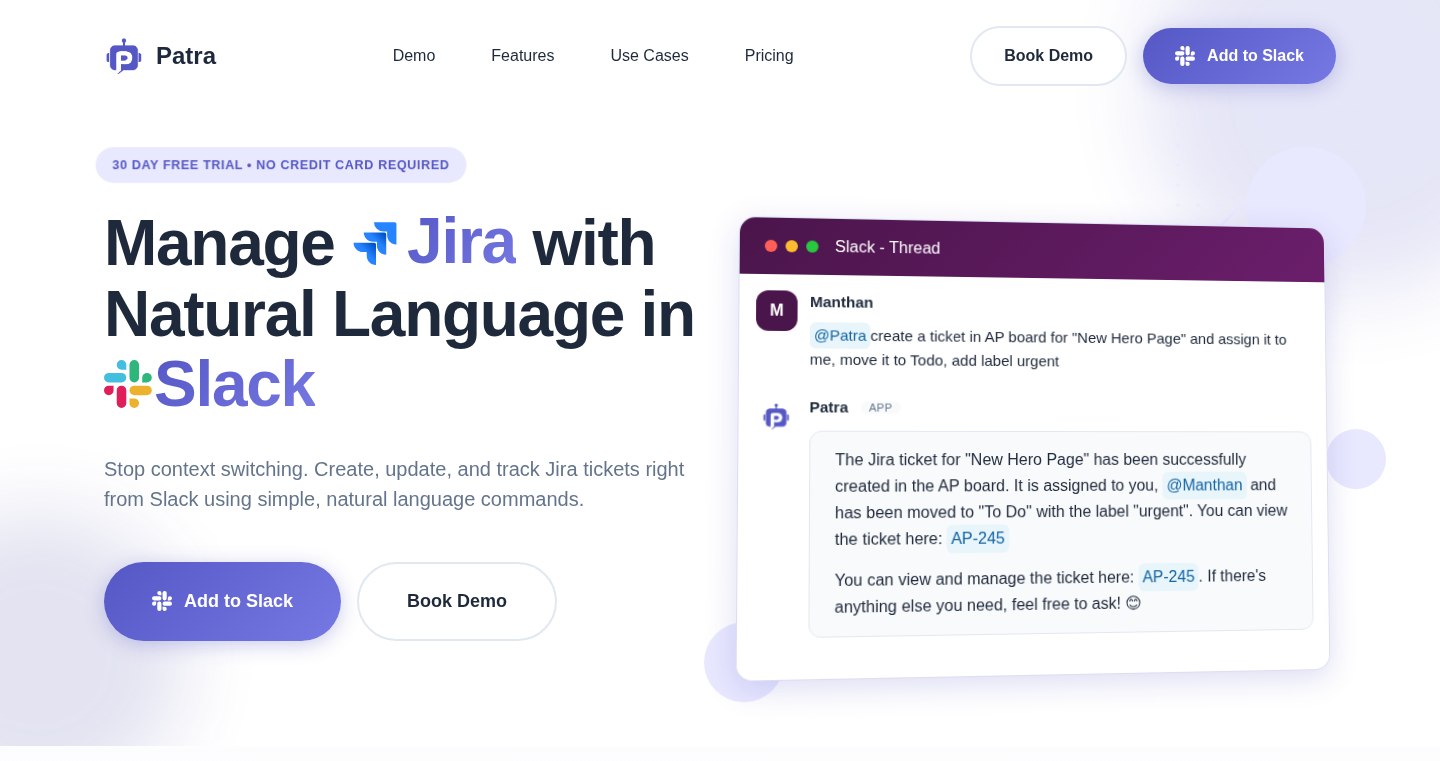
Author
manthan1674
Description
JiraTalk is a Slack-based assistant that understands natural language commands to interact with Jira. Instead of navigating the complex Jira interface, users can simply type commands like 'show me open bugs' or 'assign this task to John' within Slack. The core innovation lies in its natural language processing (NLP) engine that translates plain English into Jira API calls, making Jira interaction seamless and intuitive. This project aims to solve the problem of complex Jira workflows and improve team productivity.
Popularity
Points 1
Comments 0
What is this product?
JiraTalk is essentially a smart translator that understands what you want to do with Jira, even if you don't speak 'Jira language.' It uses NLP to convert your simple English commands into actions within Jira. Think of it like having a personal assistant that understands you and does all the clicking and navigating for you. The innovative aspect is in its ability to understand the intent behind the words and map them to the correct Jira operations.
How to use it?
Developers use JiraTalk by installing it in their Slack workspace and connecting it to their Jira instance. They then simply type commands in Slack to manage their tasks, view their backlog, or update the status of their tickets. For example, you might type something like '@JiraTalk assign this task to me' or '@JiraTalk show me all the tickets assigned to Sarah'. This eliminates the need to switch between Slack and Jira, streamlining the workflow. Developers can integrate it in their CI/CD pipelines to automate tasks based on Jira state changes. So it will save developers from tedious manual work.
Product Core Function
· Natural Language Command Parsing: It takes human-readable English commands and translates them into executable instructions for Jira. This removes the necessity of learning Jira's interface.
· Jira API Interaction: It interacts directly with the Jira API to retrieve and modify data. This means it can get information about tasks, update statuses, assign people, and more.
· Slack Integration: It lives within Slack, enabling users to access Jira without leaving their preferred communication platform. This means developers can stay in their flow.
· Contextual Understanding: The assistant attempts to understand the context of your commands. For example, it could remember the current project you're working on or know which task you are referring to.
· Issue Creation and Management: Enables users to create new issues or update existing ones directly from Slack, streamlining the issue tracking process.
Product Usage Case
· Daily Stand-up Automation: Developers can quickly see their assigned tasks and their status within Slack, instead of navigating Jira during the daily stand-up meeting. It improves time efficiency for teams.
· Bug Tracking and Assignment: When a bug is reported, developers can use a command like '@JiraTalk create a bug and assign it to John' directly in Slack, saving time and coordination effort.
· Project Status Updates: Project managers can use JiraTalk to generate reports on task completion, outstanding issues, and project progress from Slack, without manually searching Jira.
85
FaceBlurify: Real-time Privacy Protection for Your Browser
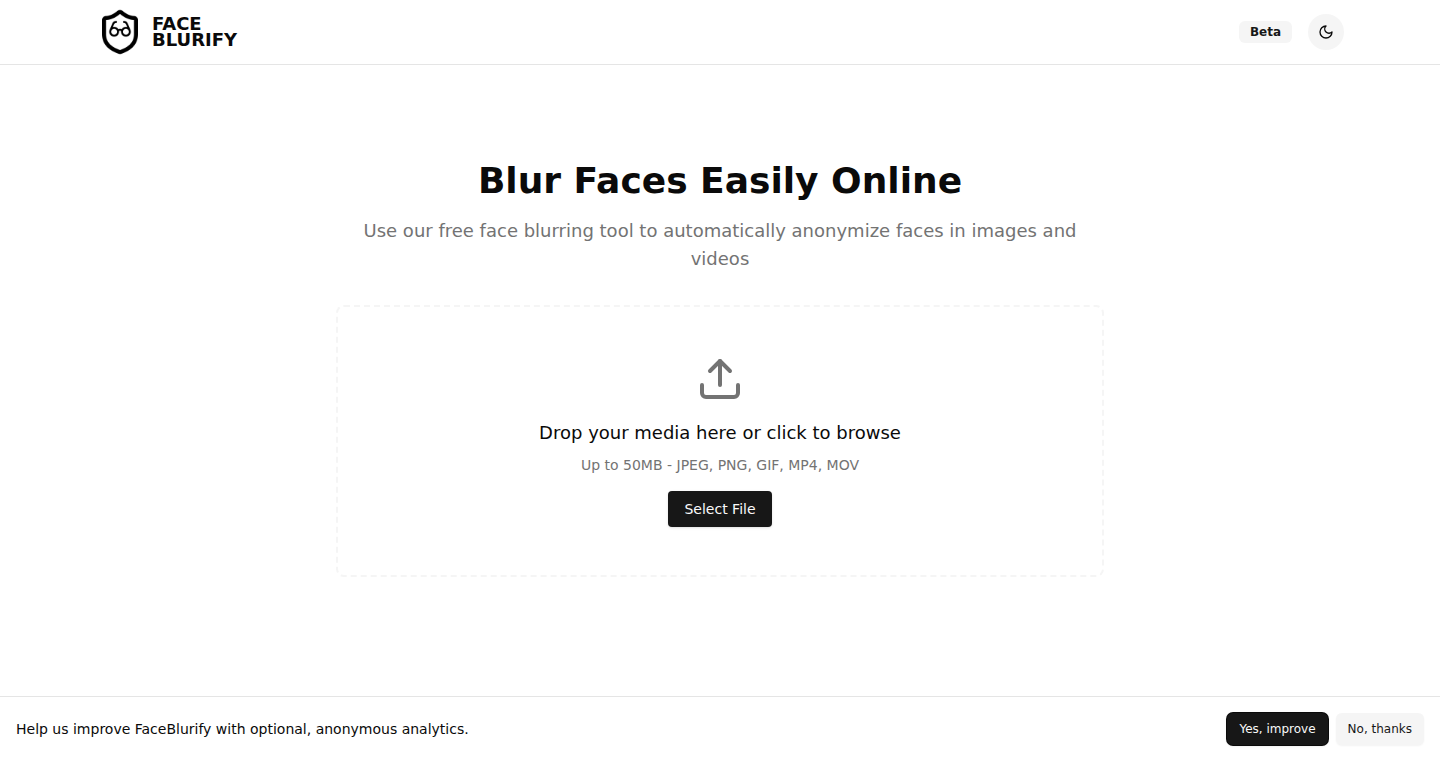
Author
HichamCh
Description
FaceBlurify is a free, browser-based tool that automatically detects faces in your browser's video streams and blurs or pixelates them in real-time, directly on your device. It prioritizes privacy by processing all video data locally whenever possible. It also supports multi-language UI and can work offline after caching. The project addresses the growing need for simple and effective privacy tools by allowing users to protect their face without uploading any video to a server, and the usage of FFmpeg and FD model for server processing, enhances the ability for advanced video processing.
Popularity
Points 1
Comments 0
What is this product?
FaceBlurify uses your computer's camera to see faces on the screen and automatically blurs or pixelates them, right inside your web browser. It uses face detection models to identify faces and then applies the blurring effect. This means your video stays private because it doesn't need to be sent to any server for processing. When longer videos or batch processing are required, the server part kicks in, utilizing FFmpeg for video processing, which offers an advanced capability for video filtering and editing to enhance the privacy.
How to use it?
You can use FaceBlurify to protect your face when you're on video calls, recording videos, or using webcam-enabled applications. Simply visit the website, and the tool will automatically start blurring faces in real-time. FaceBlurify is also designed to be a Progressive Web App (PWA), meaning it can be used offline once it's been cached. For developers, this project demonstrates how to implement client-side face detection and blurring, which can be integrated into other web applications that require privacy features.
Product Core Function
· Real-time Face Detection and Blurring: The core feature is the real-time detection of faces within a video stream and immediate application of blur or pixelation effects. This is valuable for users who want to maintain privacy during video calls or recordings. It is achieved by utilizing face detection models directly within the browser, ensuring real-time and efficient operation.
· Client-Side Processing for Privacy: FaceBlurify performs most video processing on the user's device, avoiding the need to upload sensitive data to a server. This approach dramatically increases user privacy. The value is that user data stays secure as the processing is done locally.
· Offline Functionality (PWA): As a PWA, FaceBlurify allows users to access and use the face blurring feature even without an internet connection after the initial caching. This enhances accessibility and usability. It's particularly useful in situations where internet access is limited or unavailable.
· Multi-language UI: The support for multiple languages makes the tool accessible to a global audience. This is achieved through i18n (internationalization) techniques, allowing users to easily switch between different language options.
· Server-Side Video Processing with FFmpeg: When dealing with longer videos, the use of FFmpeg enables advanced video processing on the server. It ensures that the functionality can scale to support more complex and larger video processing needs. This server-side capability allows for video format conversion, adding privacy effects, and other video editing functionalities.
Product Usage Case
· Video Conferencing: Users can use FaceBlurify during video calls to blur their faces, ensuring their identity is protected. For example, if you're having a meeting with confidential information on your background, or if you just want to keep your face out of public view. Developers can integrate similar face blurring features into their own video conferencing applications.
· Online Content Creation: Content creators can use FaceBlurify to blur faces in their videos before uploading them to platforms like YouTube or TikTok. This is particularly useful if their video accidentally captured faces of people they don’t want to disclose. It gives content creators a simple way to ensure they protect the privacy of others.
· Privacy-Focused Web Applications: Developers can learn from FaceBlurify's design to integrate similar face blurring features directly into web applications. For example, creating a private social media platform, or an application that helps blur faces in user-generated videos. The project illustrates a practical implementation of client-side face detection and blurring, thus providing reusable code for many applications.
86
Laurel Wreath Generator: A Web-Based SVG Creation Tool
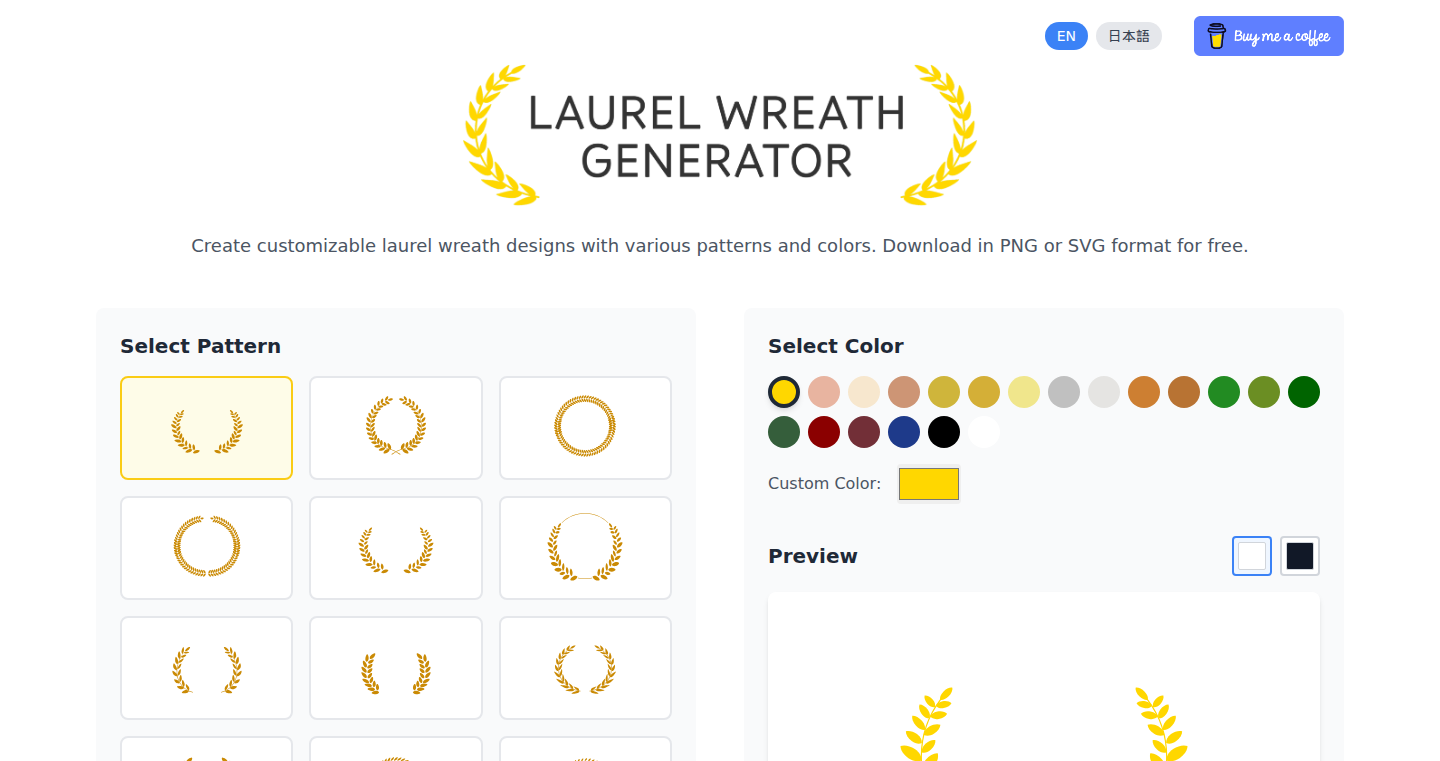
Author
seuyu_bin
Description
This project is a simple, web-based tool that allows users to generate custom laurel wreath illustrations in SVG format. The technical innovation lies in its ability to automate the creation of these often-sought-after design elements. By providing a user-friendly interface, the creator has simplified the process of generating scalable and customizable wreaths, addressing the common problem of finding suitable, free graphics for app screenshots and other visual content.
Popularity
Points 1
Comments 0
What is this product?
This project uses web technologies (likely HTML, CSS, and JavaScript) to create laurel wreath images. The user interacts with a web interface to customize the appearance of the wreath (e.g., shape, size, style). Behind the scenes, the tool uses code to generate the SVG (Scalable Vector Graphics) code, which defines the visual representation of the wreath. The innovation is in automating the design process, making it easy for anyone, even without graphic design experience, to create and use professional-looking illustrations.
How to use it?
Developers can use this tool by visiting the website, customizing the wreath to their needs, and downloading the generated SVG file. The SVG file can then be easily incorporated into their projects, such as app screenshots, website designs, or presentations. This can be done by directly embedding the SVG code in the HTML or referencing the SVG file as an image in CSS. This enables developers to quickly and easily add visually appealing elements to their projects.
Product Core Function
· SVG Generation: The core function is the ability to create SVG images programmatically. This is a key technical achievement because it allows for scalability. The wreath can be resized without losing quality, which is crucial for diverse design needs. So this is useful if you need to scale your illustrations to different sizes without making them look blurry.
· Customization Options: The tool offers various customization options (though the specific ones are not detailed, it's implied). These options enable users to tailor the wreath to their specific requirements, giving them control over the final aesthetic. This is useful because it provides flexibility in creating illustrations that fit their brand or project.
· Web-Based Interface: The project's web-based nature is a significant value add. Being web-based means the tool is accessible from any device with a web browser. This is useful as it eliminates the need for software installation or platform dependence. It makes the creation process easy and accessible from anywhere.
Product Usage Case
· App Screenshots: Developers can use the generated laurel wreaths to create visually appealing app screenshots for the App Store or Google Play. The wreaths can frame the app's interface or highlight important features. So this is useful because it makes the app stand out and can attract more users.
· Website Design: Web designers can use the SVG wreaths to decorate website headers, footers, or other design elements. Because the SVG is scalable, the wreath will always look crisp, regardless of the display size. So this is useful because it makes websites look more professional and polished, improving user experience.
· Presentation Graphics: The wreaths can be integrated into presentations to create visually engaging slides. They can be used as backgrounds, decorative elements, or as a framework for presenting information. So this is useful because it enhances the visual impact of presentations, making them more memorable and easier to understand.
87
Pwettify - The Universal CLI Prettifier
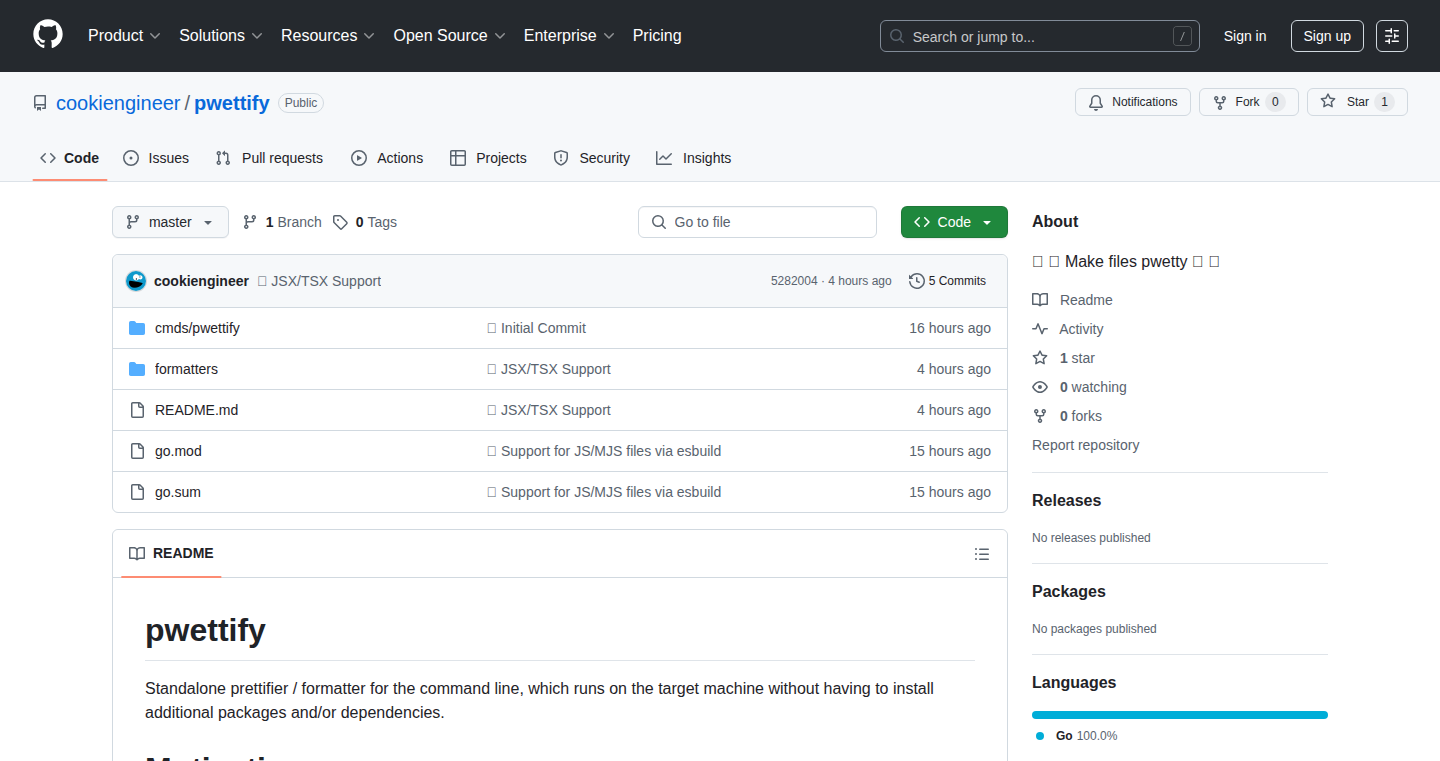
Author
cookiengineer
Description
Pwettify is a command-line tool that automatically formats (prettifies) files based on their file extension and file headers, making code easier to read and understand. The innovative part is its simplicity and standalone nature: it’s a single, self-contained program written in Go, meaning it doesn’t require extra software to be installed. It focuses on ease of use, avoiding complex command-line options. It solves the common annoyance of having messy, unreadable code when reverse engineering or simply working with different file types.
Popularity
Points 1
Comments 0
What is this product?
Pwettify works like a universal formatter. It analyzes a file to determine its type (e.g., JSON, YAML, HTML, JavaScript) either by its file extension or by looking at the content of the file itself (headers). Then, it uses the appropriate formatter for that file type to make the code nicely formatted and readable. The cool thing is you can just run a single command and it figures out how to format the file automatically. Because it's a standalone Go binary, you don't need to install a bunch of dependencies; it just runs. So this is useful because it saves you the trouble of finding and installing the right formatter for each file type, making it easy to format different types of files without the hassle.
How to use it?
You use Pwettify from your computer's command line (Terminal or Command Prompt). You simply point it to a file, and it does the rest. For instance, `pwettify my_code.js` will format your JavaScript file. It integrates with your workflow: if you are constantly working with various file types, you can integrate it into your build scripts or even your text editor to automatically format files when you save them. So this is useful because it automates the tedious work of formatting files, which is especially helpful when dealing with a lot of different file formats.
Product Core Function
· File Type Detection: Pwettify intelligently identifies the file type (e.g., JSON, YAML, HTML) based on file extension or header analysis. This is useful because it automatically knows which formatter to apply, eliminating manual configuration and guesswork.
· Automatic Formatting: It applies the appropriate formatter based on the detected file type, making code readable and organized. This is useful because it makes code easier to understand and maintain, which saves you time and reduces errors.
· Standalone Binary: Being a standalone Go binary, Pwettify doesn't require any runtime dependencies. This is useful because it is easy to install and use, making it portable and less prone to conflicts with other software.
· Simple Command-Line Interface: Pwettify has a simple, easy-to-remember CLI. This is useful because it avoids the complexity of many command-line options, making it quick to use and learn.
Product Usage Case
· Reverse Engineering: When reverse engineering a binary, you often encounter various file types (config files, data files). Pwettify can quickly format these files to make them readable, helping you understand the structure and content of the code. This is useful because it simplifies the process of understanding unfamiliar code, allowing you to focus on its functionality.
· Web Development: Use Pwettify to format HTML, CSS, and JavaScript files in your web projects, ensuring consistent and readable code. This is useful because it improves code maintainability and collaboration within a team.
· Data Analysis: Format JSON or YAML files containing data. This is useful because it makes the data easier to visualize and analyze.
· Configuration Management: Quickly format configuration files for easier readability and debugging. This is useful because it minimizes errors when modifying configuration settings.
88
OpenAPI Auditor: Your Free API Health Check
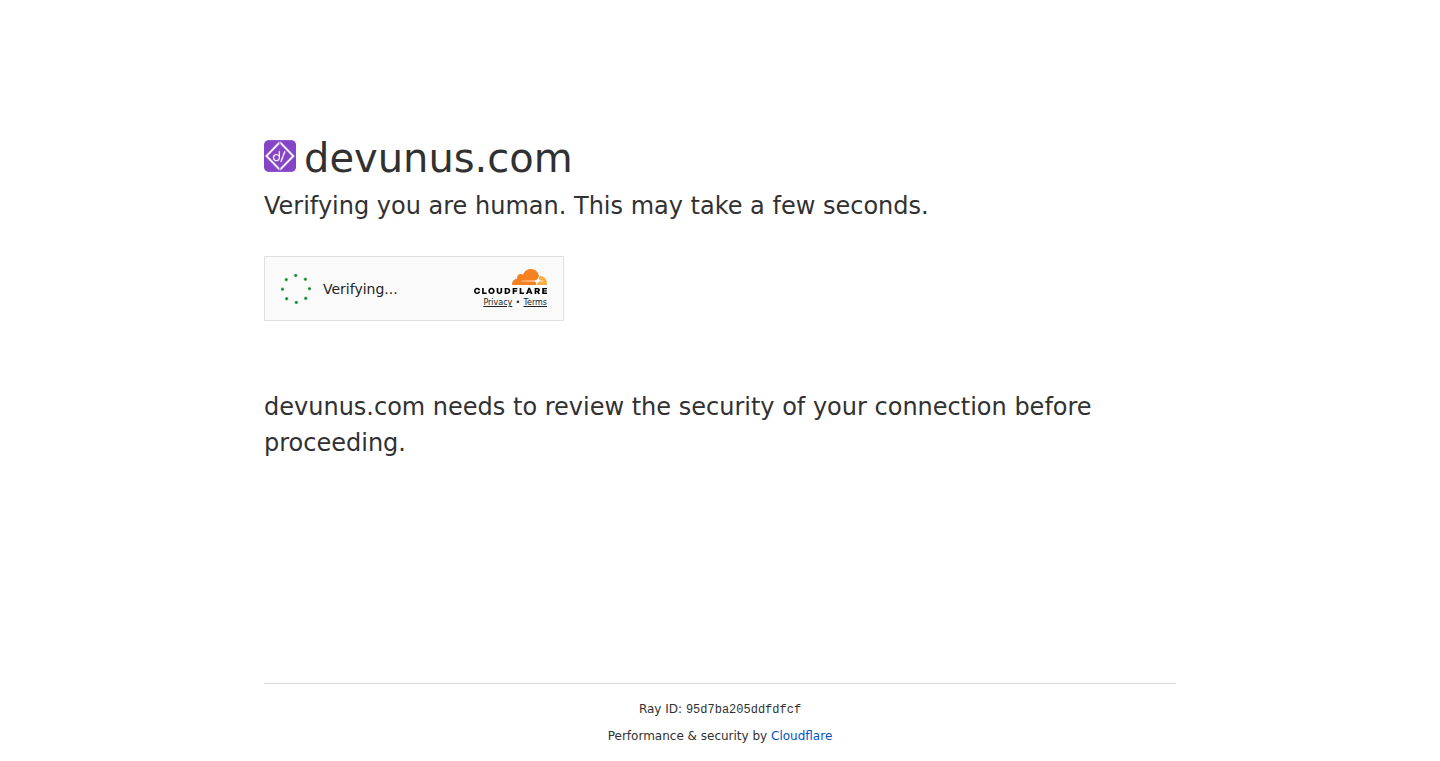
Author
helen_devunus
Description
This project is a free, open-source tool designed to automatically analyze and audit your OpenAPI specifications (formerly known as Swagger). It identifies potential issues, inconsistencies, and security vulnerabilities in your API definitions. Think of it as a free health check for your API, helping you ensure it's well-documented, secure, and easy to use. This is innovative because it offers a streamlined, automated way to catch API design flaws that are usually found through manual reviews or expensive paid tools.
Popularity
Points 1
Comments 0
What is this product?
OpenAPI Auditor works by parsing your OpenAPI specification (which is essentially a detailed blueprint of your API, written in a standardized format like YAML or JSON) and applying a series of checks. These checks look for things like missing descriptions, inconsistent data types, potential security loopholes (like missing authentication), and usability issues (like unclear parameter names). The tool then generates a report highlighting these issues, along with suggestions for how to fix them. It’s innovative because it automates a traditionally manual process, saving developers time and effort while improving API quality. So this allows you to quickly pinpoint issues and ensure your APIs are well-defined and ready to go.
How to use it?
Developers use OpenAPI Auditor by providing it with the URL or path to their OpenAPI specification file. It integrates directly into the development workflow, which means you can include it in your CI/CD pipeline (Continuous Integration/Continuous Deployment). When you make changes to your API's blueprint, the tool will automatically analyze them and provide you with feedback, enabling you to continuously monitor the quality of your API design. This is useful for any developer working with APIs, especially those who need to ensure their APIs are compliant with industry standards or have a need to keep them secure and easy to use. So you can easily integrate this to your automation to avoid bad API designs.
Product Core Function
· Automated Validation: The tool automatically validates your OpenAPI specification against the OpenAPI standard. This identifies errors like syntax mistakes and structural inconsistencies in your API blueprint. This is valuable because it helps developers create a compliant API definition from the start. So you avoid making basic mistakes in the format of the API description.
· Security Checks: It scans your OpenAPI specification for potential security vulnerabilities. For example, it checks if authentication methods are defined for all required endpoints and analyzes potentially sensitive data. This allows developers to proactively identify and address security risks. So you can make sure the API is secure and safe for users.
· Usability Analysis: OpenAPI Auditor examines your API specification for issues related to usability, such as missing descriptions for parameters, unclear error messages, and inadequate example data. This helps developers to create user-friendly APIs. So you can make it easy for other developers to understand and use your API.
· Reporting: The tool generates detailed reports that highlight any detected issues, along with severity levels and recommendations for resolving them. This allows developers to quickly understand and address the problems. So you can find the problems with your API and fix them quickly.
· Customizable Rules: It allows users to customize the audit rules to fit their specific needs and requirements, by adjusting the checks performed by the tool. This provides flexibility and allows you to tailor the analysis to align with project-specific API design guidelines. So you can adapt the analysis to your own project's rules.
Product Usage Case
· API Documentation Generation: Developers can use OpenAPI Auditor to check the quality of the documentation. For example, a developer creating an API for a mobile app could use the tool to ensure that all parameters are clearly documented, which allows the app developers to more easily integrate their app. So you can create better documentation.
· Security Compliance: A financial services company needs to ensure its APIs meet strict security requirements. The company can use OpenAPI Auditor to audit the OpenAPI specifications for potential vulnerabilities like missing authentication. This helps to avoid security breaches. So you can ensure you're meeting security requirements.
· API Standardization: A large enterprise needs to standardize its API design across different teams. The company can use OpenAPI Auditor to enforce a consistent design and documentation style, identifying inconsistencies across APIs. This streamlines internal development and makes it easier for teams to integrate their services. So you can keep a consistent API across all teams.
· CI/CD Integration: A software company integrates OpenAPI Auditor into its CI/CD pipeline. Every time a new version of the API is deployed, the tool automatically audits the OpenAPI specification. This ensures that new changes do not introduce any issues into the API design. So you can catch errors before they affect your users.
89
Midway@ - Fair Travel Time Optimizer
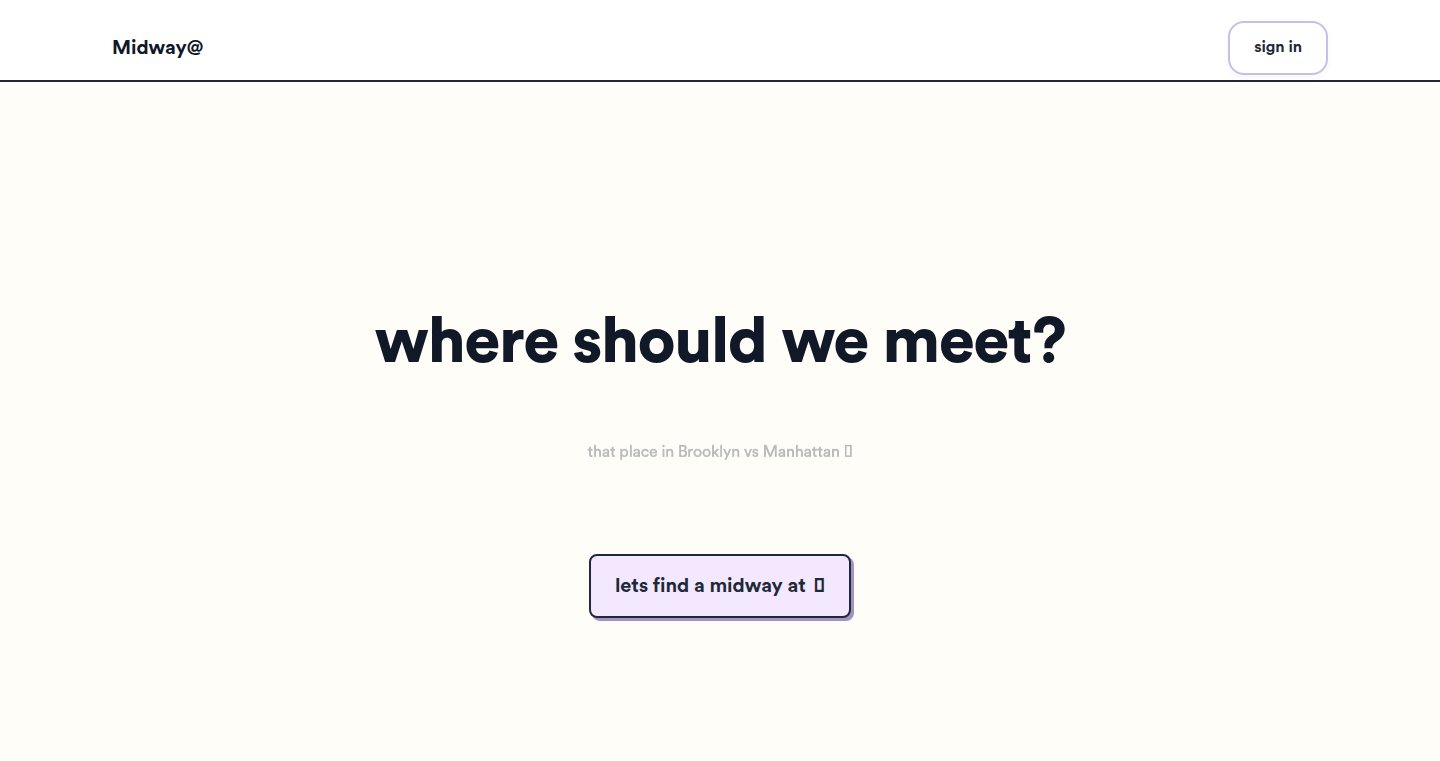
Author
KApilmittal
Description
Midway@ is an AI-powered tool that intelligently finds the best meeting spots for groups, ensuring everyone's travel time is balanced. It goes beyond simple geographic midpoints, taking into account real-time traffic, various transportation modes (car, transit, walking, biking), and venue suitability. The core innovation lies in its custom algorithm, which minimizes travel time variance, making meetups more equitable and efficient.
Popularity
Points 1
Comments 0
What is this product?
Midway@ uses advanced algorithms and real-time data from Google Maps to analyze travel times for each person in a group, considering their chosen transportation method. It then suggests meeting locations that offer the most balanced travel times, ensuring nobody has an excessively long commute. So this is a smart tool that automatically figures out the best place for your meetups, taking the pain out of coordination.
How to use it?
Developers can leverage similar travel-time optimization techniques in their own applications. Think ride-sharing apps, delivery services, or any platform where location and travel time are crucial. The underlying principles can be adapted to solve complex routing problems. So you can learn how to use advanced algorithms in different situations, not just for meetups.
Product Core Function
· Real-time Travel Time Calculation: Utilizes Google Maps APIs to calculate travel times based on live traffic data and user-specified transport methods. This ensures accurate and up-to-date travel estimations. So this helps me to know exactly how long it will take me to get somewhere.
· Custom Algorithm for Travel Time Equity: Employs a custom algorithm to minimize travel time variance across the group, ensuring a fair distribution of commute times. This is the heart of the product, making sure everyone gets to a place without someone spending a lot of time on the way. So it means everyone's travel time will be fair.
· Mixed Transport Mode Handling: Accommodates different transport methods within the same group, allowing some members to drive, others to use public transit, and some to walk or bike. It solves the problem of the group having different ways to travel to the same place, which means everyone is included.
· Venue Ranking with Suitability Matching: Ranks venues based on both travel equity and the user's specified needs (e.g., 'coffee shop with WiFi', 'restaurant with parking'), optimizing for both convenience and balanced travel. This helps me to not only find a good place to meet but also something everyone would like.
· Coordination Time Savings: Reduces coordination time by automatically suggesting balanced meetup locations, saving an average of 47 minutes per group. This helps you save time by doing the meeting place searching for you.
Product Usage Case
· Meeting Scheduling Apps: Integrate the travel time optimization algorithm into a meeting scheduling app to automatically suggest the best meeting locations for users, taking into account travel times and preferences. So, developers can build smarter and better meeting apps.
· Logistics and Delivery Services: Optimize delivery routes and schedules by calculating travel times and balancing workloads to minimize costs and improve service efficiency. It can help you to optimize your delivery services.
· Ride-Sharing Platforms: Enhance ride-sharing platforms by intelligently matching passengers based on their origin, destination, and travel time preferences, ensuring efficient and equitable rides. So, developers can build a better ride-sharing app.
· Team Collaboration Tools: Integrate travel time optimization into team collaboration tools to help remote teams find the best locations for in-person meetings, considering the travel times for each team member. This can help you arrange meetings in the best possible place, taking into account everyone’s location.
90
Invisitris: The Invisible Tetris
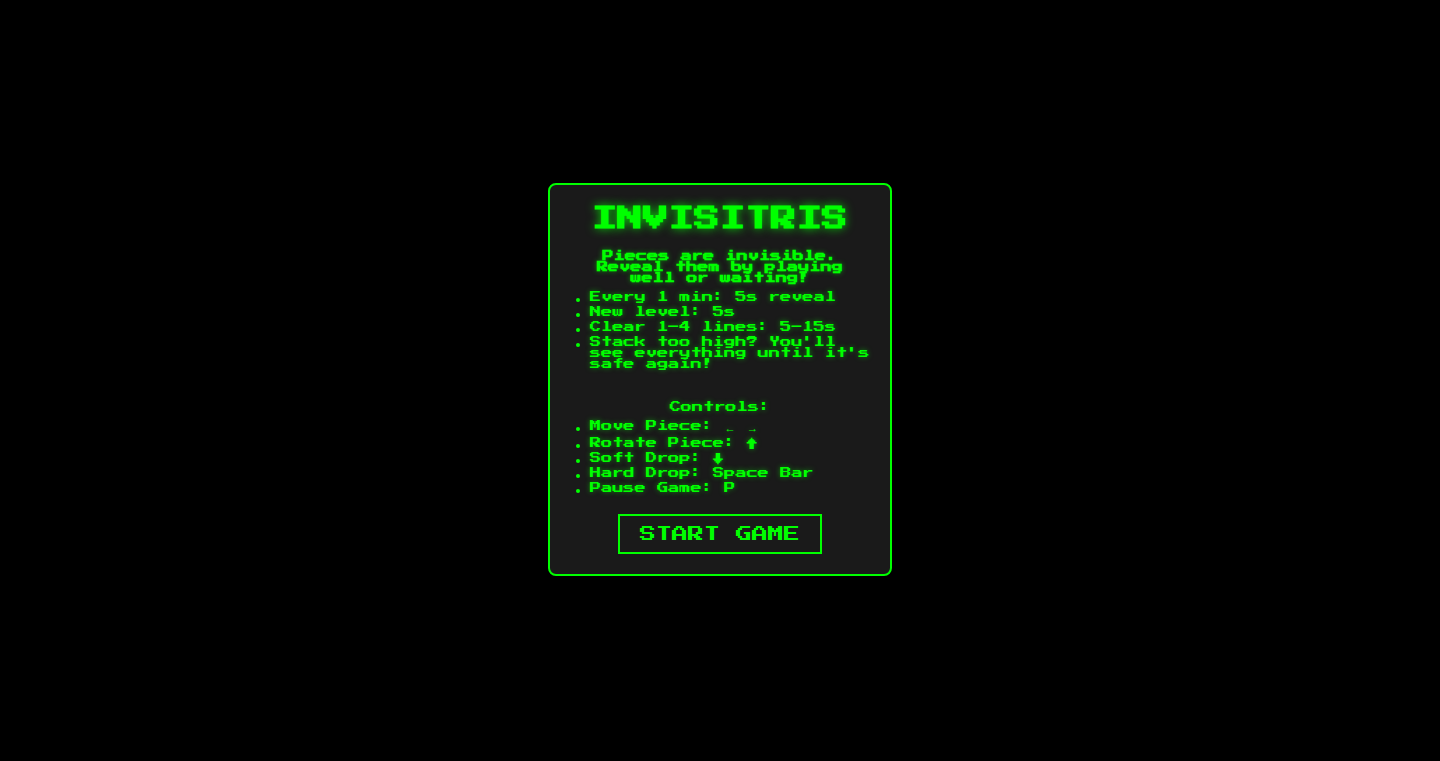
Author
eddguzzo
Description
Invisitris is a unique twist on the classic Tetris game, where most of the playing grid is invisible. This project challenges players to rely on memory and strategic placement of pieces, as only the most recently placed piece is visible. Periodically, or when lines are cleared, the entire grid is revealed. This creates a new level of challenge and strategic thinking compared to the original game. It explores the concept of information management and spatial reasoning in game design. So, this is useful for anyone who enjoys challenging puzzle games and wants to test their memory and spatial awareness.
Popularity
Points 1
Comments 0
What is this product?
Invisitris is a Tetris game with a twist. The core innovation is the invisibility of most of the Tetris grid. The game's core mechanics revolve around piece placement, requiring the player to make decisions based on mental models of the grid. The visible state is periodically updated or triggered by line clears. It is a demonstration of how to re-imagine familiar game mechanics with limited information. So, this demonstrates how to innovate on existing games, making them more challenging.
How to use it?
You can play Invisitris directly in your web browser. The gameplay involves the same piece movements as the original Tetris, but with the added challenge of limited visibility. The game's logic will be implemented using JavaScript, HTML, and CSS. So, this project is useful for web developers wanting to learn game development, or those interested in exploring visual design principles in game interfaces.
Product Core Function
· Invisible Grid Mechanics: The core function. Most of the game grid is hidden. The latest placed piece is visible and the grid periodically reveals itself. Value: Provides an innovative challenge, forcing players to use memory and prediction skills. Application: Adds a layer of complexity to standard puzzle games.
· Periodic Grid Reveal: The entire grid reveals itself periodically. Value: Allows the player to check their decisions and manage the game. Application: Helps to prevent the game from becoming impossibly difficult by providing short-term visibility.
· Line Clear Trigger: When lines are cleared, the grid is revealed. Value: Rewards strategic play and provides a chance to readjust the game. Application: Encourages thoughtful gameplay and prevents players from relying solely on luck.
· Piece Placement Logic: Handles the placement and the movement of the pieces, including rotation and shifting, taking into account the invisible grid constraints. Value: Demonstrates the fundamentals of game mechanics. Application: Useful for understanding how to handle in-game object interactions.
Product Usage Case
· Game Development Learning: A beginner can use the Invisitris project as a learning opportunity to study how game mechanics are implemented in code, especially piece handling, collision detection, and game state management, all in the context of limited visibility. So, this is perfect for anyone starting in game development, as a great learning tool.
· UI/UX Experimentation: The concept of Invisitris can be used as inspiration to explore novel user interfaces where information is selectively revealed, allowing developers to test how players process information under challenging conditions. So, this is useful for creating UI's with unique information display and interaction.
· Puzzle Game Design: Invisitris showcases an interesting game design choice. Developers can take inspiration from the project and incorporate this idea into their puzzle game designs, exploring the relationship between information and difficulty to develop interesting and challenging experiences for the player. So, this is useful for game designers looking to innovate and add challenges to familiar games.
91
Highlight2GPT: Chrome Extension for Seamless Text-to-Prompt Interaction
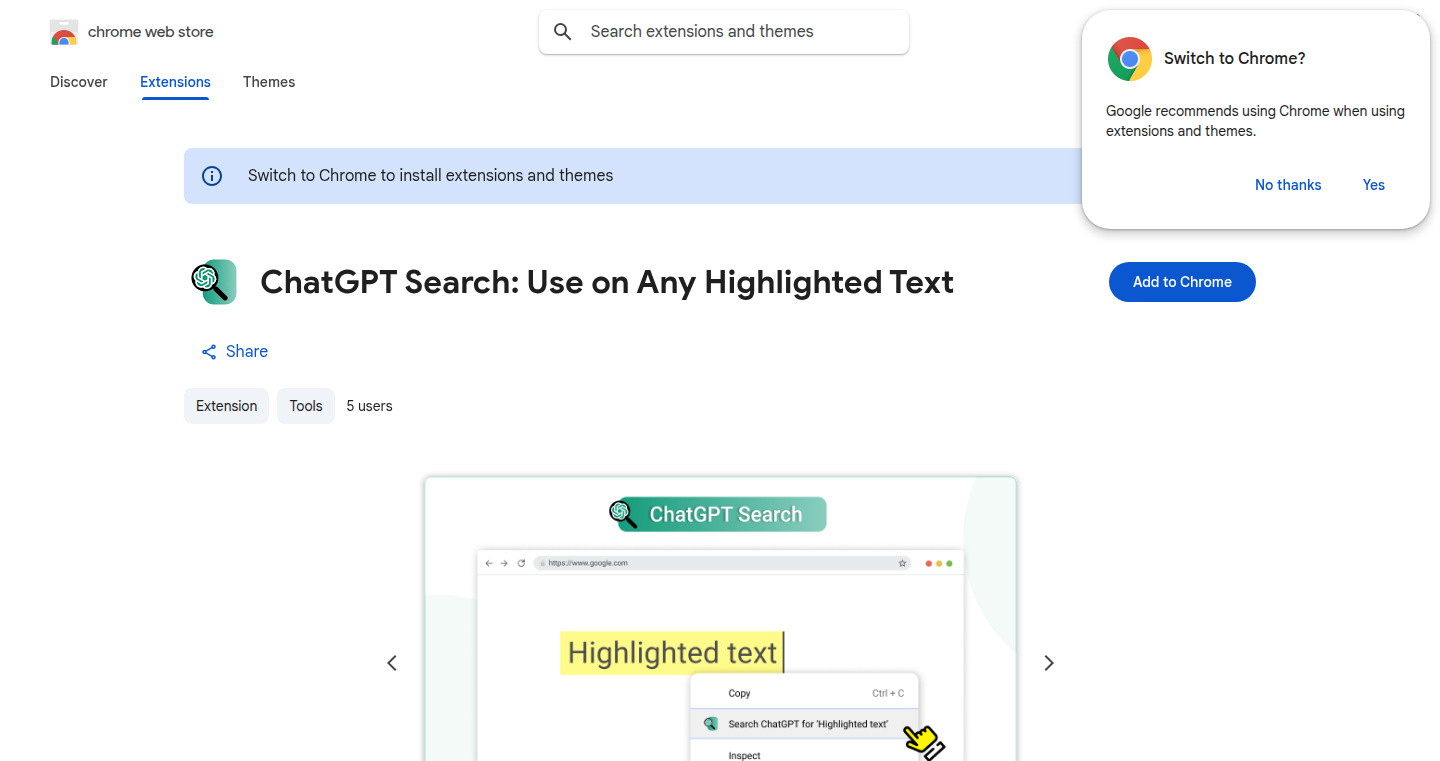
url
Author
bluelegacy
Description
This Chrome extension revolutionizes how you interact with ChatGPT. It lets you highlight any text on a webpage, right-click, and instantly send it as a prompt to ChatGPT – no account signup required. The core innovation lies in its ability to seamlessly integrate a commonly used browser feature (highlighting text) with a powerful AI model. It solves the problem of tedious copy-pasting and context switching when using ChatGPT, making AI-assisted research and content creation much faster and more efficient. So this means it saves you time and effort when you want to leverage the power of AI.
Popularity
Points 1
Comments 0
What is this product?
Highlight2GPT is a straightforward Chrome extension. Its technical architecture centers on intercepting user-selected text within the browser. When you highlight text and right-click, the extension captures this selection and sends it to a predefined ChatGPT endpoint. This process eliminates the need to manually copy-paste text into ChatGPT, streamlining the user experience. The innovation is in the simplicity of the integration, making AI accessible directly from your web browsing workflow. So it allows you to directly use AI without the hassle of switching windows.
How to use it?
Install the extension from the Chrome Web Store, and after installation, you can immediately use it. When you find text on a webpage you want to analyze, summarize, or ask questions about, simply highlight it. Then, right-click on the highlighted text, and select the 'Send to ChatGPT' option from the context menu. The extension will send the highlighted text to ChatGPT, and the AI's response will be displayed within the ChatGPT interface (or a new tab/window). This is perfect for researchers, students, writers, or anyone who uses the internet for information gathering and requires AI assistance. So you can quickly use AI to analyze the data directly from the webpage.
Product Core Function
· Instant Text Transfer: The core function is sending highlighted text to ChatGPT with a single right-click. This is a simplified way to interface with an AI, avoiding the need to manually copy and paste. This is useful in any situation where you need to ask questions about the text you are reading.
· No Account Needed: The extension eliminates the barrier to entry by allowing use without account registration. This lowers the hurdle for users to experiment with AI. This is valuable for users who wish to try out AI assistance quickly without the overhead of registration.
· Context Menu Integration: The integration into the right-click context menu makes the functionality easy to discover and use within a natural browsing workflow. This helps improve the user experience by placing the function right where it's needed.
· Cross-Platform Compatibility: Since it is a Chrome extension, it is compatible with all operating systems that support the Chrome browser (Windows, macOS, Linux, ChromeOS). This provides broad accessibility to users across diverse hardware configurations.
Product Usage Case
· Research: A student is researching a complex topic. They can highlight key phrases and passages from articles, right-click, and instantly ask ChatGPT for summaries, definitions, or deeper explanations. This speeds up information gathering, making the research process more efficient. So this will help you to deeply and rapidly understand the topic.
· Content Creation: A writer is drafting an article. They can highlight a sentence and ask ChatGPT to rephrase it, suggest alternative wording, or provide additional information. This improves the efficiency of the writing process and facilitates brainstorming and content refinement. So this will make the content creation easier and more convenient.
· Learning: A user encounters a new term in a technical article. They can highlight the term, right-click, and ask ChatGPT for a definition or more context. This creates an interactive learning environment that facilitates understanding. So this helps you to learn faster by providing quick explanations.
· Technical Documentation: A developer is reading through code documentation. They can highlight a code snippet and request that ChatGPT explain its function or suggest improvements. This provides immediate technical support and reduces debugging time. So this is helpful for developers when they need to quickly understand and debug code.
92
Context Compass: Real-time Claude Token Usage Tracker
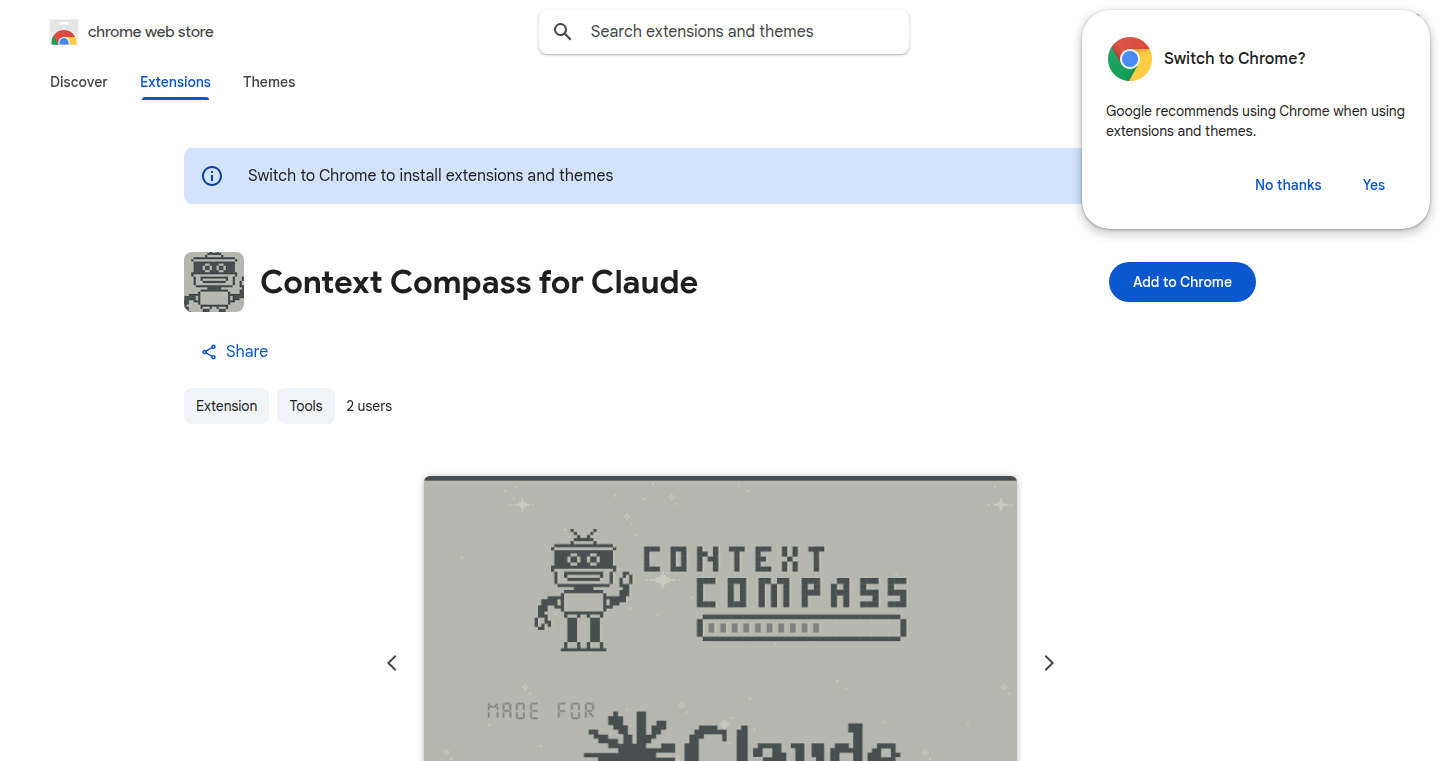
url
Author
raydawg88
Description
Context Compass is a Chrome extension designed to help users of Claude, a large language model (LLM), avoid hitting the token limit. It automatically counts words and estimates token usage as you write, providing a real-time percentage bar. This allows users to manage long conversations without losing their work or flow, solving the frustrating problem of unexpectedly exceeding the context window. This tool tackles the technical challenge of accurately estimating token usage in a dynamic, user-friendly way, directly addressing the common issue of large model context limits.
Popularity
Points 1
Comments 0
What is this product?
Context Compass is a Chrome extension that acts as a token counter for Claude. It uses clever algorithms to estimate how much of the model's context window you're using in real-time. So, as you type, it provides a visual representation (like a progress bar) showing how close you are to the limit. This is all about providing you with a clear, live view of your token usage, preventing the annoying 'max context' error and keeping your conversations flowing. This technical innovation solves a practical problem: helping users stay within the constraints of LLMs, ensuring they don't lose their work or break the flow of their chat.
How to use it?
You install the Chrome extension, and it works seamlessly within the Claude interface. As you write, Context Compass automatically tracks your token usage. There's no complex setup; it simply works in the background. You can use it whenever you're composing long-form content, engaging in in-depth discussions, or crafting complex prompts within Claude. For developers and technical writers: this means you can plan your long conversations more effectively, avoiding unexpected limits and optimizing your interaction with Claude.
Product Core Function
· Real-time Token Estimation: The core functionality involves a clever algorithm that calculates an estimate of token usage as you type. This is important because token limits are the real constraint when using LLMs. It's crucial to avoid exceeding these, especially for longer conversations.
· Visual Percentage Bar: Displays a percentage bar that changes dynamically to give a visual cue about how much of the available token space you have used. This is very helpful because it gives an easy understanding about where you are in the context window.
· Word Count: The extension includes a word count, so you know the number of words you are writing, which is important for content creation and summarization tasks. If you’re a writer or technical user, this makes planning easier.
· No Tracking or Sign-ups: The extension is privacy-focused and doesn’t require any personal data, and it runs directly on your local browser. This is a great example of a product that solves a practical problem without compromising user privacy or requiring a complicated setup.
Product Usage Case
· Content Creators: A technical writer using Claude to draft a long article can use Context Compass to ensure the content fits within the token limit for summarization or further processing. This avoids the sudden interruption of exceeding the context window.
· Technical Documentation: When creating technical documents and tutorials with Claude, the extension allows you to stay within context limits and provides a clear progress indicator for complex topics. It ensures comprehensive and error-free creation.
· Customer Support Interactions: Support teams can leverage Context Compass to gauge the length of their responses and maintain context awareness for better and optimized customer interactions.
93
PromptCraft: Visual Layout Generation Assistant
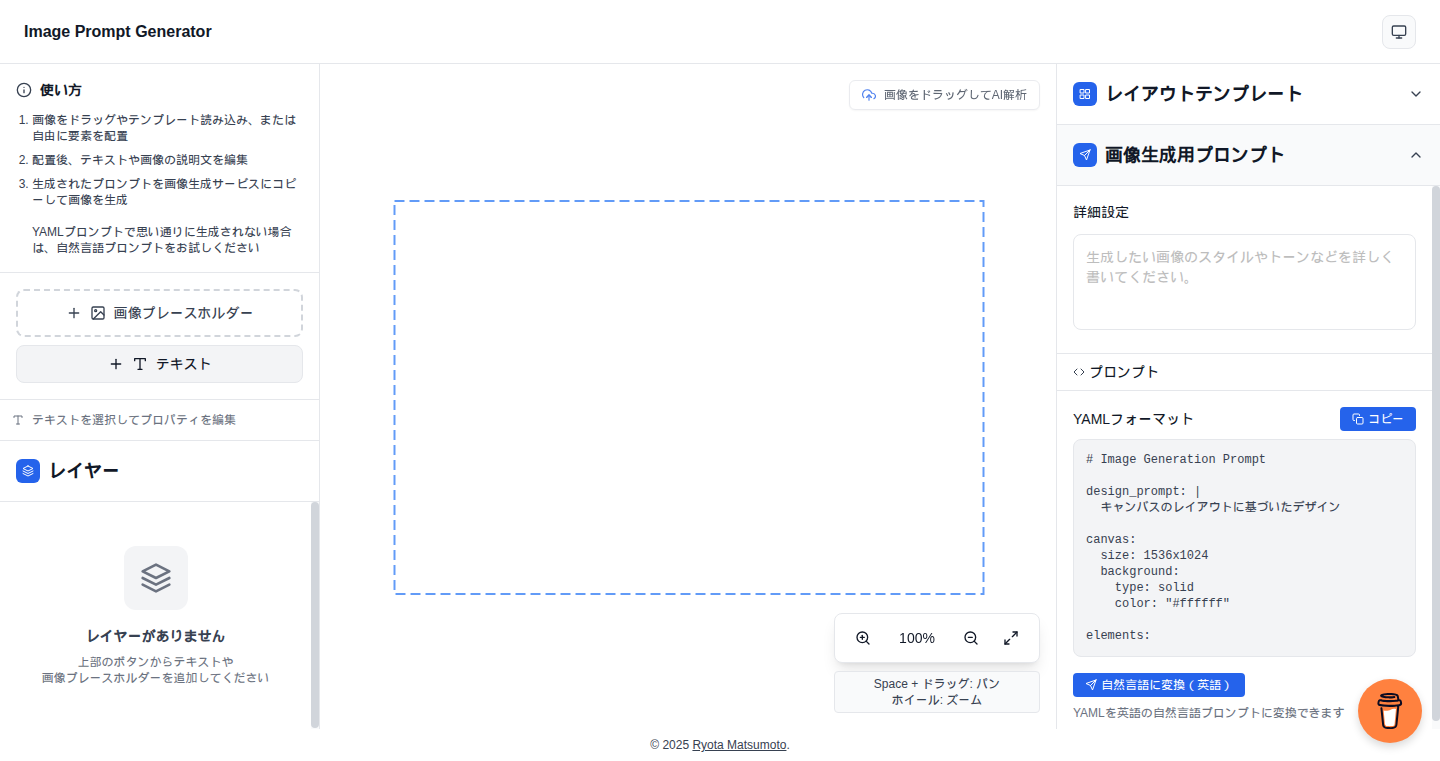
Author
acdev
Description
PromptCraft is a tool that helps users create effective prompts for generating image layouts using image generation models. It focuses on making the process of describing visual layouts more intuitive and accessible, addressing the difficulty users face when crafting precise and descriptive prompts. The core innovation lies in simplifying the complex task of specifying layout structures for AI image generation, allowing for more controlled and predictable outputs.
Popularity
Points 1
Comments 0
What is this product?
PromptCraft simplifies the process of describing image layouts to AI image generators. It uses a user-friendly interface to guide users in creating prompts that specify the arrangement of elements within an image. The innovation lies in making the prompt creation process more accessible and less prone to trial and error, improving the efficiency and effectiveness of image generation. So this is useful for streamlining the creative process for visual projects, especially those involving AI-generated images.
How to use it?
Developers can use PromptCraft to accelerate the development of visual content. They can create detailed layout prompts and integrate them with their image generation pipelines. This might involve using APIs provided by image generation models like Stable Diffusion or Midjourney. Alternatively, developers can use the generated prompts as a basis for creating their own visual designs, leading to more accurate and consistent results. This would allow developers to rapidly prototype visual concepts and ensure a consistent visual style. So, you can use this to create your design specifications quicker.
Product Core Function
· Prompt Generation: The core functionality is the generation of text prompts. This is done by allowing users to visually specify elements like objects, composition, and style preferences and then translate those into text that an image generation model can understand. Value: It removes the need for users to become prompt engineering experts. Use Case: Rapid prototyping of visual concepts without needing complex prompt-writing skills.
· Layout Specification: The tool allows for precise specification of the layout, like the placement, size, and relationships between different elements in the image. Value: It ensures that the generated image accurately reflects the user's design intent. Use Case: Designers can quickly visualize their ideas by precisely controlling how objects are arranged in an image.
Product Usage Case
· Game Development: Imagine a game developer needing specific character poses or environment layouts. With PromptCraft, they can describe these layouts and rapidly generate the corresponding images, creating assets that match the game's visual style. This speeds up the art creation process, saving time and resources. For example, you can quickly build a concept art library for a game.
· Web Design: A web designer could use PromptCraft to generate various mockups for website layouts. They could describe different sections of the website, the placement of images and text, and generate visual representations of different design options. This reduces the effort needed to visualize design options and communicate them to the design team. You can create multiple design options very fast.
· Product Mockups: E-commerce businesses could use PromptCraft to create product mockups for their online stores. They can specify the layout of the product image, the background, and any accompanying text. This is faster and cheaper than traditional photo shoots. So, you can visualize your product mockups quickly.
94
AgentSphere: Secure Runtime for AI-Generated Code
Author
AgentSphere
Description
AgentSphere is a platform that provides a secure and isolated environment in the cloud for running code generated by large language models (LLMs) like ChatGPT and Claude. It solves the problem of how to safely execute potentially untrusted code produced by AI, offering a 'Execution-as-a-Service' model. This allows developers to build AI agents that can not only write code but also execute it securely without any local setup or complex configurations. This means you can build AI tools that can interact with data, perform actions, and automate tasks without the risk of compromising your system. For instance, it seamlessly integrates with tools like Cursor, Claude Code, Raycast, and Gemini CLI.
Popularity
Points 1
Comments 0
What is this product?
AgentSphere is like a secure box in the cloud where you can run code that's been written by an AI. Think of it as a safe space for running code. When you use AI models like ChatGPT to generate code, you often want that code to actually *do* something – like process data or interact with other systems. But running AI-generated code can be risky because it might contain errors or malicious intent. AgentSphere addresses this by providing isolated environments (sandboxes) that protect your system while allowing the code to run. Its core idea is to simplify the process of running this code without the need for complicated local setups. It allows you to send a command and have it run securely, without worrying about the underlying infrastructure. This is all achieved using lightweight containerized runtimes accessed via a JavaScript SDK, a Python SDK, or APIs. So this is useful if you need to automate things or build AI agents that go beyond just writing text.
How to use it?
Developers can use AgentSphere by integrating it into their applications through SDKs or APIs. You can provide a prompt or instruction to an LLM (e.g., 'Write a Python script to summarize this text'), and then use AgentSphere to execute the generated code within a secure sandbox. The platform is designed to work with various AI-powered tools, which makes it easy to get started if you are already using tools like Cursor or Claude Code. For example, you can use AgentSphere to connect your AI with your data and systems, allowing it to perform actions based on the AI-generated code. Think of it as a way to get your AI to directly interact with your world. For example, you can automatically summarize text or scrape data by using AI code. So, you can start by getting an API key, then use the SDKs or APIs to send commands, execute the AI-generated code, and get results – all within a secure, isolated environment.
Product Core Function
· Secure Code Execution: AgentSphere provides a secure, isolated environment (sandbox) in the cloud for running AI-generated code. This means that even if the code has errors or is malicious, it cannot harm your systems. So this protects your valuable data and infrastructure.
· Lightweight Cloud Sandboxes: The platform uses lightweight containerized runtimes for easy deployment and execution. It eliminates the need for local setup or complex configurations, allowing developers to quickly integrate AI-generated code execution into their workflows. So you can focus on building and innovating, not managing infrastructure.
· SDK and API Integration: AgentSphere offers JavaScript and Python SDKs, as well as APIs, to integrate with various applications and tools. So you can easily incorporate the platform into your projects using the programming language or framework you prefer.
· Integration with MCP Clients: AgentSphere is designed to work seamlessly with popular MCP clients like Cursor, Claude Code, Raycast, and Gemini CLI. This integration simplifies the process of running AI-generated code, making it accessible to a broader range of users. So this opens up more use cases for AI tools.
Product Usage Case
· Automated Data Processing: Imagine you need to automatically summarize a large document. You could use an AI model to generate the summarization code, then use AgentSphere to safely run that code and get the summary without manual intervention. So you save time and effort on repetitive tasks.
· AI-Powered Automation: You're building an AI tool that needs to interact with different APIs to collect data or perform actions. AgentSphere allows you to run AI-generated code to automate these tasks in a safe environment. So you can build AI-powered tools that can automate complex workflows and automate business processes.
· Testing and Experimentation: When you are testing the output of AI models, AgentSphere provides a safe place to run the code and see how it works. So you get an easy way to test AI-generated code without risking the safety of your systems.
· Integrating AI into Existing Workflows: If you're using tools like Cursor or Claude Code and want to execute the code they generate, AgentSphere offers a seamless integration that lets you 'just run' the AI-generated output. So you can easily extend the functionality of your existing tools with AI-powered capabilities.
95
Arxiv Daily Digest Agent
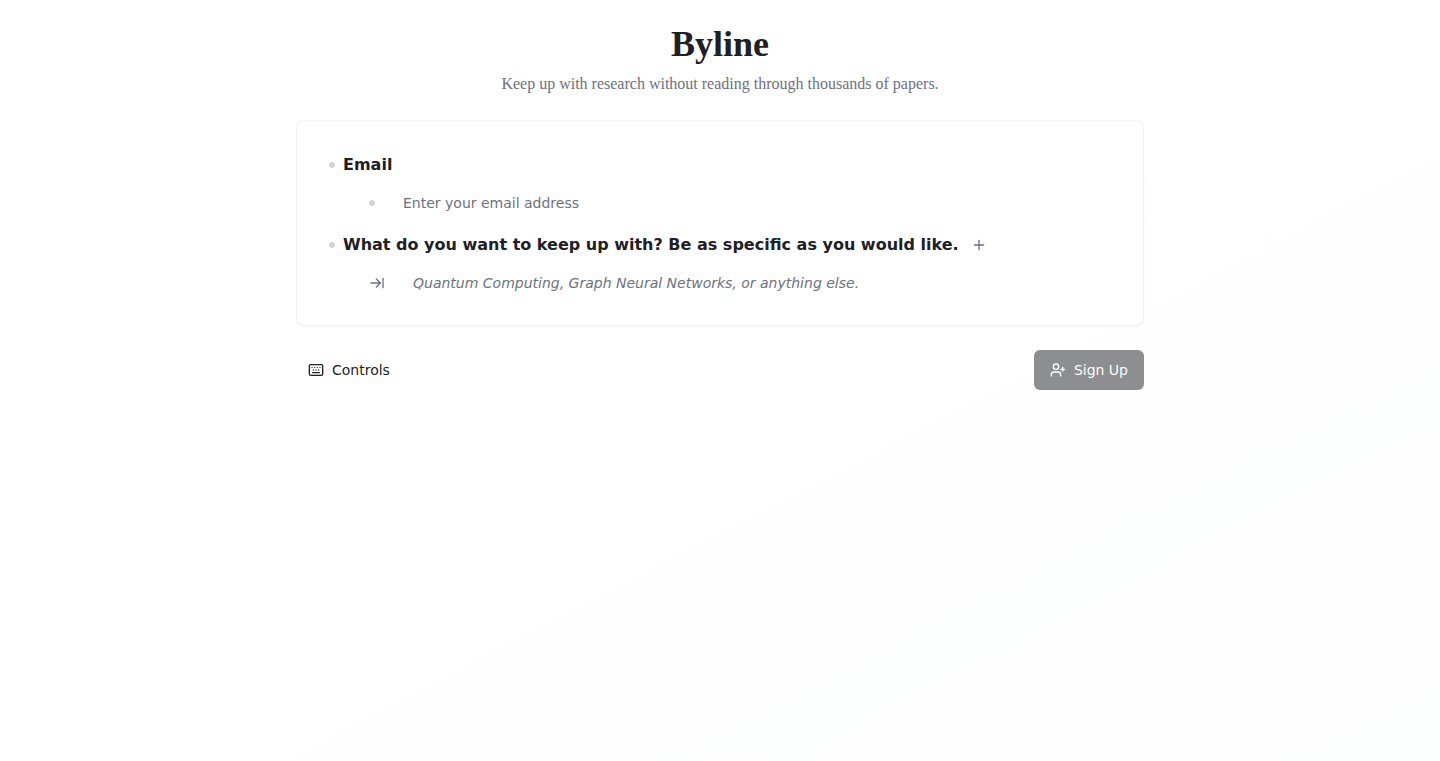
Author
luhemarora
Description
This project is a smart agent that automatically summarizes research papers from arXiv (a popular online archive for scientific papers) and sends the summaries to your inbox every morning. The innovation lies in its automated approach to information gathering and processing. It addresses the problem of information overload by filtering and condensing complex research into easily digestible summaries.
Popularity
Points 1
Comments 0
What is this product?
This project utilizes natural language processing (NLP) techniques. It probably uses a large language model (LLM) to parse and understand the papers, then generate concise summaries. It automates the process of reading and understanding a large volume of scientific research. So this is useful because it saves you a lot of time by filtering out the noise and providing only the key information you need.
How to use it?
Developers can potentially use this by subscribing to the agent, customizing the filtering criteria to focus on specific research areas, or integrating it into a larger research pipeline. For instance, you could set up a similar agent that watches a different set of publications, like blog posts or tech news sites. You'll receive daily summaries in your email, or you can modify the agent's code to have it integrate the summary with your current working flow. So this lets you stay updated on the latest developments in your field without having to read every single paper.
Product Core Function
· Automated Paper Retrieval: The agent automatically fetches new research papers from arXiv based on defined criteria (e.g., keywords, topics). This is valuable because it removes the manual effort of browsing and searching through the archive daily, saving you valuable time.
· Content Summarization: Using NLP, the agent generates concise summaries of each paper. This is beneficial because it allows users to quickly grasp the core concepts and findings of a paper without reading the entire document.
· Daily Delivery: The summaries are delivered to the user's inbox every morning, providing a convenient and timely update on new research. This is useful because it integrates seamlessly into your existing workflow, making it easy to stay informed.
· Customizable Filtering: The agent likely allows users to customize their preferences, such as specifying keywords or topics of interest. This is useful because it enables users to focus on the most relevant research areas, reducing information overload.
Product Usage Case
· A data scientist can use the agent to stay informed about the latest advancements in machine learning by subscribing to relevant arXiv categories. This helps them stay up-to-date with the latest research. So, a data scientist can quickly identify potentially relevant papers to guide their own research.
· A software engineer working on a specific problem can use the agent to track papers related to that problem domain. This helps them discover new techniques and solutions. So, a software engineer can stay on the cutting edge of the tech.
· A researcher can use the agent as an initial step in their literature review process, quickly identifying relevant papers to dive deeper into. This accelerates their research process. So, it provides an efficient way to stay current with the latest research.